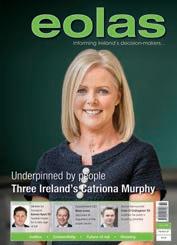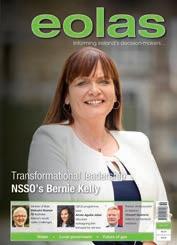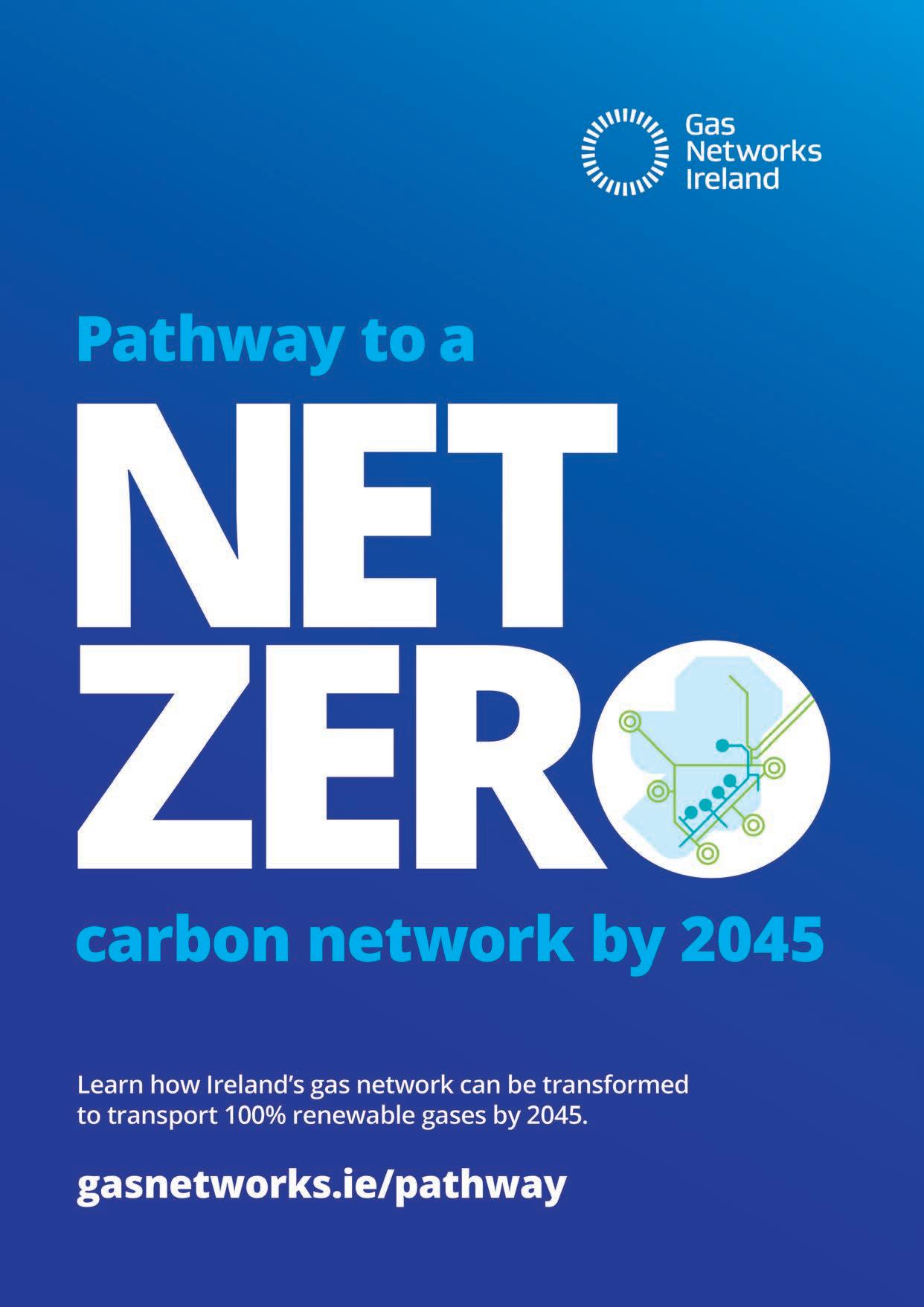










Digital Events Publications

Given the demographic challenges burdening the State’s existing infrastructure, the threats to our island’s energy security, an ongoing housing crisis, and an ambitious national climate objective, one constructive intervention did emerge from the summer lull, otherwise known as ‘silly season’.
First revealing the suggestion at the MacGill Summer School in July 2024, Taoiseach Simon Harris TD has advocated for the creation of a new “department of infrastructure” to enhance the delivery of capital projects within the State.
Suggesting that a new department could bring “impetus and focus” to the delivery of infrastructure projects, Harris believes that “the problems of 2025” – climate change, energy security, water quality, and housing delivery, as well as adequate healthcare, education, and transport infrastructure – “can be solved by a dedicated department whose role it is to prosecute the delivery of these projects... for our state”.
A department of infrastructure, he says, could also contribute to the delivery of a new Ireland and, as such, has pledged that unifying the provision of infrastructure “must be a priority for the next government”.
In this issue’s round table discussion, hosted by KPMG, and focusing on the delivery of sustainable infrastructure, there was consensus among participants that the Taoiseach’s suggestion “could be a very positive change”, key to establishing a more centralised and cohesive approach to delivery. Indeed, one participant observed that the new department could just as accurately be branded “the department of joined-up thinking”.
In the absence of such central government coordination –adequately mandated and resourced – it is widely acknowledged that progress on capital project delivery will continue to be hindered. Simultaneously, the proposal is also a tacit acknowledgement that neither the public service nor the private sector can deliver Ireland’s infrastructure future in isolation.
Ciarán Galway Editor
Editorial
Ciarán Galway, Editor ciaran.galway@eolasmagazine.ie
David Whelan david.whelan@eolasmagazine.ie
Fiona McCarthy fiona.mccarthy@eolasmagazine.ie
Joshua Murray joshua.murray@eolasmagazine.ie
Advertising
Sam Tobin sam.tobin@eolasmagazine.ie
Design
Gareth Duffy, Head of Design gareth.duffy@eolasmagazine.ie
Jamie Hogan jamie.hogan@eolasmagazine.ie
Events
Lynda Millar lynda.millar@eolasmagazine.ie
Become a subscriber!
Annual subscriptions:
€30.00 + €5.00 P&P
Contact: Sharon Morrison Email: subscriptions@eolasmagazine.ie Online: www.eolasmagazine.ie/subscribe
eolas Magazine
Owen McQuade, Publisher owen.mcquade@eolasmagazine.ie bmf Business Services
Clifton House
Lower Fitzwilliam Street Dublin, D02 XT91 Tel: 01 661 3755 Web: www.eolasmagazine.ie X: @eolasmagazine


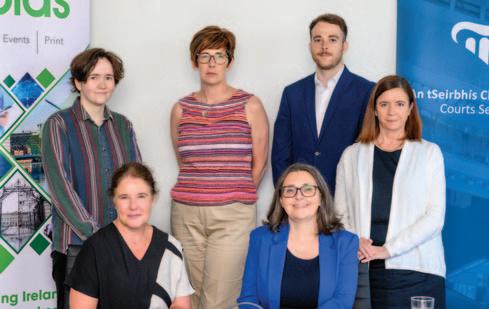




54 In association with



84 Minister of State Malcolm Noonan TD: ‘Nature is a powerful tool to improve water quality and control flooding’
88 The Water Action Plan signposts new approach to flood management
94 ESRI recommends payment scheme rewarding farmers for high water quality outcomes
106 Water and the Climate Change Advisory Council’s sectoral Adaptation Scorecard
Sponsored by
116 Minister for Agriculture Food and the Marine, Charlie McConalogue TD emphasises farmers role in a sustainable biomethane industry
122 National Biomethane Strategy: Ireland’s first major policy statement on biomethane
126 ESRI’s Niall Farrell explores the role that hydrogen can play in decarbonising the energy system
136 MaREI Director Brian Ó Gallachóir recommends the creation of an all-island gas storage plan
142 European Commission’s Big Data Test Infrastructure: Enhancing public sector efficiency
144 Ireland’s MEPs in profile
148 Joint Committee on the Implementation of the Good Friday Agreement: ‘No insurmountable economic or financial barriers to unification’
152 Green Party’s new leadership
154 The Houses of the Oireachtas Service’s annual report
162 Political Platform: Independent TD for Donegal, Thomas Pringle
164 Maynooth University’s Jennie C Stephens and UCD’s Orla Kelly: Time to abandon organised hypocrisy



Minister for Finance Jack Chambers TD has said that the Government is to delay the proposed residential land zoned tax “for a further year”.
The residential zoned land tax has been planned as an attempt to prevent land hoarding by developers and other individuals which some housing experts have argued has contributed to the State’s housing crisis.
Speaking on RTÉ News, Chambers says that the delay is necessary as some land belonging to “active farmers” is zoned for development use. “It would place a disproportionate and unfair burden on active farmers if

this tax was to be imposed annually,” he said.
Sinn Féin has criticised the Government’s delay, arguing that “it is the land hoarders, the speculators who are sitting on land instead of developing that are the real winners”.
The party’s finance spokesperson, Pearse Doherty TD, added: “Sinn Féin have been telling this government for the last three years that active farmers should never have been included in this proposal and they refused to listen, so I am glad that they are catching up.”
ENERGY
Tanya Harrington has been appointed as a Commissioner to the Commission for Regulation of Utilities (CRU) following an open competition run by the Public Appointments Service.
Prior to her new appointment, Harrington was chief regulatory affairs officer at An Post since 2019, where she has been responsible for economic regulatory risk management and compliance. She has also held leadership positions with Powerscourt, advising a range of Ireland’s largest companies on matters of public policy, government affairs, and economic regulation across a range of sectors.
Previously, the new CRU commissioner served as a ministerial advisor at the Department of Communications,
Energy and Natural Resources (now the Department of the Environment, Climate and Communications) and the Department of Transport. She is a former Head of Energy at Ibec.
As commissioner, Harrington will have responsibility for the economic regulation of energy (electricity and gas) and water, energy safety and customer protection in the further development of the EU’s internal energy market and the transition to a net zero carbon economy.
Harrington, who takes up post in early September, said: “I look forward to building on the work of previous Commissioners and working with all of the amazing team at the CRU.”


Taighde Éireann – Research Ireland, Ireland’s new competitive research and innovation funding agency, was formally launched in August 2024.
The new agency amalgamates the activities and functions of the Irish Research Council (IRC) and Science Foundation Ireland (SFI) and will capitalise on the recognised strengths of these two agencies in “driving world class research and innovation in Ireland”.
The establishment of Taighde Éireann – Research Ireland is the key component of Impact 2030: Ireland’s Research and
Innovation Strategy, and the new agency plays a central role in realising the ambitions set out in the strategy.
Minister for Further and Higher Education, Research, Innovation and Science, Patrick O’Donovan TD, says: “This agency will enhance our capacity to address the issues Irish society is facing, in particular climate change and the digital transition. It will also enable us to engage and compete with greater impact at an international level, making the most of future opportunities in research and innovation.”
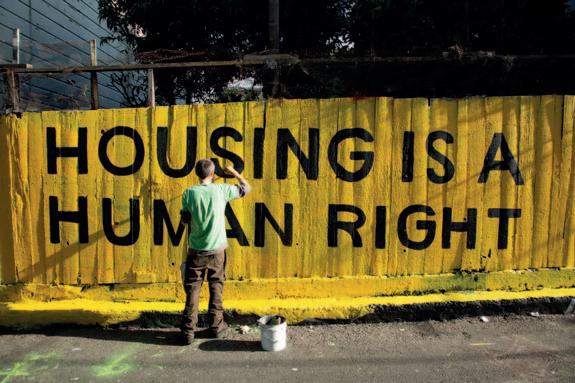
Homelessness numbers reached a new high over the summer, with 14,429 people, including over 4,000 children, recorded as homeless in figures released at the end of August 2024.
The figures, released by the Department of Housing, Local Government and Heritage, outline that during the week of 22 July 2024 to 28 July 2024 there were 10,028 adults and 4,401 children in emergency accommodation.
In Dublin, there were 10,487 people in emergency accommodation, including 3,289 children in 1,488 families. Overall, there were 4,634 single adults in emergency accommodation.
The figures mark the eighth consecutive month where homelessness has increased, and the latest of several instances since Covid where homelessness has reached record levels. Homelessness has increased in 29 of the last 33 months for which data is available.
HOUSING
Commenting following the publication of the monthly homelessness figures Minister for Housing Darragh O’Brien TD said: “The biggest challenge we face in terms of housing is in assisting those who have no home and who are in emergency accommodation. We’ve seen significant increases in the numbers of households prevented from entering and assisted in exiting emergency accommodation this year, but we know that we must do more. There is no shortage of will or determination in dealing with the issue of homelessness. Increasing housing supply is the key to resolving the current homelessness crisis and it is the absolute focus of the Government.”
Social Democrats housing spokesperson Cian O’Callaghan TD says that the figures “provide further evidence of this government’s inability to get to grips with the housing crisis”.

Former chair of the Commission for Regulation of Utilities (CRU) Aoife MacEvilly has been appointed as Commissioner for Broadcasting and Video on Demand in Coimisiún na Meán.
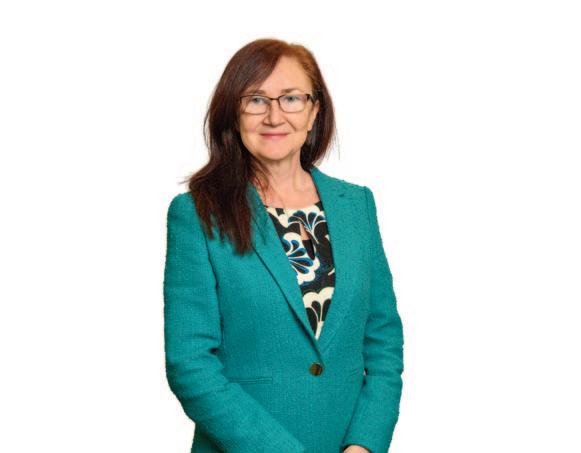
MacEvilly will lead on the implementation of Coimisiún na Meán’s new functions in relation to Video On Demand, as well as taking responsibility for the organisation’s pre-existing broadcasting regulatory functions.
MacEvilly was a member of the CRU from October 2014 until July 2024, and was chairperson from February 2020 to 2023. Under the Online Safety and Media Regulation Act 2022, Coimisiún na Meán, established in March 2023, is responsible
for overseeing the regulatory framework for broadcasting services, video-on-demand services and online safety, and supporting the development of the wider media sector in Ireland.
Announcing the appointment in July 2024, Minister for Tourism, Culture, Arts, Gaeltacht, Sport and Media, Catherine Martin TD, said: “This is a key appointment, not only in terms of ensuring the effective regulation of the audio and audiovisual media sector, but also in relation to promoting the development of a robust, sustainable, and pluralistic media sector which serves the needs of audiences.”
In July 2024, the Department of Further and Higher Education, Research, Innovation and Science has launched the National Skills Council in an effort to forge a strategic partnership on skills between the Government, industry, and social partners.
The new council, chaired by Kevin Marshall, head of learning and skills at Microsoft Ireland, will work independently to provide Government with strategic foresight and expert
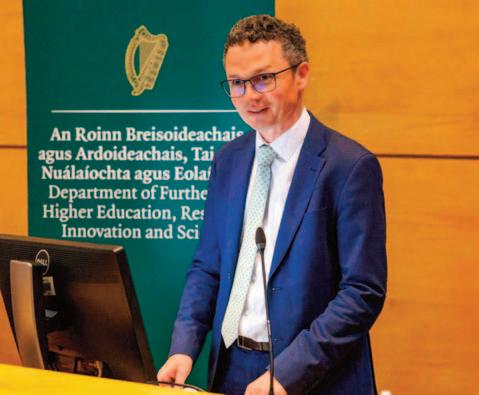
advice in the area of skills development in Ireland.
The establishment of the National Skills Council was informed by recommendations made by the OECD Skills Review and the membership of the Council spans representatives from multinationals to social enterprises, alongside local, family-owned SMEs.
Minister for Further and Higher Education, Research, Innovation and
Science, Patrick O’Donovan TD, says: “As societies and industries evolve and change, and changes in the world of work accelerate, so too must our approach to skills, and how we work in partnership.
“The new council is now a demand-led model that will help government to adapt and evolve its policies quickly and in tune with the skills requirements of society and the labour market.”
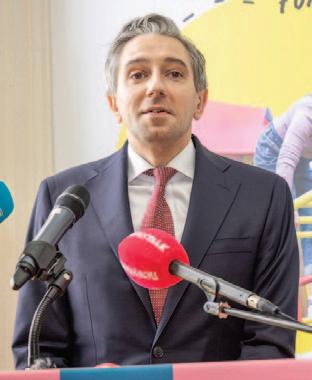
“If

“A department of infrastructure could be a pragmatic step toward a new Ireland.”
Taoiseach Simon Harris TD speaking at the MacGill Summer School, Glenties, County Donegal.
you are a parent who has put a set of GAA posts in your back garden, this belongs to you... Today is your day, because the GAA is where we all belong.”
Jarlath Burns, Uachtarán Chumann Lúthchleas Gael, following Armagh’s victory in the 2024 All-Ireland senior football championship final.


“We’re going to have to pay more in order to maintain the network next year.”
ESRI energy economist Muireann Lynch on transmission charges after the CRU stated spending on electricity infrastructure must increase by 38 per cent.

Over his 13-year leadership, Eamon Ryan TD had been credited with guiding the Green Party “back from the wilderness”. Five days before he announced his resignation as party leader, Ryan sat down with Joshua Murray to offer his reflections on his time leading the Green Party in government.
Remaining in post as Minister for the Environment, Climate and Communications and as Minister for Transport, Ryan cites the Climate Action Plan, the National Retrofit Scheme, as well as progress made on forestry as his proudest achievements in government, all of which occurred in his second spell in cabinet from 2020 onwards.
The now former Green Party leader had previously served as Minister for Communications, Energy and Natural Resources between 2007 and 2011, but the resignation of Green Party ministers in 2011 from the Brian Cowen-led coalition of Fianna Fáil-GreensProgressive Democrats led to the collapse of the government and the
wipeout of the Green Party in the 2011 election.
Replacing John Gormley as party leader in 2011, Ryan has been the most successful leader in the 43-year history of the Green Party. In his time as leader, the party secured a record 12 seats in the Dáil in 2020, alongside two seats in the European Parliament in 2019 on a record share of the vote.
While the successive polls and recent European and local election results paint a slightly less optimistic vision for the party, Ryan is adamant that entering coalition has been worth the sacrifice of electoral decline.
“We are seeing 1,000 homes retrofitted
every week, which means better homes for people. In addition, the fact that 100 houses per day are putting solar panels on their roofs just demonstrates that it is practical improvements and quality of life which is the real measure of progress, and I think we have done a lot in that regard.”
Although disappointed by the party’s performance in the local and European elections, Ryan has since stated that his decision to resign as party leader was made “a while ago” and was due to personal reasons.
“I cannot continue to work the long hours that being a public representative involves which is why I’m not standing

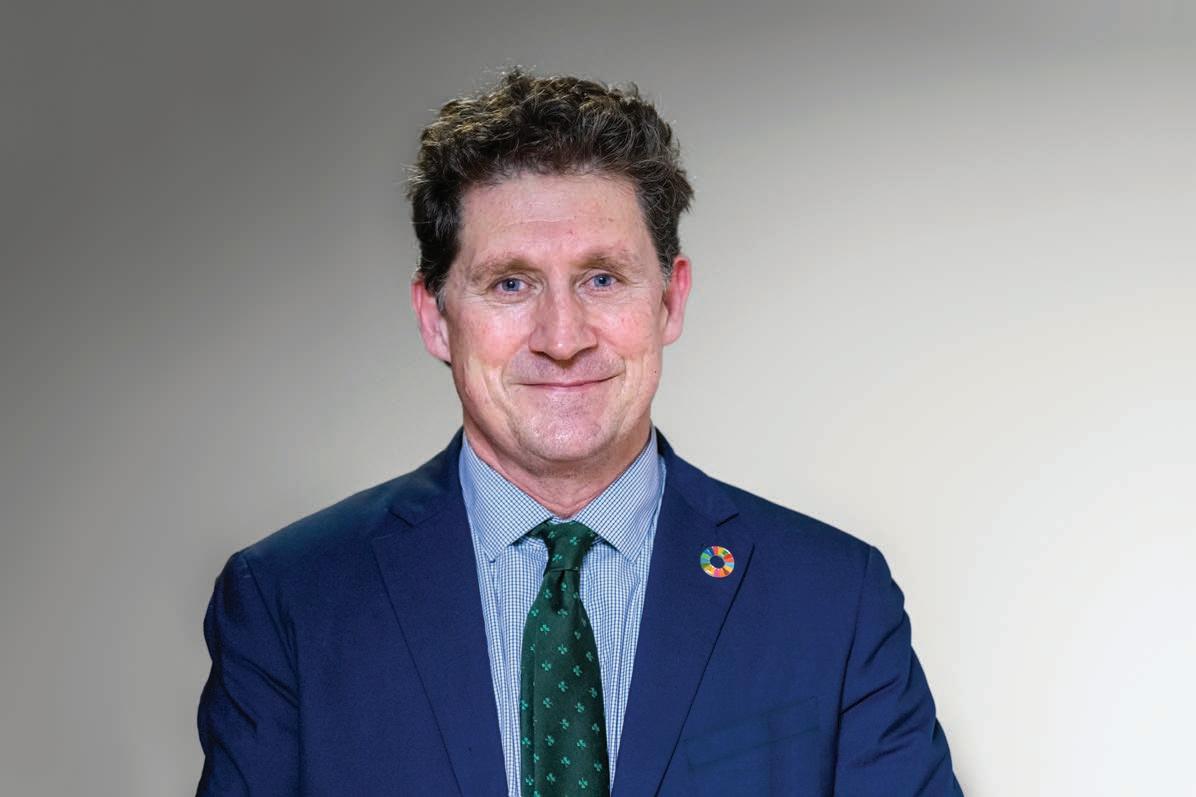


“I am never going to give up on the green agenda...”
Eamon Ryan TD
again in the next general election,” Ryan told RTÉ.
“I have parenting commitments at home which I also want to serve. We have a son with special needs who also requires my attention.”
On the local and European elections, he says: “It was not terrible, but I was hoping to do better and – particularly in the council election – it is that cadre of really good and experienced councillors who have lost their seats, or really talented people on the up who did not quite make it.
“We ran a good campaign, but the tide – like a lot of places in Europe – has been slightly waning on environmental justice in this last year or so. That will turn and come back in, but it was difficult.”
Ryan is one of the most recognisable public figures in Irish politics, having been in and out of the Dáil since 2002. When he joined the Green Party in 1988 at the age of 25, however, he was unemployed and facing challenges in his personal life. The outlet of political activism, he reflects: “Helped me get my confidence back and my energy back through working in the campaigns.
“I also found a home where I agreed with the ethics and the ethos around peaceful politics, ecological imperative, social justice, and democratic constitutional politics.”
Expanding on the origin of his green ethos, Ryan says: “For the decade before [1988], I had been very ecological in my thinking. I was inspired by books like Silent Spring by Rachel Carson, the 1972 Limits to Growth report by the Club of Rome, and the Gaia Theory by James Lovelock.
Describing himself as an “eco-socialist, Christian democrat”, Ryan explains his vision of green politics: “It is about recognising the ecological imperative. We are in deep trouble with loss of biodiversity as well as climate and pollution. You also have to bring social justice with the change to address that – that is the socialist bit.
“Thirdly, it is peaceful politics. Peaceful not just in our roots with the Campaign for Nuclear Disarmament (CND) but in how you respect other people. We do not engage in abusive politics.
“Lastly, it is about believing the people and believing in democratic, constitutional systems.”
Expanding on treatment of politicians and the temperature of Ireland’s political climate, the Minister for Transport is reflective: “Politics has always been a pretty robust exchange in Ireland. You should not become faint hearted if someone contradicts or disagrees with you. Being passionate in politics is not a crime.”
However, Ryan also says: “I do think social media has changed things in two ways. Firstly, it – for some reason – allows conspiracy theories to really thrive. I can understand someone being angry, but being angry about something which is completely fantastical but given common credence on the internet is something which has changed.
“Secondly, I think that the nature of the algorithms in terms of new self-select or their desire to catch your attention to improve their marketing income leads to them feeding you more of the opinions that you already hold. That, in turn, leads to a polarisation of politics that is of real concern to every democracy in the world.”



In the 2020 general election, winning 12 seats, the Green Party was spearheaded into the Dáil as the coalition kingmaker after Sinn Féin ran too few candidates to capitalise on its polltopping performance, with resultant transfers benefitting the Greens in numerous constituencies.
Ryan believes that his party has “worked well with Fine Gael and Fianna Fáil in government” and is hopeful that the Greens will return to government after the next election.
“This is a decade of change. This is not a time to be on the bench or on the sidelines, you want to try and deliver the change that we are delivering socially, not just environmentally.”
He reflects that “such is the urgency and scale of the need for change”, achieving the State’s climate change targets “will not work if it is divisive politics” as “it has to belong to every political party”.
“We have said – and I have always said publicly – that we will work with all political parties as long as long as they are peaceful, constitutional, and democratic parties.”
On the Government’s recognition of Palestine,
announced on 28 May 2024, Ryan states that this was the “culmination of a lot of… activity”.
“It was our party who pushed and delivered that commitment in the Programme for Government to recognise the State of Palestine. Similarly, in the last four years – but particularly in the last year with the horrific events in Gaza and in the kubutzes on 7 October 2023 – we did have a significant role.
“We pushed for things like funding the International Criminal Court and our support for the case being taken in the International Court of Justice with South Africa.”
He acknowledges that “it was not as if we were pushing against Micheál Martin” as “we would have very similar views”, notably abstaining from comment on Fine Gael’s support for recognition of Palestine.
Ryan, who made an abortive run for president in 2004, says that he does not see himself running in 2025.
On his attempted 2004 bid, he reflects: “I did it for a week [in 2004] and I do slightly regret that I did not go all the way with it.



“It was not completely my choice, I was not going to get the 20 nominees that you need so that stopped me in my tracks. But when I look back at that, I think it is a pity that I did not get the chance because I think it would have been a great chance to explain a green political view and vision.”
Regarding 2025, however, he says: “I do not see myself running. I have my own circumstances, my own family circumstances, as well as the fact that I have taken a different route and I am very happy with what I am doing and what I have done, so I do not see the presidency as something I will be going for.”
Ryan’s vision for the future beyond leadership includes political change on this island. The Green Party is an all-island party, and Ryan reiterates this by stating: “I look forward to the day where I live in a united Ireland. I think it will benefit people north and south.
“Our party does not come at it in a divisive way centred on identity politics. Our representatives in the North come from both sides of the community as well as people who do not describe themselves within that narrow divide between nationalists and unionists.
“My personal view is that I think history will show that the reunification of this island, while it will be bumpy and difficult and far from certain, but do I think it will historically be the right thing to do? I do.”
Discussing his future beyond electoral politics, Ryan states that he will always be a green activist, concluding: “I am never going to give up on the green agenda because that is my motivation so I do not see myself stopping.
“It is not something you stop doing. It is something that I will probably bring to the grave because it is something I am really committed to.”



Energy Ireland’s Dubin city centre office and sits down with Local Sales Manager Ruairi Williamson, to discuss how it supports customers to accelerate the energy transition and the critical role of digital innovation.
Reflecting on the last 12 months – his first-year leading sales for Hitachi Energy’s Irish operation – Williamson recalls “the many successes we have achieved from an organisational perspective”.
“Most significantly, Hitachi Energy was awarded an eight-year contract to provide
service solutions for the East West Interconnector (EWIC), a high voltage direct current (HVDC) link which runs for 260km between Ireland and Wales,” he observes.
“Having provided services solutions since EWIC entered operation in 2013, EnCompass, our new service solution,
prioritises customers’ sustainability and ensures ongoing support for the 500MW HVDC link over its lifetime.”
Energy system in transition
Commenting on the fact that Ireland’s energy system is “undergoing a digital

transformation”, Williamson asserts that the sector’s consensus is that this transformation must now be consolidated.
In order to integrate significant volumes of renewable electricity onto the grid, he argues, it is essential to “explore increased HVDC transmission and DCDC solutions”.
Leading by example, in August 2024, Germany’s four transmission system operators – 50Hertz, Amprion, TenneT, and TransnetBW – launched a partnership with Siemens Energy, GE Vernova, and Hitachi Energy to transform the HVDC grid via the development of multiterminal hubs with DC circuit breakers to link new extra HVDC connections. This project is intended to demonstrate the technical feasibility and economic sustainability of multiterminal technology.
While Ireland has made huge progress in offshore wind, it is not without its challenges. Lack of grid capacity and the variable and decentralised nature of renewables necessitates new infrastructure, smart solutions, and innovative components. This is central to meeting Ireland’s offshore wind targets, Williamson says.
In September 2022, the Joint Statement on the North Seas Energy Cooperation (NSEC) committed Ireland to a target of 20GW by 2040 and at least 37GW of offshore wind by 2050. This ambition was reiterated in the Policy Statement on the Framework for Phase Two Offshore Wind, the draft of which was published in January 2024.
“There are ongoing capacity constraints in relation to the grid. If we want to achieve a total of at least 37GW of offshore renewable energy by 2050, business as usual will not work,” Williamson asserts.
“However, state agencies such as the Maritime Area Regulatory Authority (MARA) alongside policy frameworks and roadmaps such as the National Marine Planning Framework (NMPF), Powering Prosperity, Irelands Offshore Wind Industrial Strategy, and the Future Framework for Offshore Renewable Energy will hopefully accelerate Ireland’s offshore wind energy programme.”
Grid operators therefore face new challenges – fluctuations in intermittency, frequency, balancing, and inertia – all of which require innovative solutions.
Successful grid transformation which delivers the necessary grid flexibility “hinges on digitalisation”.
Ruairi Williamson, Local Sales Manager, Hitachi Energy Ireland
“Given the variable and decentralised nature of renewables, such as wind generation and solar PV, increasing renewable energy penetration onto the grid necessitates new infrastructure, smart solutions, and innovative components,” Williamson suggests.
“Hitachi Energy’s smart grid solutions manage fluctuating energy generation, while innovative grid components, including sensors, ensure operational flexibility for more agile and efficient decision-making.”
Successful grid transformation which delivers the necessary grid flexibility, Williamson argues, “hinges on digitalisation”.
“Grid distribution challenges cannot be solved without better operational technology being deployed,” he says.
Elaborating on Hitachi’s pursuit of accelerated decarbonisation and enhanced efficiency across the energy system, Williamson references recent eco-efficient innovations in high-voltage equipment to deliver a more sustainable grid while driving down harmful greenhouse gases.
“Take, for instance, F-gases – the most potent greenhouse gases – which account for a total of 2.5 per cent of greenhouse gas emissions across the EU. Now, the EU’s new F-gas regulation aims to save 40 Mt CO2eq by 2030,” he begins.
“There are alternatives to F-gases in new electrical transmission equipment – or switchgear. Sulphur hexafluoride, more commonly known as SF6 is one of the most potent greenhouses gases and is set to be phased out by 2031.
At Hitachi Energy we have developed a portfolio of SF6-free switchgear which is a significant lead forward in high-voltage innovation. “EconiQ is Hitachi Energy’s compelling portfolio of SF6-free switchgear that enables long-distance transmission of massive volumes of electricity while eliminating the use SF6, ultimately adding considerable value for grid operators,” Williamson explains, adding: “The EconiQ portfolio demonstrates the scalability of Hitachi Energy’s pioneering technologies, which are fundamental to accelerating the energy transition through digitalisation.”
DC multi-terminal hubs – which hinge on DC switchgear with DC circuit breakers –enable the efficient distribution of large volume of offshore wind. DC switchgear directly connects DC lines to channel energy flexibly. Including the breakers as part of the switchgear is an innovative approach.
Referencing Hitachi Energy’s HVDC legacy, Williamson is keen to support the expansion of multiterminal HVDC systems as well as introducing new technologies like Hitachi Energy’s hybrid HVDC breaker that will define DC grids of the future.
“Hitachi Energy has led on the delivery of commercial HVDC technology for nearly seven decades and has delivered over half of the world’s HVDC projects.
“Now, in a world first – and unique to Europe – multiterminal hubs will establish extra-high voltage DC power grids to improve the use of DC lines while simultaneously supporting the existing AC grid which will remain the spine of energy transmission. It is a concept that is set to significantly contribute to the delivery of a net zero grid,” he explains.

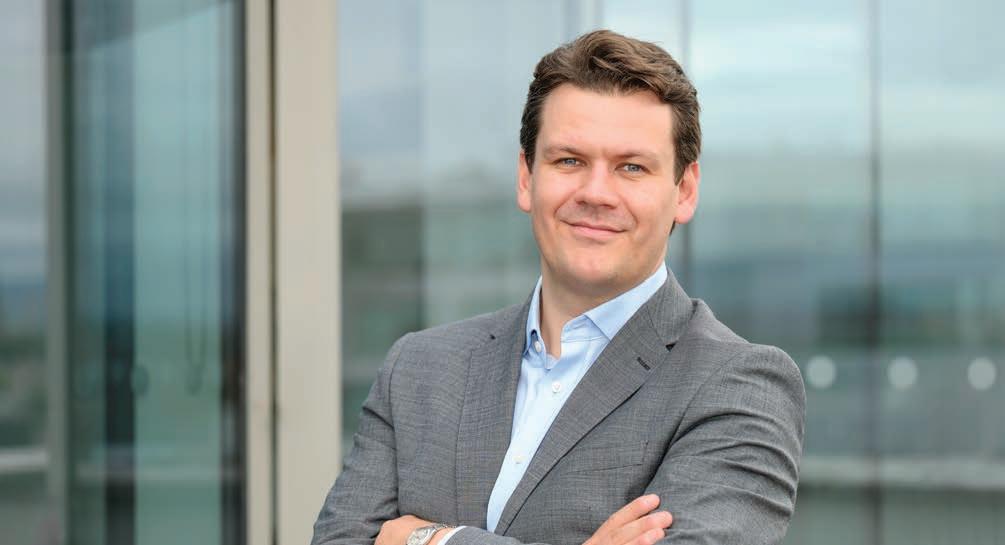
Suggesting that artificial intelligence (AI) holds exciting potential both from an IT perspective, and specifically for Hitachi Energy, from an operational technology perspective, Williamson outlines recent partnerships with other technology giants.
In 2023, Hitachi Energy and Google Cloud agreed a strategic collaboration to develop cloud software products and services to support the global energy transition. Already launched, Velocity Suite Power Prices support efficient decision-making around investment by developers and operators of renewable generation and battery energy storage systems, alongside other energy sector stakeholders.
Further collaboration is set to develop new and innovative solution for utilities and renewable energy producers by using Hitachi Energy’s Energy Portfolio Management and Google Cloud’s data analytics, scalable infrastructure, AI, and machine learning,
“Informing the transformation of the grid, and at the core of the energy transition are data and analytics,” Williamson insists, adding: “Globally, Hitachi Energy’s customers expect solutions that help accelerate the delivery of sustainability goals. Through its partnership with Google Cloud, Hitachi Energy is ensuring that its customers can digitalise to unlock agile decision-making capacity.”
Similarly, Hitachi is also collaborating to combine its domain solutions in
operation technology and leadership in the energy sector with NVIDIA’s generative AI expertise to accelerate digital transformation. Announced in March 2024, the collaboration will see the establishment of an AI Centre of Excellence. “We anticipate that this will accelerate social innovation to solve complex societal challenges.
“We are collaborating with another Hitachi Group company, GlobalLogic, based in Athlone, County Westmeath, using their AI expertise and operational technology, to drive insights for customers.”
Simultaneously, Williamson wants to “win at the edge”, bringing more renewables onto the grid and supporting sectors such as transport and industry on their electrification journeys.
In fact, in 2023 Hitachi Energy was selected by Bus Éireann – Ireland’s national bus company – as its infrastructure partner. The partnership will see Hitachi Energy construct and install the new EV charging infrastructure at the Roxboro bus depot and maintenance facility in County Limerick.
“That is an excellent programme and fantastic opportunity for Hitachi Energy to partner with the National Transport Authority (NTA) and enable Bus Éireann to provide an electric bus fleet for the mid-west region. It is also a project that produced important lessons that we can apply elsewhere as we support more transport customers on their decarbonisation journeys.
“Meanwhile, industry is often overlooked because Ireland has a relatively modest industrial legacy. But the industry that does exist is on the same digital journey as us. With our global footprint, Hitachi Energy Ireland can add value at the beginning of that journey, using lessons from first movers elsewhere to provide insight for Irish organisations experiencing similar challenges.”
When Williamson last spoke to eolas Magazine in June 2023, Hitachi Energy’s Irish organisation was staffed by 75 people. By August 2024, this increased by 20 per cent to meet growing demand.
“As our single most important asset, our first priority is people,” he affirms, adding: “From a strategic perspective, we anticipate that further skills capacity will be required between now and 2030. We are experiencing strong tailwinds and project a positive macroeconomic outlook for the business,” Williamson remarks.
However, gaps in skills and capacity are a challenge for the electricity industry more generally. Williamson stresses the need to “attract more talent into the industry”. “We need more skills, and more people, and more diversity if we are to accelerate to net zero and meet our 2030 targets,” he insists.
Matching the rhetoric with action, for a second consecutive summer, Hitachi Energy partnered with University College Dublin Lochlann Quinn School of Business to run a summer internship programme for four students.

“In the current context, talent recruitment and retention are extremely competitive and much of the skills required must be sourced from abroad. We must build up an indigenous talent pool.”
Suggesting that higher and further education institutions, industry, and government must coalesce to bridge the skills gap in the energy sector, Williamson reiterates that “decarbonisation will not be delivered without the workforce”.
After people, health and safety “are our very clearly defined corporate licence to operate”, Williamson explains. He adds that this focus is informed by training, risk management, and accountability.
“We have an excellent culture of safety. In 2023, Hitachi Energy reached 10 years without experiencing a lost-time incident. That is a testament to a strong safety culture within the business – it is not something we simply include in a presentation slide; it is the lived experience of our people,” Williamson asserts.
This is underpinned, he explains, by a ‘speak up’ culture, when a risk or an integrity challenge emerges, “staff are empowered to identify and call attention to it”.
Williamson reemphasises Hitachi Energy’s global presence. With a footprint in 140 countries, the global company provides services and technologies to customers across a variety of sectors – including utilities, industry, transport, data centres, and infrastructure.
All of this work is underpinned by enhancing access to electricity while unlocking efficiency across the energy value chain, he says.
“Hitachi Energy has significant organisational experience and corporate memory of the energy transition. We can draw on our experience in countries which have been first movers in the energy transition. We have had some significant successes in Germany, the Netherlands, and most recently, in France. We want to take those innovative frameworks and bring them to Ireland,” he says.
“We are seeking to standardise as much as possible, helping to resolve market challenges. For instance, given the
“As a global technology leader, Hitachi Energy is accelerating the energy transition so that it is safe, reliable and secure to deliver a sustainable future for all.”
increased demand across the industry, pre-engineering can shorten lead times for the delivery of equipment and ensure that customers can meet their key deadlines.”
There is, Williamson notes, an extricable alignment between sustainability and technological innovation placing Hitachi Energy at the heart of the energy transition and the digital transformation needed in the future system.
Dedicated to innovative future technologies and advancing a more sustainable energy system, Hitachi Energy has an important role in

accelerating the energy transition through digitalisation.
Technology holds the key to accelerating the energy transition across the world and Hitachi Energy stands ready to jump-start this revolution. “As a global technology leader, Hitachi Energy is driving the sustainable energy future for people and plant. We want to work with our customers at the beginning of their decarbonisation journey. We want to be a planning partner, applying our global experience to their planning processes, to reduce project lead times,” Ireland’s Sales Manager concludes.
An alumnus of the Abbey Christian Brothers’ Grammar School, Newry, County Down Williamson completed a BEng in aerospace engineering at the University of Liverpool before joining Suretank Group. After working in the energy industry across south-east Asia, western Australia, and west Africa, Williamson returned to Ireland to take up a role with Fluke Corporation. Completing an MBA at the UCD Michael Smurfit Graduate Business School, he joined Hitachi Energy as Local Sales Manager in April 2023.
Though he now lives in Terenure, Dublin, Williamson is a native of Crossmaglen, County Armagh, and “felt privileged” to be at Croke Park in July 2024 when Armagh won the All-Ireland Senior Football Championship for only the second time in its history. Williamson describes it as “one of those days that you will never forget”.


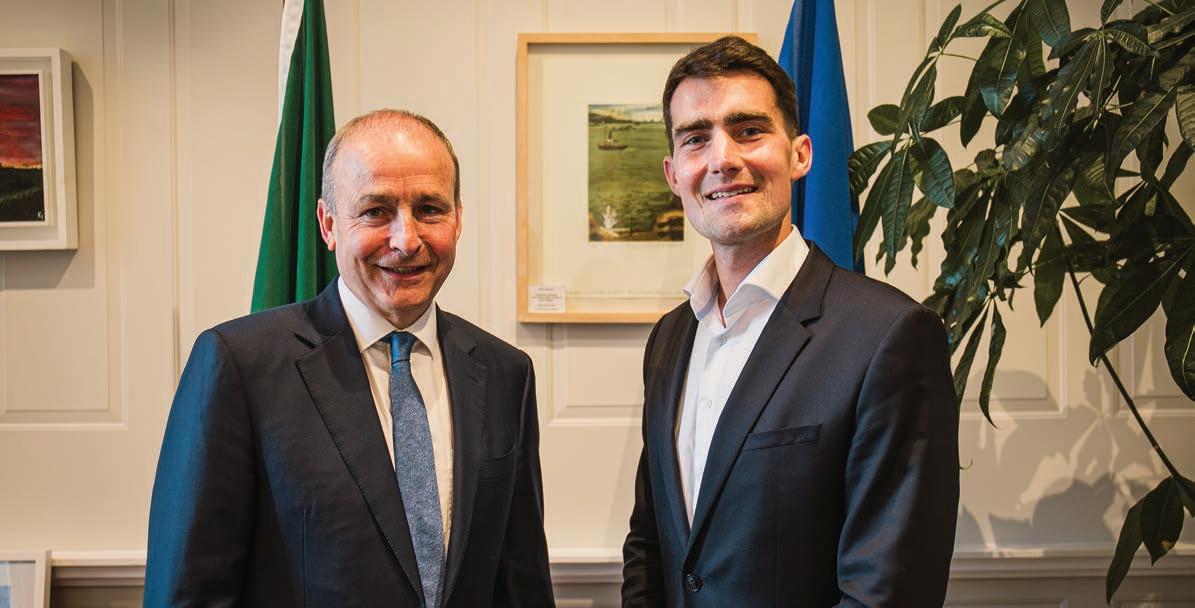
Following on from the cabinet reshuffle in April 2024, three changes were made among Fianna Fáil’s ministerial portfolios within the 34th Government of Ireland in late June 2024.
Jack Chambers TD, Minster for Finance


Following Fianna Fáil’s retention of its status as the largest party of local government, Jack Chambers was appointed deputy leader of the party on 19 June 2024. Ostensibly, Chambers was rewarded for the “commitment and organisational skills” he demonstrated as Fianna Fáil’s director of local elections.
Exactly one week later, he was appointed Minster for Finance in place of former cabinet colleague Michael McGrath who has been nominated by the Government to become a European commissioner. At 33 years old, Chambers is the youngest person to hold the portfolio since Michael Collins was appointed in 1919.
Even before these recent appointments, in a conversation with this publication, a former senior member of Fianna Fáil’s background team tipped Chambers as Micheál Martin’s likely successor. That now looks more likely than ever, notwithstanding the machinations of other contenders.
First elected to the Dáil in 2016, to date, he has served as a Minister of State in the Department of Finance (2020), the Department of Tourism, Culture, Arts, Gaeltacht, Sport and Media (2020-2022), the Department of Defence (2020-2022), the Department of the Environment, Climate and Communications, the Department of Transport (2022-2024), as well as Government Chief Whip (2020-2022). Prior to this, he served as a member of Fingal County Council, including as deputy mayor, and is a qualified medical doctor.
Speaking with eolas Magazine in 2022 – while serving across two portfolios, as well as Government Chief Whip – Chambers was typically measured in his response to a question about his ambitions within the Fianna Fáil hierarchy.
“That is not in my thinking at the moment. I am honoured to do the job I do, and I look forward to doing it over the coming weeks and months. I am someone who is focused and driven by the issues and areas that I have responsibility for and that is my motivation for the current term ahead,” he said.
In the meantime, the Tánaiste commented on his appointment and asserted: “No doubt he will make a very effective Minister for Finance and will work with the Cabinet, [PENDR] Minister [Paschal] Donohoe in particular in the context of the forthcoming budget and work collectively with all of our ministers to drive the next phase of this government forward.”


Minister of State with special responsibility for International and Road Transport and Logistics, and Minister of State with special responsibility for Postal Policy

James Lawless has replaced Jack Chambers in two portfolios, namely as Minister of State at the Department of Transport with special responsibility for International and Road Transport and Logistics and Minister of State at the Department of the Environment, Climate and Communications with special responsibility for Postal Policy.
Said to be extremely ambitious, Lawless was first elected to the Dáil in 2016, having previously served as a member of Kildare County Council, including as Mayor of Naas. According to his profile on gov.ie, Lawless initially entered political life as a “commuter activist” and is a qualified barrister.
Upon Lawless’ appointment on 27 June 2024, Tánaiste Micheál Martin TD said: “He is a very diligent legislator who will do a very fine job as a Minister of State.”
Complimenting the work of his predecessor, Lawless indicated that he was looking forward to “getting stuck into my brief”.

Minister of State for Trade Promotion, Digital and Company Regulation
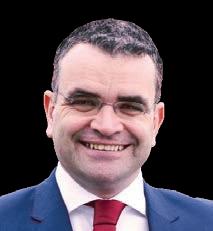
Department of Enterprise, Trade and Investment with special responsibility for Trade Promotion, Digital and Company Regulation.
Reacting to his promotion on 27 June 2024, Calleary said: “I am very honoured to be rejoining Cabinet. I would like to thank the Tánaiste for the opportunity.”
Upon formation of the 32nd Government on 27 June 2020, Calleary was initially appointed a Government Chief Whip –though was not appointed to cabinet. On 1 July, he was further assigned roles as Minister of State at the Department of Culture, Heritage and the Gaeltacht, with special responsibility for the Gaeltacht, and Minister of State at the Department of Transport, Tourism and Sport, with special responsibility for Sport.
Calleary then briefly (from 15 July 2020 to 21 August 2020) served as Minister for Agriculture, Food and the Marine in the 32nd Government of Ireland before resigning amid a scandal provoked by alleged breaches of public health restrictions (subsequently rejected by the District Court) during the Covid-19 pandemic. Calleary had himself replaced the Government’s original Agriculture Minister, Barry Cowen, after his appointment was terminated – just 18 days into the role – on 14 July, following a drink-driving controversy.
On 24 August 2023, Calleary made his return from the backbenches replacing Robert Troy as Minister of State at the Department of Enterprise, Trade and Employment with special responsibility for Trade Promotion, Digital and Company Regulation. Troy had resigned amid a “number of errors now that are of my making directly or indirectly” in relation to property interests.
Calleary has represented Mayo in the Dáil since 2007 and has previously served as a minister of state in the then-Department of Enterprise, Trade and Employment (2009-2010), the Department of the Taoiseach (2010-2011), the Department of Finance (2010-2011), the then-Department of Enterprise, Trade and Innovation (2010-2011). Before that, he was “involved in the banking and business sectors”.
Speaking to eolas Magazine as Minister of State with special responsibility for Trade Promotion and Digital Transformation earlier in 2024, Calleary emphasised: “I am gathering a lot of ideas and thoughts that will be in a Fianna Fáil digital manifesto at the next election. I am very focused.”

KPMG hosted a round table discussion with key commercial semi-state bodies, industry, and the national research centre for construction technology and innovation to determine how sustainable infrastructure can be delivered through enhanced innovation and collaboration.
What are the main drivers of a sustainable infrastructure system?
Paul O’Neill
There are two main drivers of a sustainable infrastructure system. Firstly, having joined up thinking when it comes to delivering a strategic framework for public capital investment, such as the National Development Plan. However, what I have observed over the years is evidence of siloed thinking. We must step back and ensure collaboration across the board via centralised delivery units. Secondly, we must be conscious of what we need from our sustainable infrastructure; we can sometimes be too inward when we consider sectoral sustainability developments. We need to better describe the wider societal risks of
not doing projects which should help lead to more informed decisions between infrastructure delivery and sustainable development.
Henry Bouchier
Policy is ultimately what will drive a sustainable infrastructure system. Intertwined with that, it requires organisations that show leadership from the top and sustainability must be factored into the decision making to invest in and to proceed with projects. We must be cognisant of the risks of not driving forward sustainable infrastructure. Similarly, strong leadership is key to ensuring that we have all stakeholders engaged. If we can optimise these drivers, we will unlock a pipeline for sustainable infrastructure which can inspire confidence in industry.
Michael Goan
The Land Development Agency’s newly published Sustainable Development Strategy for 2024-2028 works down from the UN Sustainable Development Goals, European policy and legislation, followed by national policy and legislation and how this manifests in local authority development plans and considers how that impacts the LDA from a demand perspective. When tasked with delivery and regeneration projects, social infrastructure is an important aspect of the LDA’s work. We work with colleagues in the energy, transport, housing, and water sectors to strategically plan ongoing projects, as well as medium- tolong-term projects. When it comes to delivering sustainable infrastructure, we must always remember the communities we are serving and ensure that in addition to transport, water, and other physical infrastructure, that the social infrastructure to support sustainable communities is accessible. This includes education, healthcare, employment, sports, and community infrastructure.

“Where are the political champions of major infrastructure projects?”
Paul O’Neill
Mark Macaulay
Uisce Éireann is delivering sustainable solutions such as integrated constructed wetlands for wastewater treatment. To support this, we require enhanced capability and capacity in our supply chain. Given our dependence on this supply chain for sustainable infrastructure delivery, we need a commitment to long-term funding which will signal to the market that a strong pipeline for sustainable solutions exists. Cooperation with our regulators is also essential to ensure that we have a cohesive approach to sustainability.
Daniel McCrum
Legislation drives sustainable infrastructure delivery, especially given the enhanced importance of a circular economy and our emissions reductions targets. However, one challenge we face is relatively low productivity in the construction sector – despite the economy operating at virtually full employment – given that the cost of the infrastructure we are developing is getting more expensive. Sustainability is an added layer on top of productivity and cost, and we are currently at a stage where large companies are undergoing a process deciding how best to meet all these requirements. As such, some of these factors are not directly about sustainability, but the change that is happening is resulting us needing to have a conversation about the wider context because these are all important variables to consider.
Paul Tierney
There

Paul Tierney
Paul Tierney is the CEO of MMC Ireland having taken up the role in May 2023. MMC Ireland is the leading voice of Ireland’s growing MMC sector. Its role is to be the knowledge bridge between industry, government, and wider stakeholders. Its mission is to provide a unified voice, advocacy, and support to help Ireland’s MMC sector pioneers grow and succeed. Tierney has 30 years’ experience in the MMC industry having previously been the CEO of ESS Modular, one of the UK and Ireland’s leading off-site construction companies.

Paul O’Neill
Paul O’Neill is Managing Director in KPMG’s infrastructure and government advisory team. He has over 20 years’ experience advising on the funding of large-scale capital projects across the public and private sector with specific experience in project structuring, strategic assessment reports/business cases, delivery options analysis, longterm contract delivery and management (Public Private Partnerships (PPP)), tender assessments, value for money assessments, contract negotiation, corporate governance advice, restructuring/refinancing and stakeholder management. O’Neill joined KPMG in July 2022 having previously been Head of Financial Advisory with the National Development Finance Agency (part of the National Treasury Management Agency) responsible for providing financial advice across the public sector.

Michael Goan
Michael Goan is an RIAI-registered architect with 26 years professional experience and also holds an MSc in advanced environmental and energy studies. He is a former Chair of the RIAI sustainability task force and a current board member of the Irish Architecture Foundation. Goan joined the Land Development Agency (LDA) in 2020 and leads its sustainability team, which has recently completed and published the agency’s Sustainable Development Strategy.

Daniel McCrum
Daniel McCrum is an associate professor in structural engineering at University College Dublin. McCrum is the Director of University College Dublin’s Modern Methods of Construction Research Group (MMCRG). He is also a member of the centre executive management committee and Co-Principal Investigator of Construct Innovate – Ireland’s national research centre for construction technology and innovation – where he leads the pillar theme challenge on productivity, affordability, and cost, which relates directly to modern methods of construction.

Mark Macaulay
Mark Macaulay is Innovation, Standards, and Specifications Senior Manager at Uisce Éireann (UÉ) and is responsible for delivering innovation strategy and portfolios centred on sustainability. Previously, he led the asset planning team responsible for national water and wastewater infrastructure capital investment planning as well as the development of Uisce Éireann’s asset management capabilities. Macaulay is a chartered engineer with over 25 years’ experience across a range of operational, technical, and management roles in the public and private sectors.

Henry Bouchier
Henry Bouchier is the manager of the Civil, Environmental, and Renewable Engineering Department within ESB, a multi-disciplinary technical team that is focused on delivery of the ESB Net Zero 2040 strategy. He is a civil engineer with over 20 years’ experience and in that time has worked both in Ireland and abroad delivering large infrastructure projects in the energy sector. He has significant experience in the development of renewable energy projects in Ireland and the UK.

“There are many factors driving sustainable infrastructure delivery, but the main one is need; we must do this because there is no alternative.” Paul Tierney
infrastructure delivery, but the main one is need; we must do this because there is no alternative. Speaking to different stakeholders in this context, it is clear that we need a cohesive plan driven by government. While this is undoubtedly in progress, it is not fully in place right now. In its absence, sustainable infrastructure will not be delivered.
How can government policy best inform the ambition of sustainable infrastructure delivery?
Henry Bouchier
There have been many developments, with government policy leading transformation through green
procurement and the transition to a circular economy. Policy is followed by standards, regulations, and licencing, for example, how demolition waste is categorised. We must now align all regulation and licensing relating to sustainable infrastructure development in a cohesive manner. One positive in this regard is that the will to do so is evident, as we saw with Taoiseach Simon Harris’ comments about creating a department of infrastructure. This could be a very positive change for sustainable infrastructure development.
Michael Goan
What is interesting about the Taoiseach’s proposal on a department of infrastructure is that it points to a more
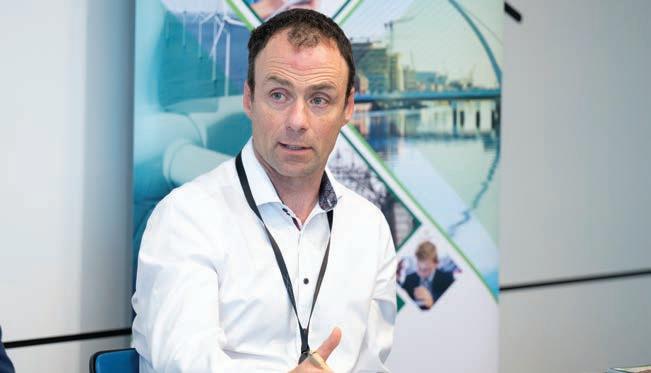
centralised approach being seen as necessary for delivery. The new Planning and Development Bill – which, once enacted, will increase the lifespan of development plans from a seven-year to a 10-year cycle – is vital and can support the longer-term planning required to deliver complex development particularly in urban areas and a coordinated approach to delivering the supporting infrastructure. There is a lot more potential for centralised coordination.
Paul O’Neill
Government policy sets the direction of ambition and there has been a shift in emphasis in the importance of getting projects delivered as soon as possible. Multiannual funding is key to delivering this. Whether we need a new department to do this is another question, but until you unlock that clarity and certainty of funding to key delivery partners, it is difficult for these partners to be able to outline long-term deliverables.
Mark Macaulay
Policies have set out what required infrastructure is required. The challenge for all organisations is to figure out their respective courses of action for delivery. However, with range of policies being rolled out, this is a dynamic and complex challenge. Water is at the centre of a lot of policy, whether it is housing, hydrogen, or heat, making this a complex landscape for Uisce Éireann. Early engagement with key stakeholders works well to ensure cross-sectoral alignment over these policy objectives so that we develop our action plans in a coordinated manner.
Daniel McCrum
In 2021, a detailed description of needs for the Irish construction sector was published where the skills challenges and opportunities in the construction sector were analysed and outlined the need for digitalisation of the planning process, a
“Policy is ultimately what will drive a sustainable infrastructure system.” Henry Bouchier
construction technology centre, and digitalisation of the construction sector. This led to the creation of Construct Innovate, Build Digital, etcetera. I think an updated version of this analysis which accounts for new developments since then would be beneficial. While looking at UK policy as an exemplar is a useful exercise, we should also remember that Ireland is a small and flexible nation, and we can innovate beyond what others are doing. Similarly, our challenges are slightly different to those of the UK, and we have the space to be more ambitious.
Paul Tierney
What we need is a department for joined up thinking, and if that is called a department of infrastructure, that will work. What I have seen is a lack of joined up thinking and this is not because of a lack of willingness, it is because people instinctively operate in siloes. A centralised point of operations for planning infrastructure delivery in transport, education, health, and housing would bridge the existing gap in joined up thinking which is currently inhibiting progress.
What are the most significant barriers to effective innovation and collaboration within the broader infrastructure sector?
Daniel McCrum
Over 91 per cent of those working in the construction sector are employed by SMEs with almost 93 per cent of those working in the construction sector are employed by SMEs with six or fewer employees. That is the reality and there are two primary barriers in this context. Firstly, the ability of these SMEs to invest in innovation is relatively limited. That is where Construct Innovate can help and at very low cost. Secondly, some of these organisations may also have a limited understanding of what innovation can achieve for them. Hopefully, we can change that through Construct Innovate. On top of this, certification for building products – whether in demolition waste or housing construction – is challenging. The certification process exists for good reason, but it is costly, and it takes a long time. Accelerating that process and making it cheaper is a route within infrastructure that we could help companies. Construct Innovate is set to undertake a project with the Department of Housing, Local Government and Heritage to publish standardised MMC details to help companies achieve this. With €3.6 million funded through Enterprise Ireland, it is a prime example of efforts to derisk innovation for companies within the construction sector.
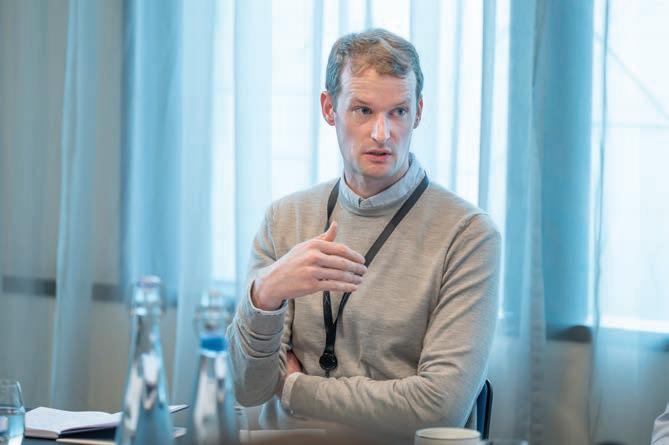
“One challenge we face is relatively low productivity in the construction sector.”
Daniel McCrum
Paul Tierney
Certification is the biggest barrier to effective innovation in the MMC sector in Ireland. The gatekeeper is the National Standards Authority of Ireland [NSAI]. There has been a renewed impetus in the NSAI since Martin Searson, Head of MMC, has been involved. However, it currently takes at least 24 months for a new product, system, or innovation within construction to get certified by the NSAI. It also costs a huge amount of money. I raised this with the Department of Enterprise, Trade and Employment and the Modern Methods of Construction (MMC) Leadership and Integration Group in July 2024. The challenge is that the NSAI is under resourced.
There are around only 20 Agrément certifications in existence in the State. The backlog is a multiple of that. The NSAI is a necessity and there is huge opportunity for a new body, either alongside or under its remit, to become an assigned certifier for manufacturers and contractors. There must be a refreshed approach to how new entries to the market are certified.
Paul O’Neill
Where are the political champions of major infrastructure projects? Who is championing MetroLink, for example? MetroLink is a project that is critical to
the State from a socioeconomic perspective, yet the focus is on how much it will cost and whether it will experience challenges like those associated with the new national children's hospital rather than clearly conveying the massive societal benefits for delivering the project for the State and to the public. As a result, public servants are understandably risk averse and are under resourced for delivery. There must be more done to support public service delivery teams.
Mark Macaulay
Uisce Éireann is tasked with delivering results and achieving value for public money. As a result, we have implemented governance, processes, standards, and specifications, while building a supply chain that can deliver consistency over time. The innovation that we now require introduces variables which challenge the demand for certainty and consistency. From an Uisce Éireann perspective, innovation requires flexibility around funding without risking our primary goals to treat water and wastewater and to get to the point where these could be scaled through standards to give certainty that they will deliver results. Without that flexibility, we cannot easily deliver innovation opportunities.
Michael Goan
Depending on perspective, the definition
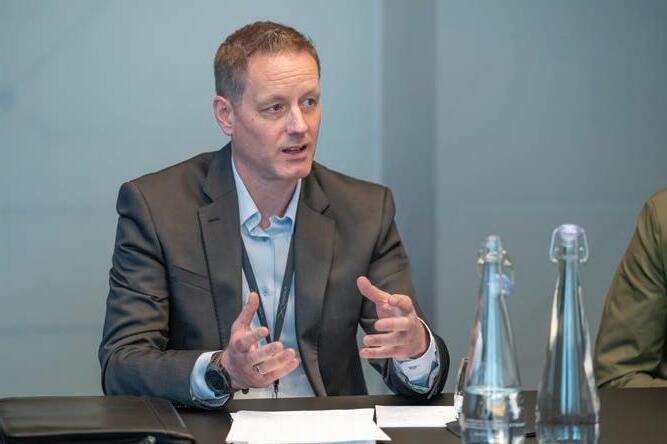
“Given our dependence on this supply chain for sustainable infrastructure delivery, we need a commitment to long-term funding...” Mark Macaulay
of innovation varies. To drive innovation, it is necessary to first have a very clearly defined objective. To address this, the Land Development Agency published an Apartment Typology Booklet, signalling to the market what an LDA home looks like. We spent a lot of time working with industry partners and certification bodies, the National Disability Authority, the construction industry, and manufacturers of MMC solutions to determine what we were trying to achieve. By standardising our ask, industry is incentivised to come up with innovative solutions. If we were constructing different units on each of our sites, it would pose a significant challenge for our supply chain to scale up for consistent delivery. At the core of this is increased efficiency which requires absolute clarity on what the objective is.
Henry Bouchier
Project delivery models are often solely focused on the delivery of a project. Another way of looking at innovation is that it is driven by necessity. There was a problem that had to be solved. Learnings captured during a project can be carried into others and disseminating these across the industry is important. Likewise, early contractor involvement and understanding your supply chain are important. For instance, I can pursue an innovation for building a substation, but this can be enhanced through engagement with project partners. It is
important to ensure timely engagement with the supply chain. Much of the IP around projects and innovation is siloed in individual organisations. We must unlock this to our mutual advantage.
Paul Tierney
People talk about the lack of an infrastructure pipeline when, in reality, a huge pipeline exists across housing, healthcare, and education. The challenge is that the existing pipeline is neither sustainable nor buildable from an industry perspective. This is a major barrier to investment. Engaging industry to establish a buildable pipeline will open the market to significant investment. Simultaneously, there is a general absence of standardisation – though I know that the LDA and DHLGH and Daniel’s team at Construct Innovate are working on standardisation in housing. This absence is a massive barrier to investment from the perspective of contractors and manufacturers.
How can the infrastructure market be incentivised to invest in and accelerate innovation in sustainable delivery?
Michael Goan
Over the last 18 to 24 months, there has been an exponential change in attitudes towards sustainability and the built environment as EU directives and
legislation have impacted flows of finance. This includes the EU Taxonomy Regulation for sustainable activities and the Corporate Sustainability Reporting Directive (CSRD) which impacts all the commercial semi-state companies. We have moved from sustainability reporting to a disclosures-based system, whereby we are required to measure the same metrics and report in the same ways to enable comparability between companies. That is a huge incentive for companies. The incentive has shifted as much towards the corporate responsibility and reputational risk management as it has towards commercial drivers. On the demand side, customers are asking for sustainability, as are boards and shareholders on the commercial side.
Daniel McCrum
As Enterprise Ireland often demonstrates, companies which undertake innovation earn more money. So, why are they not all doing it? Speaking with those companies which do not undertake innovation suggests that, for many, derisking innovation is hugely important. Construct Innovate is working to achieve this. In relation to infrastructure specifically, I would love to see the Sustainable Energy Authority of Ireland or Science Foundation Ireland issue funding calls for the infrastructure industry. Industry must inform these funding bodies exactly what it is they require, so they can drive the need. Access to facilities and expertise – including via Construct Innovate – is important. The expertise exists, but we must establish effective networks between people. We need significant investment in our facilities for product development and certification. Industry needs to contribute to this.
Paul O’Neill
As evidenced by the fact only two or three international contractors have a presence in the State, the infrastructure market does not believe that there is a clear pipeline of opportunities. The NDP is ambitious, but we must demonstrate what opportunities exist. Otherwise, rather than wasting time on tendering, key market players will simply opt to work elsewhere.
Paul Tierney
Why do companies not undertake innovation? There is consensus that engaging with Enterprise Ireland is too onerous and the time and effort required for grant aid applications outweighs any benefit. Alternatively, engagement with
Construct Innovate is a much more streamlined process that unlocks exponential benefit.
Henry Bouchier
Who benefits from innovation?
Ultimately, while the companies that develop the infrastructure do benefit sustainable infrastructure development will have a positive impact for wider society. Therefore, we must create the conditions whereby innovation can happen, for example through incentivisation in the procurement process, In doing so, it is possible to cultivate innovation in sustainable infrastructure delivery.
Mark Macaulay
Uisce Éireann has observed the confidence that is unlocked by having a sustainable multiannual pipeline. This requires a signal to be sent to the market that there is a long-term opportunity and profit margins will be made. In private sector markets, shareholders are relying on companies’ sustainability credentials. For large infrastructure projects, there must be a national realisation of the cost of achieving our sustainability targets. We are engaging with utilities and representative bodies across Europe to develop viable options and solutions. Understanding the factors behind a strong pipeline is key to creating market commitment.
How can collaboration help navigate regulatory requirements and compliance challenges in sustainable infrastructure development?
Paul Tierney
The biggest collaborative project I have experienced was the delivery of homes for Ukrainian refugees in 2023 and 2024. All stakeholders collaborated throughout the process of delivery. Under the leadership of the Office of Public Works (OPW), which was the government agency managing the project, Sisk Group managed the contracting side alongside five manufacturers and a design team. The stakeholders were happy to collaborate because there was a standardised pipeline for at least 12 months they and were confident in committing resources for delivery. I believe this is a blueprint as to how we can deliver going forward.
Mark Macaulay
The main contributing factor in the success of delivering homes for Ukrainian refugees was a single focus. All
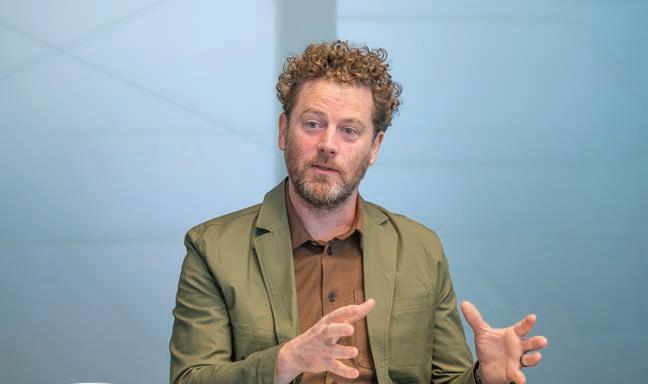
“Over the last 18 to 24 months, there has been an exponential change in attitudes towards sustainability and the built environment...”
Michael Goan
stakeholders knew the problem they were there to solve. In the absence of a single vision, there is a tendency for different stakeholders to retreat into their own siloes. Uisce Éireann has its own targets which, for natural reasons, are related to water and wastewater. However, if there is a compelling vision for us all to work towards, then the opportunities for collaboration will multiply. 92 per cent of companies have six or less full-time staff, so if the large companies can lead and create the knowledge, the smaller ones will follow and bring about the kind of progress we need.
Michael Goan
On the wider concept of infrastructure, we must remember that this includes social infrastructure. When we go into communities, we have a red line delineating the site, but there is also a catchment area surrounding it in which people live and have lived, often for several generations. What we need to remember is the importance of engaging with these communities and bringing them along the journey. Social sustainability relies on buy-in from the communities within which you are working.
Daniel McCrum
We need to appreciate that the construction industry – given its experience – is very conservative.
Government leadership has been strong through recent change and the key departments have made themselves available to industry leaders. In Construct Innovate, we have seen that the sharing of resources is taking place with multiple companies buying into single research projects, because industry leaders can see the value in collaboration. Also critical is that we are openly publishing the findings upon the completion of these research projects so that wider learning is achieved.
Henry Bouchier
While previously the sector has been slow at times to do this, we must ensure that we bring stakeholders on board particularly those at community level. I thought the recent oral hearing process for the MetroLink project was well handled in that An Bord Pleanála gave stakeholders the chance to be heard including at local community level.
Paul O’Neill
With the NDP, the various policy initiatives which have taken place in recent years, the frameworks are there for progress to take place and this will outlast any government cycle. The Irish market is flexible, and we have the skillset and ambition to deliver. We must back ourselves and facilitate the space for innovation.
















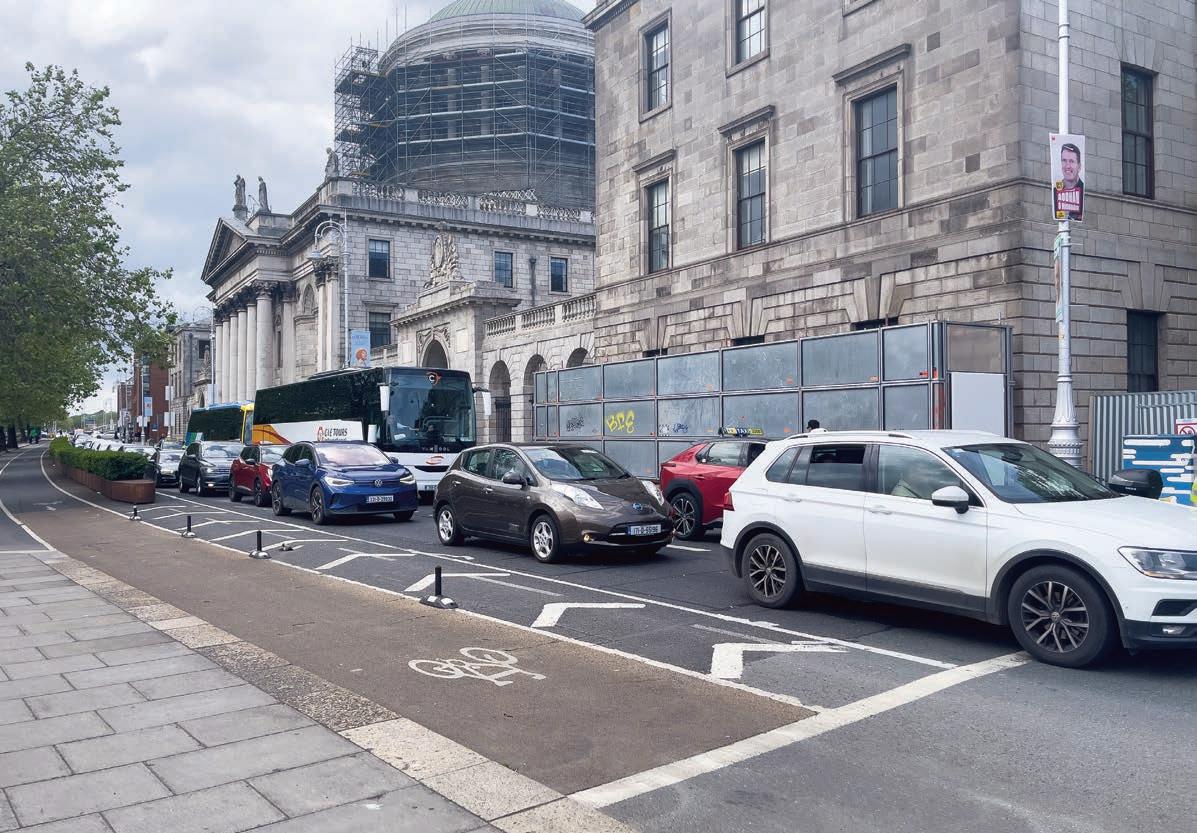
With the first phase of Dublin City Transport Plan 2023 having entered into force on 25 August 2024, Rosalind Skillen assesses how these new traffic measures have changed access to the quays with the aim of removing traffic from a core part of the city centre.
The initial phase of the Dublin City Transport Plan is a first step in improving Dublin’s transportation system and reshaping the urban environment to enhance the capital’s accessibility.
What are the new traffic measures?
Two measures will be implemented on the north quays at Bachelors Walk and on the south quays on Burgh Quay and Aston Quay. These measures consist of road marking and signage changes.
Private vehicle traffic along the north and south quays will be removed at these locations, leaving space for buses, taxis, cyclists and pedestrians only.
All other routes on the quays and in the city remain the same, including northsouth and south-north access to all Liffey bridges and most routes to hospitals and city centre car parks. There will be no changes to disabled bays, loading bays, or taxi ranks. Access for residents will be maintained although there may be a different route to or from the area. The hours of
operation will be 07:00 to 19:00, Monday to Sunday.
Reacting to the plan, Brian Caulfield, professor in transportation at Trinity College Dublin says: “Dublin city is following what most other European cities are doing at the moment and that is giving more space to public transport and active mobility, like walking and cycling. The city has huge congestion issues, air quality issues, and the best way to fix those issues is to give more space to allow people to move quicker on public transport.”



Transport is, by far, the largest sources of energy-related CO2 emissions in Ireland, and the Sustainable Energy Authority of Ireland (SEAI) reported that transport accounted for 40 per cent of energy related CO2 emissions in 2022. By promoting shared modes of transport, these measures will reduce greenhouse gas emissions and improve air quality.
According to the mode share targets for travel in the Dublin City Development Plan 2022-2028, the largest change required is to reduce the number of cars, taxis, and heavy goods vehicles from 29 per cent mode share in 2019 to 17 per cent in 2028.
Rethinking where and when we use the car is a fundamental step in decreasing both congestion and transport emissions. It is welcome, therefore, that these traffic measures prioritise collective modes of transport, like buses, rather than singleoccupancy vehicles which are starting to outgrow the city centre.
Cutting traffic congestion is one of the main drivers behind the Dublin City Transport Plan. Dublin is the fifth most congested city in Europe and the 12th worst congested city in the world according to the 2022 Global Traffic Scorecard compiled by INRIX Inc.1 Yet most of this traffic is not stopping in the city, but simply travelling through. The plan explains that 60 per cent of general traffic in the city centre is not stopping, working, or shopping.
Whether you are a walker, wheeler, public transport user, or motorist, traffic congestion negatively impacts quality of life metrics at morning and evening rush hours, adding time onto commutes, and delaying many of the 450,000 people who use Dublin Bus every day. In this context, Billy Hann, CEO of Dublin

“We see the plan as another step towards our proposals for a more pedestrian-friendly city and supportive of the 15-minute city model.”
Stephen Browne, Head of Public Affairs, Dublin Chamber
Bus, says the Dublin City Transport Plan “will improve the reliability and consistency of your bus service”.
There is not only an environmental cost to congestion in terms of emissions, but also an economic one. Transport Infrastructure Ireland (TII) has estimated that as of 2023, congestion costs the city centre over €2 billion per annum.
Where some city centre retailers objected
to the plan from a commercial perspective, a 2022 survey carried out by the National Transport Authority (NTA) found that car users account for less than one-quarter of retail expenditure in the city. The survey found that expenditure by sustainable transport users equated to over 76 per cent of all retail spend and that 84 per cent of people travelled into Dublin city centre by public transport, walking, or cycling. These findings should





















“What is really important is that people are aware of the changes that have been made...”
Lord Mayor of Dublin, James Geoghegan
reassure research groups that the new measures are not incompatible with promoting economic activity and tourism.
Commenting on the new measures, Lord Mayor of Dublin, James Geoghegan says: “What is really important is that people are aware of the changes that have been made and I hope to explain to people exactly which roads are affected because there has been some confusion in advance of its introduction.
“Separately, to address any issues that inevitably will arise from the changes made by our [Dublin City Council’s] Traffic Department, I am chairing a committee to oversee the changes. This committee includes business organisations, the National Transport Authority, elected officials and other stakeholders, including representatives from the disability community.
“We will host our first meeting in the Wayfinding Centre in Glasnevin, the world’s first transport training centre focused on making public transport more accessible to people with disabilities.”
Ahead of its implementation, the draft Dublin City Transport Plan 2023 underwent a lengthy and thorough stakeholder engagement process. 3,592 submissions were received as part of the public consultation, and 80 per cent of the responses to the draft plan were categorised as positive. There was also widespread political backing for the plan, with over 80 per cent of Dublin City Council councillors signing a letter of support.
The plan looks at traffic reduction measures through a range of themes, broadening the benefits of low congestion to include social benefits like equality and inclusion. The plan is considered in the context of tourism, retail, and commerce, and Dublin Chamber of Commerce were among actors to support the plan
Stephen Browne, Head of Public Affairs at Dublin Chamber says, “Our support for the Plan has been unwavering, since we submitted our written response to the public consultation back in December 2023.
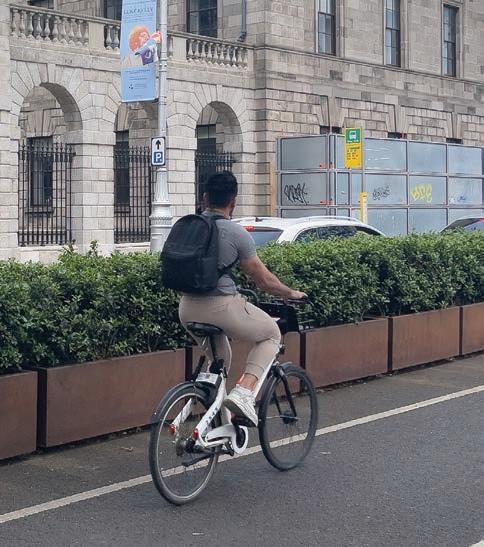
“Large-scale projects such as those contained in the Dublin City Centre Traffic Plan can provide attractive public spaces where people live and engage in the City in a positive way. These spaces can be used for cultural activities, focal points for tourism and areas where Dubliners can stop and enjoy their city. We see the plan as another step towards our proposals for a more pedestrian-friendly city and supportive of the 15-minute city model. Without it, public transport services across the county of Dublin will be less effective, less frequent and have longer journey times.”
In terms of future stakeholder engagement, the Lord Mayor of Dublin, Fine Gael’s James Geoghegan, will assemble and chair a working group to monitor the impact of changes included in the transport plan. Monitoring air quality will be especially important to capture associated health benefits over years to come. The working group will include a range of voices, including businesses, the NTA, elected members, and members of the disability community.
Commenting on the plan, environmental researcher, Sadhbh O’Neill, says the plan is “one of the first steps that is testing the political will of the city. Both the elected representatives and the Chief Executive, Richard Shakespeare, were tested”.
“These measures are relatively modest, and they make sense in terms of improving bus services into the city, but there is more to come,” says O’Neill. “Every single little bit of change that they have introduced so far has been so badly needed. It is decades overdue.”
Bearing that in mind, stakeholders should continue to be engaged at every stage of the implementation process to prevent the erosion of public trust. The City Council must continue to reinforce the benefits of the plan while highlighting examples of successful traffic reduction measures. Grafton Street, Caple Street, and Henry Street have all been pedestrianised with no adverse effect on social vibrancy.
It has taken political courage to push Dublin City Transport Plan over the line. Ireland is caught up in a car-centric way of thinking and there is a misconception that reallocating road space from cars to public transport will only add to woes of drivers. On the contrary, these measures will ease congestion, reduce traffic collisions, and make journey times more reliable.
The plan will improve Dublin’s transportation system, as well as our health, environment, infrastructure and economy. It will take time, but in the long run, these measures benefit everyone.




Effective public procurement compliance is fundamental to a public body’s success. Following several high-profile cases where non-compliance has been highlighted, it is imperative that public and semi-state bodies become engaged with compliance in public procurement.
As institutions supported by taxpayer funding, we have a responsibility to ensure our procurement processes meet accepted standards. The Code of Practice for the Governance of State Bodies, often referred to as ‘the Code’, was established to ensure the highest standards of corporate governance are upheld. The Code obligates state bodies to mandatory reporting including disclosure of procurement compliance levels in their annual reports.
An established procurement compliance process ensures transparency and accountability. It instils trust in stakeholders through fair sourcing and purchasing, ethical supply, inventory management, and efficient cost control. Commitment to these standards will reinforce a company’s standing as a responsible and dependable leader in the industry.
Dublin Bus recognises the importance of public procurement compliance. Our procurement department is at the epicentre of our organisation, driving
forward operational excellence to the highest standards.
We are on a consistent journey towards improved compliance, developing systems internally, mainly due to a lack of available external expertise. Now, as an award-winning procurement department distinguished not only by the recognition of our peers but also our reputation as a leader in the industry, we have created a transformative workshop, that will enable us to leverage our expertise to assist others.
The workshop was developed by our procurement department in response to a lack of compliance expertise in the market. The reality is that many state bodies, of which there are almost 900, struggle to manage all the regulations, with compliance rates less than would be desired across the sector.
These Dublin Bus workshops will assist other state bodies to achieve improved compliance. The workshops aim to offer a platform for shared experiences, to
identify key business requirements within public procurement, and to enable participants to understand where they are in relation to their compliance obligations. Only when this is understood, can a path to ‘full compliance’ be constructed.
During the workshops participants will learn how to achieve high-ranking compliance levels through:
• understanding the Code of Practice;
• using standard operating procedures;
• compliance reporting;
• review of their tender database (if any) and its functionality;
• early warning systems;
• guest speaker on sustainable procurement; and
• group work.
Ultimately, Dublin Bus will help attendees to create a culture of compliance.
For more information regarding the workshops, go to procurementcompliance.ie

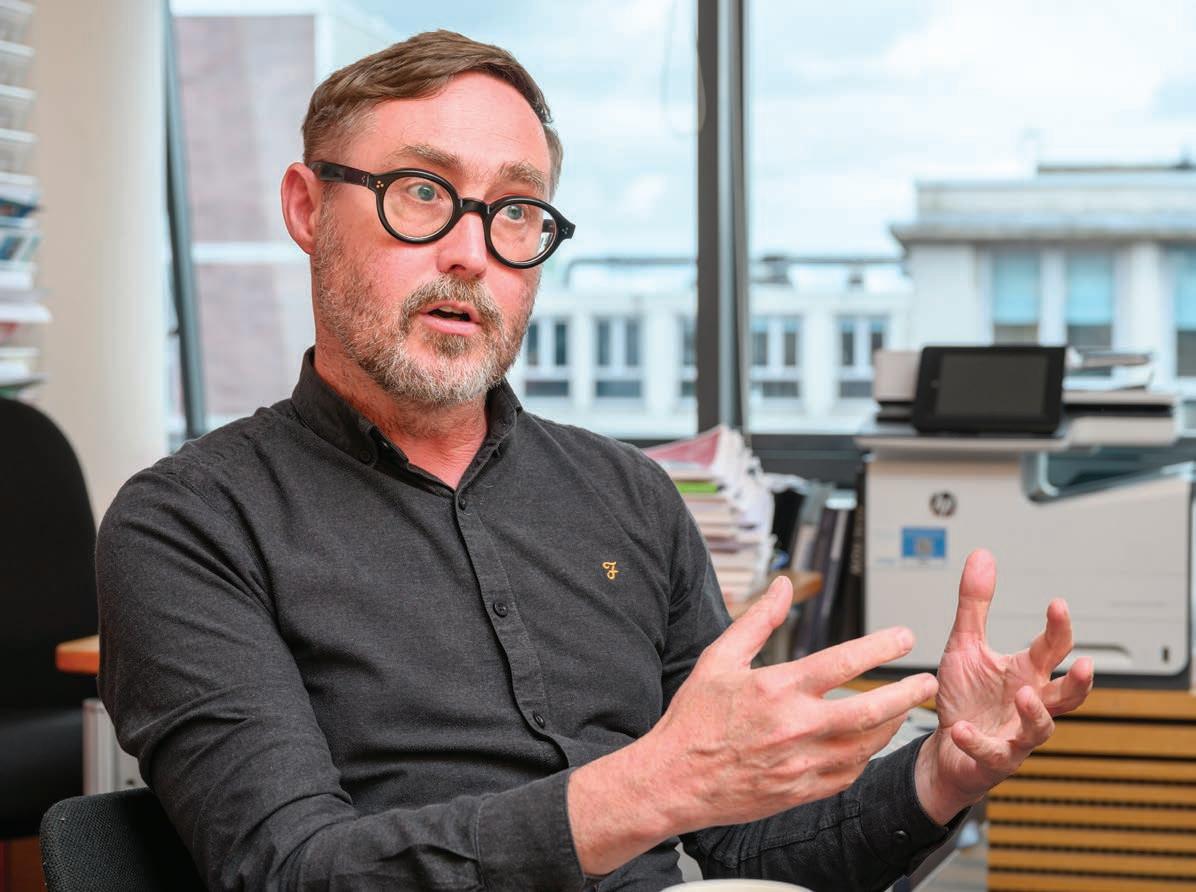
As part of its efforts to reorientate the public discourse back towards the ongoing housing crisis well ahead of the coming general election, Sinn Féin published the affordable housing element ahead of its longawaited “comprehensive” alternative plan for housing. Ciarán Galway writes.
In recent years, both in the Dáil and in the media, Sinn Féin had been consistently challenged to publish its alternative housing plan. Indeed, speaking with the Housing Ireland Magazine in summer 2024, Housing Minister Darragh O’Brien TD observed: “He [Eoin Ó Broin] told the Sunday Independent 16 months ago that he was just about to publish it, and he has not.”
Also speaking with Housing Ireland Magazine at that time, Sinn Féin housing spokesperson, Teachta Eoin Ó Broin, was unperturbed by the absence of his party’s

plan from the public sphere, and the associated criticism that this attracted. “I like to remind people that [Minister] Darragh O’Brien had no housing policy when he was an opposition – not a single piece of paper – and it took him a full year as Minister for Housing before he launched his plan,” he retorted, adding that it would be published “well in advance of the general election” which is anticipated to arrive in the late autumn.
Partially fulfilling his word, Ó Broin’s party has published the first element of this plan: Sinn Féin Affordable Homes

Plan: Bringing Home Ownership Back into Reach for Working People. While this initial publication focuses on affordable homeownership, Sinn Féin’s “comprehensive housing plan”, Ó Broin says, will be launched in September 2024.
“We were holding off until we got The Housing Commission’s report and some other information from government that is important. If we are going to map out a five-year plan, we want it to be fully costed; something which even the Government’s own housing plan is not,” he explains.
In his time as opposition housing spokesperson, Ó Broin has produced several detailed housing policy documents. Asked to explain how Sinn Féin’s communication of housing policy has evolved, he responds that increasingly, “it is all about much more detailed propositions”, and about “how we can deliver”.
“What the next 12 months are going to be about is a debate about two housing plans – the Government’s and ours – and who has the most credible set of propositions for delivering those plans,” he assesses.
That being said, in a policy area which is becoming increasingly complex amid a myriad of schemes aimed at housing delivery, Sinn Féin Affordable Homes Plan is a comparably short document that utilises relatively plain language.
Tactfully placing emphasis on “working people”, including in its cover, the alternative plan is very much the product of the left-wing of the Sinn Féin, as personified by Ó Broin (among others) – the author of Sinn Féin and the Politics of Left Republicanism – a text which defines contemporary party in terms of ‘left republicanism’.
In a lengthy interview with the Housing Ireland Magazine, Ó Broin outlined his critique of government housing policy and articulated a solution that is fundamental to his overall alternative housing plan; an affordable leasehold purchase scheme.
While acknowledging the role of housing benefit as a short-term necessity, he called for a “controlled unwinding” of the reliance on rental subsidies (such as Housing Assistance Payment and the Rental Accommodation Scheme) and as a form of long-term support via the introduction of affordable leasehold purchase.
“With respect to tenant purchase, it has real value,” he says, elaborating: “The problem is when the properties are sold into the rental sector or the private for-profit market. We have long argued that we [a Sinn Féin government] will continue tenant purchase, but we will not sell the land.
“Instead, we will give you free, indefinite use of the land through a legally binding covenant for you, your children, and your grandchildren. However, if you want to sell, you
will have to sell back to the local authority at the discounted price index-linked for inflation.
“That way you get the benefits of tenant purchase – an income mix within working class communities and intergenerational security of tenure – which are really valuable things, while never losing the stock to the private sector.”
However, the proposed affordable leasehold purchase scheme is a lightning rod for criticism. Speaking with the Housing Ireland Magazine, Minister for Housing Darragh O’Brien TD referenced the proposal as “a Cuban style model of housing that they [Sinn Féin] want[s] to bring in”. Latterly, he has sardonically referred to it as a “home leasing scheme”.
Responding to a suggestion that his political rivals have portrayed and will continue to portray the scheme in a manner that implies that people will not own their own homes, Ó Broin is undeterred. “The interesting thing, of course, is that under the Government’s Help to Buy scheme, you do not own your home because they own €100,000 worth of equity in it,” he responds, continuing: “I have conversations with people all around the country about this. The overwhelming majority of people want to buy a home for them, their children, and their grandchildren, at a price they can afford. They are not, in the first instance, buying it and thinking of the windfall gains in 20 years.
“Our scheme allows them to do it; they own the home. The bricks and mortar are theirs, but the land is the State’s, as is the cost of site servicing. Whether you buy an affordable home or you acquire your tenant purchase home, that property is yours and you have all the same rights as any other owner. The only difference is that the State owns the land.”
Following its publication, Minister of Housing, Local Government and Heritage Darragh O’Brien TD was less than impressed by Sinn Féin’s alternative affordable housing policy. “Four years for a 14-page document,” he derisively posted on X, adding: “Can’t confirm banks will lend on their proposals. Say they will ‘consult’ with lenders. Restrictions on sale of homes in future. This is not home ownership.”




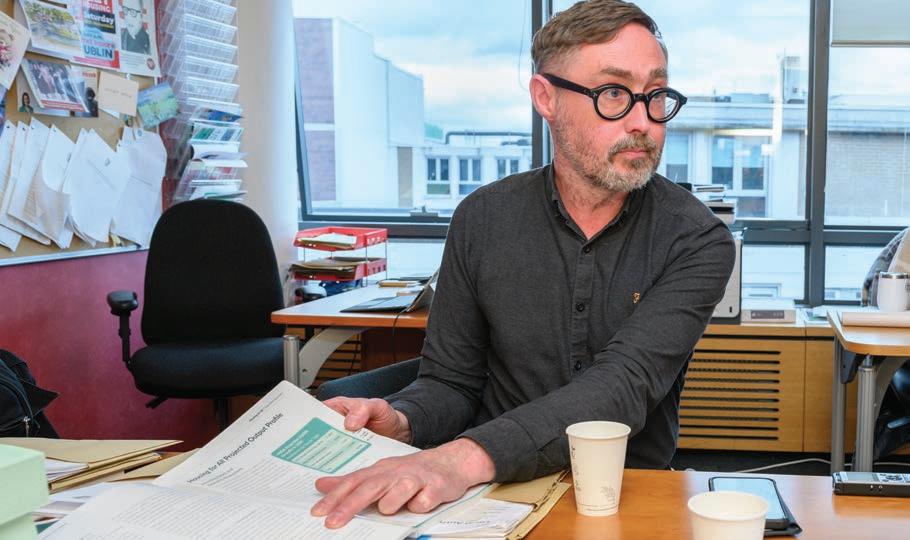
Furthermore, the Minister posed a series of 10 questions “which Sinn Féin must answer”. Most crucially, these include:
• “will they finally answer the many questions in relation to their ‘affordable leasehold purchase scheme’... and can they give an estimate as to how long it will take to establish this scheme?”; and
• “can they confirm that commercial banks have indicated positively to them that they will lend on the affordable leasehold purchase scheme arrangement?”
Mortgage finance, the Sinn Féin housing plan indicates, “would be accessed under the existing rules from commercial mortgage providers, credit unions or local authority mortgages, the details of which would be provided following consultation with these lenders.”
Indeed, Ó Broin has indicated that, through his party’s engagement with the Banking and Payments Federation Ireland (BPFI), mortgage finance options under the affordable leasehold purchase scheme have been outlined by the representative body.
Subsquently, on 21 August 2024, in a letter addressed to Brian Hayes, Chief Executive, BPFI, the Housing Minister called for “openness and transparency” around Sinn Féin’s future engagement with the banks and wrote: “I understand that banks have not been able to guarantee that they will lend mortgages under this new proposed scheme, generating major concerns and uncertainty.”
Ultimately, the Minister is gambling on the public torpedoing of Sinn Féin’s proposal by the banks through their representative body. For an organisation that is, in O’Brien’s words, “independent, political and non-political nature”, this is a particularly uncomfortable position in which to be place.
Set to be published in September 2024, BDFI’s “detailed proposal” on Sinn Féin’s alternative plan – including any challenges relating to mortgageability that are identified – is now highly anticipated.
In an interview with eolas Magazine in late 2023, Sinn Féin’s Matt Carthy TD suggested: “Some of the challenges are so big... that, of course, it will take more than a five-year term in government. I also think, to be quite frank about it, if we do not solve housing in one term of government, we will not get a second.”
Asked if he agreed with his colleague’s assessment and whether it was realistic that a challenge such as the housing crisis could be solved in a single term of government, Ó Broin insists that his party “must be very upfront with people” across all the portfolios.
“We have to set out very clearly to people what is deliverable year-on-year, what is deliverable over a full term, and what we would seek to deliver if we got a second term,” he says.
In housing specifically, he details his projected timelines for Sinn Féin’s alternative plan to take effect. “Within six months we could start to get the homelessness numbers down. We could start ramping up the delivery of social and affordable homes very significantly by year two, and then exponentially by years four and five.
“Very significant reform of the Residential Tenancies Act 2004 and changes to rent regulation could be done immediately, so that people would see our intentions.
“Within five years we could achieve a hell of a lot that would set us up to go back to the public and say: ‘Look at what we have done over the last five years, let us finish the job’,” he concludes.

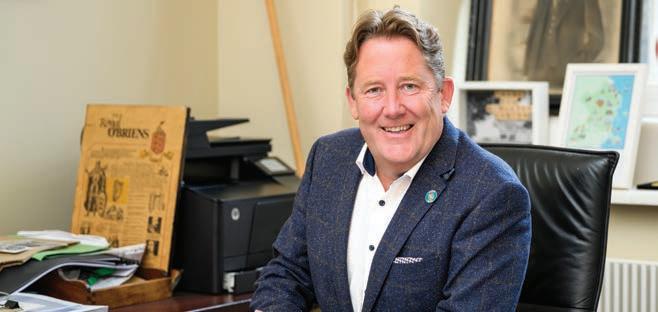
The Government’s 74-page Private Rental Sector Review was published in July 2024, over a year later than initially forecast.
Speaking with the Housing Ireland Magazine in summer 2024, Housing Minister Darragh O’Brien conceded: “The private rental market is still a significant issue because of a lack of supply,” and added: “To deal with the affordability of rent first, we need to see a further expansion of cost rental, and the stabilisation of the private rental market.”
In light of this continuing challenge, the Department of Housing, Local Government and Heritage (DHLGH) first committed itself to commissioning “a comprehensive review of the private rental sector” in the Housing for All Action Plan Update and Q3 Progress Report, published in November 2022.
As one of the 33 high-priority actions contained in the action plan update, a review of the operation of the private rental sector and reporting on policy considerations was slated to be completed by Q2 2023, “ahead of Budget 2024”.
Indicating that the Private Rental Sector Review would take stock of “the significant regulatory changes over the past several years”, DHLGH committed the Government to acting on its recommendations. The self-stated
objective, it said, was to “ensure that our housing system provides an efficient, affordable, safe, and secure framework for both landlords and tenants”.
With delivery of this priority action delayed, the 2023 Housing for All Action Plan Update published November 2023 also included a commitment to undertake the review, with a new targeted completion date of Q4 2023.
That action plan update commented on progress of the priority action and noted: “The Department is near completion on a comprehensive review of the private rental sector... Work is progressing on finalising this review.”
Intended to inform the creation of a market rental system which “provides certainty and fairness to both the renter and the property”, the Private Rental Sector Review incorporated a six-week public consultation process, targeting “engagement with various stakeholders”.
Having consulted with stakeholders the prevailing themes which emerged from respondents include:
• the future of RPZ price controls;
• balancing the rights of tenants and landlords in relation to tenure security and evictions;
• the potential role of changes to the tax system (particularly for noncorporate landlords) in stimulating supply;
• the role of adequately resourced public agencies to regulate the sector; and
• the challenges facing vulnerable households.
As such, the resulting review has three broad elements:
1. The rental market context:
Acknowledging that a “private rental market is an important element of a well-functioning housing system”, the review outlines that rents have risen persistently over the last decade (with the introduction of Rent Pressure Zone (RPZ) price controls and the initial period Covid-19 pandemic being the exceptions).
2. Suggested policy objectives: The objectives include creating economic conditions conducive to investment in the private rental market; ensuring security of tenure; ensuring affordability; ensuring appropriate standards for properties; and ensuring effective legislation which protects the rights of both tenants and landlords.
3. Potential policy changes: A series of potential policy changes have been developed including in relation to incentivising investment in the private rental sector; supporting affordability including via cost rental schemes; reviewing the RPZ rent control system; undertaking “periodic critical review” of the Residential Tenancies Board (RTB); and ensuring compliance with minimum rental standards regulation.
While the Report of The Housing Commission did not receive detailed consideration in the Private Rental Sector Review, it acknowledges that “some of the recommendations in this review are similarly highlighted by the work of the Commission”.

Almost 1,000 households currently live in a Land Development Agency (LDA) cost rental home. And that figure is continuing to rise.
Later this year, the LDA will open applications for new cost rental homes in Shanganagh Castle Estate in south County Dublin and The Mills in Casteltroy in Limerick. Next year more LDA developments will be launched with more new cost rental homes coming on stream.
Cost rental is a relatively new tenure in Ireland, designed to provide secure and affordable rental accommodation for those who do not qualify for social housing, but who are effectively locked out of the private market.
The rent is based on the cost of building, managing, and maintaining the homes, and to qualify as affordable, the rent involved must be no greater than 35 per cent of an applicant’s monthly net income.
Housing for All, the Government’s housing plan to 2030, sets out an annual average requirement of 2,000 new cost rental homes every year with rents targeted at least 25 per cent below
market level. This equates to a total of 18,000 cost rental homes by 2030 with 10,000 of these due to be delivered by 2026.
As the State’s affordable housing delivery body, the LDA is at the forefront of expanding the provision of cost rental homes and it is currently scaling up delivery of this essential offering. The Agency develops housing, through two delivery streams, Direct Delivery and Project Tosaigh.
Under the former, new homes are developed on state-owned or acquired land either by the LDA on its own or in partnership with local authorities and other state bodies.
Project Tosaigh, sees the LDA partnering with private homebuilders providing the funding needed to complete housing projects and overseeing their delivery. Some of the homes are made available
to purchasers at affordable prices, but the majority are retained by the LDA and made available as cost rental.
The delivery of cost rental units is ramping up extensively with new projects being launched regularly and more being added to the LDA’s development pipeline.
Just this year, for example, the Agency announced the opening of the application process for over 600 cost rental apartments in developments in Hansfield, Citywest, and Kilternan in Dublin as well as Leixlip in Kildare. A further 180 apartments were then released in Cookstown in Tallaght. More completions are imminent, including on direct delivery developments in Shanganagh Castle Estate in Dublin, St Kevin’s in Cork and Devoy Barracks in Kildare. Construction is due to start on five more sites by the end of this year including developments in Mungret in Limerick and St Teresa’s Gardens in Dublin.
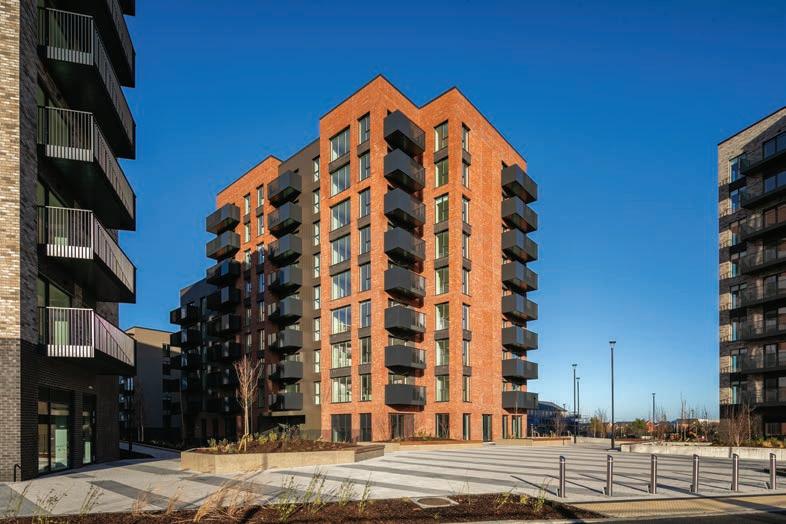

A total of 180 cost rental Project Tosaigh homes will soon be released in Castletroy in Limerick while the LDA also announced a recent deal to deliver 392 apartments in Adamstown in west Dublin with more announcements expected soon.
Cost rental seeks to offer a long-term and secure rental option, which will contribute to the development of a sustainable housing market.
The average rent for LDA cost rental homes is significantly lower than the private rental sector. In Dublin, for example, according to Daft.ie, the average rent for an LDA cost rental home is €1,354 per month compared to €2,395 in the private market, with LDA rents starting from €1,050 for studio apartments.
Each cost rental home offers people the opportunity to secure stable, affordable housing, enabling them to live and plan for the future without the fear of sudden
rent hikes or eviction. Once they qualify for a home, they can continue to rent it at cost rental rates even if their household income increases.
In 2023, the government introduced the Secure Tenancy Affordable Rental (STAR) scheme, which is available to private developers in addition to the LDA and Approved Housing Bodies.
The scheme seeks to provide extra funding for cost rental homes that ultimately helps to address viability issues and ensures rents can be set at 25 per cent below current market rates. Private developers must agree to designate qualifying homes as cost rental for at least 50 years.
Once a rent is set via the STAR scheme, the homes are advertised for a minimum of seven days, during which interested potential tenants register their interest online. Once advertising is complete a lottery is conducted to rank all selfdeclared eligible applicants. The process
moves on to eligibility checking, where applicants must demonstrate they meet the following criteria:
• their net household income must be below €66,000 per annum for properties in Dublin and €59,000 for properties elsewhere in the country;
• they must not be in receipt of any social housing supports;
• they must not own a property;
• their household size must match the size of the property advertised and all members of the household must be living in Ireland at the time of applying;
• each household can only make one application for a particular unit type; and
• they must be able to afford to pay the rent advertised.
The recent Report of the Housing Commission strongly advocates for the delivery of cost rental housing at scale. It believes that such a move would address the challenges in maintaining rental housing supply and assist in tackling affordability issues.
As with all new measures, cost rental is still evolving, and changes may enhance its provision. The definitions of what a household is and what income thresholds should apply to allow two or three people to rent together, for example, are two areas which could be reviewed. Similarly, the ability to target specific demographics with needs in certain geographic areas is limited by the existing regulations.
It awaits to be seen what impact the provision of cost rental housing will have on the private rental market, but it is likely that as supply increases it will help to stabilise the market and reduce the rate at which rents are increasing.
In the meantime, each new LDA cost rental home continues to offer security and affordability for eligible households, many of whom have already availed of this groundbreaking housing type.
T: 01 910 3400 W: www.lda.ie
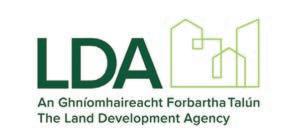

Public Sector Lead at ServiceNow Ireland, Colm Dwyer, explores the benefits of a citizen-first approach that prioritises employee experience and purpose-based outcomes as key to building an innovative ecosystem in collaboration with the private sector.
As our hyperconnected world rapidly evolves with artificial intelligence, data analytics, cloud computing, and 5G, the Irish public sector must embrace technology and modernise its processes.
The Government’s unwavering commitment to digital transformation within public services is a clear recognition of the immediate opportunities innovative technologies can bring. However, its ambitious targets, including getting 90 per cent of services online by 2030, also imposes a heavy burden on the already stretched public sector.
As Minister for Public Expenditure, National Development Plan Delivery and Reform, Paschal Donohoe TD outlined in his speech at the Public Services 2024 conference earlier this year, transformation will not only enhance the resilience of the public service to face future challenges, but it will also enable the sector to apply modern working methods, increase capacity, and extend democratic participation resulting in more efficient and accessible government services for all citizens.
ServiceNow is putting AI to work for people. As the AI platform for business transformation, ServiceNow moves with the pace of innovation to help transform private and public sector organisations while upholding a trustworthy, human centered approach to deploying products and services at scale. The Now Platform connects people, processes, data, and devices to increase productivity and maximize business outcomes.
The Connecting Government 2030: A Digital and ICT Strategy and Harnessing Digital: The Digital Ireland Framework set out a roadmap for delivering digital government for all, benefiting society and the broader economy. Ireland is already in a strong position. As of the 2022 Digital Economy and Society Index (DESI) report, we are ranked the fifth most advanced digital economy in the EU.
We also placed in the top 10 international performers in the 2023 Digital Government Index (DGI) published by the OECD. Still, to continue the momentum and make further progress we have got a way to go when it comes to modernising our public services.
According to the European Commission’s 2024 State of the Digital Decade report, which uses DESI measures, Ireland is in danger of falling behind on digital public services for citizens, transparency of service delivery, design and personal data, and mobile friendliness.
Citizens want experiences that provide the answers they need; not bureaucracy. We are all now well accustomed to instant service in the palm of our hands, whether shopping, ordering food, or paying bills. Citizens want this same
convenience when interacting with public services.
Akin to how businesses take a customerfirst approach, government bodies need to provide self-service options at scale and build processes around outcomes rather than rooting citizens through various departments or offices. The first step toward a human-centred approach is offering unified experiences. Digitising multi-step paper journeys, for instance, means citizens can access public services on their smartphones on demand 24/7.
By the same token, modern IT systems allow citizens to see real-time status updates. Such solutions remove the frustration of trips to government buildings, and calls to jammed phone lines. What is more, simplified and seamless services not only enhance citizen satisfaction but also increase efficiency, which helps build governmental trust and transparency.
Modernising systems and workflows from clunky legacy technologies and manual processing does not just improve citizens’ satisfaction – it boosts employee experience. Automating low-value, repetitive tasks, for example, improves the working lives of public sector staff, giving them more time to focus on highvalue and engaging tasks. In addition to bolstering productivity, it creates a virtuous circle where happy employees provide better services to citizens.
Beyond day-to-day tasks, innovative public service technologies enable new ways of working, particularly flexible arrangements like remote and hybrid working. Heralded by the Department of Enterprise, Trade and Employment as a way to expand talent pools and increase participation, flexible working improves work-life balance and removes structural barriers for underrepresented demographics. As evidenced in the 2023 Labour Market Pulse, the share of women applying for remote or hybrid jobs more than doubled between 2021 and 2023.
Focusing on employee experience is also a way for public services to increase the success of technological modernisation efforts. Research from McKinsey, for instance, found the most successful public sector digital transformations deployed mechanisms focused on the employee 1.6 times more than those that failed.

However, it bears noting that prioritising employee experience to transform public services goes beyond tech and work-life balance. For change to be successful, employees must also be meaningfully engaged.
ServiceNow’s extensive experience of working with the public sector across the EMEA region has taught us that digitalisation programmes fail when implemented with a highly centralised command-and-control management style. Time again, we have seen the best results when public sector leaders opt for a collaborative approach with crossdepartmental cooperation and teamwork.
In practice, this means leaders track employee user journeys and collect and respond to feedback. In the same vein, only by checking in with its citizens can the public sector be sure it is doing what it set out to do.
Instead of returns on investment, leaders must target performance indicators that measure improvements in frictionless service delivery for citizens and employees – that way, they know they are delivering the right experiences.

The key to strategic public sector modernisation is adopting technology intelligently and measuredly. Still, for leaders, this is easier said than done. Knowing where to begin transforming ageing infrastructure, siloed record storage and outdated legacy systems is always challenging, not least when data privacy and national security issues are at stake.
At ServiceNow, we champion a collaborative ecosystem between the public and private sectors. In line with Enterprise Ireland, we recognise that innovation is the key to shared success in today’s rapidly evolving tech landscape.
As a trusted partner to governments worldwide, we know that long-term sustainable partnerships are essential to Ireland’s public sector mission of driving efficiency, modernising infrastructure, and improving outcomes for its employees, citizens, and society alike.
For more information: E: colm.dwyer@servicenow.com W: www.servicenow.com
Colm Dwyer is the Public Sector Lead at ServiceNow Ireland. With a robust background stretching over two decades in digital transformation and public sector strategy, Dwyer excels in driving innovative, sustainable solutions that enhance government services. His dedication and vision encourage outstanding delivery and ensure he and his team consistently work to the highest standards.
Before joining ServiceNow, Dwyer worked for companies including Gartner, Microsoft, Eir, and Vodafone, where his commitment to excellence and strategic vision were instrumental in ensuring public sector clients achieved digital transformation goals efficiently and effectively.

The newly-published draft South Coast Designated Maritime Area Plan (DMAP) has identified four proposed areas off the south coast for offshore wind projects.
The four maritime areas proposed for offshore renewable energy projects have been identified following a comprehensive environmental assessment process and an almost year-long engagement process with coastal communities and stakeholders, de-risking the DMAPs as much as possible.
The draft South Coast DMAP proposes that a first offshore wind project with a capacity of approximately 900MW will take place in Tonn Nua, off the coast of County Waterford, and will aim for deployment by 2030. It further proposes that, over the next decade, further offshore wind projects will be developed in the areas of Lí Ban, also off the coast of County Waterford, and Manannán and Danu, both off the south coast of County Wexford.
The proposal comes in the aftermath an independent economic analysis, published alongside the draft South Coast DMAP, which highlights the potential economic benefits associated with implementation of the plan, which could deliver inward investment of €4.4 billion and an estimated 49,000 full-time equivalent (FTE) years of employment to the economy.
The analysis further highlights that more than 65 per cent of inward investment and employment opportunities could be captured by the south coast region.
Welcoming the draft South Coast DMAP, Minister for the Environment, Climate and Communications Eamon Ryan TD said: “This is a hugely significant milestone; the first time the State has developed a forward spatial plan for renewable energy at this scale. Since taking office, it has been a priority of mine and this government’s to overhaul the regulatory and legislative system so that we could get to this point.
“We can now plan to run an auction and the winners can then proceed to deal with a brand new purpose developed regulator [MARA] before applying to An Bord Pleanála for development permission.”
Following publication on 3 May 2024, the draft South Coast DMAP underwent a six-week statutory public consultation period, which concluded at the end of June.



The draft South Coast DMAP puts forward four proposed maritime areas, within which future deployment of fixed offshore wind (fixed-bottom turbines) may take place.
These are as follows:
Tonn Nua (New Wave), situated off the coast of County Waterford:
• encompasses a total marine area of 312.6km2
• distance to shore varies from between 12.2km along the western boundary to 12.4km along the northern boundary
• mean water depth of 57 metres, with a minimum water depth of 48 metres and a maximum water depth of 69 metres, giving an overall range of 21 metres
• With a typical density of 4.5MW/km2, a 900MW development would use approximately 65 per cent of the total marine space within Tonn Nua
Lí Ban (the Mermaid Saint), situated off the coast of County Waterford:
• total area of 486km2
• distances to shore vary between 49km along the western boundary and 29km along the northern boundary
• mean water depth of 71 metres, minimum water depth of 66 metres, and a maximum water depth of 76 metres, giving an overall range of 10 metres
Manannán (named after a sea god associated with Ireland and a divine lord of the Tuatha Dé Dannan) is off the south coast of County Wexford:
• total area of 342km2
• distance to shore varies between 52km along the western boundary and 27km along the northern boundary
• mean water depth of 69 metres with a minimum water depth of 64 metres and a maximum water depth of 72 metres, giving an overall range of 8 metres
Danu (mother of the Tuatha Dé Danann people and the Celtic goddess of nature), situated off the south coast of County Wexford:
• total area of 304km2
• distance to shore varies between 52km along the western boundary and 27km along the northern boundary
• mean water depth of 67 metres with a minimum water depth of 55 metres and a maximum water depth of 78 metres, giving an overall range of 23 metres

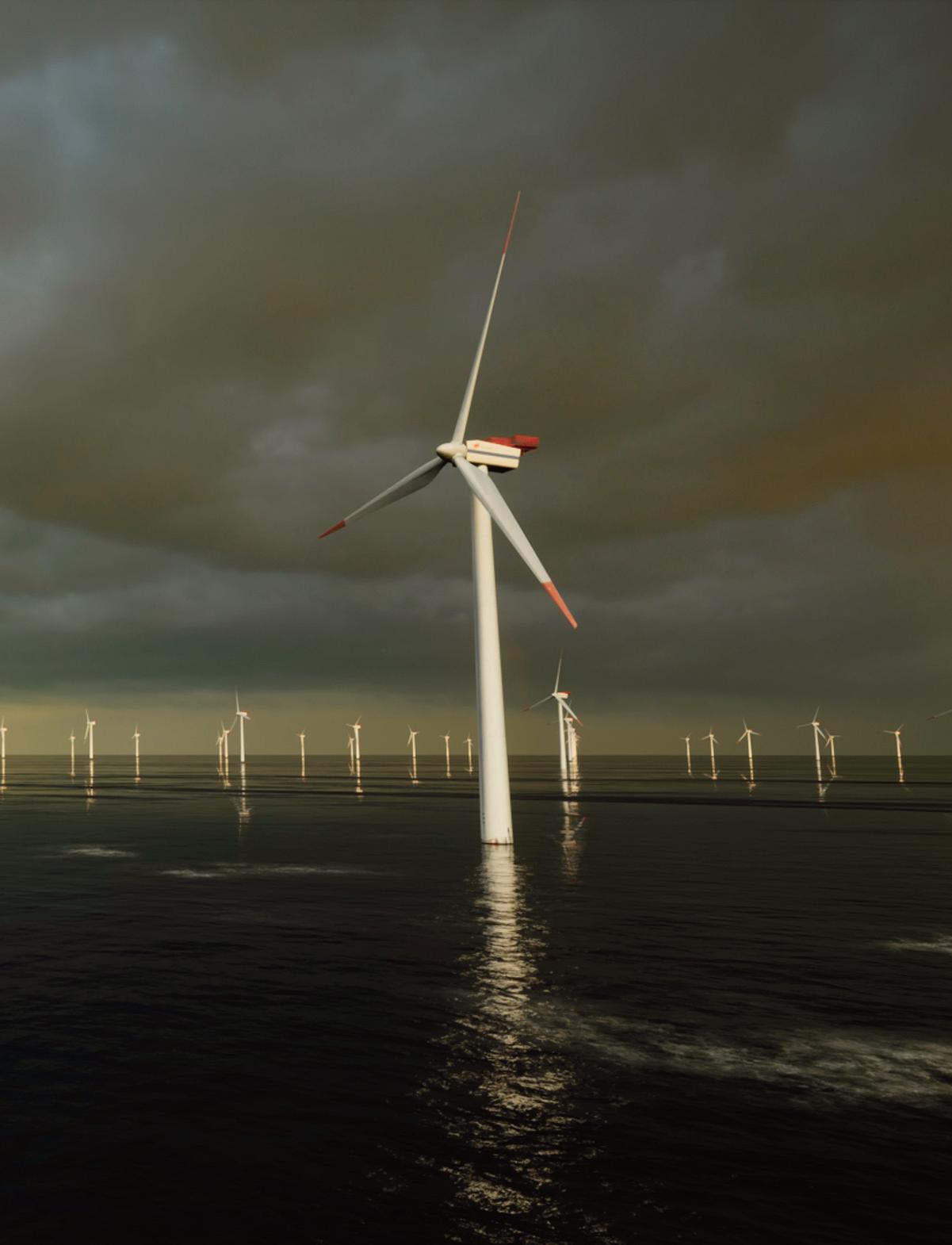

The Network and Information Systems Directive 2 (NIS2) marks a critical point in the European Union’s cybersecurity framework. Its objective is to enhance the resilience and security of network and information systems across member states.
As Ireland’s national country code toplevel domain (ccTLD Manager), we at .ie recognise the profound implications of this directive for the wider business community. It effectively marks “the end of self-regulation” for many sectors. However, the successful implementation of the law could be at risk because of the lack of comprehensive and sectorspecific guidance from the Government. The state of play for NIS2’s transposition in Ireland is one of uncertainty and unanswered questions.
NIS2 seeks to address the evolving landscape of cybersecurity threats by expanding the scope of the original NIS Directive, enhancing security requirements, and promoting greater harmonisation across the EU.
Its objectives include improving the resilience of critical infrastructure, enhancing incident response capabilities, and fostering cooperation among EU member states. The directive
extends its reach to a broad range of sectors, such as energy, transport, banking, health, and digital infrastructure.
NIS2 is an EU directive – meaning that while it was adopted in 2022 by the Council of the European Union, it has to be transposed into national law in each member state. In Ireland, this directive will be transposed through the first National Cyber Security Bill. The deadline is 17 October 2024.
The public guidance that the Government has provided on NIS2 has been broad and does not speak to any of the sector-specific requirements found in the NIS2 Directive. For example, from the domain name industry perspective, there is no public actionable guidance on how registrars and registries should verify personal data of individuals trying to register domain names (a new NIS2 requirement).
Ireland’s national competent authority for NIS2, the National Cyber Security Centre (NCSC) held its inaugural national conference in June 2024. At this conference, NCSC representatives announced that they would not proactively identify or notify entities that they are within scope of NIS2, and that it would be up to entities to self-identify as an “important” or “essential” entity through an online portal. These entities will be subject to more compliance obligations, and face hefty penalties for non-compliance.
And yet, at the time of writing, the affected sectors have not formally heard what the Government’s approach to compliance monitoring will be. There is no guidance on what templates or reporting processes entities will be subject to; whether there will be a transition period; and whether there will be supports available to implement cybersecurity risk measures.
This laissez-faire approach does not ensure that appropriate security measures will be in place and creates a risk that many essential or important entities will be unknowingly noncompliant – especially for smaller companies that do not have the resources for a compliance or legal team. The Government must make efforts to identify and notify which entities are to be listed as essential or important under the law.
A big source of uncertainty, and one that makes it very difficult to engage stakeholders and warn them of the upcoming regulatory obligations, is that the Bill to transpose NIS2 has been seriously delayed. The NCSC website notes that a draft of the Bill was expected to be released by end of 2023. At the time of writing, well into late-July 2024, there is still no publicly released draft of the Bill.

The absence of clear, actionable guidance and any legislative progress creates a challenging environment for businesses striving to align their cybersecurity practices with NIS2. Without concrete instructions, it is difficult for organisations to develop comprehensive compliance strategies, particularly in areas such as risk management, incident reporting, and supply chain security. This uncertainty is especially burdensome for SMEs that may lack the resources to navigate these complexities without detailed guidance.
NIS2 mandates a risk-based approach to cybersecurity, but without clear guidelines, assessing and mitigating risks becomes a formidable task. Businesses will be left to navigate this critical area without adequate support, undermining the directive’s primary goal of enhancing security across the board.
At .ie, we have a strong interest in ensuring the security and stability of Ireland’s internet infrastructure. Unfortunately, the Government’s guidance on NIS2 transposition remains at a high level, providing limited detail on the specific measures and protocols required for compliance.
It is imperative that the Government provides detailed, actionable and sectorspecific guidance on NIS2’s requirements. This includes clarifying if
the NIST Cyber Security Framework will be mandated as a Cyber Security Baseline Standard. Clarifications such as these will be an accelerant to entities’ NIS2 compliance actions. The Government should also offer support and resources targeted at SMEs, which often lack the expertise and financial resources to navigate complex regulatory requirements. Comprehensive training programmes, workshops, tailored guidance documents, and financial support can help SMEs enhance their cybersecurity capabilities. By offering clear and comprehensive guidelines, policymakers can help ensure the resilience and security of Ireland’s digital infrastructure.
W: weare.ie



Earlier in summer 2024, Minister of State for Trade, Promotion, Digital and Company Regulation, Dara Calleary TD, addressed a data and artificial intelligence (AI) collaborathon hosted by The Project Foundry in the Guinness Enterprise Centre, Dublin.
Opening his address to the collaborathon, Calleary emphasises the opportunities posed by a collaboration of data and AI are “unlike any previous technological change in terms of how quickly they are evolving, and their potentially transformative impact for our collective good”.
Explaining that Ireland’s ability to maximise the potential of AI hinges on the quality of data that are “the fuel for AI algorithms”, he asserts: “Data-driven innovation is poised to bring enormous benefits to citizens and companies.”
Contextualising the challenges and opportunities of AI, Calleary references the advances in existing AI technologies in 2023 which “were able to make use of sufficient sized datasets”. “This ability to access sources of data and increases in volume are enabling capabilities in AI,” he adds.
Referencing “fears around AI technologies”, the Minister indicates that
these must be addressed while continuing to “collaborate and develop our research and innovation opportunities to continue to put Ireland at the forefront of this transformational change”.
The EU AI Act, he says, will ensure the regulation of high-risk AI uses, while “allowing innovation to flourish”, protecting fundamental rights as well as health and safety. “Unacceptable risks will not be allowed,” he outlines, adding: “High-risk uses such as in health, recruitment, law enforcement, or very powerful general-purpose systems will be subject to compliance requirements. Medium risk systems will have transparency requirements and low risk AI systems are permitted without restrictions.”
Concluding, the Minister advocates for a “multi-stakeholder approach to data and AI collaboration”. “Businesses of all sizes, scientists and researchers, academics, governments, and civil
society all need to work together to harness their potential,” he says.
Speaking immediately after the collaborathon, organiser Maria McCann, Organisational Psychologist and Project Foundry’s Head of Practice Data and Digital Solutions – remarked on the “strong willingness to share and learn, especially around key challenges like education and data security”.
“The collaboration, focus on usercentred approaches, and exchange of ideas have set a solid foundation for positioning Ireland at the forefront of data and AI transformations. The discussions on skills development and robust data security policies were across multiple stakeholders from different sectors and invaluable insights were shared. There is so much to learn in this space, but it is exciting that by collaborating together Ireland could accelerate how they embrace a digital first mindset,” she summarises.
The AI Forum 2024 will bring together stakeholders to examine all the key challenges around AI and public services. The conference will look at the role of data in AI, embedding AI into existing systems and business workflows and the transformational benefits and opportunities AI will bring to organisations and citizens. Above all, it will examine how we can deliver the principles of AI: Here for Good: AI that is trustworthy, people-centred, and ethical.







Dara Calleary TD Minister of State for Trade Promotion Digital and Company Regulation Department of Enterprise, Trade and Employment
Barry O’Sullivan AI Advisory Council and Professor at School of Computer Science and IT University College Cork
Sarah Gibney Principal Officer Department of Public Expenditure, NDP Delivery and Reform
Mairéad Pratschke Chair in Digital Education University of Manchester
Amelia Kelly Chief Technology Officer SoapBox Labs





Stephen Redmond Director of Data Analytics and AI BearingPoint
Jonathan Bright Head of AI for Public Services The Alan Turing Institute
Comdt. Damian Griffin Research, Technology and Innovation Capability Lead Defence Forces
Kate Robson-Brown Vice-President for Research, Innovation and Impact, UCD and Honorary Fellow The Alan Turing Institute
Conor Judge Consultant Nephrologist and Senior Lecturer in Applied Clinical Data Analytics University of Galway








Abeba Birhane Senior Fellow in Trustworthy AI, Mozilla and Adjunct Assistant Professor Trinity College Dublin and AI Advisory Council
Carmel O’Hare Director of Corporate Services and Innovation Monaghan County Council
David Wall Director of ICT Tallaght University Hospital
Catherine Dempsey Head of Data Management and Analytics Division Department of Agriculture, Food and the Marine Derick Mitchell CEO IPPOSI
Aditya Mohan Senior Scientific Officer National Standards Authority of Ireland


There are a limited number of opportunities to become involved with this conference as a sponsor or exhibitor. This is an excellent way for organisations to showcase their expertise and raise their profile with a key audience of senior decision makers from across Ireland’s public services. This interactive conference provides an excellent opportunity for making contacts and networking. For further information please contact Lynda Millar on 01 661 3755 or email lynda.millar@eolasmagazine.ie.









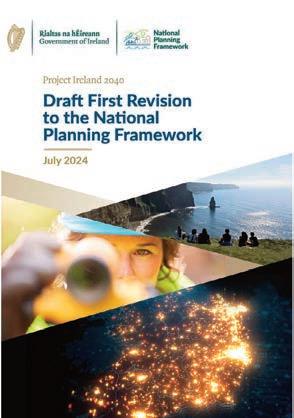
Government has published the Draft First Revision to the National Planning Framework (NPF) – the planning framework for socioeconomic and cultural development of the State out to 2040 – which anticipates the need for ~50,000 additional homes each year.
The revision intends to update the NPF to reflect changes in government policy, not least in climate action, regional development, demography, and digitalisation.
Provided with government approval to commence 20 June 2023, the Draft First Revision to the National Planning Framework was published for public consultation on 10 July 2024 and intends to update the NPF to reflect changes in government policy, not least in climate action, regional development, demography, and digitalisation.
The consultation will run until 12 September 2024, a deadline which Sinn

Féin housing spokesperson Eoin Ó Broin TD suggested “is far too tight” given that “it leaves a very short period and people will be on holidays”.
“I do not think we will get the political oversight of this over the summer months,” added Green Party TD and spokesperson for transport, climate action and environment, Brian Leddin.
Speaking to eolas Magazine in summer 2024, Minister for Housing, Local Government and Heritage Darragh O’Brien TD indicated that he wanted to see the revised NPF “implemented in September [2024]”.
“While some of the commentariat and
opposition are talking about targets on housing, we are getting on with building the houses. We exceeded the [overall] target in 2023, we exceeded it the year before, and we intend to exceed it this year.
“It [the first revision] does not stop the work that we are doing, but it is important that we reset based on the increasing population and with population trends. The NPF will underpin that. More than likely, we will be asking local authorities to revisit their development plans to zone more appropriate lands for additional housing delivery,” he insisted.
Following the consideration of the
Minister for Housing, Local Government and Heritage, Darragh O’Brien TD
“The world has changed significantly since the NPF was first published in 2018, and we must ensure our national planning strategy is appropriate for our current and future needs. These changes need to be reflected in the NPF...”


Minister of State with special responsibility for Planning and Local Government, Alan Dillon TD
“As our population continues to grow, 50:50 regional balance between our major cities and rural regional towns is essential to ensuring rural Ireland prospers at the same rate as our cities.”
submissions received and government approval, the final draft will require approval by the Houses of the Oireachtas before being published. When this process is concluded, the revised NPF will be incorporated into regional spatial and economic strategies and the city and county development plans, including via the finalised updates to housing supply targets.
The original NPF was published in February 2018 as one of two main components of Ireland 2040 – alongside the National Development Plan – and replaced the National Spatial Strategy.
In March 2023, Housing Minister Darragh O’Brien TD commission an expert group to undertake a high-level review and determine the scope of the first revision. The expert group’s report was submitted to the Minister in August 2023 and published that September.
Appearing before the Joint Oireachtas Committee on Housing, Local Government and Heritage on 11 July 2024, acting Assistant Secretary of the Planning Division within the Department of Housing, Local Government and Heritage, Paul Hogan, updated members on the 190-page draft revision.
“It is an important document. It is at the apex of the planning hierarchy,” Hogan told the committee, adding: “It is a highlevel framework. It is a direction of travel. It has been mischaracterised as a blueprint, which it is not. That cascades down through the planning system.”
The NPF is underpinned by the Planning and Development Act 2000 (as amended) and the Planning and Development Bill, 2023.

Also published in July 2024 was the ESRI’s Population Projections, The Flow of New Households and Structural Housing Demand which estimates structural (demographic or emerging) housing demand of approximately 44,000 homes per annum (based on an average of 12 scenarios) from 2023 to 2030 and 39,700 from each year from 2030 to 2040. Though the report also acknowledges that structural demand projections are very exposed to international migration, household size, and housing obsolescence.
Taken together with the May 2024 Report of The Housing Commission – which estimates that, as of Census 2022, the State’s housing supply deficit was between 212,500 and 256,000 homes. This equates to unmet housing demand of between 15,000 and 25,000 new homes each year from 2025-2034.
Assuming a rounded mid-range figure of 235,000 for the overall deficit between 2025 and 2034, an average annual figure of 23,500 new homes would have to be delivered to address pent-up demand alone.
Adding this mid-range figure to Housing for All’s current target of an average delivery of 33,000 homes between 2022 and 2030, this would equate to an average annual delivery of 56,500 new homes between 2025 and 2034.
However, using the ESRI’s structural demand projection alongside the Commission’s deficit range results in a total annual housing demand of between 60,000 and 70,000 new homes. In fact, on a nine-year trajectory to 2034, The Housing Commission recommends the delivery of 70,000 homes in years 2029 and 2030.
However, DHLGH suggests that having consideration of the ESRI’s projections, allied to the Department’s “preliminary analysis on previously unmet demand”, the October 2024 update to Housing for All’s annual housing targets will arrive at 50,000 new homes on average per annum. Though the Department clarifies that the exact figure will be published in October and the new targets will be effective from 2025.
In this context, Sinn Féin’s Ó Broin was decidedly unimpressed by the draft revision’s conclusion that an average of 50,000 new homes will need to be delivered to 2040, suggesting that it underestimates housing need.
Responding to a question from Ó Broin during his appearance before the Oireachtas housing committee, DHLGH’s Hogan asserted: “Clearly, there will be further detailed analysis of a more precise figure for the autumn Housing for All revised action plan document and that will probably be of the order of slightly more than 50,000 for the period to 2030.”
Reiterating that the First Revision to the NPF “is not a housing plan” but rather “a strategic, long-term planning document for the next 16 years”, he suggests that while the revision concludes that an average of 50,000 must be delivered each year until 2040, “how that will stack up against the next few years, the pent-up demand and so on has yet to be worked out in fine detail.”
The 50,000 figure, he says, was determined by taking the ESRI’s structural demand figures and “making reasonable allowances based on the previous methodology for unmet demand” before averaging the figure over 16 years to
Green Party spokesperson for transport, climate action and environment, Brian Leddin TD
“There is no rebalance here. If anything, there is a move away from balance from the original 2018 document... What we are seeing now is not a strategic document or vision.”


“The draft [revision] says that there is a need for 50,000 new homes a year from now to 2040. When Department of Housing officials were asked to explain how this number had been arrived at, they were not able to provide a clear answer.”
2040. However, he makes clear that “we [DHLGH] are not offering a definitive position on that right now” and that 50,000 is “a reasonable working assumption”.
It is also a figure that aligns with Taoiseach Simon Harris TD’s assertion that a Fine Gael government would deliver 250,000 homes over the next five years.
However, Ó Broin insisted that he did not believe that this figure is reasonable given that The Housing Commission has recommended the delivery of a minimum annual average of 60,000 new homes. The figure contained in First Revision to the NPF would, he argues, amount to an under delivery of 100,000 homes in a decade.
In a subsequent statement, Ó Broin observed: “The draft [revision] says that there is a need for 50,000 new homes a year from now to 2040. When Department of Housing officials were asked to explain how this number had been arrived at, they were not able to provide a clear answer... The Department of Housing’s figure of 50,000 new homes a year makes no sense.”
While DHLGH maintains that the draft revision “retains the original NPF focus on a more balanced distribution of growth across all of Ireland’s regions”, this is disputed by the opposition.
Referencing Census 2022, the draft revision suggests that “emerging changes in population distribution… are encouraging” and identifies a pattern of growth across all three regions.
Acknowledging that there is a greater rate of population growth in Dublin and the mid-east and that “the transition to balanced regional development is taking time to materialise”, the draft revision places emphasis on ensuring equitable
growth between and east and midlands and the rest of the State.
Discussing the draft revision, Minister of State with special responsibility for Planning and Local Government, Alan Dillon TD observed: “As our population continues to grow, 50:50 regional balance between our major cities and rural regional towns is essential to ensuring rural Ireland prospers at the same rate as our cities.”
Meanwhile, when asked by Deputy Leddin to define “balanced regional development”, senior advisor with DHLGH’s National, Regional and Urban Policy Unit, Alma Walsh emphasised that the principle is provided for within the Planning and Development Act 2000.
“Retaining this approach to balanced regional development in this revised version is about addressing the imbalance in how and, in particular, where development has been taking place, with a concentration in Dublin and the mideast area. The balanced regional development piece is to address that concentration to ensure that other parts of the country... also grow to their potential and offer an alternative and rebalance of the distribution of growth,” says Walsh.
However, Leddin is unconvinced, accusing DHLGH of “doubling down” on “the failure of the NPF”, insisting: “There is no rebalance here. If anything, there is a move away from balance from the original 2018 document... What we are seeing now is not a strategic document or vision – this should be a vision for the shape of the country in ten, 20- or 30-years’ time –but a reaction to where we see demand happening.”
This is disputed by Hogan who observed: “That is simply not the case. The reality is there was much discussion and consideration of balanced regional development and what that meant in
2017 and 2018 when we were devising the strategy in the first place. We set a course, and this is a revision of that strategy. We are not abandoning the strategy; we are updating it.”
Upon publishing the draft revision, the Housing Minister asserted: “The world has changed significantly since the NPF was first published in 2018, and we must ensure our national planning strategy is appropriate for our current and future needs. These changes need to be reflected in the NPF as they impact on how we plan for the country’s growth and development, particularly in relation to our growing and changing population and our climate action commitments... Crucially, a revised framework will guide our continued momentum in housebuilding.”
Speaking with eolas Magazine in summer 2024, Ó Broin addressed the context in which he will publish his party’s alternative housing plan. At that time, he suggested that he was not hinging his plan on about the National Planning Framework revision “because in some senses, The Housing Commission’s report has moved ahead of that”.
Overall, the impact of the draft revision on the update to Housing for All will become apparent in October 2024.


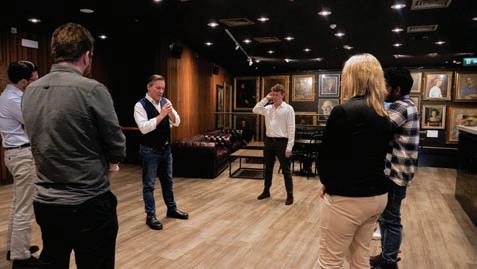



Ireland’s national theatre has pioneered an innovative approach to corporate training, leveraging theatrical techniques to enhance business communication and team dynamics.
The programme, aptly named Theatre Skills for Business, offers a unique blend of storytelling, improvisation, and creativity to help professionals refine their communication skills and explore team dynamics in novel ways.
At its core, theatre is about effective storytelling, utilising not just words but also non-verbal cues and human behaviour. This comprehensive approach to communication makes theatrical techniques particularly valuable in a business context, where nuanced interactions can significantly impact outcomes.
The programme’s appeal lies in its ability to strengthen existing team dynamics through collaborative storytelling and improvisation exercises. By applying the rigorous yet joyful methods used in theatrical rehearsals to corporate challenges, participants gain fresh perspectives on their work environment and interpersonal relationships.
One of the programme’s key strengths is its adaptability. While a basic framework exists, the content can be customised to address specific company needs. Moreover, facilitators remain responsive to emerging dynamics within the group, ensuring that individual needs are met as they arise.
Participants engage in a form of structured play, akin to the focused creativity employed by artists. This approach not only fosters innovation but also allows individuals to discover untapped potential within themselves and their colleagues. The program provides a safe space for professionals to step outside their comfort zones, experiment with new forms of expression, and gain confidence in their communication abilities.
For businesses looking to craft compelling narratives about their brand or products, the program offers valuable insights into effective storytelling
techniques. Additionally, for those who view business interactions as a form of strategic gameplay, the training provides tools to navigate these scenarios more skilfully.
By participating in Theatre Skills for Business, professionals gain access to the expertise of Ireland’s national theatre while simultaneously honing critical business skills. This innovative intersection of art and commerce offers a fresh approach to professional development, promising to enhance both individual communication skills and team cohesion in ways traditional corporate training often fails to achieve.
To learn more about our theatre skills for business workshops:
E: nicola.branigan@abbeytheatre.ie
W: www.abbeytheatre.ie


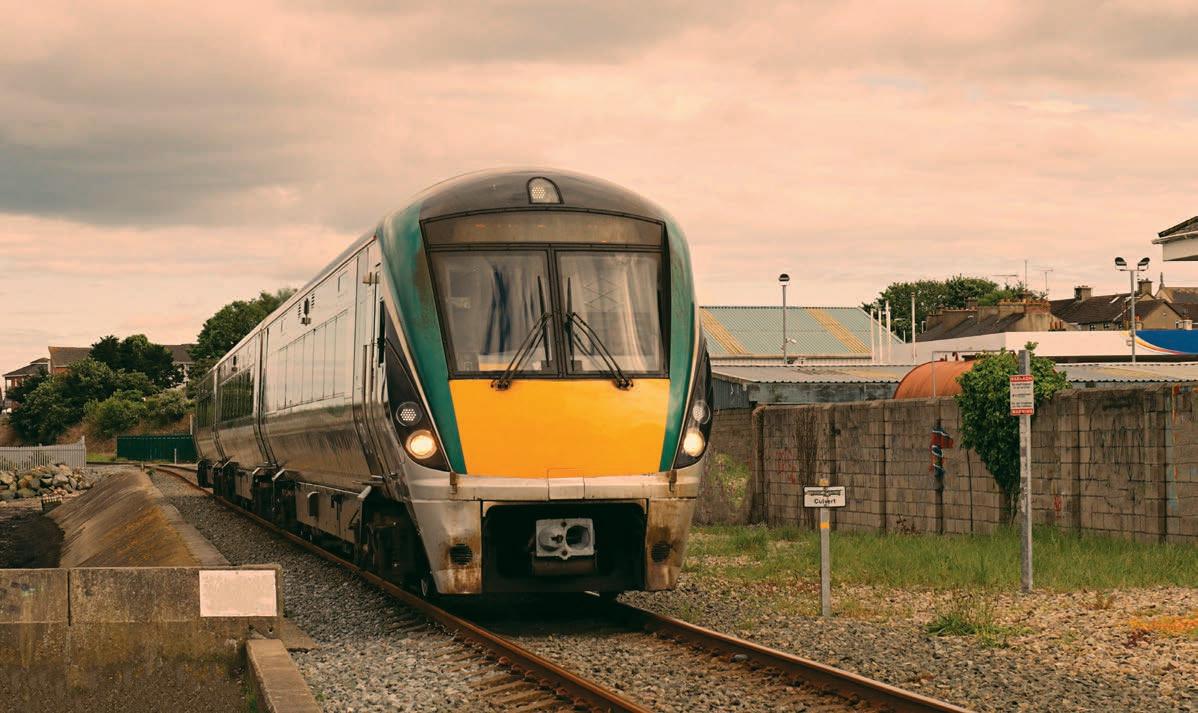
have been set out for rail connectivity to be significantly enhanced across Ireland, with all counties, aside from County Fermanagh, set to have access within the next 25 years.
Following the return of the Northern Ireland Executive, the All-Island Strategic Rail Review has been published, oneyear after being published in draft form by the Department of Transport when the Executive was suspended.
Under the proposals, rail connections are to be restored in and expanded to 31 of Ireland’s 32 counties, with a total of 32 recommendations aimed at enhancing the network across the next 25 years while making train travel quicker and more environmentally friendly.
The recommendations include:
• restoring a line linking Portadown, County Armagh with Mullingar, County Westmeath with the line passing through Armagh city and Cavan town;
• restoring a line between Derry and Portadown, linking the towns of
Strabane, Omagh and Dungannon (all in County Tyrone) to the network;
• build a new direct line between Lisburn, County Antrim and Newry city;
• restoring a line between Athenry, County Galway and Claremorris, County Mayo, connecting Tuam, County Galway to the network;
• reinstating the railway south County Wexford;
• developing a new rail link from Letterkenny, County Donegal to Derry city;
• building a rail link that would cross central Dublin – potentially via a tunnel – to connect Heuston station, which receives trains from the south and west of the island, with Connolly station, which serves the north and east; and
• connecting Dublin, Shannon, and Belfast International airports to the rail network. In Dublin, the move would complement the existing plan for a MetroLink service from the airport into the city centre and would enable intercity services to access directly the island’s biggest airport. Reinstating the Lisburn to the Antrim line would enable Belfast International Airport to be served by a rail link for the first time, while in Shannon the review recommends the building of a spur to facilitate a rail link with Limerick city.
While these are all medium- to long-term ambitions, there are some proposals which are expected to go ahead in the short term, including the introduction of additional track capacity, electrification, increased speeds, and higher service frequencies on existing networks.

While the recommendations of the review have broad support, there has been some criticism at the lack of connectivity in County Donegal beyond the single line being proposed between Letterkenny and Derry, and the absence of proposed projects in County Fermanagh which would leave it as the only county in Ireland with no rail connectivity.
The North’s Minister for Infrastructure John O’Dowd MLA commented on the Fermanagh omission: “I recognise that many will be disappointed by the omission of rail connections to Fermanagh, in particular Enniskillen. Following the consultation period last year, I asked the consultants to review this, but they concluded that a new railway line did not appear to stimulate sufficient demand to support a rail service within the time frame of the review.”
While the scope of the review does not include developing a detailed decarbonisation strategy for the island’s railways, it has developed a plausible approach by drawing on insights from Great Britain’s Traction Decarbonisation Network Strategy and Denmark’s Togfunden programme, which has introduced high-speed rail travel (between 160 and 250km/h) and has significantly reduced carbon emissions since being rolled out in Denmark in 2014.
The considerations which can be considered in the medium term are:
• Electrified railways: Electric traction is proven, widely used, and supported by relatively strong supply chains. It can support passenger trains and freight trains over long distances, at high speed, and without refuelling. However, this option requires significant investment in infrastructure such as Over Head Line Equipment (OHLE). The Government is currently investing heavily in expanding OHLE for the DART service in the Dublin area, which will increase the length of electrified railway from circa 50km to 150km (around 5 per cent of the island’s railway route length).
• Battery electric trains: Battery electric trains have been proven at a relatively small scale. These are suited to operating short distances but cannot currently support higher speed (around 200km/h) passenger trains or freight trains over long distances.
• Hydrogen powered trains: This technology is earlier in its development cycle, but the signs are stated as “promising”. Hydrogen trains have been shown to work in a live operating environment, although the economics of adopting this technology at scale are less clear.
This technology could support passenger services over relatively long distances in areas with relatively easy access to hydrogen production and storage.
To enable the introduction of low-carbon rail pathways, the review states that the two administrations on the island should develop and implement an All-Island Rail Decarbonisation Strategy that, as a minimum, includes an electrified intercity network; develop plans to invest in the skills, supply chains, and rolling stock to deliver decarbonisation; and procure hybrid and electric rolling stock in the medium term.
The report estimates the capital cost of implementing all the recommendations by 2050 would be between €35 billion and €37 billion in 2023 prices, of which 75 per cent is to be funded by the Government and 25 per cent funded by the Northern Ireland Executive.
While the stated upfront cost is high, it would be spread evenly over the period of 25 years to implementation, and the report states that there would be economic benefits which would unlock a return on the investment.
“Some costs would be offset by future revenue, while others could be met by government funding. In addition, there would be other impacts arising from the delivery of some interventions, particularly during their construction,” the report states.
“These costs would represent a similar annual spend as was committed in the middle of the 2000s when Ireland expanded its motorway network, and they would be shared across both jurisdictions.”
Minister for Transport Eamon Ryan TD said: “This is not just the first All-Island Strategic Rail Review, it is the most ambitious vision for rail in a century, bringing us forward to a new age of rail.
“This vision has been made possible by close cooperation between the departments and agencies north and south.
“Rail not only allows us to carry more people and freight in a more sustainable way, it is the great connector, enabling greater regional accessibility and balanced regional development.”
Minister O’Dowd added: “This publication brings us to a new chapter where we can shape a better future for everyone by decarbonising key services and investing in climate adaptation measures, while at the same time supporting economic productivity through projects, policy and legislation.”
Environment Ireland® is Ireland’s major environmental policy and management conference. Now in its 20th year, this important event features a range of focused sessions highlighting the pressing challenges facing the environment in Ireland and further afield. 2024 speakers include...

Ossian Smyth TD Minister of State with responsibility for Communications and Circular Economy


Andrew Muir MLA Minister of Agriculture, Environment and Rural Affairs
Aurel Ciobanu-Dordea Director, Circular Economy, DG Environment, European Commission

Francesca Racioppi Head of Office, World Health Organization European Centre for Environment and Health



Senior Representative Coillte
David McGee Advisory Partner and ESG Leader, PwC
Chris Hewitt Director of Climate Services Branch, World Meteorological Organization
Danielle Conaghan Partner and Head of the Environment and Planning Group, Arthur Cox

Geoff Dooley Head of Sustainability Services, Antaris Consulting

Anna Rose, Head of the Planning Advisory Service Local Government Association UK

Zoe Kavanagh CEO, REPAK

Venkatesh Kannan Associate Director, The Irish Centre of High-End Computing (ICHEC)

Laura Diaz Anadon Co-Vice-Chair, European Scientific Advisory Board on Climate Change University of Cambridge

Mark Horton All Ireland Director The Rivers Trust

Eimear Cotter Director of the Office of Evidence and Assessment Environmental Protection Agency (EPA)

Niall Ó Donnchú Director General National Parks and Wildlife Service
programme online!
Contact Fiona McCarthy on +353 (0)1 661 3755 or email fiona.mccarthy@environmentireland.ie for further














Sponsored by

In 2024, I have been working on significant reform in the areas of defamation law and gambling regulation in Ireland. These laws will be progressed when Oireachtas business resumes in autumn 2024. Minister of State with responsibility for International Law, Law Reform and Youth Justice, James Browne TD, writes.
These initiatives are part of a broader government commitment to safeguarding public welfare and protecting the vulnerable, to enhancing access to justice, and strengthening our democracy by promoting reasoned debate and discussion within our public realm.
These laws will secure a delicate balance of preserving individual freedoms while establishing robust protections against harm.
The new Defamation (Amendment) Bill 2024 is a big step forward in updating Ireland’s defamation laws to fit today’s fast-paced media environment.
For the average person, if someone harms your reputation, this Bill will make it easier, quicker, and less expensive to get justice. It balances the right to free speech with the need to protect a person’s good name, ensuring that you can defend your reputation without the
lengthy and costly processes that might have held you back before.
In addition to these changes, the Bill promotes alternative dispute resolution mechanisms. This will encourage prompt corrections and apologies, when warranted, aiming to resolve disputes amicably and cost-effectively. This approach not only avoids the need for court proceedings, but also fosters a more conciliatory environment for addressing genuine grievances and errors.
The abolition of juries in High Court defamation cases is designed to reduce unpredictable and at times disproportionate damages awards.
In developing this Bill, I was conscious that we must strike an appropriate balance to ensure that costs, risks, and outcomes in defamation proceedings are more proportionate and less uncertain. This is important both to improve access to justice generally, and to avoid any chilling effect of defamation
proceedings on the freedom of the press.
The proposed changes are intended to streamline legal processes, curtail excessive legal costs, and speed up resolution of disputes.
The Bill also introduces measures to combat strategic lawsuits against public participation (SLAPPs). These lawsuits, often used to muzzle journalistic endeavours and silence critics, pose a significant threat to democratic discourse and press freedom.
By implementing protections against SLAPPs, the Bill not only supports investigative journalism but also fortifies democratic principles by ensuring that matters of public interest can be freely explored and debated.
Establishing a gambling regulator
The Gambling Regulation Bill 2022 is designed to protect consumers by creating a comprehensive regulatory
framework for gambling which will address the complexity of the modern gambling industry, particularly the rise of online betting, accessible 24/7 via smartphones.
Every person, including children, now carry a mobile casino in their pocket. This ease of access has led to increased problem gambling, especially amongst younger users.
The anonymity and global reach of online platforms make it harder to prevent problems like addiction and illegal activities such as money laundering. The establishment of a new Gambling Regulatory Authority of Ireland is core to the Government’s commitment to ensuring robust safeguards are in place to protect public safety and wellbeing in this rapidly evolving landscape. It will mark a significant shift from outdated regulations to a robust, modern oversight mechanism.
The core objectives of the new regulator include preventing gamblingrelated crimes, ensuring fair and transparent gambling practices, and promoting responsible gambling to combat addiction. The new regulator will have the power to regulate both online and in-person gambling, manage advertising standards, and enforce compliance among operators.
One of the most noteworthy aspects of the Bill is its focus on protecting vulnerable individuals, particularly children, from the risks associated with gambling.
Measures such as prohibiting gambling advertisements that appeal to minors, banning the use of credit cards for gambling, and establishing a National Gambling Exclusion Register are pivotal in mitigating the potential harms of gambling addiction.
The Social Impact Fund, financed by industry contributions, will further support research, awareness campaigns, and treatment programs for problem gambling, ensuring a comprehensive approach to public health and safety.
Both legislative initiatives reflect a careful balancing act between upholding individual rights and instituting necessary protections.
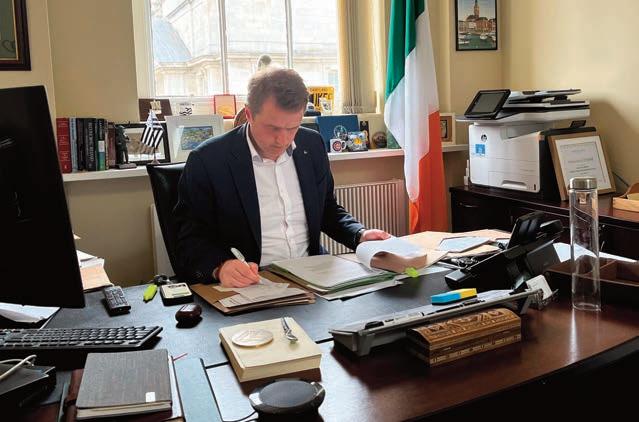
“The reforms being put into effect seek to create a fairer, safer society where justice is accessible, rights are respected, and vulnerable individuals are protected from harm.”
Minister of State with responsibility for International Law, Law Reform and Youth Justice, James Browne TD
In the case of defamation reform, the emphasis is on fostering an environment where freedom of expression and the protection of reputations can coexist and operate in unison.
For gambling regulation, my focus has been on creating a safe gambling environment, recognising the industry’s economic significance while at the same time being alive to the social challenges it presents.
The policy decisions I have made in these areas stem from a belief in the importance of proportionality and transparency in legislative reforms. These bills, shaped by extensive public and stakeholder consultation and careful consideration, aim to address the specific risks associated with defamation and gambling. By doing so, the reforms being put into effect seek to create a fairer, safer society where justice is accessible, rights are
respected, and vulnerable individuals are protected from harm.
Ultimately, the success of these reforms will be measured by their ability to enhance public trust, support responsible behaviours, and uphold the rights and protections essential to a just society.
Both the defamation and gambling regulation bills are necessary to keep pace with the rapid technological changes that have transformed how we communicate, are influenced and behave. These reforms are designed to address the new challenges and risks that have emerged in our increasingly digital world, ensuring that our laws remain relevant and effective.
As the legislative process continues, I look forward to working with my colleagues to aid the passing of these significant and worthwhile updates to the statute book.

Innovation has the potential to enhance efficiency, improve access to justice, and ensure greater transparency within legal processes. However, realising these benefits requires more than just adopting new tools; it demands careful planning, thoughtful user-centric design, and a robust architectural approach. Without a solid foundation, robust design and compliance, the implementation of these technologies may fall short, leading to missed opportunities for meaningful reform.
There are many opportunities for AI in the justice sector including AI-powered video analytics which can enhance crime prevention, suspect identification, and cross-border security through facial recognition, the tracking of individuals, and object detection.
Additionally, AI can prioritise law enforcement responses by assessing threat levels using algorithmic scores, streamline judicial processes, and can also support rescue and disaster responses by analysing imagery, locating individuals, and assessing damage. Law enforcement can also benefit from integrated intelligence analysis platforms which display crime trends and allow for rapid searches exploring potential criminal relationships.
The adoption of digital and exponential technologies, such as artificial intelligence and big data analytics, holds great promise for transforming the justice sector, writes Cillian Leonowicz, Partner and Head of the Strategy and Architecture team in Technology Transformation, EY Ireland.
There are numerous case examples of AI applications in the justice sector:
• SIGMA- Centralised AI-Driven Drafting and Decision Support for Judicial Efficiency (Brazil). The Federal Appeals Court in Brazil has implemented an AI system known as SIGMA. This program centralises draft models related to conformity and appeal admissibility judgements, assists in preparing legal reports, and aids in making decision and judgements within the Electronic Judicial process systems. SIGMA is available 24/7 and has significantly reduced case processing time.
• AI-Driven Preventive and Predictive Policing (India): The State of Karnataka has adopted AI-enabled policing through the installation of 7,500 surveillance cameras. AI integrates with police databases to detect suspicious behaviour and vulnerable areas via facial recognition. AI also uses historical data to anticipate criminal activities, enabling the pre-emptive deployment of officers to potential crime locations.
2. Detection, monitoring, and positioning systems
Law enforcement agencies are increasingly relying on detection, monitoring, and positioning systems to proactively address criminal activities and enhance public safety. These technologies allow for real-time data collection and analysis, enabling law enforcement to respond swiftly and effectively. For example:
• Drones: provide critical aerial surveillance capabilities. Police Forces across the globe have deployed drones for aerial surveillance and criminal activity detection including the Metropolitan Police Service in London.
• Global Positioning System (GPS): GPS technology improves the tactical deployment of police resources, improving coverage and better decision-making.
• Licence Plate Scanning: Automatic licence plate recognition (ALPR) systems allow for the immediate identification of vehicles associated with criminal activity. Additionally, ALPR is employed for road safety by detecting vehicles with expired registrations or those involved in traffic violations. These have been deployed here in Ireland by An Garda Síochána.
• Traffic Management System (TMS): New Zealand’s TMS excels in realtime adaptation to traffic conditions and unexpected events. Utilising real-time data, TMS can quickly respond to accidents, road closures, and adverse weather by adjusting signal timings and rerouting traffic to minimise disruptions and congestion.
As the volume of digital evidence collected by law enforcement continues
to grow, the need for efficient and secure management systems has become more critical. The implementation of a Digital Evidence Management Systems (DEMS) streamlines evidence gathering, eliminating manual logging into multiple systems and enhances transparency and accountability in law enforcement.
DEMS provide security measures including redundant storage options that can be both on-site and cloud based. These storage solutions can also be expanded when needed offering scalability and flexibility. In addition, as the use of body worn cameras (BWC) becomes more widespread, a smooth integration with DEMS is crucial.
All digital evidence, including videos from BWCs, security cameras, and other digital sources, may be controlled and stored in one place because of the integration. DEMS also provides a clear and detailed chain of custody which is essential for the integrity of digital evidence. DEMS monitors all digital file interactions, such as who accessed the evidence, when it was accessed, downloaded, shared, and for what purpose. This ensures that all digital evidence maintains its integrity throughout the judicial process.
In addition to the foregoing technologies, we have also seen digital and exponential technologies like blockchain being used to secure and verify digital evidence, ensuring tamper-proof records and enhancing trust in the legal process.
During the Covid pandemic, we saw the deployment by the Court Service of remote court proceedings. In many jurisdictions, virtual courtrooms and remote hearings, driven by advancements in video conferencing technology, are becoming standard practice, increasing accessibility to justice while reducing costs and delays.
All these technologies will play a significant part in shaping the future provision of justice. So, how do we truly realise the benefits of them?
To truly realise the benefits of these new and exciting technologies we need to:
1. Reimagine and reengineer with Humans@Centre
We need to think about how we want justice and associated services to be delivered and consumed by

“Without a solid foundation, robust design and compliance, the implementation of [innovative] technologies may fall short, leading to missed opportunities for meaningful reform.”
Cillian Leonowicz, Partner and Head of Strategy
individuals. If we want streamlined, efficient, and effective service we need implementation which is empathetic and sympathetic to user needs and their expectations, for example those who are digitally native. Moreover, we need to be pragmatic in the prioritised deployment of these new processes and services to move beyond ‘pilots’ and into ‘production’ to deliver measurable impact and value.
We need to ensure that all new processes, services, and technologies delivered are both secure and compliant by design. Heightened data privacy and the acute need for increased cybersecurity must be considered from day one. Retrofitting is expensive, fraught with risk and will slow down deployment and benefit realisation.
3. Architect as an ecosystem
The provision of justice following an event is a cross-organisation activity. For example, a single criminal case may involve police, courts, judiciary, prison services,
EY Ireland
and health services, as well as legal professionals, public prosecution and insurance firms. To benefit from new exponential technologies, we must consider integrated customer or user journeys as well as the safe and compliant sharing of data to enable processes and service delivery. Siloed thinking will not allow for the full realisation of benefits and the delivery of optimal value of new capabilities and technologies.
We have new enabling technologies that can rapidly transform the justice sector. The catalyst and enabler for ultimate benefit realisation and the delivery of new and enhanced services will be your collaboration and cooperation.
To find out how EY can help you: W: ey.com/ie/consulting
An tSeirbhís Chúirteanna – the Courts Service hosted a round table discussion in its Phoenix House headquarters, Dublin, inviting civic society stakeholders from across the courts system to discuss inclusive digital transformation and lessons for the wider public service.
In an era of increasing digitalisation, how has your organisation developed its range of services?
Angela Denning
Four or five years ago, the Courts Service had 140 different IT systems which made any attempt to simplify or streamline our services very difficult. Many of these systems were obsolete. Our focus is to establish a single unified case management system with three interfaces: the staff view, the public user view, and the judicial view. The first application was rolled out to staff to support the administration associated with the Assisted DecisionMaking (Capacity) Act 2015. In 2023,
we moved High Court civil work onto the new system, replacing a 30-yearold case management system. A phased rollout of the system to support family law work in Circuit Court offices is underway and we are making good progress with the eProbate project. However, we do not envisage a ‘digital only’ system. As the Courts Service digitises, that should take pressure off frontline staff in public offices allowing more time to support those with limited digital literacy. We also continue to invest significant effort in using plain English information on our website and in the design of new court forms. In a vote of confidence, the Citizens Information website has a link to the family law website – which, in June
Round table discussion hosted by


2024, won a Civil Service Excellence and Innovation Award for citizen impact and customer service. The ambition is to replicate this success across every type of law and jurisdiction.
Colleen Dube
NALA is a registered charity and membership-based organisation that supports and advocates for individuals with unmet literacy needs. Since 2008, NALA has been offering distance and eLearning services. Coincidentally, in the month when public health restrictions for Covid came into effect in Ireland, we launched Learn with NALA, a new eLearning system. It was a ‘lifeline’ for people and organisations –such as education and training boards – which had to immediately pivot online. Our user profile changed substantially. Alongside people with unmet literacy needs, we supported many older people to develop their digital literacy skills, as well as special schools and disability services which availed of our services. In recent years, a considerable proportion of our work
has been devoted to developing Learn with NALA, incorporating universal design, involving users to improve the platform, and trying to stay ahead of the curve in terms of accessibility. Overall, I spend a considerable amount of time engaging with government and public service providers to emphasise that we must adopt a ‘digital and’ approach to public services rather than ‘digital only’.
Aideen Hartney
During the Covid pandemic, the migration of many public services from in-person to remote delivery was incredibly significant for disabled people. For many, this development increased their access to services. A second catalyst has been the UN Convention on the Rights of Persons with Disabilities (UN CRPD) which Ireland ratified in 2018. Since then, there has been a steadily increasing focus on realising the rights of disabled people. In this context, public services cannot be ‘digital only’. However, if we adopt a universal design approach, the digital approach will also serve the maximum number of users. Typically, state agencies have focused on the middle of the bell curve in an attempt to achieve maximum return for minimum investment. However, when we design for extreme users – at either end of the curve – we can increase accessibility to as many people as possible. While ‘digital first’ is an important concept, it must be applied in tandem with ‘inclusion first’.
Dympna Kenny
Victim Support at Court is a volunteerled, in-person service provided within the courts. 80 per cent of our victims’ referrals are from An Garda Síochána. We have significant work to do in relation to digital and providing information in an accessible way prior to a victim’s arrival in court. Currently, we are finalising our three-year strategy which will include a comprehensive review of our digital footprint. Given that we do not have a significant budget, we must determine how we can maximise our digital offering to provide support to victims attending court.
Mary Murphy
Getting Started is one of Age Action Ireland’s two main services and is focused on developing the digital skills of older persons. Learner-led, it is about determining what a person’s

Angela Denning was appointed Chief Executive Officer of the Courts Service in September 2019 having spent most of her career working in court operations. The Courts Service is an independent agency established to manage the courts and court buildings, provide support services for judges, provide information the courts system to the public, and provide facilities for court users. Denning is responsible for delivery of the Service’s ambitious 10-year Modernisation Programme which commenced in 2020 and seeks to improve access to justice in a modern, digital Ireland.

Colleen Dube has been Chief Executive Officer of the National Adult Literacy Agency (NALA) since November 2020. A focus of her work over the last four years has been collaborating with SOLAS on the development and implementation of the Adult Literacy for Life Strategy. In addition she has been engaged in financial inclusion and literacy research and policy development. Prior to joining NALA, she was Chief Executive Officer of Uversity, a Registered Charity that awards higher education scholarships to adult learners.



Aideen Hartney became Director (Chief Executive) of the National Disability Authority (NDA) in mid-2020, having joined the organisation in 2016 as its Head of Policy, Research and Public Affairs. The National Disability Authority is the independent statutory body, which provides evidence-based advice and research to Government on disability policy and practice and promotes Universal Design. Hartney has had a lengthy career in overseeing research for the public good, having managed several major funded research programmes in University College Dublin, before coming to the NDA. She also has private sector experience following seven years as a market research consultant.
Dympna Kenny has led, motivated, and managed teams of assorted sizes in the private and charity sector for over 30 years. She has brought this experience into her role as General Manager with Victim Support at Court (V-SAC), which provides free and confidential court accompaniment and support for victims of all types of crime when they attend court. Since Kenny joined V-SAC in 2016, the organisation has expanded its service from a Dublin base into a national court-based victim support organisation.

Mary Murphy is the policy analyst at Age Action, an advocacy organisation that promotes the rights and equality of all of us as we age. As older persons live and work in all areas of society, Age Action works across a broad range of topics, including social inclusion, age friendly workplaces, life-long learning, digitalisation of services, and ageism. Its work is founded on qualitative and quantitative research, international best practice, and ongoing engagement with older persons.

“As the Courts Service digitises, that should take pressure off frontline staff in public offices allowing more time to support those with limited digital literacy.” Angela Denning

needs and priorities are. Getting Started acknowledges that there are many reasons for people having gaps in their digital skills and the varied nature of these gaps. Roughly onethird of people aged 65 exited formal education at primary level and another third at secondary level. Consequently, there are significant literacy challenges among older cohorts. At the same time, cognitive decline can make interaction with complex systems more difficult. However, we also acknowledge that digitalisation and digital literacy are not fixed points. Since Covid, we have revised our mode of teaching – and our ethos – reorientating towards basic functional skills to facilitate problem solving. This can more be difficult and more involved, but it unlocks greater value in the longer term. Ultimately, not everyone is going to avail of digital services – whether through digital literacy gaps or the absence of resources to afford the devices. As such, digital skills are not the sole solution to digital exclusion.
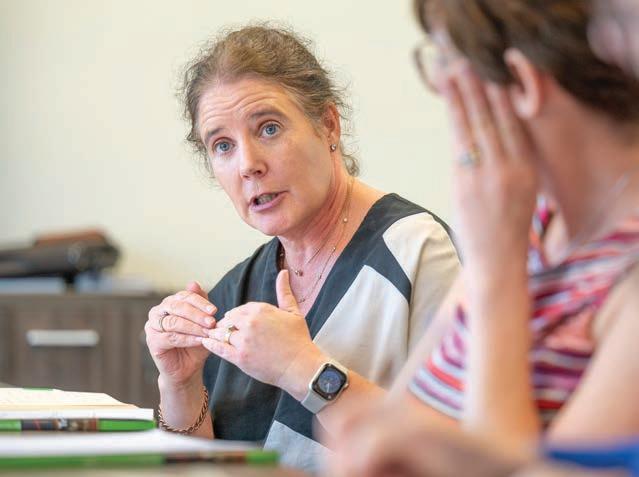
“When we design for extreme users – at either end of the curve – we can increase accessibility to as many people as possible...” Aideen Hartney
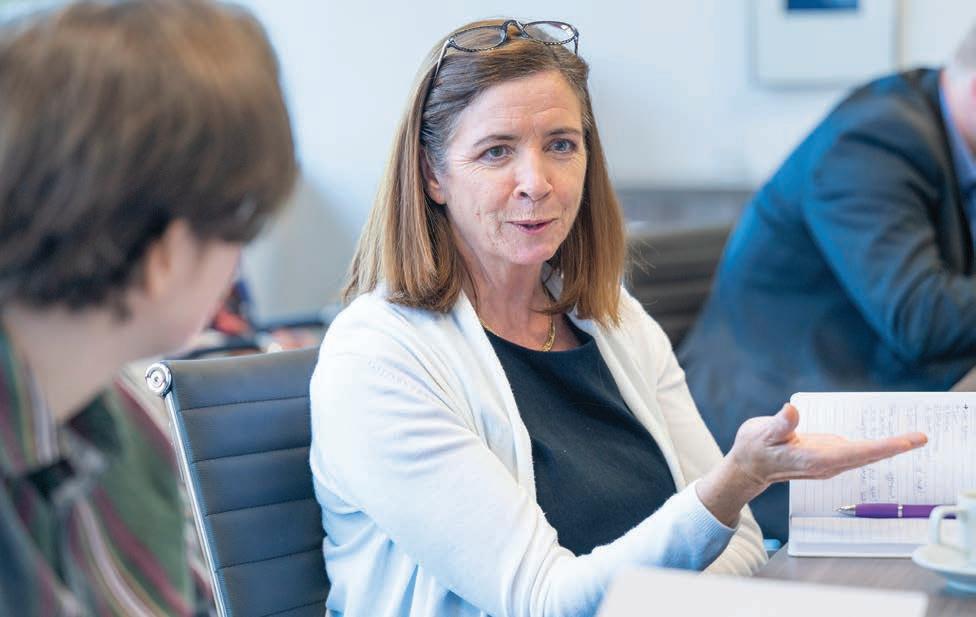
How have your stakeholders’ expectations of the Courts Service evolved?
Aideen Hartney
European legislation means we have new legal obligations. As per the EU Web Accessibility Directive, all public service websites and apps are supposed to be fully accessible. In this context, we must ensure that all digital developments delivered by the Courts Service are accessible for disabled users. The National Disability Authority has the statutory monitoring duty for the Directive. Having assessed progress over the last few years, there is a considerable road to travel for most state-affiliated entities. It is encouraging to hear that the Courts Service is working on an IT strategy and that accessibility is a priority.
Simultaneously, the EU Accessibility Act, which was recently transposed into Irish legislation, aims to ensure that products and services on offer in the State are accessible and will come into effect from June 2025.
Angela Denning
The Courts Service website is undergoing an overhaul, and progress is being made, particularly with elements such as new easy to understand content on family law, civil debt and Probate. We have been using external partners to test sites to ensure

that everything is accessible, but it is a real challenge. Legal terminology has a particular meaning because we are a common law jurisdiction, and it can be difficult to always use plain English. In terms of expectations, the civil service delivered for people during Covid-19, and I think the success of the Pandemic Unemployment Payment (PUP), for example, increased expectations exponentially. The difference was that due to the emergency nature of Covid-19, much of the usual scrutiny was circumvented amid the need for agility. We were able to get remote courts up and running in a very short space of time. They are not perfect. We must make changes and make them easier to access. We are also very conscious that whatever we roll out must be accessible via any type of mobile device, including with poor connectivity. We cannot exclude people for having a device which is 10 years old, or where they live geographically. That is the challenge; it is about meeting the expectations to improve accessibility for all of our people.
Colleen Dube
Stakeholders’ expectations can be described as ones of urgency, immediacy, efficiency and accessibility. Other essential considerations are security and confidentiality that influence the public’s support and trust. Some people do not want to engage online for understandable reasons, such as cyber threat, but also because of a
lack of confidence in their skills and connectivity.
Mary Murphy
‘Expectations’ is the key word in this conversation because people’s expectations of public services are high. But when I engage with older persons from a digitalisation perspective, there is also an expectation that there will always be an office they can walk into, a phone number they can call, and a human available they can talk to. However, many older people feel a sense of betrayal and are under the impression that a social contract is being broken by the acceleration of digital only services. Another factor is the specificity of people’s situations and the individual complexity of cases. For example, if a person finds themselves in a complex situation relating to tax, they want to speak with a person at Revenue rather than just relying on FAQs on a website. This expectation applies equally to the Courts Service. Things like family law are exceptionally complicated and even the bestdesigned website cannot account for every single scenario in which someone may find themselves. These challenges can only be addressed where public 4

“‘Expectations’ is the key word in this conversation because people’s expectations of public services are high.” Mary Murphy
servants are available and equipped with the necessary expertise to guide people through a particular situation. As such, we must ensure that the human element of public service is never lost.
From our perspective, in supporting victims, it is about practicality. What victims need when they go to court is very pragmatic. Having information on the Courts Service website about each court and how to get there is hugely helpful. Consider, for instance, a victim who has never been to court before. Often, Victim Support at Court meets victims for a pre-trial visit. However, victims do not always get referred to us. Therefore, it is vitally important to ensure that the necessary information, including a point of contact, is in place for each court. Having a platform in the court building itself to signpost the victim to support services could be useful as victims often return to court multiple times throughout a trial.

What is the significance of collaboration among stakeholders of the Courts Service in overcoming the challenges of digitalisation?
Dympna Kenny
From a courts system perspective, it is really important to engage with all the stakeholders to make sure that its digital ambitions work for people. Not all the solutions to the challenges we face today are digital. From a digital perspective, collaborating and having discussions like this one are extremely important, and getting the right people around the table means that everyone is engaged and represented as we drive forward change.
Mary Murphy
What we all need to remember is that inclusive digitalisation is not a niche or siloed challenge. It is a challenge which extends throughout the justice sector, the public service, and wider society. It is important for me, as someone who advocates for older persons, to make that point because we need to underline the urgency of this challenge. It affects so many different people and we need to avoid stereotypes. Collaboration, therefore, is about
understanding the dynamic and nuanced nature of the change taking place.
Within the Courts Service, we engage with people from all walks of life, regardless of age, ability, race, religion, and so on. We must always remember that and be equipped to provide for everyone. As such, the value of this kind of collaboration is fundamental to how we adapt. As we recruit new talent, we have a predominant focus on customer service. This is why we now seek applicants who have a career history in customer service roles. Having people with the skills – including high emotional intelligence – to interact with vulnerable people is important because it changes the entire dynamic of how we deliver our services for the better.
There is an opportunity for the Courts Service to collaborate with many organisations, including people who have experience of the process and are willing to volunteer. What we need to determine is whether the broader public service is aware of the work that the Courts Service is undertaking. Informed by a robust evidence base, the Courts Service is a model which can be learned from and replicated. The value will emanate from how we capture this evidence, profile it, learn from it, and apply it. People need to see evidence which demonstrates how a change has worked. We know that this has happened already in the Courts Service. Now we must capture this change and share it.
Collaboration is a hugely important aspect of effecting change, be that with end-users or with other stakeholders. With the UN Convention on the Rights of Persons with Disabilities, this is now a process which stakeholders expect; they expect to be consulted and involved through the design process of a service, a policy, or a product. To date there has been a tendency across public services to consider disability in a siloed context, but one-in-five Irish people have a disability and ensuring that disabled people are included cannot be achieved without collaboration. Observing and sharing examples of good practice is a hugely important and motivating component of this.

“Informed by a robust evidence base, the Courts Service is a model which can be learned from and replicated.” Colleen Dube
How can public trust be retained and developed as the Courts Service implements more digital solutions?
Colleen Dube
Transparency and participation unlock trust. We have talked about making services inclusive and secure, but there is also an element of making people aware of the work that is being undertaken so that they can realise that the Courts Service is committed to public service. I know the Courts Service is exhibiting the levels of integrity, empathy, and transparency which are critical in maintaining public

trust. However, in my experience, ambition must be managed. Expectations on the public service are colossal and they cannot all be met all of the time. Given the finite resources and the wide variety of stakeholders, it is necessary to determine the priority initiatives that will make a difference, concentrate on them, and bring people on the journey. This builds trust and attracts more people to join the journey.
Dympna Kenny
Sharing successes is equally important. There are many challenges from the Courts Service’s perspective, but it must also demonstrate that public voices are being heard and expectations are being met. Angela
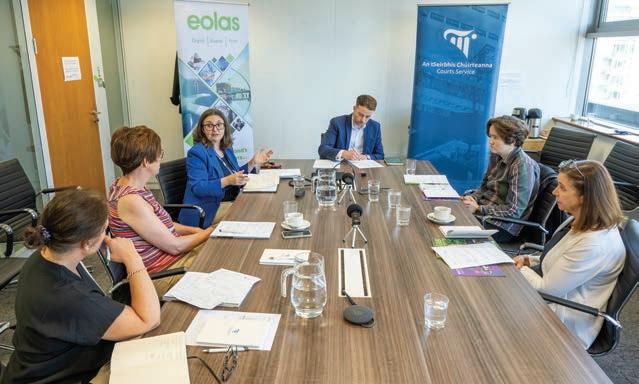
mentioned the Courts Service Modernisation Programme. Obviously, the stakeholders in this room are aware of that programme, but it is equally important that the public understands that the Courts Service is working towards enhanced access to justice and better responding to the needs of court users.
Aideen has talked about expectations around coproduction and public involvement. That process has the effect of cultivating trust through a sense of ownership among the public; that public services are of them, for them, and designed with them in mind. It can be easy to focus on people who are not as especially marginalised or disadvantaged, but trust can become much trickier when considering people who have been over criminalised and have experienced the adversarial side to the courts system. The idea of developing trust with those cohorts of people requires a more comprehensive transformation.
Established in 2022, the Courts Service Inclusion Group has been undertaking work with marginalised communities –such as refugee communities. Here in Smithfield, Dublin, we are surrounded by DEIS schools, yet many local people do not know about the civil service career opportunities available to them within the Courts Service. One of our statutory obligations is to provide information about the courts system. To achieve this, we must reach more marginalised groups, this in turn builds trust.
Aideen Hartney
There are two strands to building trust. Transparency and tone from the topdown is a significant first step, and there is a consensus in this room about how this leadership should trickle down the organisation. Secondly, there are mechanisms which support transparency and tone, such as procurement. If public service bodies can procure goods and services with inclusion in mind from the outset, it makes building public trust much easier. Inclusion should be one of the criterion upon which public service bodies, such as the Courts Service evaluates its tenders.

Under Justice Plan 2024, published in July 2024, the Department of Justice is aiming to establish several new state bodies and ensure passage of flagship legislation.
Justice Plan 2024 – the fourth such publication since the Department of Justice began publishing annual plans in 2021 – identifies five broad goals and the associated objectives to be addressed by the Department throughout 2024.
The five broad goals are:
1. maintaining a safe and secure Ireland;
2. improving access to justice for all;
3. delivering a fair immigration system;
4. strengthening influence in Europe; and
5. investing in people to deliver excellence.
The Department states that it recognises that access to justice is a “fundamental principle of fairness” and aims to implement “the reforms
necessary to deliver a faster and more effective justice system”, with a focus on creating clearer and more concise decision-making timelines.
The Department is aiming to aid the establishment of an independent mediation council as provided for in the Mediation Act 2017.
To achieve this, the Department states that it will support a review of the relevant provisions within the 2017 Act and will support the sector in its work to prepare draft codes of practice, a draft register of mediators, and to identify public interest members of the council.
The Department will consult with a working group to advise the Minister for Justice on appropriate indexation rates for Periodic Payment Orders.
The Department will also contribute to the passing of both primary and secondary legislation to permit the Minister to set indexation rates for such orders.
Upon reviewing the Legal Services Regulatory Authority (LSRA) report, the Department aims to “consider the current barriers” to becoming a solicitor or barrister in Ireland.
In doing so, the Department says it will engage with the LSRA and other relevant stakeholders “as required” to progress necessary reforms in this area.
The Department states that it will seek to establish the JAC, including appointing a director, lay members, and staff, and collaborating with the Public Appointments Service (PAS) to advertise appointments.
Oversee and monitor the implementation of the Judicial Planning Working Group’s recommendations:
The Department states it will present the Judicial Planning Working Group’s recommendations to the Cabinet and oversee their implementation. It will also examine the role and powers of court presidents and quasi-judicial officers, support the piloting of the staggered vacation scheme in the High Court (which commenced in July 2024), and provide the Government with an update on the impact of the additional judges and other key efficiency measures.
In doing so, the Department has committed to convening regular Stakeholder Engagement Group meetings.
The Department will provide programme management services to aid the establishment of the gambling regulatory authority of Ireland, enact the Gambling Regulation Bill, and appoint authority members.
The Gambling Regulation Bill was passed by the Dáil in May 2024 and is currently at Committee Stage before the Seanad.
The Department states it will “work alongside PAS to appoint three new Data Protection commissioners”, with a timeline target of Q4 2024 for this action to be completed.
“This plan will deliver on the goals and objectives as set out in the new A safe, fair and inclusive Ireland: Statement of Strategy 2024-2026.”
The Department of Justice states that, by Q3 2024, it will “support work towards” enactment of the Family Courts Bill 2022 which provides for the creation of new dedicated family courts within the existing court structures.
Minister for Justice Helen McEntee TD states: “This work will continue to make significant steps towards reforming the family justice system as committed to by the Programme for Government.”
The 2024 plan aims to make “significant progress” in updating Ireland’s defamation laws. This includes the publication of the Defamation (Amendment) Bill which follows the publication of the General Scheme in 2023.
Minister of State for Law Reform at the Department of Justice, James Browne TD, says: “This is a significant priority for Government, to reform defamation law to ensure a balanced approach between the rights to freedom of expression, to protection of good name, and to access to justice. I hope to significantly progress during 2024.”
The Department published the Bill in July 2024, although it is unclear whether the legislation will be enacted before dissolution of the current Dáil.
Through the targeted actions, the Department states that it aims to “substantially improve” public confidence in the justice system and ensure that it is more accessible and responsive to the needs of all citizens. In combination with the other broad goals as stated in the plan, the Department outlines its goal to usher in widespread reform and modernisation of the national legal system.
Remarking on the publication of the most recent justice plan, McEntee says: “This comprehensive plan sets out in detail a substantial programme of work to be carried out by the Department of Justice throughout 2024. This plan will deliver on the goals and objectives as set out in the new A safe, fair and inclusive Ireland: Statement of Strategy 2024-2026.” The Minister of State added: “The Plan will continue to progress our key priorities so that the Justice Sector continues to develop its capabilities across a wide range of areas.”

An Garda Síochána’s Operational Support Services provide specialist support to Gardaí throughout the country. These consist of four units: The Mounted Support Unit; The Air Support Unit; The Dog Unit; and The Water Unit. Each play a critical role in supporting operational activity and investigations.
The work carried out by a number of these specialist teams has been highlighted as part of An Garda Síochána’s new podcast series, The Garda Podcast
Sergeant Mark Campbell of the Garda Air Support Unit based at Casement Aerodrome in Baldonnel speaks about this important Garda resource and the work the unit’s two EC 135T2 helicopters are involved in.
“Air support is a key asset in the search for missing persons, and Sergeant Campbell highlights the advantages associated with deploying in those circumstances.
“By virtue of the elevation we are at we have a far better field of view of an area on the ground. We can scan and peruse an area more timely, day or night, and can give a better result where someone is missing or had an injury and needs to be recovered,” he said.
“We operate within weather minima and that varies whether we are operating during the day or at night. During the night we will operate with various technologies like night vision goggles, and that’s to take account of the added dynamism that is needed to operate in that sort of setting, particularly in areas with challenging topography - mountains, rivers, masts, things that are easily seen in the daylight but not in the late hours. It will vary where you will go and how you will operate,” he explained.
The Air Support Unit are also involved in assessing crowd density at large scale outdoor events like the St Patrick’s Day parade, concerts, sporting events or large gatherings in community settings. For instance, where there is a traffic management issue, we can relay that to the control room and they can put a policing plan in place to deal with that issue. There would always be an

emergency route and we check it to make sure there is access for ambulance and first responders.
“We operate on a two-minute response time. So from receipt of a call to deployment it is a two-minute response, 24 hours a day,” Sergeant Campbell said, which essentially means they are always ready to deploy. The Garda Air Support serves the entire country and will either self-deploy or be tasked to deploy on instruction, depending on how a situation is unfolding.
While the Garda Air Support provides that eye in the sky, the Garda Water Unit provides the necessary skills and support to delve into the depths, assisting in recovery of evidence and persons in water or confined space.
Garda Lorcán Byrne of the Garda Water Unit details the important work this specialist unit does and how they have recovered everything from the smallest item like a key on the bed of a canal, to locating and gathering evidence from large submerged items like cars.
“We first and foremost are sworn members of An Garda Síochána, so our powers are the same. The Maritime Safety Act and the Maritime Security Act goes out to 12 miles out from the low water mark. So beyond what you can see on your local beach, we still have jurisdiction all the way out there. And with some acts its waters adjacent to Irish waters. We are basically the guards for
out on the water,” he explains.
Garda Byrne said their work varies from “doing a boat patrol where we are enforcing careless navigation, or dangerous navigation or not wearing life jackets” to security for VIP vessels arriving here, to searching for evidence, or missing persons. The Garda Water Unit have the capabilities to dive to depths of 50 meters, whether that is at sea or inland.
They also work to assist other agencies, such as the Marine Casualty Investigation Board, or the Air Accident Investigation Unit, and responded when Rescue 116 crashed off Black Rock island in Mayo in 2017.
“We gather evidence like any other guard. A lot of the time it is missing people we are looking for. Whether that be through self-harm or through accident, or a collision where a car enters the water after a collision. We would go and recover the deceased persons from the car and then try to ascertain what condition the car was in, was the car in gear, was the engine on. That might give an indication that say it was a very narrow road and the car was in fifth gear so the car would have been going at a greater speed, so that would assist the

road crash investigation team,” he explains.
Another area of their work takes them to environments that may feature noxious gas.
“We would often search culverts that go under roads. Our colleagues might look through this concrete pipe and can see the other side and might think I can walk through there. But that inch or two inches of water with rotten leaves or whatever in the pipe, as you disturb that it can give off a gas, and some of those gases are lethal,” he warned.
In situations where there may be a threat of such gases the Garda Water Unit is called in to investigate using the right training, tools, and equipment.
Further to these units, The Garda Dog Unit is an integral part of policing. Garda dogs work to assist in searches for suspects of crimes and for evidence. The dogs are also trained to work in serious public order disturbances; they assist in the execution of warrants. Most act as “detector” dogs – trained to locate cocaine, cannabis, ecstasy, and heroin, while there are others that work as “cadaver” dogs, who help to recover missing persons on land and from water.
Meanwhile, the Garda Mounted Unit provides important support in the area of high visibility crime prevention, detection patrols, searches for missing persons particularly in terrain that cannot be accessed by vehicles, public order and crowd control; as well as community policing and major event policing.
To find out more, The Garda Podcast is available now on Spotify, Apple and Amazon Music. Episodes feature the Garda National Mounted Unit; the Garda National Cyber Crime Bureau; the Garda Protective Services Bureau; the Criminal Assets Bureau; and the Garda National Drug and Organised Crime Bureau.
T: +353 1 666 0000
W: www.garda.ie
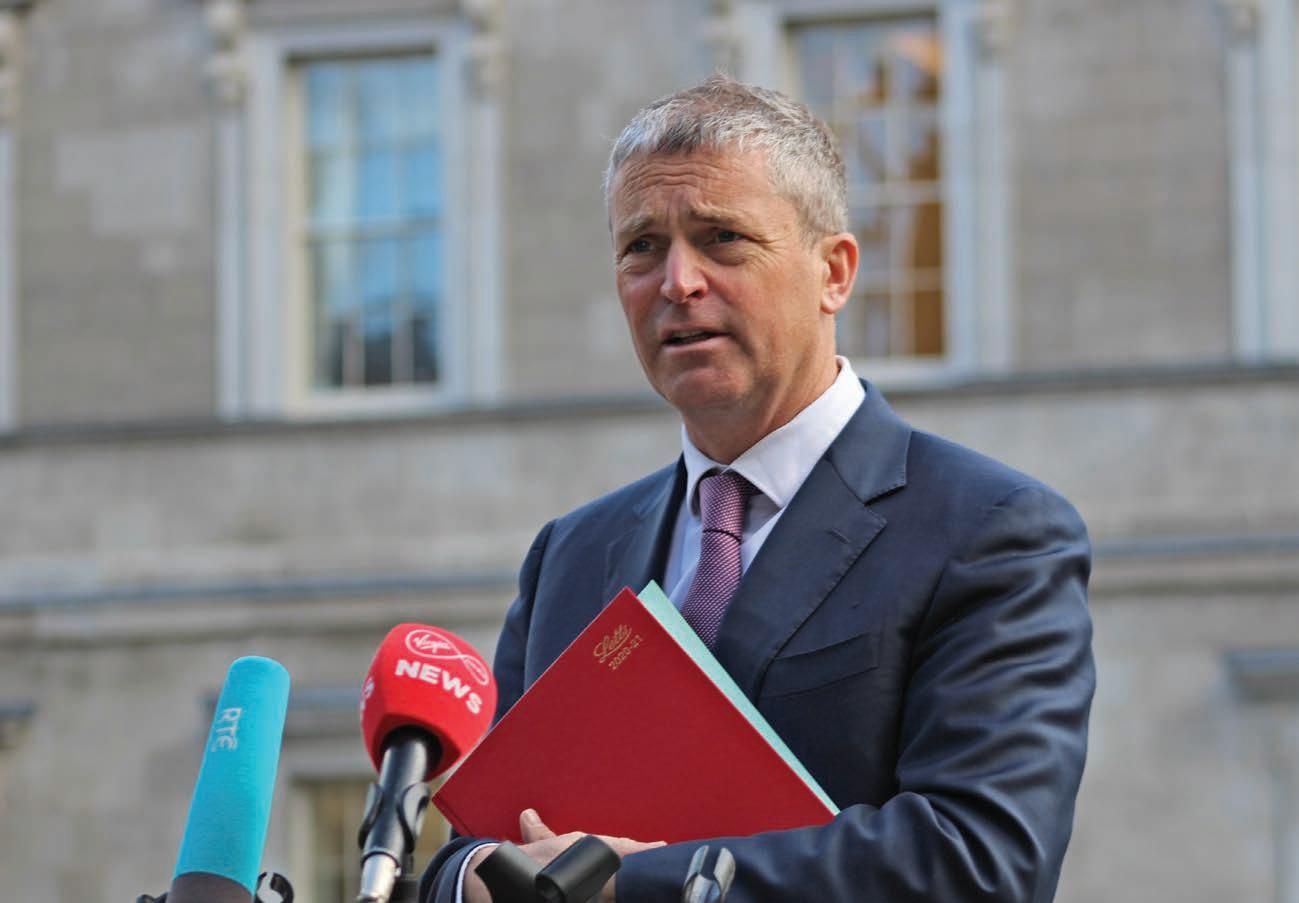
Sinn Féin justice spokesperson Pa Daly TD:
‘All-island
Speaking with eolas Magazine ahead of a general election that many observers anticipate will arrive in autumn 2024, Sinn Féin’s spokesperson on justice, Pa Daly TD, outlines his party’s justice policy platform.
Ciarán Galway (CG): With less than six months until a general election must be held, what are your most significant priorities as Sinn Féin’s justice spokesperson?
Pa Daly (PD): Building proposals that emphasise public safety, are evidence-based, and address the fear of crime as well as crime itself. We feel strongly that Fine Gael are out of touch, and with over 13 years in the justice portfolio, are out of time. Making the case for Sinn Féin changing what is wrong within the justice system is my number priority.
CG: What distinguishes Sinn Féin’s justice policies from those of its political rivals?
PD: As Irish republicans, we have direct links into communities that are most affected by crime, and we want to address the causes and effects of crime as well. At the same time, we have a strong grounding in human rights and accountability. The experience of our comrades in the six counties is invaluable in that respect and whilst we clearly have a long way to go on both sides of the border, that all-island view gives us a unique perspective.
“I do not agree we have been wrong-footed so much as we have found it difficult at times to communicate our position...”
Pa Daly TD, spokesperson on justice, Sinn Féin
CG: How has Sinn Féin sought to maximise its influence on justice policy from the opposition benches?
PD: We have sought to oppose where it is correct to do so, but also to provide alternatives, raise legitimate concerns and advance policy. One of the big focuses I have had in the role is the moving of Private Members Bills, which often do not pass the House but do keep the government honest. Both the Criminal Justice (Promotion of Restorative Justice) (Amendment) Bill 2023 and the National Vetting Bureau (Children and Vulnerable Persons) (Amendment) Bill 2022 took extensive research and are very fully realised initiatives.
The opposition is sometimes at a bit of a disadvantage in terms of policies resources, but I am grateful for the work of the Office of Parliamentary Legal Advisers, who helped to draft those two bills and others as well. That demonstrates what the potential of a Sinn Féin-led government is.
CG: To what extent has Sinn Féin been wrong-footed by the discourse around immigration?
PD: I do not agree we have been wrong-footed so much as we have found it difficult at times to communicate our position, namely that we should have a system which is fair, efficient and enforced. We could have done better, but at the same time, there are a lot of factors that are against us. We now have a policy document on the area and my sense is people have taken a breath, have reflected and understand where we are coming from a lot better.
CG: How could Sinn Féin’s vision for the State’s international protection system be summarised?
PD: Our views are set out in International Protection: A Fair System That Works, which is available on our website. I would encourage people to read it in full, but we want to end private profiteering and move to state run accommodation, put new centres only in areas which have the capacity to deal with them and speed up processing times. We also want to end the two-tier system of treatment, give HIQA a role in inspecting properties, and ensure human rights compliance.
CG: What policies would Sinn Féin seek to deliver in the justice portfolio in a full term of government?
PD: We would implement a Garda recruitment and retention taskforce, establish a public transport police, double youth justice interventions and double funding for restorative justice initiatives. Our full proposals will be further set out in our manifesto, and I am looking forward to engaging with different stakeholders in relation to this.



Mark Wilson, Director of the Probation Service:
“The new role reflects the Probation Service’s commitment to innovation, diversifying our organisation, and realising our vision for safer, more inclusive communities where offending and its causes are addressed.”
In late 2023, the Probation Service introduced probation assistants, a brand-new grade to the Service designed to bolster the work it does in building safer communities by supporting probation officers. It is an important and innovative role with huge potential to expand and diversify the talent pool working in the Probation Service and increase our effectiveness as a national service, explains Mark Wilson, Director of the Probation Service.
The Probation Service, like all organisations across the civil service, has encountered numerous challenges, particularly in recruiting staff and maintaining our commitment to delivering essential services. However, amidst these challenges lies an opportunity: How can a century-old organisation innovate and adapt to the needs of the 21st century?
One vital way we are addressing this is through the introduction of probation assistants. This new role, operational since late 2023, is instrumental in opening our organisation to a diversity of talent and experience while complementing the work of probation officers. While the Probation Service remains rooted in social work, we
recognise the importance of embracing diversity and adapting our roles to support the work we do in offender rehabilitation and desistance.
The probation assistant role is neither new nor unique as it has been firmly established in several jurisdictions across Europe. In fact, rolling it out had been examined previously in Ireland, but in the last few years the Probation Service approached the idea with a new sense of urgency, openness and commitment.
The new probation assistants, already recruited since late 2023 along with additional recruits in 2024, bring fresh ideas and energy to the Service. By the end of 2024 we expect to have 30 probation assistants working across the
Service. Hailing from diverse backgrounds, both within and outside the Service, they assist us in our mission to work with our partners across the criminal justice system and in the community to foster safer communities and adapt to the changing landscape.
The appetite for the new role within the Probation Service was matched by the appetite from candidates; we received 600 applications from the first round of recruiting and those applicants displayed a rich array of skills, talents, and experience.
While the role is still very much new and in the beta phase, already probation assistants are working alongside probation officers on community service teams, young people’s probations teams, and in court. As the numbers of new recruits expands and more probation assistants join the Service they will become integral members in Probation Service teams across the country.
Probation assistants complement and add to the work we do by engaging with Probation Service clients providing initial reporting instructions, overseeing community service assessment, and supporting people who have offended. Probation assistants also assist with court attendance and handle
“No two days are the same. It is a role full of potential, room for growth and delivering positive outcomes for our clients.”
administrative tasks. What is not changed is a commitment to upholding standards of professionalism while contributing to safer communities and supporting the rehabilitation of individuals within the criminal justice system by addressing offending behaviour and its causes.
In its totality, probation assistants are an integral part of what our community teams do within courts, delivering community service, managing lower risk cases, working in prisons, assisting with care and resettlement. On a daily basis, their complementary work goes to the heart of what we do, building safer communities across Ireland.
But it is important also that we recognise that with this new role there will be challenges and with that the opportunity to adapt and grow. We will accomplish this through feedback from our new probation assistants, as well as probation officers, and with all our stakeholders.
Together, we will continue to explore how the role of the probation assistant could be a pathway to further career progression. Likewise, we’ll explore how the role could eventually be adapted to include people with lived experience and how they could enrich and enhance the work we do through their insights and experience. By fostering an inclusive environment that values diverse perspectives and backgrounds, we can transform the probation assistant position into a dynamic platform for professional growth and societal impact.
Similarly, the new role shows our commitment to evolve and innovate as we continue to be an employer of choice, to meet the challenges of an ever-evolving labour market, and above all to realise our vision for “safer and more inclusive communities where offending and its causes are addressed”.
For more information:
T: (0)1 817 3600
E: psinfo@probation.ie.
W: www.probation.ie
W: www.linkedin.com/company/the-probation-service/


Originally from Poland, Agnieszka (Aga) Bates moved to Ireland in 2006. She completed a degree in banking before joining the Probation Service as a clerical officer in 2018, and later moving to the International Protection Office in 2023. When recruitment for the new grade of probation assistant opened in 2023, Aga applied as she was excited about the opportunity to return to the Service and work in a more hands-on role.
Describe a typical day like in your role as a Probation Assistant?
No two days are the same. For example, in the office, I usually have supervision appointments and a range of administration duties. Outside the office, I work closely with our Community Based Organisations, linking in with our female clients and developing supports for them; other days I might have court duties. A significant part of my day involves linking in with homeless services, keeping in regular contact with our clients. I also help my senior probation officer (SPO) with administrative duties, so it is very much a complementary role and one full of potential, room for growth and delivering positive outcomes for our clients.
Speaking to eolas Magazine following her recent contribution to the Public Services 2024 Conference, Executive Director for Strategy and Transformation at An Garda Síochána, Eimear Bourke, highlights how service transformation is crucial in providing a better policing service to the communities and the people of Ireland.

Bourke outlines that An Garda Síochána has undergone a period of significant transformation to its services, structures and ways of working in recent years. The underlining principle of this process, she says, has been the need to prioritise and support frontline gardaí in delivering effective services in communities. Given the inherent unpredictability of policing demand, Bourke says that delivering and realising the benefits of change within An Garda Síochána “means we need to apply two lenses; operational flexibility and long-term improvement”.
With over 17,000 personnel, including 14,000 gardaí, An Garda Síochána operates an extensive network of approximately 560 stations, supported by a €2.3 billion budget. “What makes us unique from other policing agencies is that we cover both policing and national security,” the Executive Director for Strategy and Transformation observes. The transformation journey over the past five years, driven by the A Policing Service for the Future implementation plan, has focused on supporting frontline service through new operating structures, leveraging new technology, enhancing governance, and fostering specialised supports. This includes:
shifting from a district to a divisional model; increased focus on community policing; and having centralised business services supports in every Garda division.
“Greater accountability around what we do and the decisions that we make is important to communities and people having trust in what we do,” Bourke indicates.
And as noted in the latest Garda Public Attitudes Survey of 2022, there is a high level of public trust in An Garda Síochána with 90 per cent of those surveyed viewing the organisation as fair and respectful. That trust, Bourke emphasises, is critical in shaping strategies.
“Public perception feeds into our three-year strategy and planning, but also it helps us in terms of how we allocate resources and decisions that we make on an operational basis,” she says.
In shaping strategy Bourke reflects on Ireland’s changing context, which is marked by global challenges such as climate change, migration, and cyber-enabled crime, outlines the importance of a collaborative approach. In this context, she notes An Garda Síochána works closely with government
“We need to be sophisticated, leverage technologies and upskill our people to tackle the changing natures of crime.”
Eimear
departments and community organisations to collaboratively tackle issues ranging from road safety to crime.
“The nature of crime is consistently changing. The definition of crime 20 years ago is very different to today, with economic and cyber related crime cited as examples where An Garda Síochána have adapted and grown specialist skills and capabilities to prevent and investigate such crime types.
“Technological advancements have also been pivotal. Alongside An Garda Síochána’s transformation programme, the ongoing delivery of a data and technology vision has seen significant investments in IT and data architecture, supporting enhanced information-led approaches to policing,” she says.
Under the active mobility programme, for example, every Garda member now has a mobile device equipped with custom policing apps that allow them to spend less time in stations, and more time working in communities.
These devices are proactively assisting gardaí in detecting crime while on frontline duties, for instance a new system now allows members of An Garda Síochána to quickly and easily identify uninsured vehicles while on the roadside by checking its registration on a Garda Mobility App.
Furthermore, the launch of a proof of concept for body worn cameras, and the supporting Digital Evidence Management System (DEMS), at stations in Dublin and Limerick city marks another step forward for An Garda Síochána towards the implementation of information-led policing.
There are now four stations and 500 trained gardaí using body worn cameras. Their benefits are already being seen with feedback suggesting they have directly led to the de-escalation of situations which might ordinarily escalate.
The ability of An Garda Síochána to securely acquire and process digital evidence is a key feature of modern policing. And the use of body worn cameras, supported by the underlying legislation, technology and training, acts as an important evidentiary tool.
Bourke highlights that further advances have been made in service delivery following the introduction of the GardaSAFE computer aided dispatch system. This has seen a significant upgrade in emergency response and dispatch technology, managed through four new regional command and control centres.
“This means that we can make real-time decisions on how we prioritise calls, how we allocate resources, making sure that resources are sent to a particular call, and they have got the right skills and right equipment. Therefore, it means that when a garda goes to a particular call, they have all the information they need,” Bourke underlines.
Beyond this she also highlights the importance of adapting and expanding the skillsets and expertise of personnel within An Garda Síochána.
The Executive Director for Strategy and Transformation outlines the importance of investing in people. One of the key benefits of An Garda Síochána’s new
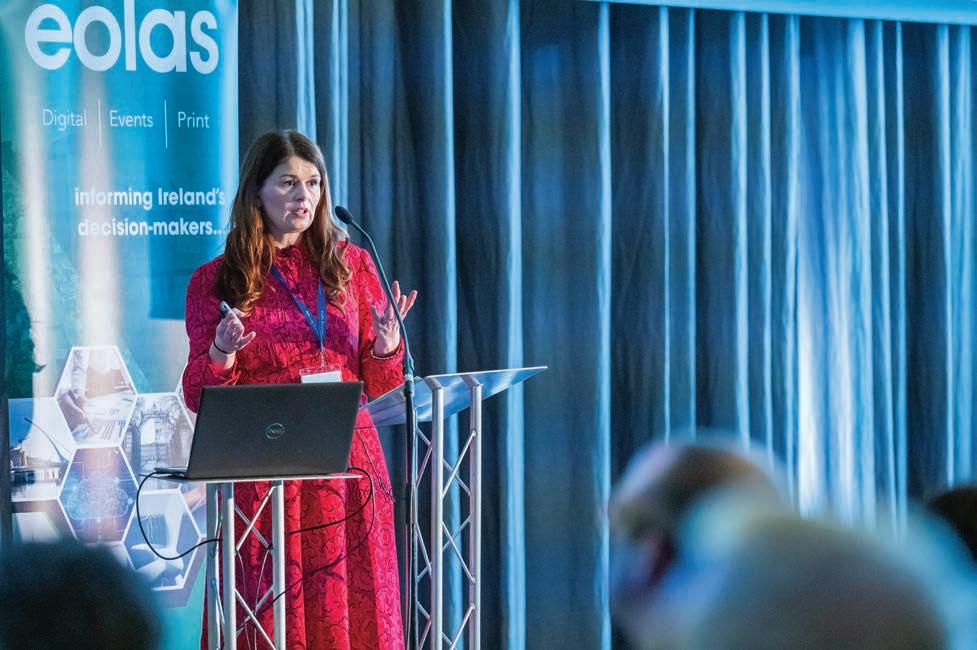
divisional operating model, she says, is that it has allowed the redeployment of gardaí from administrative to policing roles. This has been supported by a significant increase in the size and skill profile of An Garda Síochána’s civilian workforce.

However, in a competitive recruitment landscape, Bourke says that An Garda Síochána recognises the need to balance new recruitment with the retention and career development of its existing workforce, who possess extensive organisational knowledge and experience.
Significant changes have been made in personnel development, she outlined. With over 740 new Garda trainees and 530 new civilian staff joining in 2023, the focus has also been on health and wellbeing, mental health training, and in particular human rights education.
She outlines that in recent years, An Garda Síochána has put a significant emphasis on our role as the first line of defence of the human rights of all people we come into contact with.
“Human rights are central to every decision we make,” reflects Bourke, highlighting the integration of ethical considerations in policing through the Garda Code of Ethics.
She adds that the Garda Code of Ethics clearly states that policing must be carried out in a manner that is independent and impartial, that respects human rights, and that supports the proper and effective administration of justice.
As part of a range of measures to embed human rights, An Garda Síochána, in
“Human rights are central to every decision we make.”
that has been undertaken by more than 3,000 Garda personnel (*correct as of June 2024) with 1,000 more to take it in 2024.
Policing colleagues from the Federal Bureau of Investigation (FBI), the Drug Enforcement Administration (DEA), the United States Department of Homeland Security, the Belgian Federal Police, and the Tanzanian Police Force have also undertaken the course.
Summarising, Bourke asserts that An Garda Síochána’s mission of keeping people safe is “more relevant than ever in a rapidly changing Ireland”.
“We need to be sophisticated, leverage technologies and upskill our people to tackle the changing natures of crime. We are going to continue to focus on supporting our people by focusing on their professional development, along with their health and wellbeing. This is a huge opportunity, and it is exciting to see the impact of what that means. We want all of this to have a significant, positive impact on our all our people”.
“The ongoing commitment to community engagement, ethical policing and supporting our people will ensure that An Garda Síochána remains a trusted and effective policing service dedicated to serving communities and the people of Ireland,” she concludes.
These statistics have been compiled using data from the Courts Service, the Central Statistics Office (CSO), and An Garda Síochána.
• 547,445 new cases come before the courts in 2022
• 39% increase in new civil cases before the District Court since 2021
• 25% increase in cases before Central Criminal Court since 2019
• 15% increase in domestic violence applications coming to the courts since 2019
• Road traffic offences 24% reduction since 2019
• Drug offences 10% since 2019
• Sexual offences down 11% since 2019
• Larceny/robbery/fraud matters down 18% since 2019
Source: Courts Service, September 2023
Sexual offences down 12%
Homicide and related offences down 7%
Theft and related offences up 9%
Weapons and explosives offences up 10%
Robbery, extortion and hijacking offences up 18%
*Q1 2024-Q1 2023 comparison
Source: CSO, June 2024
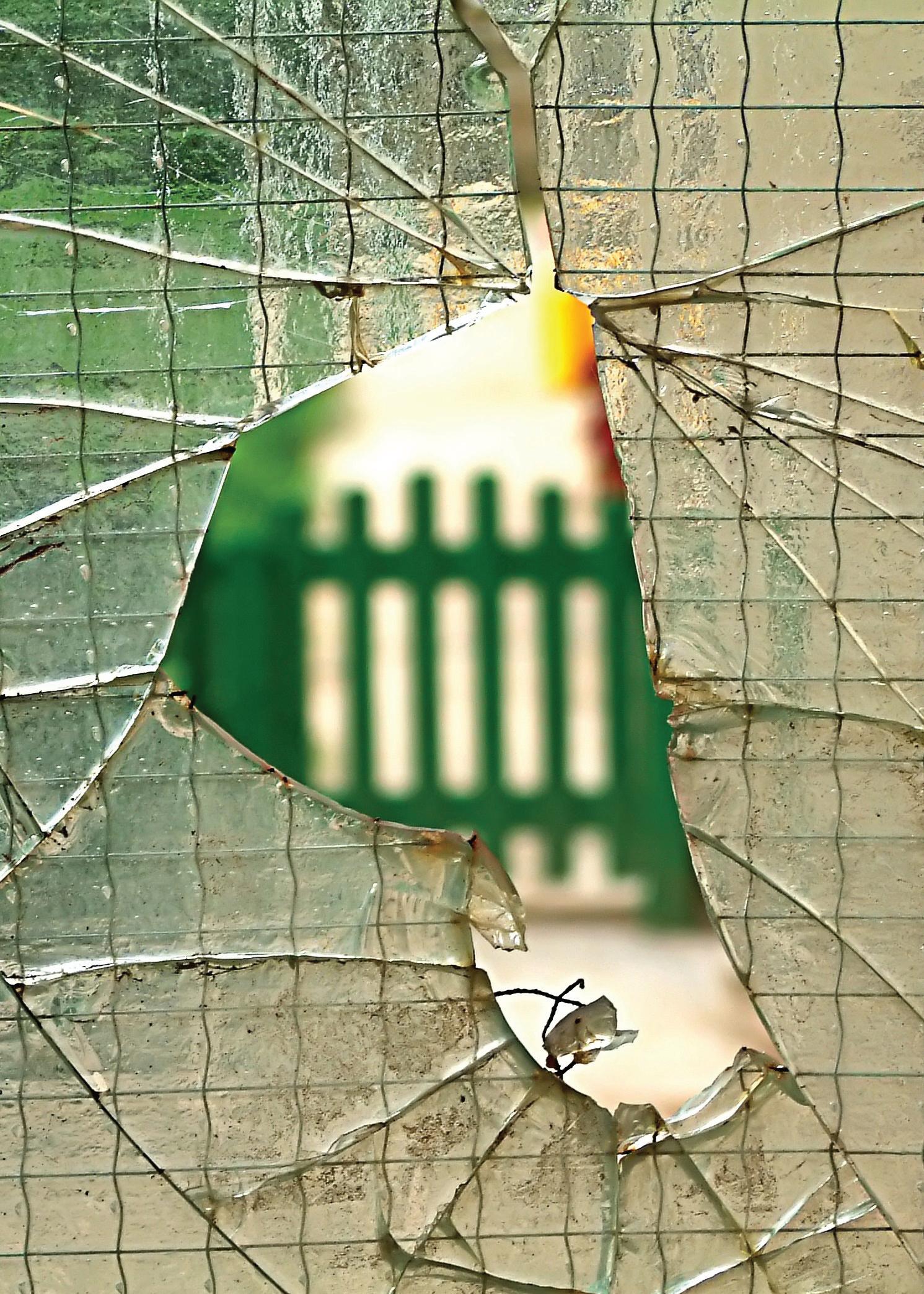
12% increase in the number of hate crimes and hate related (non-crime) incidents reported to An Garda Síochána compared to 2022
651 hate crimes and hate related (noncrime) incidents recorded in 2023
• 582 in 2022
548 hate crimes
• 510 in 2022
103 hate related (non-crime) incidents
• 72 in 2022
Source: CSO, June 2024

There

a
Across policing, justice and defence organisations, there is a growing trend in the establishment of transformation roles across senior leadership teams such as a head of transformation role, write Judith Crawford, EY Ireland Government and Public Sector Lead and Hannah de Burgh Whyte, Director, People Consulting, EY.

Previously under the remit of a chief strategy officer or chief technology officer, the standalone chief transformation officer is a sign of the need for a dedicated voice to ensure action and implementation of strategic change.
The vision for transformation needs to come from the top and there should be clear communication on why transformative change is needed, not just what needs to be done. These transformation roles, if used correctly, will be pivotal in bringing the change vision to life at all levels of the organisation and providing visible sponsorship.
Being transformative requires planning for now and the future. Organisations must consider foundational transformation rather than quick fixes and ad hoc investments to give them the ability to adapt. A refocus from the historical value drivers of scale, scope and efficiency to a new core of value creation – putting humans at the centre, deploying technology at speed and
driving innovation at scale – keeps organisations nimble and multidisciplined in a rapidly changing world.
There is no one straight path to the success of an organisation’s transformation. It is a systematic change that comes with its share of twists and turns. The key is to create a culture of experimentation, accept the non-linearity of it, and use technology to realise the transformation vision.
While every change journey is different, below are six “get rights” for transformation leaders based on EY’s experience of delivering major transformational and cultural change in policing, justice and defence over the past 10 years.
1. True leadership alignment
Secure senior leadership team alignment and buy in from the start – do not assume others support the change. Identify the appropriate senior sponsor for each individual transformation programme who will advocate the change and build awareness and understanding of the ‘why’.
“There is no one straight path to the success of an organisation’s transformation. It is a systematic change that comes with its share of twists and turns.”
Judith Crawford, EY Ireland Government and Public Sector Lead
Connect with management and staff
Middle managers set the tone on the ground but they are often the hardest to engage. Get buy in early to encourage them to lead from the front. Engage with key groups to shape, deliver and sustain the change. Understand the change from their perspective – ask, involve and observe. A clear engagement strategy will support reaching the target audience.
3. Analyse and personalise
Create a human centric approach to change – use data and insight to shape, tailor and drive the change journey. Avoid the ‘one size fits all’ pitfall, instead, identify hotspots to target interventions.
4. Think big, start small
Be ambitious and bold in your plans but always pilot and fine-tune to ensure you get it right. Agility is key. Execute quick wins to build confidence; people are more willing to invest their time in the ‘tried and tested’. Reinforce lessons and insights from pilots as well as from similar organisations to build confidence.
Create a compelling narrative
Make sure everyone understands the why, the benefits, and the ‘what is in it for me’. Translate the organisational benefits into what that means for people on the ground. Create a compelling narrative and explain it to the audience. Keep communications consistent and easy to understand and complement them with an easily identifiable brand and identity.
6. Make it stick
Upskill the organisation to enable sustaining the change post go-live. Avoid the ‘one and done’ mentality by creating real capability in the organisation to adopt the change. Measure success by tracking adoption of the behaviours needed to realise the programme’s intended value and be sure to reward and recognise positive behaviours.
Transformation leaders should consider what is needed from an operating model perspective, to ensure the critical elements are in place to help them
drive and achieve change. For example:
• Do I have the right structures and resources in place to deliver on the transformation agenda?
• Does the organisation have the maturity in programme management, change management and project management office skills to prioritise, plan, track and deliver key programmes?
• Is the governance model in place with the right people at the table to make decisions at pace and manage risk across the portfolio of transformation programmes?
• How will data be leveraged to ensure programmes are delivering value and intended benefits?
At a time when transformation is at the forefront of organisation agendas, leadership teams need to embrace the transformation leader, empowering them to drive change and get things done for the good of the organisation, its staff, and customers. Leading the change by giving focus to the six “get rights” and ensuring the right operating model is in place can help transformation leaders to achieve successful and sustainable transformation, while putting humans at the centre of transformation efforts.
To find out how EY can help you: W: www.ey.com/ie/consulting
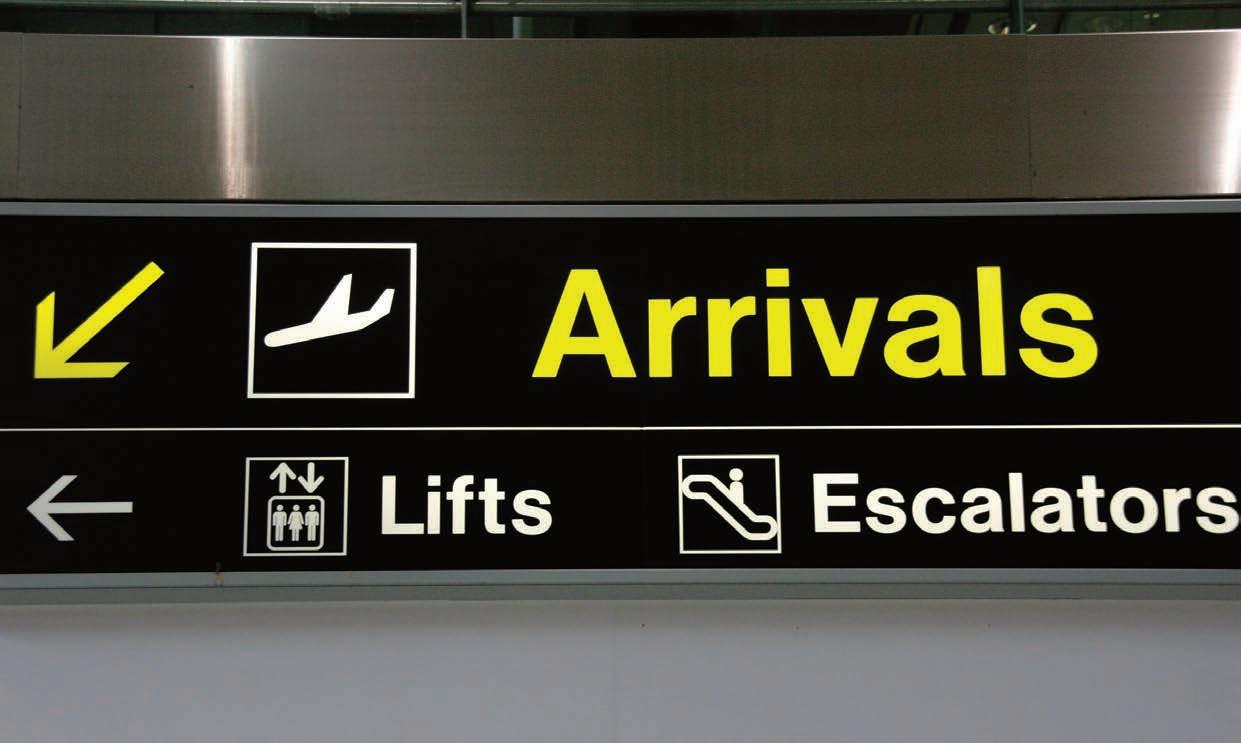
In July 2024, the State officially opted into the European Union’s common asylum and migration policy. eolas Magazine examines what this means for immigration rules in Ireland and the scale of immigration and asylum numbers.
Under the new rules, the European Union seeks to establish a “fair share” principle on the allocation of asylum seekers and refugees in the European Union, owing to stated claims by the Department of Justice that “some member states receive a disproportionate number of claimants in their territory”.
Under the “fair share” principle, the “solidarity” would be set at EU level, with member states contributing on the basis of a mandatory “fair share” principle which is based on a formula of 50 per cent population and 50 per cent GDP. Member states can then choose their preferred method of solidarity which could take the form of relocations or financial contributions.
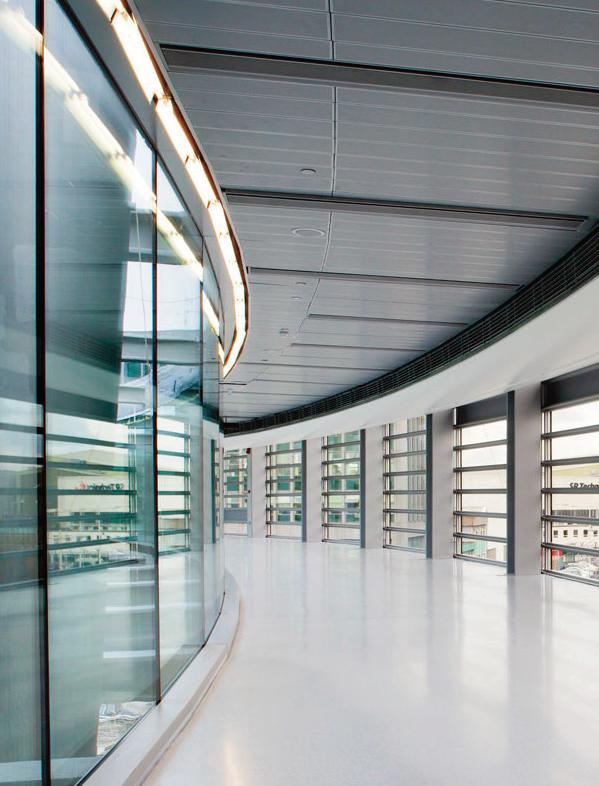
Mandatory accelerated asylum processing for applicants who meet certain criteria, including instances in which they come from a third country with a low recognition rate for asylum across the Union or those who present without documentation will be introduced. This will mean that those who are not entitled to asylum will be, according to the Department of Justice, processed “swiftly”.
The Department of Justice states: “Accelerated asylum processing was introduced in Ireland when Minister McEntee signed regulations in November 2022 to commence the fast processing of applicants from designated safe countries of origin.”
The efficacy of these measures is disputed,

with the main opposition party, Sinn Féin stating that although there were 5,717 asylum applications refused, withdrawn or determined inadmissible in 2023, only 948 of people subject to these refusals were issued with deportation orders and 317 people are “confirmed to have left”.
Under the pact, the State is to be bound by the following legal obligations:
1. Reception Conditions Directive;
2. Qualification Regulation;
3. Asylum Procedure Regulation;
4. Resettlement Regulation;
5. Asylum and Migration Management Regulation;
6. Eurodac Regulation; and
7. Crisis and Force Majeure Regulation.
The Government is now required to transpose these new rules into practice under the Common Implementation Plan, adopted by the Commission on 12 June 2024. The implementation plan sets out actions required to translate the new migration rules into practice and must be adopted by December 2024.
The population of the European Union is an estimated 449 million, while the population of the State is estimated at just under 5.3 million.
According to Eurostat, in 2022, the EU granted protection status to 384,000 asylum seekers, up by 39 per cent compared with 2021 (275,000).
Meanwhile, 875,000 people applied for international protection in the EU countries for the first time. This is an increase of 63 per cent compared with 2021.
The EU countries that received the highest number of first-time applications in 2022 were Germany (218,000 or 25 per cent of all first-time asylum applications in the EU), France (138,000 or 16 per cent), followed by Spain (116,000 or 13 per cent), Austria (110,000 or 13 per cent), and Italy (77,000 or 9 per cent). These five countries together accounted for 75 per cent of all first-time asylum applications in the EU.
Compared with the population of each EU country, the highest rate of first-time applicants in 2022 was recorded in Cyprus (24,000 applicants per one million people), ahead of Austria (12,000) and Luxembourg (4,000). By contrast, the lowest rate was observed in Slovakia (90 per one million people) and Hungary (five per one million people).
Eurostat records 13,645 first-time asylum applicants in Ireland in 2022, up from 2,615 in 2021, marking a yearly increase of 589 per cent.
As a proportion of population, Ireland’s asylum application rate in 2022 was roughly 388 per one million people, based on CSO population estimates compared with the applicant numbers presented by Eurostat. This places Ireland well below some EU member states, and significantly below the UK, which, according to UK Home Office numbers, had 87,000 asylum seekers in 2023, meaning it has a presentation rate of roughly 1,298 per one million people.
In April 2024, Minister for Justice Helen McEntee TD reportedly told the Cabinet that 90 per cent of the State’s asylum seekers arrived via Northern Ireland, although there are no reliable statistics available.
In spite of this assessment, the Department did not comment on whether the claim that 90 per cent of the State’s asylum seekers arrived via Northern Ireland was verifiable. In a statement to eolas Magazine, the Department of Justice asserted: “The Department’s assessment, based on the experience of staff and others working in the field, and based on material gathered at interviews, is that in a significant proportion of cases those applying in the IPO [International protection Office] have entered over the land border.”
McEntee had previously claimed that the number of asylum seeks arriving via the North was 80 per cent, but this was disputed by Minister for Foreign Affairs Micheál Martin TD, who stated that McEntee’s numbers were based on presentations of refugees, but that the 80 per cent figure was “not statistical”.
Ireland’s asylum application numbers are at a record high, at least four-times higher than those presented during the Syrian refugee crisis of 2015, but they are not disproportionately high compared to those of other EU member states and are significantly lower than those of the UK.
Since Ireland is not a member of the EU Schengen Agreement, there is no automatic obligation for the State to participate in a common asylum policy, as it has an opt-in or opt-out clause on individual proposals in the areas of freedom, security and justice through the Lisbon Treaty.
Furthermore, the migration pact does not make any dispensation for Ireland’s special relationship with the UK, which includes freedom of movement between Ireland and the UK via the Common Travel Area, as well as an open border between the two jurisdictions in Ireland.
Therefore if, as Minister McEntee claims, there is a challenge in dealing with refugees arriving via Britain, it seems unlikely that signing up the EU’s centralised approach to dealing with asylum seekers will solve the challenge that is purportedly taking place.
The main aim of Accompaniment Support Services for Children (ASSC) is to provide support for all young people and their families as they negotiate their way through the criminal justice system in Ireland.
“Thank you for all the work you have done for me over this hard time, I could not have done this without you and your support is something I will always remember.”
“Thank you for all your support through this process. You are all amazing and we are very grateful for everything you have done for us.”
ASSC young person and family

ASSC operates a Forensic and Court Accompaniment Support Service and Advocacy service. This can be provided directly before, during and directly after the child’s time in the criminal justice system.
ASSC recognises the continued development of the rights of young victims of crime, now embedded in the
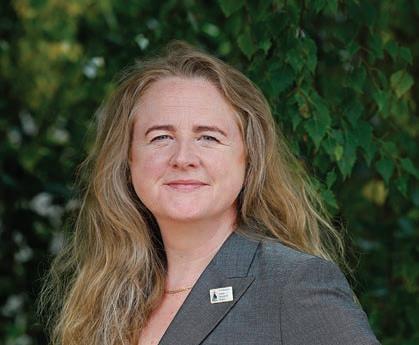
Criminal Justice (Victims of Crime) Act 2017.
ASSC wishes to promote a cultural shift in the development of “child-friendly justice” by providing essential services for child victims of crime. ASSC looks forward to our ongoing partnership with the Department of Justice, and now the new statutory agency Cuan, in supporting


this journey of delivering indispensable support for young people and their families.
ASSC is a not-for-profit charitable organisation set up in 2020 to address the needs of young people as they negotiate their way through the criminal justice system.
ASSC began to secure funding for its services from the Department of Justice in mid-2020. This was due to services being shut down within CARI (Children at Risk in Ireland). Funding was secured in early 2021 (during the peak of Covid-19), which allowed ASSC services to children to begin in early 2021.
Many other professionals support this journey. ASSC acknowledges the hard work of many NGOs and government agencies. We welcome their ongoing support, collaboration and guidance since our establishment in 2020.
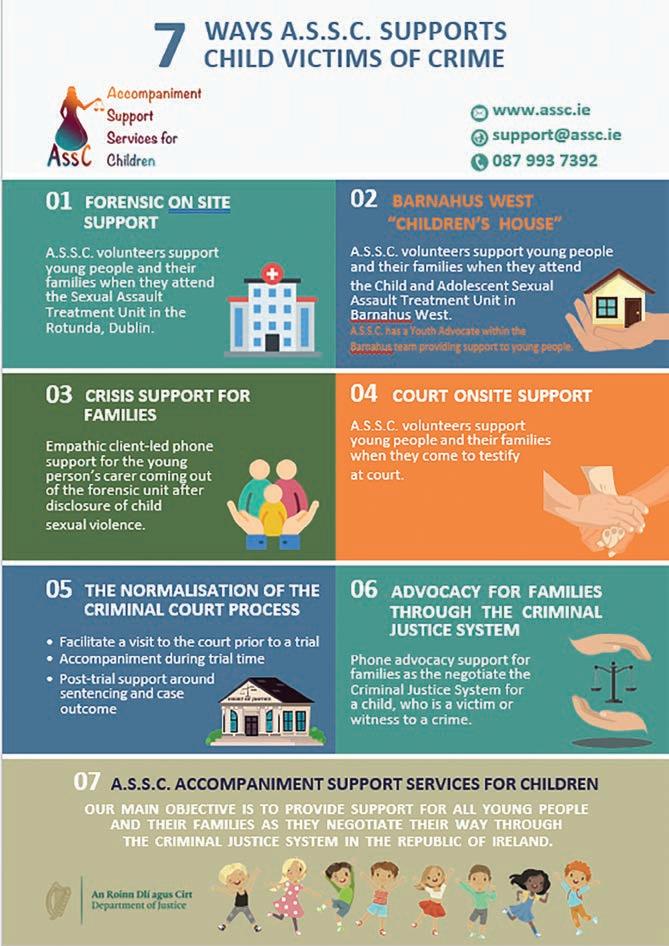
ASSC’s vision is a child-friendly justice system throughout the country that supports and gives a voice to all child victims of crime and witnesses to crime, along with their families, regardless of means, race, ethnicity, ability, gender, sexual orientation, religion, age or location.
ASSC recognises the significant value of effective multi-disciplinary work in providing services to children and young people who are victims of crime or have witnessed crime. We value collaboration with all stakeholders, within the criminal justice system.
ASSC provides three core services: forensic accompaniment, court accompaniment; and support and advocacy.
1. Forensic accompaniment
Onsite support is provided and led by ASSC volunteers. This is provided at two sites
- Sexual Assault Treatment Unit (SATU), Rotunda Hospital, County Dublin
- Child Adolescent Sexual Assault Treatment Services (CASATS), Barnahus West, County Galway
2. Court accompaniment
Nationwide service providing onsite support for young people and families preparing to testify as a victim and witness to any crime:
- ongoing support and advocacy (collaboration with stakeholders key here for family);
- pre-trial meeting ( collaboration encouraged) – key work done with young person and family at this stage;
- DVD accompaniment;
- trial accompaniment – Volunteer-led (supported by staff);
- post-trial support for young people and family;
- sentencing accompaniment; and
- appeals support if applicable.
3. Support and advocacy:
- forensic support and advocacy: Crisis support and advocacy provided to families coming out of the forensic/medical examination units;
- court support and advocacy – Ongoing support and advocacy are provided to families for young people preparing to testify in any criminal trial or hearing;
- ongoing Support and Advocacy –Ongoing support and advocacy are provided to families for young people engaged in the criminal justice system (outside of the forensic and court pathways); and
- ASSC youth advocate – EU Pilot role within Barnahus West. The youth advocate works directly with young people engaged in Barnahus West. This role aims to bring the child’s voice to the multidisciplinary table to facilitate child participation.
Steps forward for the charity include continuing with the national expansion, setting up social media platforms, child participation and research. This will allow ASSC to continue to reach more young people and allowing the voice and experiences of young victims of crime to be advocated for.
Most importantly, we commend the bravery, resilience, and determination of the young people who step forward, breaking the silence. Their courage has provided a path for future child victims of crime to come forward and be heard. We also recognise the families and carers who support and stand beside those young people on this challenging and unpredictable journey through the criminal justice system in Ireland.
For more information: E: support@assc.ie W: www.assc.ie/support-from-assc


The Courts Service continues to introduce digitally enabled services, make evidence-based decisions to transform how we interact with our users, and streamline ways of working.
In implementing greater digitalisation as per our 10-year Modernisation Programme, we are transforming day-today operations across the Courts Service, improving the user experience, and ultimately providing Ireland with a modern, high performing courts system.
We have made significant advancements in our data capabilities, which are driving better ways of working across the Courts Service. The implementation of a comprehensive data dictionary has been pivotal in standardising counting rules across our diverse operations, ensuring consistency and accuracy.
Our focus on the importance of datadriven decisions has provided momentum for the development of a range of management dashboards
across multiple areas of work. Data dashboards are available for court sittings, wait times, probate, jury, and video court utilisation, among others. All data reporting is now launched from a new single reporting portal accessible by management and will expand over 2024 and beyond.
Improved data availability, reliability, and quality also supports the objectives detailed in the Judicial Planning Working Group recommendations. The Judicial Planning Working Group (JPWG) report, published in February 2023, recommended the appointment of 24 additional judges across the Courts.
To track the impact of the additional judges, a quarterly JPWG data impact report has been developed. This report ensures that key metrics used to measure the impact are captured, tracked, and shared throughout the
organisation, with the judiciary and beyond, promoting a data-driven culture.
These initiatives are central to our Modernisation Programme, demonstrating our commitment to support policy making and leveraging data for improved operational and strategic planning.
Earlier in 2024, we launched a pilot of our Open Data Portal, which is aimed at making data from the courts easily available and accessible. The launch of this portal highlights our commitment to open data, and to transparency and accessibility, and will facilitate a better use of courts data. The portal is now live at data.courts.ie and is a useful resource for staff, and members of the public.
The portal takes the data from our annual reports and presents it in a simple, straightforward manner and uses graphic tools to look at trends and patterns. The figures on the portal are also available to download for reuse, in line with open-data principles.
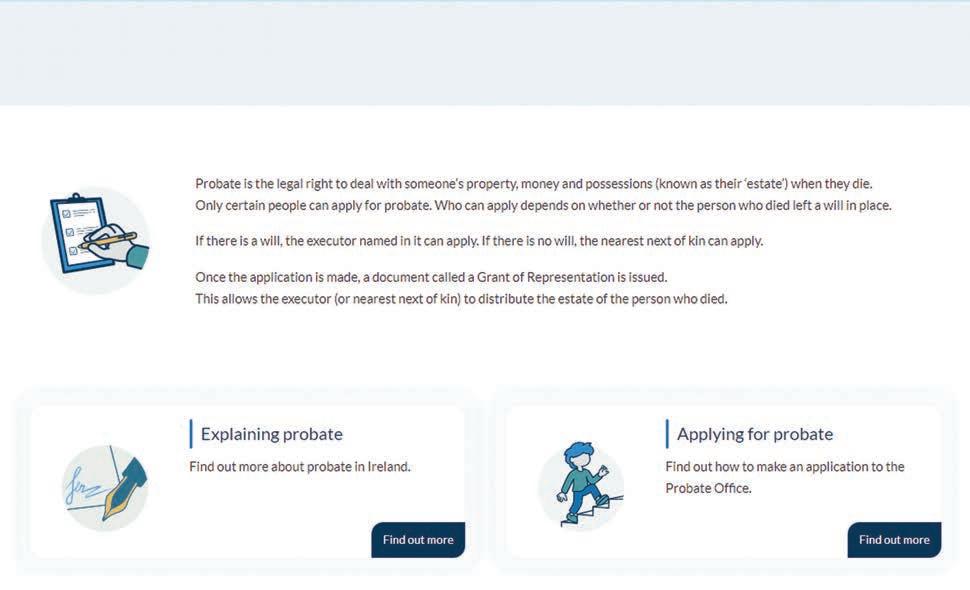
Probate is the legal right to deal with someone’s property, money and possessions (known as their ‘estate’) when they die. Only certain people can apply for probate. Who can apply depends on wether or not the person who died left a will in place.
If there is a will, the executor named in it can apply. If there is no will, the nearest next of kin can apply.
Once the application is made, a document called a Grant of Representation is issued. This allows the executor (or the nearest next of kin) to distribute the estate of the person who died.
Explaining probate
Find out more about probate in Ireland.
Angela Denning, CEO, describes the portal as “a key step” in providing better access to, and a better understanding of, courts data.

“The portal takes the data from our annual reports and presents it in a simple, straightforward manner. It includes data from all our courts – from the District Court right up to the Supreme Court – and is designed to show key statistics, highlight trends and patterns with data, and make the data available for reuse.”
Angela Denning, Chief Executive Officer, Courts Service
We reached a very significant milestone in 2023 when we introduced our transformational Unified Case Management System (UCMS) to several business areas. This is a significant step for the Courts Service as part of our 10year Modernisation Programme.
Since 2021, we have been working to bring new digital technology and modern ways of working to the administration of justice, making access to justice easier and quicker to navigate, better responding to the needs of court users.
One of the main goals of UCMS is to unify the IT systems used by staff across different offices. UCMS is replacing many legacy systems with a single modern user-friendly system that looks and feels the same for all staff, regardless of their region or jurisdiction.
This will enable faster and smoother case processing, as well as improved data quality and security. It will provide a coherence to the way we operate and how we gather data to feed into our decision-making. From an end-user perspective, this case management system will be capable of supporting electronic filings, payments, order collection, case tracking and other related services via an online portal.
UCMS was rolled out to the High Court in October 2023, when 85 staff switched to using the new system. A phased rollout in Circuit Court offices is underway with the aim of having UCMS operational for all Circuit Family activity by Q3 2024. The UCMS solution has also supported the administration associated of the Assisted Decision-Making (Capacity) Act 2015, since commencement in April 2023. UCMS brings several benefits to staff managing cases, such as improved digital record-keeping, bulk actions, prepopulated order templates, validation for data entry, and automatically generated statistics and reports. Overall, staff have found UCMS to be an intuitive and accessible system that enables clear and accurate records.
Applying for probate
Find out how to make an application to the probate office.
Building on the improvements to our website, which includes information about family law and civil debt, we have also reviewed and refreshed content relating to probate.
We continue to take a user-centric approach and engaged with personal applicants and practitioners to develop content that is clear, easy to understand, accurate and meets the needs of all those who interact with the probate process.
The content is easy for both legal practitioners and personal applicants to understand the steps involved in the process, what information they will need to provide each step of the way and what they can expect from us. We also have a new feature which enables people to check in advance if they are entitled to apply for probate. This content is available on courts.ie.
For more information on the Courts Service visit www.courts.ie
In Gaeilge, ‘cuan’ means a haven, a port, or a harbour. It is also the shorthand name given to An Ghníomhaireacht um Fhoréigean Baile, Gnéasach agus Inscnebhunaithe, the new domestic, sexual and gender-based violence (DSGBV) statutory agency under the auspices of the Department of Justice.

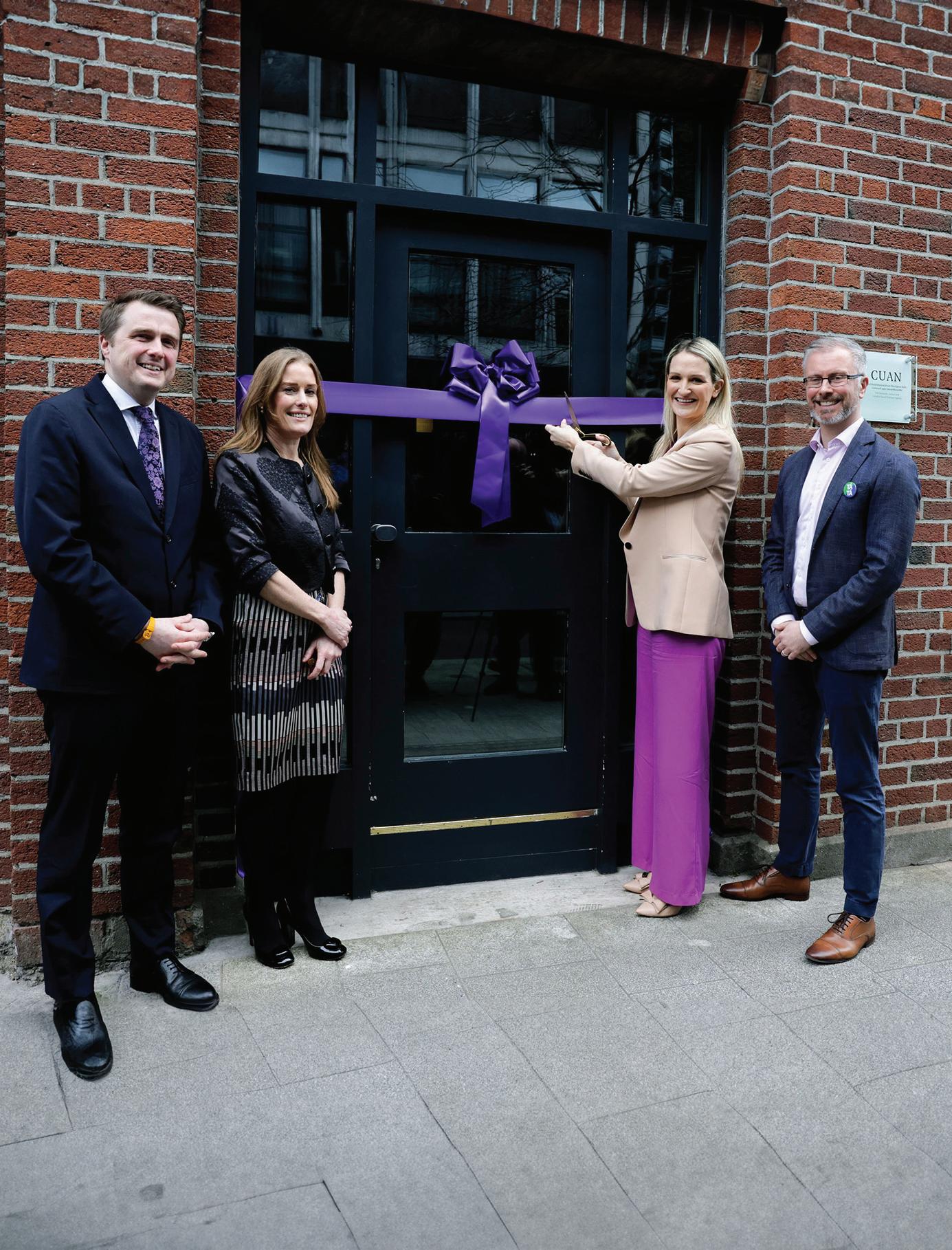

Established on 1 January 2024 under Domestic, Sexual and Gender-Based Violence Agency Act 2023, which was signed into law by the President on 28 November 2023, Cuan has five primary functions:
1. delivering services for DSGBV victims, including the provision of safe and accessible accommodation;
2. establishing national service and governance standards;
3. informing DSGBV policy through its leadership on research and collaboration with other bodies such as the CSO;
4. delivering campaigns intended to both enhance awareness of the available supports and reduce the incidence of DSGBV; and
5. coordinating the actions established in the Third National Strategy on Domestic, Sexual and GenderBased Violence and reporting progress to the Justice Minister.
These functions, the Department of Justice states, were “codesigned with the sector” to ensure that it is equipped with the necessary mandate, responsibilities, and supports. In 2024, the agency has a budget of around €59 million. €47 million is allocated to the services and supports, while the balance is committed to awareness raising initiatives.
On 23 February 2024, Minister for Justice Helen McEntee TD formally opened Cuan alongside the Minister for Children, Equality, Disability, Integration and Youth, Roderic O’Gorman TD, and Minister of State with special responsibility for International Law, Law Reform and Youth Justice, James Browne TD, and announced the appointment of its inaugural CEO, Stephanie O’Keeffe.
“The establishment of a dedicated statutory DSGBV agency has been a priority of mine,” McEntee said, adding: “In designing and delivering Cuan, government and NGOs have come together in collaboration and
commitment. We have seen all political parties support the legislation to establish it, and we have seen unprecedented understanding and support for this work across society.”
Bringing together staff from Tusla – The Child and Family Agency, Department of Children, Equality, Disability, Integration and Youth, and the Department of Justice, Cuan aims to increase cohesion in the provision of DSGBV supports and services.
Appointed following open competition conducted by the Public Appointment Service, Stephanie O’Keeffe, a former National Director of Operations Planning with the Health Service Executive (HSE), became the first CEO of Cuan.
Prior to this, she was the HSE’s National Director of Health and Wellbeing tasked with delivering Healthy Ireland and has more than 20 years of experience across several public service organisations.
Paying tribute to O’Keeffe upon her appointment, McEntee said: “I am delighted that someone of the calibre and experience of Stephanie O’Keeffe, will now take on the task of running the agency. Given her extensive experience of nationwide service delivery, building new and robust teams, and driving forward ambitious whole of government priorities, I am confident this leadership is exactly what Cuan needs, in its formative years.”
Seconded for a five-year term, O’Keeffe acknowledged the challenges of delivering Zero Tolerance, the Government's third national DSGBV strategy, committing Cuan to becoming “a driving force... to build a national movement”.
Thanking McEntee for entrusting her with the task, O’Keeffe said: “My work now is to establish our team and the functions of the new Agency, from research and policy coordination to awareness raising and driving delivery of safe and accessible support services including refuge accommodation.”

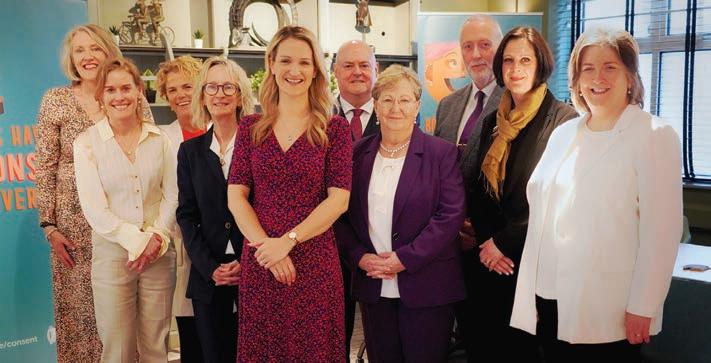
Comprising a chair and six members, the board of Cuan was appointed by and reports to the Minister for Justice. Following an open competition process with state Boards, the inaugural board members are:
• Caroline Fennell (Chair)
Professor emerita of law at University College Cork, Fennell is currently a Commissioner of An Coimisiún Toghcháin having previously served as a Commissioner of the Irish Human Rights and Equality Commission from 2018 to 2023.
• Sarah Benson
Before becoming CEO of Women’s Aid – a position she has held since 2019 –Benson was the CEO of Ruhama, a Dublin-based NGO that works nationally to support women affected by prostitution and other forms of commercial sexual exploitation.
• Molly Buckley
A public health nurse, Buckley has extensive experience in community development and family support services and is a founder of the Offaly Domestic Violence Support Service (ODVSS) which she has chaired for 20 years.
• Denise Charlton
Currently, Charlton is the CEO of Community Foundation Ireland. Previously, she was CEO of the Immigrant Council of Ireland and a Director with Women’s Aid.
• Vivian Geiran
A social worker by profession and an adjunct assistant professor and lecturer on the bachelor in social studies and master in social work programmes at Trinity College Dublin, Geiran served as the Director of the Probation Service from 2012 to 2020.
• Conor Hanly
Currently a lecturer and assistant professor of law at the University of Galway, Hanly also sits on the board of the Galway Rape Crisis Centre.
• Claire Loftus
Having served for 10 years as the Director of Public Prosecutions, Loftus is a retired public servant and a solicitor.
Effective from 4 April 2024, the above were appointed for a period of between three and four years.
The functions of the board include:
• providing strategic direction to Cuan;
• promoting a high standard of corporate governance;
• advising and making recommendations to the Minister in relation to policies impacting the functions of Cuan; and
• adopting an annual report.
Remarking on the appointment of the board, the Justice Minister observed: “I am delighted that people with such experience and knowledge have been appointed to the board. In supporting Cuan to deliver on its functions, their commitment and contribution will be a key element to driving real and positive change for victims and survivors and for society more broadly... I am confident that they will guide Cuan wisely as it continues to develop and implement innovative approaches to preventing DSGBV, supporting victims and survivors, and promoting awareness and education.”



Nature must be protected but is also a powerful tool that can be used to improve water quality and control flooding, as we strive for sustainable solutions, writes Minister of State with responsibility for Nature, Heritage and Electoral Reform, Malcolm Noonan TD.
Maintaining good water quality is vital for the wellbeing of our society, economy, and environment. Our water bodies are not only essential parts of our natural environment, but they are also a national asset that provides our drinking water, nourishes the land and contributes to a sense of wellbeing, whether we are swimming, boating, fishing, or just walking alongside them. The protection and restoration of our waters is a national priority.
Globally, water quality is under threat and there is a considerable challenge ahead to ensure the sustainable use and management of our finite water resources. Even in Ireland, where our water quality is comparatively good and water is relatively abundant, our natural water systems are at substantial risk from increasing nutrient pollution, physical modifications, and urban pollution. This is all happening while our water systems are becoming more vulnerable due to changing weather patterns.
One of the key principles of the new Water Action Plan is to deliver integrated policy objectives for water, biodiversity and climate wherever possible. The plan, which will be officially launched on 5 September 2024, promotes the use of nature-based solutions, both in rural and urban settings.
Not only can nature-based solutions provide attractive features and focal points within the landscape, they can also provide significant ecological value. Designed to manage rainwater, they slow and store runoff and allow it to soak into the ground. Their benefits are wideranging, filtering out pollutants that would otherwise end up in our waters, reducing flooding and easing the burden on combined sewer systems.
These climate-adaptive solutions provide other benefits in terms of urban greening, which can help to mitigate higher urban temperatures. They also contribute towards a more pleasant urban environment that can prioritise
pedestrians, cyclists, and other sustainable travel modes.
In an urban setting, pressures on water quality primarily result from direct surface water discharges and storm water overflows from combined sewers. However, sewer leakage, misconnections to storm drainage along with runoff from paved and un-paved areas area also puts pressure on water quality. In turn, this negatively affects water quality in the natural environment, including bathing water quality.
As urban development continues, surface water runoff from impermeable surfaces increases. This is further exacerbated by climate change as the frequency of intense rainfall events also increases.
Recent research, based on an analysis of European flooding records from 1960 to 2010, suggests that increasing autumn and winter rainfall has already resulted in increasing floods in northwest Europe, including Ireland. We need to change our planning and design philosophy to ensure we consider making space for water by incorporating integrated catchment management principles and water-sensitive urban design.
Nature-based solutions are designed to address rainfall in urban or paved areas in a manner as close as possible to the
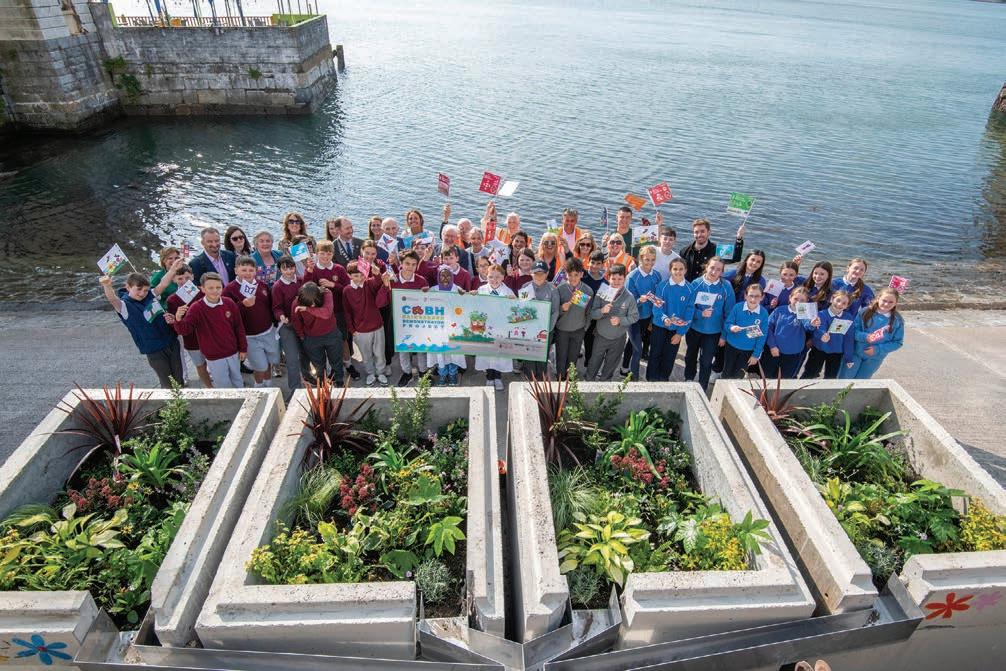
“We must seize every opportunity to harness the power of our natural environment as we seek sustainable pathways to improve our water quality.”
Minister of State with responsibility for Nature, Heritage and Electoral Reform, Malcolm Noonan TD
natural environment. This is achieved by replacing paved or impermeable areas with permeable nature-based surfaces, such as urban rain gardens, permeable paving in parking areas, swales and retention basins. These areas can provide volumetric storage within a catchment in existing or new green areas, which allows both infiltration to groundwater and attenuation of surface water runoff. Nature-based solutions should be located by determining where the surface water flows and then planning drainage routes and solutions along that path to capture overland flow and minimise flood damage.
There is also a benefit to integrating nature-based solutions in a rural setting. A recent ‘Farming for Water’ European Innovation Partnership project aims to support up to 15,000 farmers in implementing on-farm water protection measures. Led by the Local Authority Water Programme (LAWPRO), and in partnership with Teagasc and Dairy Industries Ireland, it focuses on reducing losses of nutrients, sediment, and pesticides to water bodies from agricultural lands. In turn it promotes the adoption of innovative best practice in nutrient management, the application of nature-based solutions and other suitable measures.
To encourage better understanding and adoption of new approaches Government departments have published several guidance documents relating to the application of naturebased solutions, including:
• Nature-based Solutions to the Management of Rainwater and Surface Water Runoff in Urban Areas, November 2021;
• Design Manual for Urban Roads and Streets: Advice Note 5, Road and Street Drainage using Nature-based Solutions, August 2023;
• Greening and Nature-based SuDS for Active Travel Schemes, September 2023;
• Nature Based Management of Urban
Rainwater and Urban Surface Water Discharges: A National Strategy, May 2024; and
• Rainwater Management Plans: Guidance for Local Authorities, May 2024.
In addition, pilot demonstrator projects have been funded by the Department of Housing, Local Government and Heritage in Cobh, County Cork and Dublin city, which will help to guide the wider use of nature-based solutions by demonstrating their efficacy in an Irish context.
In June 2024, President Michael D Higgins signed the Future Ireland and Infrastructure, Climate and Nature Fund Bill into law. The newly established Infrastructure, Climate and Nature Fund is expected to be a significant source of funding for projects looking to address specific climate, nature and water objectives, such as the use of naturebased solutions. Of the total of €14 billion, €3.15 billion is available for climate, nature, and water protection spending between 2026 and 2030.
I feel strongly that, as a country, we must seize every opportunity to harness the power of our natural environment as we seek sustainable pathways to improve our water quality. It is essential that we protect and restore our waters to preserve our natural heritage for future generations.

As CEO of Uisce Éireann, I welcome the opportunity to reflect on what has been a year of momentous change and growth for Ireland’s public water services as we seek to rise to the challenge of delivering transformative water services that enable communities to thrive, writes Niall Gleeson.
Just over a decade since Uisce Éireann (then Irish Water) was set up, we have made enormous progress in the transformation and delivery of safe, secure and sustainable water services in Ireland.
However, we are still dealing with the legacy of decades of under-investment in Ireland’s water services. Much of our asset base, comprising over 90,000 km of pipes network and over 1,700 water and wastewater treatment plants, is ageing and in need of upgrade. Public water services underpin all the basic needs of an open, thriving and globally
competitive society and there is much more for us to do. To modernise our water infrastructure it is essential that funding is provided on an ongoing and consistent basis to enable us to meet this challenge.
The current investment cycle (20202024) has seen €5.26 billion invested in these critical services, benefiting communities across Ireland by putting in place systems and structures to improve the delivery, monitoring and testing of drinking water and wastewater services, ensure compliance with Irish and European standards, and support
Ireland’s growth and development, including housing delivery.
In 2023, our connections team issued over 4,500 connection offers associated with 42,970 housing units. Works to eliminate raw sewage discharges were completed across 10 sites, bringing to 40 the number of locations around the country where new infrastructure is in place or under construction to end the discharge of raw sewage. And we continued to improve the quality of public drinking water supplies, achieving 99.7 per cent compliance with EPA standards.
In the past year, we have also assumed full responsibility for public water services from 31 local authorities, and we are working towards the transfer of all water services staff to Uisce Éireann. We want and need as many local authority staff as possible to join us, integrating their local knowledge, expertise and dedication to water services to support us building a truly national organisation.
Uisce Éireann has a critical role in meeting the State’s environmental, growth, and development needs. It is essential that key enabling infrastructure like water services are appropriately funded. Multiannual funding is crucial to providing certainty in the provision of water and wastewater infrastructure across Ireland. On average our projects can take between five to 10 years from design to completion. Greater certainty provides stability in the delivery of our strategies, plans and programmes. We require multiple cycles of funding to bring our water infrastructure to where we need it to be; and then continuous funding to ensure quality and capacity can keep pace with demand. Without the necessary public water and wastewater infrastructure, there can be no wider economic or housing growth.
Similar to other organisations and globally, Uisce Éireann has also been impacted by higher inflation which does necessitate an increase in funding to reflect increasing costs across the construction sector. In addition, additional water services activities, such as the increased drinking water and wastewater quality standards from new EU Water Framework Directives, will require further increases in funding.
This further highlights the need for sustained ongoing investment for many decades to offset legacy underinvestment in water services. In the absence of growing investment there will be real risks to service delivery and Ireland’s ability to meet its economic, social and environmental obligations.
This year, we achieved an important milestone with the Government approving in principle our plan to develop a new water supply for the entire Eastern and Midlands Region. By

There is currently no spare capacity in the Greater Dublin area, presenting a very real risk of water supply shortages in the coming years.
2044 we will need 34 per cent more water in the region than we have today. There is currently no spare capacity in the Greater Dublin area, presenting a very real risk of water supply shortages in the coming years. Ultimately if this deficit is not addressed, it will further constrain our ability to attract investment and meet the demand for housing.
By creating a new water supply ‘spine’ across the country with the capacity to support communities from Tipperary to Dublin and Carlow to Drogheda, the Water Supply Project, Eastern and Midlands Region will be critical to meeting that need, ultimately benefiting half the population of Ireland.
Ongoing support for this project and other key strategic infrastructure, such as the Greater Dublin Drainage Project, will be essential to ensure we can achieve the widest benefit for the greatest number of people and deliver the most environmentally, technically and economically beneficial solutions to meeting Ireland’s long-term water services needs.
Finally, I would like to take this opportunity to welcome the new Chairperson of the Uisce Éireann Board,
Jerry Grant, and new Board Director Paul Reid. They both bring a wealth of knowledge and experience across a range of sectors, including large infrastructure delivery, public health and strategic leadership. I would also like to extend my thanks to our departing Chairperson Tony Keohane and Board member Fred Barry for their enormous contribution.
I look forward to continuing our successful collaboration with all our stakeholders as we work towards achieving our vision of a sustainable Ireland where water is respected and protected, for the planet and all the lives it supports.
W: www.water.ie

The Water Action Plan (WAP) – a revamp of the River Basin Management Plan – is calling for a change in approaches to flood management with the aim of reducing pollution in rivers and lakes.
The nature of the proposed changes under the WAP come in the form of reform of the Arterial Drainage Act 1945, with proposed revisions designed to “change the approach to flood management” in line with the State’s legal obligations under the Water Framework Directive.
The Water Framework Directive mandates EU member states to establish river basin management plans. However, the WAP, while incorporating the Directive’s broad objective of reducing pollution in EU river bodies, represents a departure from the established approach.
While Ireland has previously published strategies and plans under the framework of a river basin management plan, the last River Basin Management Plan 2018-2021 resulted in a decline in water quality in 428 of the 726 water bodies for which improvement was an objective, according to the Environmental Protection Agency (EPA).
Following this broad decline in water quality, the WAP establishes a new objective of 300 of the State’s waterbodies to reach “good” status or better by 2027, and for an end to further deterioration of water quality in the State’s water bodies.
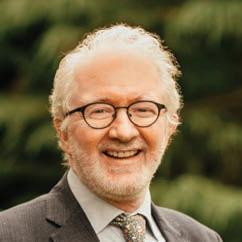
“It is a hard won Green measure and I am proud that [the] Government has supported its inclusion in the new water action plan.”
Minister of State at the Department of Housing, Local Government and Heritage for with responsibility for Nature, Heritage and Electoral Reform, Malcolm Noonan TD, on the reform of the Arterial Drainage Act 1945
The WAP objectives on flooding reform are that rivers should be able to flow in a natural cycle without artificial interference, with the objective of restoring natural ecosystems and enabling water infrastructure with increased investment, most notably wastewater treatment facilities. Funding is set to continue at current scales, with funding for Uisce Éireann coming to over €2.3 billion since 2020.
The new EU Nature Restoration Law allows for “the lateral flow of rivers” i.e. restoration of natural flood plains, as a key enabler of restoring climate resilience through restoration of natural ecosystems.
Ireland is experiencing a sustained decline in water quality, with half of the State’s rivers, one-third of lakes, and two-thirds of transitional waters classified as having ‘moderate’, ‘poor’, or ‘bad’ status.
The WAP includes removal of river-blocks preventing salmon and lamprey swimming upstream to spawn. These proposed changes are to be backed by new governance structures involving farmers, communities, NGOs, and industry.
The agricultural sustainability support and advice programme, known as ASSAP, and local authority-level water programme (LAWPRO) is
to be extended, and the EPA will publish an annual progress report on enhancing water status. Local authorities are to get more than 60 new enforcement staff to conduct 4,500 farm inspections annually.
On nitrates, it will include tighter controls on the timing and methods of fertiliser application and reduce amounts that can be spread on grassland. There will be a requirement to reduce “the maximum derogation stocking rate on farms where water quality is at risk” – ie curb livestock numbers.
Minister of State at the Department of Housing, Local Government and Heritage for with responsibility for Nature, Heritage and Electoral Reform Malcolm Noonan TD commented on the reform of the Arterial Drainage Act 1945: “We are serious about tackling flooding, restoring nature and improving water quality, that is why it is so important to review this out-of-date legislation and make it fit for the 21st century.
“It is a hard won Green measure and I am proud that [the] Government has supported its inclusion in the new water action plan.”
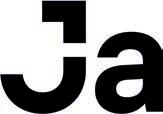



With water scarcity becoming an increasing problem on every continent, achieving Goal 6 of the UN sustainability development goals (SDGs) to ensure availability and sustainable management of water and sanitation for all is becoming increasingly critical, write Neil Delaney, Head of Strategic Water Programmes and Jillian Bolton, Regional Lead Water Ireland with Jacobs.
Public consumers expect that water will be available for their use while water utilities demonstrate improvements to our environment through sustainable abstractions combined with responsible treatment and release. To achieve SDG 6, the water sector must continue to meet these expectations while managing the increasing challenges and pressures on global water resources from population growth, economic development, and climate change.
The global water supply crisis is well documented, with media reporting shortages globally. Shortages in Cape Town, South Africa have been widely reported, however less widely reported shortages include southwestern USA where the Colorado River no longer discharges to the sea due to over abstraction and use.
Globally, water stress levels are predicted, up to 2050, by the World Resources Institute at a national level,
with ‘extremely high’ stress levels in areas of North and South Africa and parts of Asia, while Australia is tracking slightly more favourably with ‘high’ stress levels expected. Conversely, northern European countries predominantly track as having ‘low’ or ‘low to medium’ water stress levels in the same timeframe.
While the global view appears to demonstrate a positive national picture for countries such as Ireland and the United Kingdom, within each jurisdiction regional challenges are already arising driven by climate changes to weather patterns and increased population in focused areas. The 2018 drought in Ireland resulted in water supply restrictions in targeted locations due inpart to limitations on the connectivity of our water supplies.
Overreliance on a given water source can lead to challenges and ultimately limitations due to environmental impacts as the source is needed to supply a growing population or commercial use, be that industry or agriculture.
These factors all contribute to a growing sense of urgency to create more integrated, sustainable, and resilient water supplies even in those jurisdictions predicted to continue to have adequate water supply.
Achieving this will not be resolved through one factor alone and will require urgent measures to manage the supply demand balance, including leakage reduction, to ensure alignment with wider governmental climate action plans and goals, combined with the development of new supply options to mitigate against supply restrictions in the near future.
The challenges of achieving a sustainable economic level of leakage
(SELL) in countries like Ireland and the United Kingdom – with ageing infrastructure, growing urban populations, and dispersed rural settlements – are well documented. However, from a regulatory and moral imperative in the face of global water scarcity, the water sector needs to continue to progress and innovate towards this goal.
In addition, water consumption, whether at a personal or industry level, needs to become a priority for all, through national education, minimising our own personal use and the development and implementation – at sector and national levels – of reuse and recycling programmes in housing and high water usage industries. The Tuas Water Reclamation Plant based in Singapore shown in Figure 1, recycles water for further reuse.
For some industries, novel thinking will be required to ensure that the water required is fit for purpose; in some instances that may not be potable drinking water. For example, recycled effluent could be a suitable source for cooling waters.
Notwithstanding the achievement of longterm success in these areas, the delivery of new resilient supply options will continue to be necessary to meet the growing needs of our existing economies.
In England, a national review suggested that when considering population growth, environmental ambitions, and climate change, the southeast will be subject to water shortages by 2040. These projections included assumptions of a 50 per cent reduction in the current leakage levels and a reduction in the per capita consumption to 110 litres per person per day – the consumption target set by Ofwat (the Water Services Regulation Authority) for users across the country.
Allowing for that, a national programme to implement Strategic Resource Options (SROs) is proposed at a cost of approximately £17 billion. These options will store, transfer, and recycle water to provide resilience across the country. The need for which has been proven through regional and utility water management plans, which have been
Figure 2: Collaborative, outcome-focused, proportionate, and timely approach to delivery of DCO
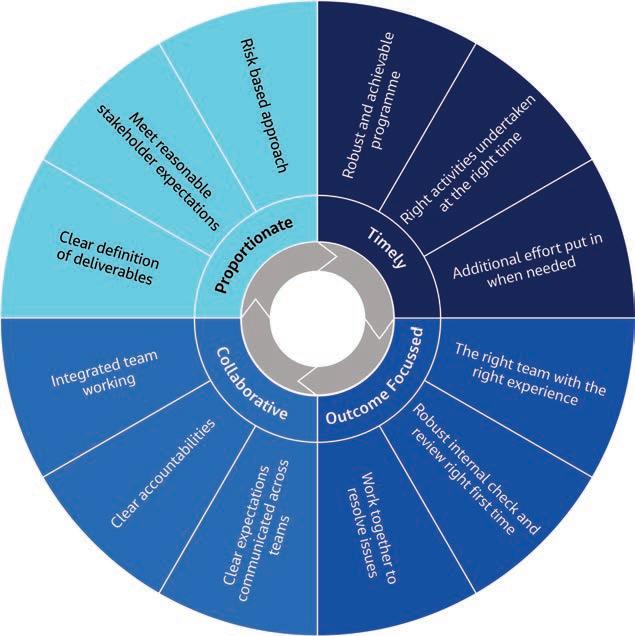
progressed through statutory and nonstatutory consultation processes.
The Regulators’ Alliance for Progressing Infrastructure Development (RAPID) was set up in 2019 to help accelerate the development of this new water infrastructure and design future regulatory frameworks for its operation. This regulatory body is made up of the three water regulators: Ofwat, the Environment Agency, and Drinking Water Inspectorate. They will provide a seamless regulatory interface, working with the water industry to promote the development of national water resources infrastructure that is in the best interests of water users and the environment. The goal is to ensure this infrastructure can be implemented in a timely manner to ensure resilient water supplies across the country.
These substantial projects will use the Development Consent Order process to achieve planning. This is similar to the
Strategic Infrastructure Development (SID) regulations in Ireland and elevates the planning decision to a national level. As with all planning processes, and key to the effective and timely delivery of critical public infrastructure, robust consultation is required to ensure that public input is incorporated into the ultimate decision making. In this regard, the process includes public consultations for each SRO submission and for the regulatory determinations for each project approval ‘gate’ as defined by RAPID. These consultation stages augment previous consultation on establishing the need for the projects, ensuring the public, statutory and nonstatutory consultees and interested parties are fully aware at all stages of the process, with their knowledge and inputs considered.
In addition, there is an acknowledgement that this infrastructure is larger in scale than anything undertaken in the UK water sector in the last 40 years. Therefore, a robust process must be undertaken given the scale of impact both to those who will be impacted by its
construction and operation and those who will be impacted if it is not provided. Figure 2 demonstrates the collaborative approach required to achieve success across major planning projects.
Figure 3 illustrates the scale of the UK Strategic Options (SRO) programme. Examples of these SROs in England include:
• the Southeast Strategic Reservoir Option, which will store 150Mm3 of water and cover a surface area of 6.5km2, at a cost of approximately £2.7 billion;
• the Severn to Thames Transfer, which will transfer water during times of drought from the River Severn (the largest river in the UK) 80km to the River Thames (the second largest River in the UK), with various water sources added to the Severn in times of low flow; and
• London Water Recycling, where effluent from existing wastewater treatment works would be treated through an advanced water recycling plant (AWRP) or a tertiary treatment plant (TTP) and discharged to the River Thames, where it can be abstracted as a raw water resource in times of low flow.
Figure 3: Representation of the UK Strategic Resource Options (SRO) Programme
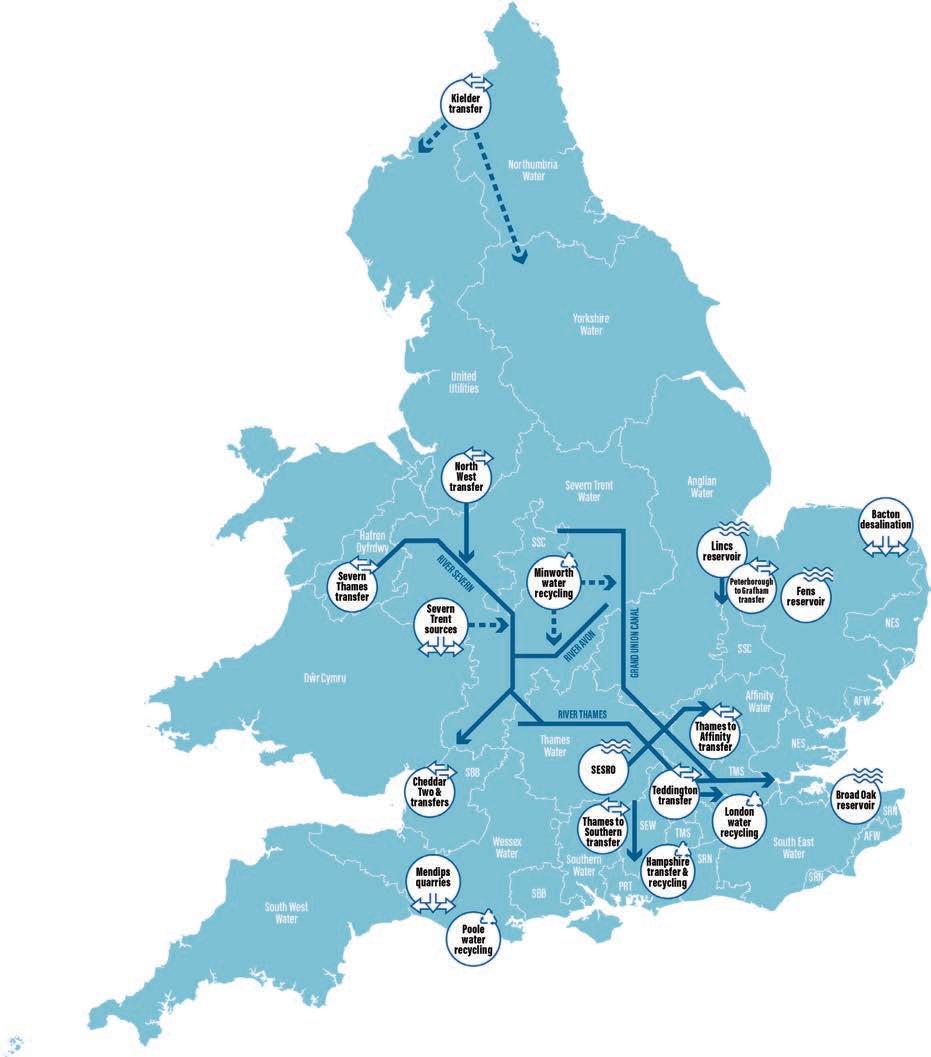
Singapore’s Public Utilities Board (PUB) is an example of where the development of recycling has been effectively implemented alongside a national education programme to make this a valued asset, providing national water supply resilience, and avoiding overreliance on international trade to
import water. Recycling programmes demonstrate sustainable and efficient use of the available water supply within a given jurisdiction.
The reality is that all water is reused as there is truly no new water on the planet. Organisations such as PUB have safely treated used water to augment their water supplies for decades. The technology is there; however the real challenge is developing a thoughtful way
“Many countries are now predicting a significant upturn in investment in water infrastructure over the coming decade.”
to implement potable reuse programs to meet public expectations.
PUB has also developed NEWater, its own brand of ultraclean, high-grade reclaimed water. Singapore has five NEWater plants which further purify treated, used water to produce this NEWater, which has passed more than 150,000 scientific tests and meets and surpasses World Health Organization and US Environmental Protection Agency standards for drinking water.
With the country’s water demand expected to double by 2060, Singapore is looking to use NEWater to meet more than half of this future water demand. Thanks to an integrated water management strategy nationwide, Singapore is one of just a few cities in the world to harvest its stormwater and practice large-scale water reuse as part of its diversified water supply approach.
Figure 1, shown previously, represents an animation of the Tuas Water Reclamation Plant (WRC) in Singapore, a key component of the Deep Tunnel Sewerage System (DTSS) Phase 2, which collects used water for further reclamation in NEWater
The provision of a resilient water supply is considered equal to a resilient power supply and strong transportation infrastructure and is therefore a key consideration for foreign direct investment when locating into a given country or region. In several countries, the funding for power and transportation has been strong over the past few decades, however, water and sanitation has not attracted the same level of investment. Globally, water investment has been insufficient and, as demands from users and regulators grow, there is a significant expenditure required to meet expectations. This will be a challenge to the water sector.
Many countries are now predicting a significant upturn in investment in water infrastructure over the coming decade, placing a strain on the sectoral supply chain to ensure that these aspirations are met. New procurement
models, new partnerships, and new thinking in how we implement water infrastructure will be required, alongside a change in our relationship with the water that we use on a daily basis. The latter will require national public campaigns to highlight water use ratings for various activities and products.
Financing and procurement are two of the most critical challenges within major projects globally. These two factors play an integral role in defining project success, especially long-term cost and risk. Funding and delivery models can help create the right cost structures and improve procurement results through competitive tenders or bids. For water utilities to develop resilient, sustainable major water infrastructure projects between 2025 and 2030, in addition to major standalone schemes, the industry requires effective procurement and delivery mechanisms. Delivery partners must build effective, multidisciplinary teams that use cross sector insights and global teams to drive productivity. The Direct Procurement for Customers (DPC) model in the United Kingdom, which is similar to Design Build Operate and Finance, offers a tailored solution and multiple client benefits, especially within the fast-growing water sector.
From a sustainability perspective, addressing our water consumption behaviours while continuing to drive down and maintain leakage rates require priority to minimise waste, costs and carbon generation. This approach, combined with the successful and timely delivery of national water storage, recycling, and transfer projects and programmes, will ensure countries with manageable water stress levels, like Ireland and the United Kingdom, can continue to meet the needs of their population, through the provision of safe, sustainable water supply nationally, meeting the requirements of SDG 6 while enabling long-term economic growth.
For more information:
T: +353 1 202 7718
E: Jillian.Bolton@Jacobs.com
W: www.jacobs.com



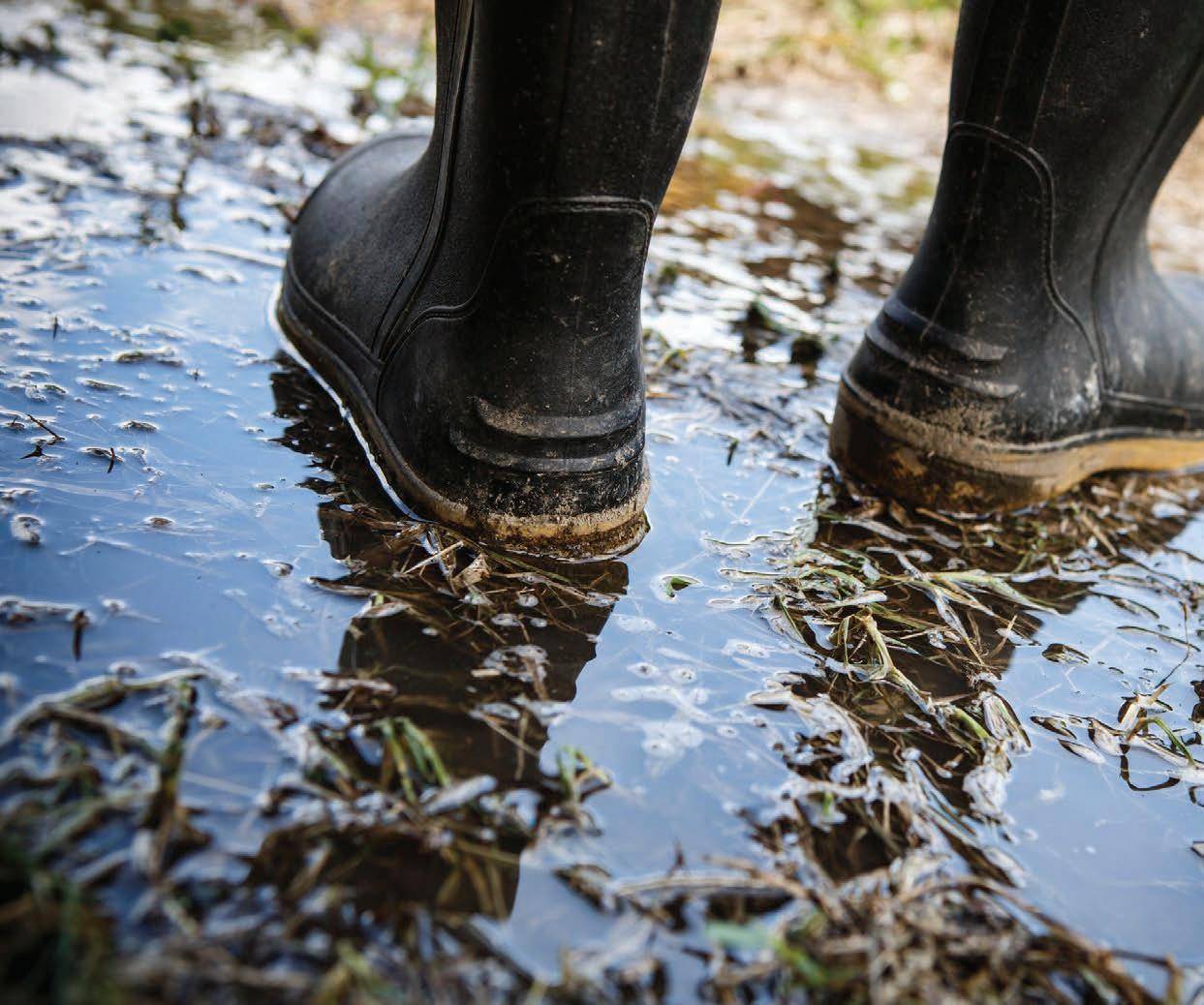

A payment scheme rewarding farmers for
high
water quality outcomes within their catchments should be established, researchers at the Economic and Social Research Institute (ESRI) have recommended.
The research paper, published by the ESRI in July 2024, outlines a proposal for future agrienvironment schemes to achieve good water quality status.
Authored by Wellington Osawe, John Curtis, and Cathal O’Donoghue of the ESRI, the research envisages payments to farmers within a catchment proportional to water quality outcomes within said catchment.
To facilitate this, environmental monitoring would be expanded to produce assessment reports for each catchment on an annual basis so that scheme payments reflect the most recent performance and facilitate flexibility in farming practices.
With a scheme that focuses on whole-of-catchment and payments based on catchment water quality, all agricultural land within a catchment would be covered by the scheme. As such, all farmers within
a catchment would share the results-based payment.
Rather than national limits, the ESRI recommends that all catchments should have bespoke nitrate and phosphate limits based on catchment assimilative capacity, i.e., catchment nitrates quotas. Trading quotas between farmers within catchments would facilitate the development of the most efficient or intensive farms without impinging on water quality.
The proposed scheme ultimately envisages payments to farmers within a catchment, proportional to water quality outcomes. As there would be a time lag before improvements in water quality are observable, payment could comprise three elements in a transition phase.
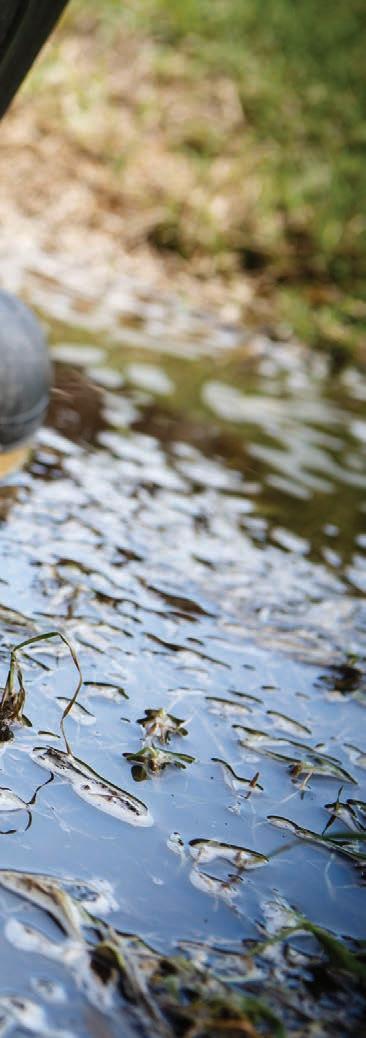
One element of the payment would be for water quality outcomes, a second element would cover costs related to modifying farming practices to transition to a lower nitrates operation, and a final element would encompass the more traditional input-based payment such as, for example, tree planting and field margins.
The researchers outline a framework comprising five key attributes that should be inherent to future agri-environment schemes. They are:
1. Results-based incentives: Payments for agri-environment services delivered by farmers should be results-based. Such an approach would align farmers’ incentives with scheme objectives. Historically, many schemes have compensated farmers for the provision of inputs such as tree planting rather than for environmental improvements such as water quality.
2. Area-based payments: Good environmental outcomes need to be delivered at scale, which means that good agricultural practice needs to occur across farms and catchments to enable a step-change in environmental outcomes. Consequentially, financial incentives would be implemented on a per-hectare basis where applicable to encourage participation.
3. Catchment-based: Environmental outcomes within water catchments depend on all activities occurring within the catchment, not just single farms. Therefore, agrienvironment scheme outcomes would be assessed at the catchment level in the case of water quality and not on a farm-by-farm basis. This approach ensures that environmental monitoring, outcomes, and agri-environment schemes align.
4. Simplicity: Rule books for agri-environment schemes are long and complex. A results-based scheme would facilitate a simpler rule book and less administration. If payment is ultimately based on environmental outcomes, how the outcomes are achieved is not pertinent, assuming no other adverse environmental externalities.
5. Flexibility: Historically, rule books for agri-environmental schemes were fixed and did not allow much flexibility. The ESRI believes that such schemes should be as adaptable as possible to changing conditions and knowledge such that they continue to incentivise participants to achieve the best environmental outcomes.
In the Environmental Protection Agency (EPA) Water Quality in Ireland 2023 report, published in June 2024, the EPA asserts that increased concentrations of nutrients, such as phosphorus and nitrogen, are impacting water quality and the biological health of water bodies.
“Human activities, such as agriculture, wastewater (domestic and urban), and forestry, are the primary cause of nutrient loss to our waters,” the EPA states.
The water quality report shows that longstanding water quality challenges persist, with 42 per cent of river sites nationally demonstrating unsatisfactory nitrate concentrations (above 8mg/l NO3). These elevations of nitrate levels primarily derive from agriculture through chemical and organic (manures and urine from livestock) fertilisers or from direct discharges from waste water.
In its conclusion, the EPA states that, as the main source of nitrogen in waterways is agriculture and the main source of phosphorus is agriculture and wastewater, these sectors must do more to reduce nutrient losses to water.
Concluding, the ESRI researchers assert that, in some respects, the framework for agrienvironment schemes proposed here is an “incremental evolution of previous schemes”. However, they also state that, in other respects, the proposals represent a “radical departure from current practice,” moving away from a largely inputs-focused farm-holding level scheme to one with a focus on catchment-level outcomes.
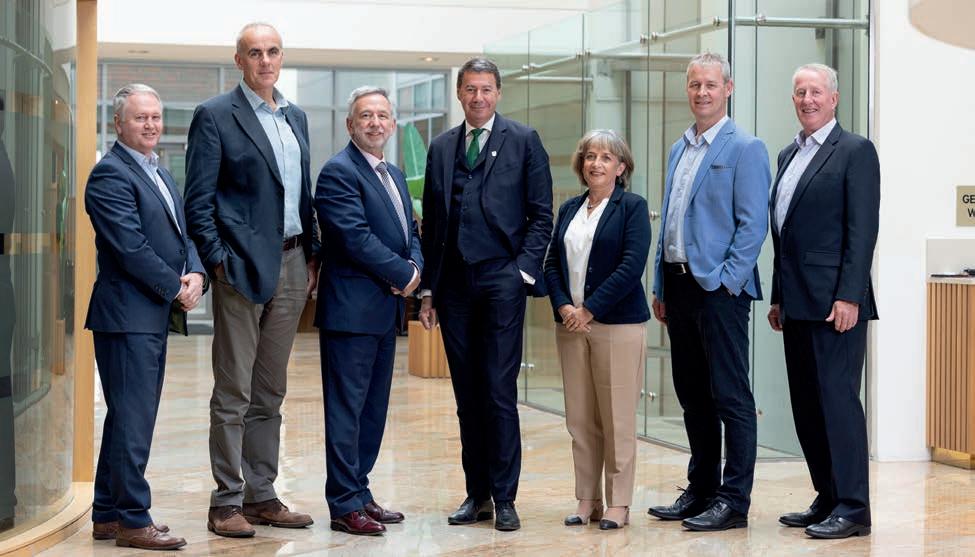
Today’s world demands that we achieve more with less; less space, less materials, and less waste, writes Anne-Marie Conibear, Egis’ Country Lead for Energy and Water.
This is certainly the case when it comes to water and energy. In responding to the urgent need to upgrade our infrastructure, we must aim to tread lightly – achieving more with less and making as much use as possible of existing structures with new technologies. It is critical that we deliver the infrastructure needed to meet the demands of our growing population, but we must also reduce infrastructure emissions at all stages from green procurement, lean design, and ecoconstruction, to operation and end-of-life disposal.
At Egis, we refer to this requirement as the paradox of the 21st century and for us the solution lies in innovation. This is why we have enshrined creativity as one of our core values; fostering a spirit of innovation in our areas of technical expertise, our methods, and our development of new services and business models.
In our experience, innovation involves the development of both creative solutions which break the status quo, in addition to improving what already exists. It is an approach that can, and has, yielded extraordinary results.
Ringsend Wastewater Treatment Plant is the largest facility of its kind in Ireland with a capacity that equates to that of the next nine largest plants combined. Working as part of the 3JV consortium, with TJ O’Connor & Associates and Royal Haskoning DHV, we are providing civil, structural, process, mechanical and electrical and project architect design services for an ongoing upgrade of the plant.
The Works will increase the plant’s treatment capacity from a 1.64 million population equivalent (PE) to 2.4 million by 2026 and are required to reduce nutrients in the treated effluent before discharge to an area that is designated as sensitive under the Urban Wastewater Treatment Directive.
The project’s setting presents constraints as it is located on a confined site that is bordered by sea and by a nature reserve. The plant must also remain operational throughout the construction period.
While a conventional approach would involve increasing the site envelope to
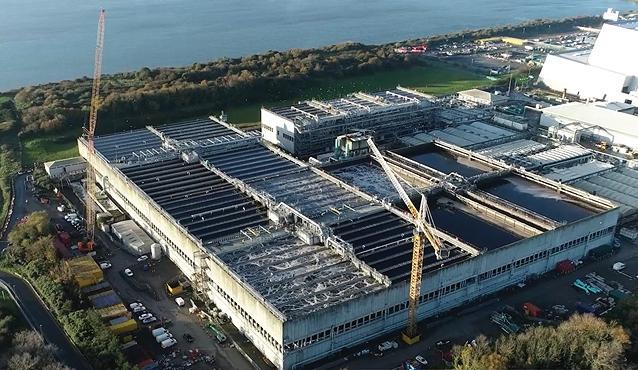
accommodate the required standalone secondary treatment WWTP structure, our engineering team explored multiple solutions to provide the capacity upgrade.
This process involved the application of eco-design principles; reducing the ecological and physical footprint required to treat the increased load while increasing the energy efficiency of the upgraded plant. The team’s preferred solution was to utilise the Royal HaskoningDHV patented Nereda® Aerobic Granular Sludge (AGS) technology for the plant upgrades. This allowed for increased biological treatment capacity within the same footprint as a conventional activated sludge treatment plant.
The construction of a new standalone 400,000 PE treatment plant and retrofitting some of the existing Sequencing Batch Reactors (SBRs) with AGS technology has resulted in an increase in capacity without the need to construct significant additional tankage or a 9km long sea outfall. This has delivered a major reduction in the embodied carbon for the entire project.
The 400,000 PE construction contract received a Civil Engineering Excellence Award by the Association of Consulting Engineers of Ireland.
Further upgrades have included the installation of a p-fixation facility, the first of its kind in Ireland. This innovative technology created a circular economy where phosphorus – a dwindling valuable resource – can be extracted from sludge as struvite and used as agricultural fertiliser.
The application of Ephyra®, an innovative sludge digestion technology from Royal Haskoning DHV, means the upgraded plant can optimise anaerobic digester performance within the sludge line, effectively managing an increased load resulting from the plant upgrade and expansion.
Existing digester tanks are being retrofitted to increase their capacity in a process that will also allow production of sustainable energy in the form of biogas. The upgrade has eliminated the need to construct new tanks and the biogas is used to generate electricity and heat required on site – further reducing the plant’s carbon footprint.
In innovation, the solution sometimes lies in reframing the question. Working in close partnership with clients, we support as consultants by refining our brief. By surveying the landscape, exploring solutions, and engaging with colleagues and suppliers internationally, we have discovered better solutions that begin with clarifying the client’s needs and aspirations.
We also innovate by adapting technology in a ‘trickle down’ effect, optimising and applying solutions primed in larger projects for use on smaller-scale ones. For example, the Nereda® technology mentioned earlier has been used to allow energy recovery through biogas capture in smaller wastewater treatment facilities for Uisce Éireann all around Ireland. At a Regional Sludge Hub in Ireland we further maximised the yield from biogas using a thermal hydrolysis process –
high temperature and pressure – to create an energy-neutral site.
Our ability to innovate locally is guided by global experience. Our innovation hub nurtures start-up technologies creating use cases for deployment by our engineers globally.
In Qatar, for example, we have created seasonal storage lagoons for recycled water. In France and the Carribbean, we have used nature-based solutions in the form of 3D printed structures inspired by the living world to create a habitat for biodiversity along the coastline. Vigie Risk is a new real-time flood risk hypervisor designed to strengthen infrastructure resilience, and SustainEcho is a platform that uses AI to calculate the carbon footprint of our projects from the raw bills of quantities.
Innovation is in our DNA and we use it daily to respond with passion and determination to the major challenges of our time; climate change, biodiversity degradation, demographic growth, and rapid urbanisation – all of which demand creativity, innovation, and vigour.
W: www.egis-group.com

A new nature-based strategy aiming to prevent flooding emanating from rainwater in urban areas has been introduced by the Department of Housing, Local Government and Heritage (DHLGH).
Published in May 2024, Nature Based Management of Urban Rainwater and Urban Surface Water Discharges: A National Strategy, rationalises how nature-based rainwater solutions can be implemented in urban areas.
The strategy states that the best approach is to seek to replicate the capacity of greenfield areas to absorb, store, and treat rainwater, insofar as possible, drawing on numerous examples of use that has been adopted across the world. This is an approach whereby urban areas that would, traditionally, have been dominated by paved areas incorporate specially designed landscaped areas into which urban rainwater runoff is directed.
Various terms are used to describe this approach, including water sensitive urban design, ‘sponge city’, nature-based sustainable urban drainage, or urban nature-based solutions.

These landscaped areas are primarily designed to take in, store, and treat urban runoff and to then discharge the treated runoff at a slower rate back into the existing urban drainage network. While the design will allow excess flows to bypass the landscaped areas and flow directly into the existing drainage network, the landscaped areas will have removed most of the pollutants which are contained within the “first flush” of runoff from the paved landscape.
Reducing the percentage of impermeable surfacing and increasing the area of urban landscaping result in multiple benefits in addition to the reduction in rainfall induced flood risk and runoff pollution. These benefits include reduced “heat island” effect and urban noise, a more pleasant urban

environment that supports active and sustainable transport modes and increased biodiversity.
Ideally the integration of nature-based rainwater management will form part of the broader approach to urban development across the settlement.
Traditionally, urban areas have been designed so that rainwater is directed from buildings and impermeable surfaces into collections points (gullies) and from there into an underground network of pipes, ultimately discharging into local rivers and streams.
Analysis of European flooding records between 1960 and 2010 suggests that there has been increased flooding in the autumn and winter periods from rainfall throughout the northwest of Europe, including Ireland.
The strategy outlines how in urban areas, a large proportion of the surface area is made up of hard surfaces which are impermeable, meaning that all rainwater falling on that area remains on the surface and must be managed by an urban drainage or rainwater management system.
With the resulting polluted rainwater, which comprises flooding –water which cannot be contained by existing drain infrastructure –leads to increased pollution in two ways:
1. rainwater falling on many urban surfaces such as roads, streets, and roofs will become contaminated by a wide range of pollutants before entering the drainage system and being discharged into receiving waters; and
2. in many older urban areas, the drainage system is combined and, therefore, rainwater runoff is mixed with sewage and wastewater. As rainfall increases beyond the sewer capacity, these systems overflow into local waterbodies, with resultant pollution.
Although existing infrastructure is arguably incapable of meeting demand, the strategy concludes that it is “neither practical nor sustainable” to simply replace all existing urban drainage networks with larger pipes. Simultaneously, it is not possible to stop rainwater falling onto urban areas; indeed increasing intensities are likely.
At the same time, there are two established trends that, taken together, mean that the traditional approach to urban design is not sustainable. These are:
1. the continuing growth in urban population; and
2. the changes in climate that have already happened and will continue to happen, with predicted increases in rainfall intensity and longer periods of summer drought with high temperatures.
As such, nature-based solutions, the DHLGH asserts, offer a sustainable alternative. Writing for eolas Magazine, Minister of State at the Department of Housing, Local Government and Heritage with responsibility for Nature, Heritage and Electoral Reform, Malcolm Noonan TD, observes: “Not only can naturebased solutions provide attractive features and focal points within the landscape, they can also provide significant ecological value.
“Designed to manage rainwater, they slow and store runoff and allow it to soak into the ground. Their benefits are wide-ranging, filtering out pollutants that would otherwise end up in our waters, reducing flooding and easing the burden on combined sewer systems.”
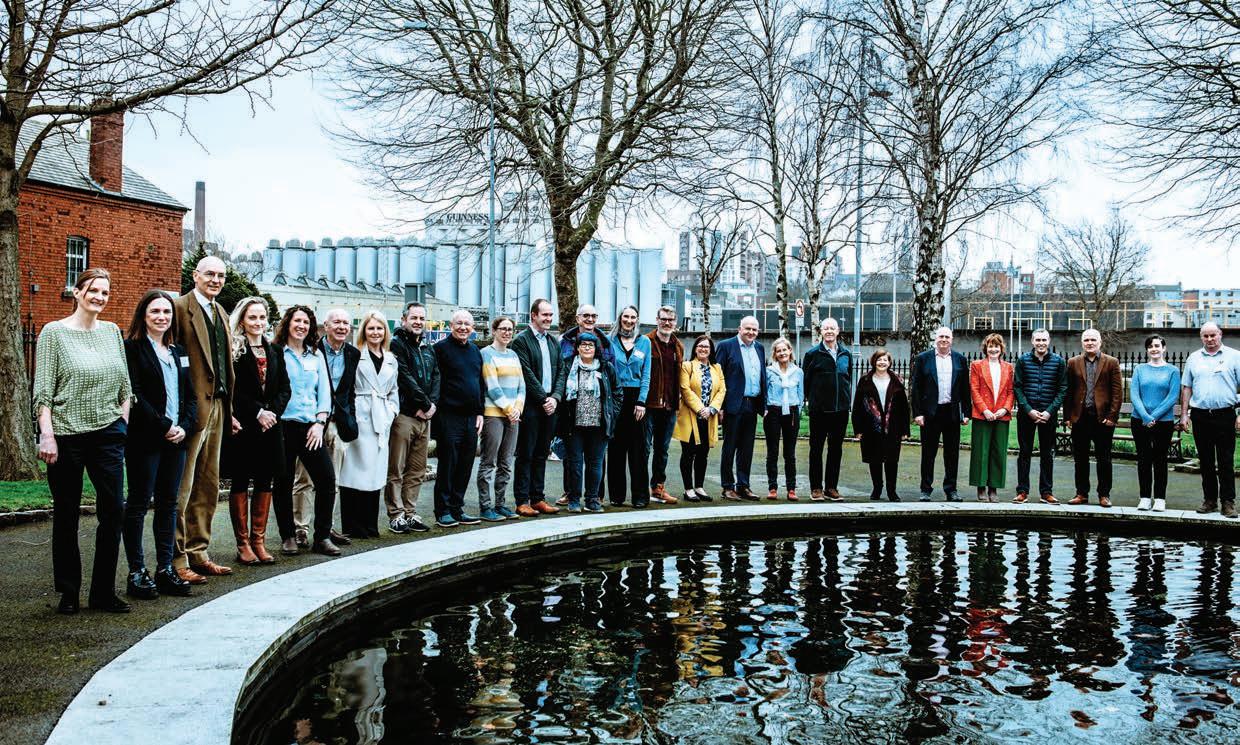
A national survey commissioned by The Water Forum (An Fóram Uisce) finds the public are not knowledgeable about water resources.
The Water Forum provides a platform for stakeholder engagement on water policies and the management of Ireland’s waters. Members of the Forum represent 16 different sectors bringing diverse opinions, perspectives, and interests to water management issues. Sectors include agricultural organisations, angling, business, community and voluntary groups, domestic water consumers, education, environmental NGOs, fisheries, forestry, recreation, rivers trusts, rural water, social housing, tourism, trade unions and youth.
In February 2024, 14 new members were appointed to the Forum, to join 13 existing members who have been reappointed for a second term. All members of the Forum are nominated by their representative organisations and appointed by the Minister for
Housing, Local Government and Heritage, Minister Darragh O’Brien TD. This wide range of representation provides an opportunity to input different values and outlooks to policy development for water management and the implementation of the Water Framework Directive. The Forum’s statutory role is to provide advice to the Minister of Housing, Local Government and Heritage, Uisce Éireann, the Commission for Regulation of Utilities (CRU), and the Water Policy Advisory Committee.
A goal of the Water Forum’s Strategic Plan is to promote awareness and education on the value of and threats to water. To inform this action, the Forum commissioned a national survey of water consumers (Uisce Éireann customers, Group Water Scheme customers and private well owners) to
determine their:
1. knowledge of water supply, quality and security;
2. satisfaction with supplier communications; and
3. water conservation awareness. The survey was hosted online by Interactions Research Ltd. The national sample consisted of 1,518 adults, recruited as a demographically representative sample of the population in terms of gender, age, region, and social background and the survey was completed in August 2023. Of those surveyed, 81 per cent were connected to a public water supply provided by Uisce Éireann, 12 per cent were connected to Group Water Schemes and 4 per cent sourced their water supply from private wells.

54 per cent of public water consumers lack knowledge of where their water comes from or how it is treated and 26 per cent do not know who to call if there is a problem. Those connected to private Group Water Schemes showed markedly higher knowledge on local water sources, indicative of a better connection to local water supplies. People surveyed also showed significant confusion over potential future water quality and security challenges.
Just over half of Uisce Éireann consumers were satisfied with drinking water quality, despite the EPA consistently reporting very high standards in public water supplies. 10 per cent of people in Ireland get water from private wells, yet only one-quarter of private well owners test their wells annually as recommended by the EPA. This leaves them at risk of water quality issues in their water supply.
Water conservation is considered important by consumers with 74 per cent of those surveyed agreeing that we need to improve water conservation. However, they do not know how much water they use or how to conserve water in their homes and stated that more information would be helpful.
To address the knowledge gap and develop a water smart society that truly values Ireland’s water resources we need:
• a public information campaign to build knowledge of water treatment and supply processes, how wastewater is treated, and the potential threats to drinking water security and supply;
• strengthened Uisce Éireann customer engagement and communications to improve public trust in drinking water supplies, to make sure people know who to contact if there is an issue and ideally to let people know how much water they are using;
• a significant intervention to inform private well owners about well maintenance, and the need to regularly test their water quality to prevent risk to supplies; and
• enhanced awareness around how to increase water efficiency in the home, to take advantage of the strong support for water conservation.
The Water Forum has presented the findings to Uisce Éireann and shared the reports with Uisce Éireann and the Department of Housing Local Government and Heritage. We have commissioned further research on private wells to find out what further action can be taken to reduce risk to private water consumers. We have commissioned a cost-benefit analysis of water efficiency measures in the home. This work is all ongoing.
The Water Forum commissioned Maigue Rivers Trust and Mary Immaculate College to develop education materials on: (1) Water habitats and biodiversity; (2) Water quality and pollution; (3) Exploring rivers using digital maps; and (4) Impacts of our water use. While
targeted at schools the resources are suitable for all ages. Teaching materials and student workbooks are available for download from the Water Forum website.
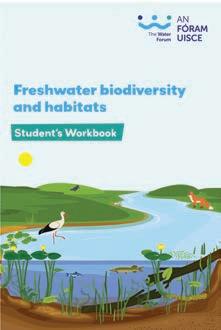

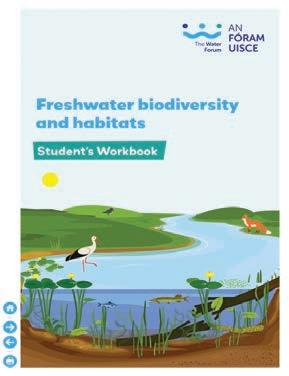

To share information on encourage dialogue, the Water Forum is hosting a conference to discuss the impacts of climate change on water quality and quantity. Agencies will be invited to discuss the challenges and opportunities of taking a catchment-based approach to addressing climate adaptation for floods and droughts. Academics, agencies, and stakeholders will contribute to panel discussions and deliberations. The Conference will be held in the Tullamore Court Hotel, County Offaly on 20 November 2024.
For more information: E: info@nationalwaterforum.ie W: www.thewaterforum.ie



Bathing water quality for 2023 remains high, with 97 per cent of assessed bathing waters having met or exceeded the minimum required standard. However, the number of pollution incidents and water bodies with of a ‘poor’ standard both increased in 2023.
In 2023, of the 148 identified bathing waters assessed, 143 (97 per cent) met or exceeded the minimum required standard of sufficient. 114 bathing waters (77 per cent) were of excellent quality, a decrease from 117 (79 per cent) in 2022.
The majority of bathing waters have excellent or good quality:
• 97 per cent of the 148 identified bathing waters met or exceeded the minimum required standard.
• 114 bathing waters (77 per cent) were excellent quality, a slight decrease from 117 for 2022.
• Five bathing waters were poor (up two from 2022) and the Environmental Protection Agency (EPA) has confirmed these will have a swimming restriction for the 2024 season. These were Lady’s Bay, Buncrana; Trá na mBan, An Spidéal, Balbriggan (Front Strand Beach); Loughshinny Beach; and Sandymount Strand.
• One bathing water – Aillebrack/Silverhill Beach, County Galway – was classified for the first time with excellent quality.
Urban wastewater was most frequently reported as the likely cause of incidents in 2023. Other reported causes included agricultural runoff, and pollution entering the surface water collection system through misconnections or runoff from urban areas.
Heavy rainfall can result in wastewater overflows and in runoff from agricultural lands and urban areas, which can cause short-term deterioration in water quality. Record rainfall levels in July and storms in August led to more bathing water warnings in 2023 than previous years.
In 2023, the EPA was notified of 45 pollution incidents which resulted in the closure of bathing waters, up from 34 in 2022. The majority were due to the presence of pollution in sample results (29 incidents). Bathing waters were also closed as a precaution after overflows in the sewer network (12 incidents) and due to algal blooms (four incidents).
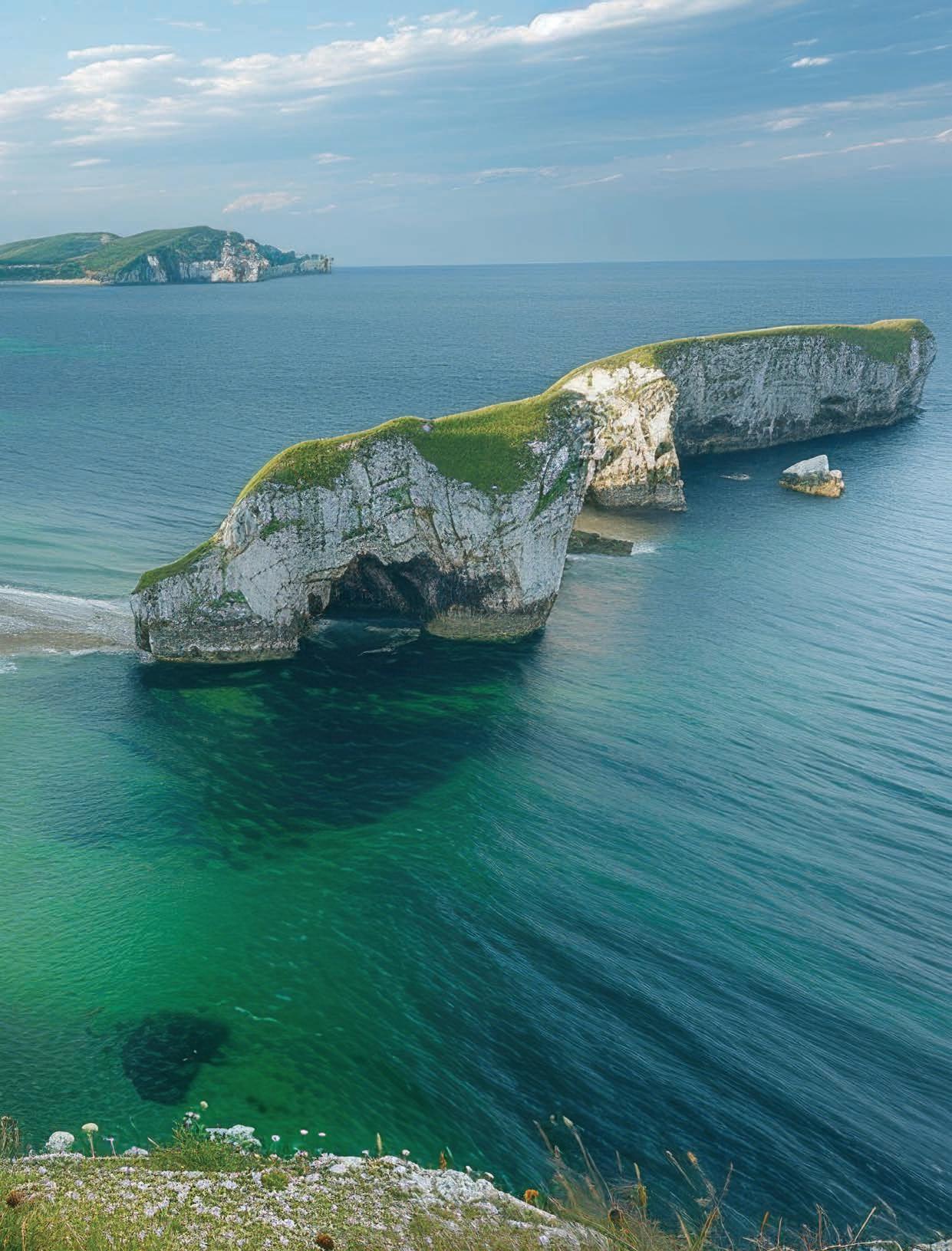
Urban wastewater
Misconnections/runoff from urban areas
Proliferation of cyanobacteria/macroalgae Diffuse pollution from agriculture
Contamination from animals/birds Septic tanks
Maria O’Dwyer, Uisce Éireann’s Infrastructure Delivery Director.
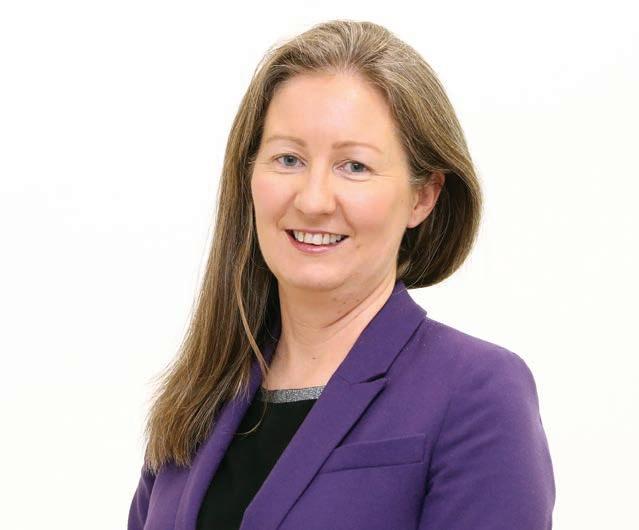
With over 25 years of industry experience, Maria O’Dwyer is taking on the role as Uisce Éireann’s Infrastructure Delivery Director with a steadfast focus on delivering transformative water services that enable communities to thrive.
Looking back on almost a decade with Uisce Éireann, Maria O’Dwyer reflects on the critical infrastructure delivered to date, including the 180 water and wastewater treatment plants which have been built and upgraded across Ireland.
Whilst proud of the achievements to date, O’Dwyer knows that this is a multigenerational project built on the legacy of the asset base Uisce Éireann inherited. Now, as she takes on her new role as Uisce Éireann’s Infrastructure Delivery Director, it is her job to “continue to deliver an effective and efficient capital investment programme in a safe way.”
But the task is much broader than that.
“We are always seeking out new solutions to transform how we deliver that programme, leveraging innovation and sustainability, working in collaboration with all stakeholders, challenging ourselves, our team, and our delivery partners so we can do more for the communities we serve,” she says.
Every day there are challenges across the country but the commitment and dedication of the Uisce Éireann team
keeps everyone focused on the task ahead.
“It is going to take time to overcome all these challenges, but it is reassuring to see large projects like the Arklow Wastewater Treatment Plant, which is close to completion, come to fruition. It is brilliant to be able to bring that type of investment, €139 million, to a large town like Arklow so it can thrive and develop in ways it could never before due to the absence of functioning wastewater services.”
With a €5.35 billion investment from 2020 to 2024, Uisce Éireann is driving improvements in water services infrastructure. A significant increase in spending for 2025 to 2029 will be needed to continue meeting the levels of demand for water services from both customers and regulators.
“Progress is happening albeit it is not possible to do so at the same pace in every town and village across Ireland,”
O’Dwyer says, adding: “We are prioritising bringing water and wastewater infrastructure up to standard, with the
safe delivery of our capital investment plan central to everything. Our greatest challenge lies in securing the sustained multiannual funding we need to continue upgrading infrastructure where it is needed most and ensuring that we can achieve our objectives now and into the future ensuring communities can thrive”.
Seeking out innovative sustainable solutions to long-term challenges is also a key focus.
“Much of our capital investment results in carbon and construction delivery can impact on the natural environment and biodiversity. Delivering our capital investment plan in a sustainable way, utilising energy efficient design and nature-based solutions where possible can result in more sustainable long-term solutions such as in Boherbue, County Cork.”
Water Supply Project (WSP): “It is critical to securing Ireland’s economic growth and housing needs for the future”
Growing up in Cashel, the Tipperary native is well placed to outline the benefits of one of the largest infrastructure projects in the history of the State. It will create a water spine across the country and ensure an urban level of service to towns and villages from her native county through the midlands, the counties of Offaly and Westmeath before reinforcing existing supplies in counties Kildare, Dublin, Wicklow, and Louth.
Uisce Éireann predicts that by 2044, 34
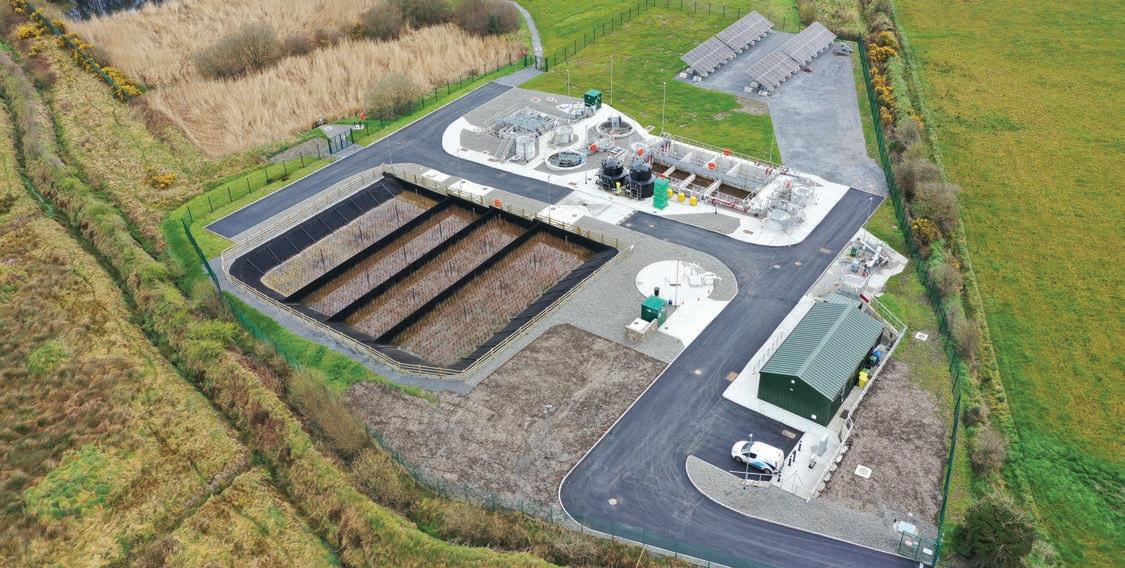
per cent more water will be needed in the Eastern and Midlands region than is available today.
“The WSP is fundamental to the State to ensure sustainable resilient water supplies for half of the population up to 2050 and beyond. We must remember that we are a small country and if we want to thrive as a nation, we need that 50 per cent to have sustainable and resilient water services.
“A significant portion of the country (1.75 million people) is dependent on a single river source (the River Liffey is only the 19th largest river in Ireland); for the resilience of the water supply and the ecology of the River Liffey, we need a new diverse supply coming into the East.
“Some critics have questioned why Dublin should benefit in terms of investment but as a national utility, we are investing in every part of the country. In fact, most of that investment to date has been outside the Greater Dublin Area with the WSP to benefit areas along the route of the new pipeline,” Infrastructure Delivery Director asserts.
Growing up in her family’s shop in Cashel, O’Dwyer has known the importance of communication and customer service; this has been honed across her many years of industry experience working in national regulated utilities (O’Dwyer worked with Gas Networks Ireland for 11 years before joining Uisce Éireann).
In August 2024, Uisce Éireann launched a new text message system to keep householders, businesses and key
stakeholders informed about planned and unplanned outages and boil water notices in their area with timely updates on status.
“Carrying out essential maintenance and transformation of our infrastructure can impact on service availability. This outbound notification service will be key to keeping our customers informed and building trust and confidence in the organisation,” she notes.
Knowledge is key: “We must continue to invest in our people and our collective knowledge.”
It is important for Uisce Éireann to develop the required knowledge and capability within the organisation but also within its delivery partners.
“Funding is our first constraint and capacity our next and by that, I mean capability within the supply chain. It is vital that water services as a sector continues to attract people with the correct skills and expertise.
“Treated drinking water is like a food product – its availability was not fully appreciated in the past but now with climate change and system constraints, along with much higher standards and regulations, increased investment is needed to be able to provide the service our customers deserve.
“It is critical that we work to find more innovative and sustainable solutions to deliver this critical service. Ultimately that will be the key to transforming water services long term,” O’Dwyer outlines.
Safety first: “Our priority focus is to keep each other safe.”
While delivering projects across the country is key, safety comes first for the Infrastructure Delivery Director. As recently as August 2024, she launched a new website for employees and contractors as part of the organisation’s Am I Safe? campaign.
“In Infrastructure Delivery, we want to ensure the contractors who work at our construction sites and operational plants work safely and go home safely each day. The Am I Safe? campaign is one of several initiatives that support this goal.”
In her new role O’Dwyer is looking forward to the opportunities ahead as the organisation assumes full responsibility for public water services from all 31 local authorities. “Working in Uisce Éireann is a privilege and our diverse team has a clear purpose. Water services are critical, and we get to contribute to delivering transformative water services that enable communities to thrive,” she concludes.
W: www.water.ie
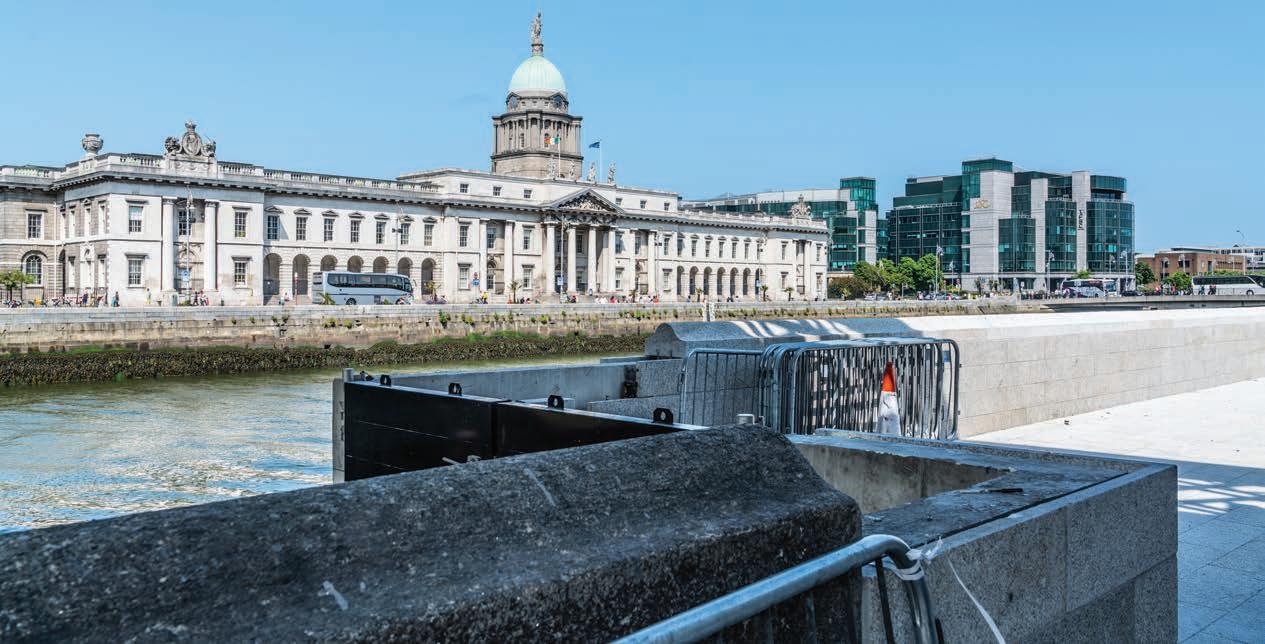

On an annual basis, the Climate Change Advisory Council (CCAC) publishes a sectoral Adaptation Scorecard. Among the priority policy sectors included are flood risk management, under the remit of the OPW, and water quality and water services infrastructure, under the remit of Department of Housing, Local Government and Heritage (DHLGH). In 2023, the former achieved an overall progress rating of ‘good’ while the later was rated ‘moderate’.
Sectoral Adaptation Plans or SAPs are mandated under sections 6 and 7 of the Climate Act and were developed as a core action under National Adaptation Framework (NAF) 2018. In an effort to provide a structured approach to sectoral climate change adaptation, under NAF 2018, 12 priority policy sectors were grouped into nine SAPs and clustered under four themes.
Three of the priority sectors – flood risk management; water quality; and water services infrastructure – were grouped under the water resource and flood risk management theme.
Assessing the progress of SAPs – and local adaptation strategies – and monitoring implementation of the NAF, the CCAC publishes an annual sectoral Adaptation Scorecard. Alongside local government and DECC, priority sectors are assessed against three key adaptation themes (via a questionnaire developed by the CCAC):
1. risk, prioritisation, and adaptative capacity;
2. resourcing and mainstreaming; and
3. governance, coordination, and cross cutting issues.
Given the shared challenge of inadequate financial resourcing and staffing capacity, the second theme –resourcing and mainstreaming –continues to be a pervasive challenge across sectors.
According to a summary of observed and projected climate changes and impacts for Ireland contained within NAF 2024, in Ireland, observed annual precipitation has increased by 6 per cent from 1989 to 2018 when compared with 1961 to 1990, with evidence indicating a tend toward increased winter rainfall and decreased summer rainfall.
Further projections suggest that there could be a substantial decrease (of between 0 to 17 per cent) in precipitation in summer months. By mid-century, it is predicted that Ireland’s precipitation climate will become more variable, with significant increases in the frequency
and intensity of both dry periods and extreme precipitation events.
As a consequence of decreased summer precipitation, drought could increase in frequency, resulting in water stress for soil and livestock, while more extreme precipitation events could then lead to more frequent and intensive pluvial (overland flow) and fluvial (flow from rivers and streams) flooding.
In the water quality and water services sector, there are two main potential impacts of climate change:
1. projected increases in average temperatures and an increase in invasive species could undermine habitats and reduced water quality; and
2. the projected increase in droughts allied to higher evapotranspiration rates could reduce river flow, groundwater recharge, and reservoir refill capacity, ultimately contributing to water supply shortages. At the
same time, increased precipitation could increase pollutant concentrations (especially nutrients) in water bodies, leading to eutrophication and algal bloom.
Meanwhile, in flood risk management, there are several potential impacts of climate change, including:
1. projected increased storm intensity, extreme precipitation events, and rising sea levels could result in a higher frequency of extensive flooding;
2. many existing flood relief schemes requiring reappraisal in the absence of climate adaptation provisions;
3. saturated agricultural lands impacting drainage schemes;
4. rising sea levels and extreme precipitation damaging embankments in estuarine areas, increasing exposure to coastal flooding; and
5. inhibiting access to hydrometric stations.
In its July 2023 Third Climate Change Adaptation Scorecard Final Report, the Climate Change Advisory Council published sectoral adaptation scorecard results for both flood risk management (under the remit of the OPW) and water quality and water services infrastructure (under the remit of DHLGH). The scorecard is a summary of progress on national climate adaptation in 2022.
Overall, the adaptation plan for the water quality and water services infrastructure sectors is to assess significant future climate risk and outline the available adaptative measure to establish a climate resilient water sector. These measures, developed by stakeholders engaged in future adaptation planning, include:
• adopting an ‘integrated catchment management’ approach;
• enhancing water services infrastructure via treatment capacity and network functions;
• water resource planning and conservation (in both supply and demand); and
• incorporating climate actions into monitoring programmes and research.
In the CCAC’s assessment, the water
quality and water services infrastructure sectors have made progress in establishing climate resilience through collaborative measures, including a nature-based solutions pilot project incorporating DHLGH, Cork City Council, and Dublin City Council to manage urban run-off challenges.
However, from a CCAC perspective, the sector must improve its systematic coordination with the SAP to ensure that solutions are implemented at catchment scale, thereby unlocking mutual benefit for water quality, biodiversity, and climate resilience. This, it suggests, could be delivered by the project delivery office being formed under the new River Basin Management Plan.
Meanwhile, key challenges include a failure to make significant progress towards understanding climate change impacts and developing the necessary solutions across the sector. Allied to this is an absence of detailed monitoring of SAP implementation, specific information on the effectiveness of coordination structures for this implementation, and evidence of adaptation being mainstreamed across government departments, local authorities, and relevant agencies.
Two plans – either developed or under development – which contain climate resilience aspects across the water quality and water services infrastructure sectors are:
1. the Fifth Nitrates Action Programme (2022-2025) which is intended to prevent pollution with agriculture origins and improve water quality; and
2. the National Water Resources Plan (developed by Uisce Éireann) which will outline Ireland’s move towards “a safe, secure, reliable and sustainable water supply” over the next 25 years, including via smarter supply and demand reduction.
The CCAC assesses that the OPW has strong internal structures to cohesively plan, implement, and monitor the flood risk management sector SAP, as well as wider adaptation actions. It also reports that effective cross-sectoral working relationships and leadership buy-in have been established.
However, with the OPW seeking to mainstream adaptation into policy –including integrating future flood risk in economic appraisal guidance and
embedding climate change consideration and adaptation requirements in the design of existing and new flood relief schemes – staffing remains a challenge.
As such, while training is being undertaken, given existing and forthcoming strategies and programmes, the CCAC has recommended that dedicated adaptation staffing be expanded with the OPW.
The CCAC also recommends the provision of a “greater demonstration” of the impacts of flood relief work undertaken by the OPW, suggesting that those most vulnerable to flooding are consulted.
As such, overcoming barriers to adaptation in water-related sectors remains a challenge. These barriers include insufficient resourcing and inadequate understanding of vulnerability to the risks and impacts of climate change.
Concluding, the CCAC’s Adaptation Scorecard identifies the pursuit of “string internal governance structures and leadership buy-in” as being key enablers for the sectors. It also suggests that the establishment of steering groups and coordination structures to be “crucial” for the implementation and monitoring of the SAPs. Finally, it advocates for enhanced community, NGO, and private sector participation in adaptation planning and implementation.
Under NAF 2024, which establishes Ireland’s updated climate adaptation policy and was approved and published by government in June 2024, 13 priority sectors (under the remit of seven lead government departments) are required to develop new SAPs in response to the potentially negative impacts and positive impacts of climate change. These SAPs must be completed and submitted for government approval by 30 September 2025.
Furthermore in NAF 2024, the ‘water quality and water services infrastructure’ policy sector for adaptation has been rebranded as the ‘water management’ sector.

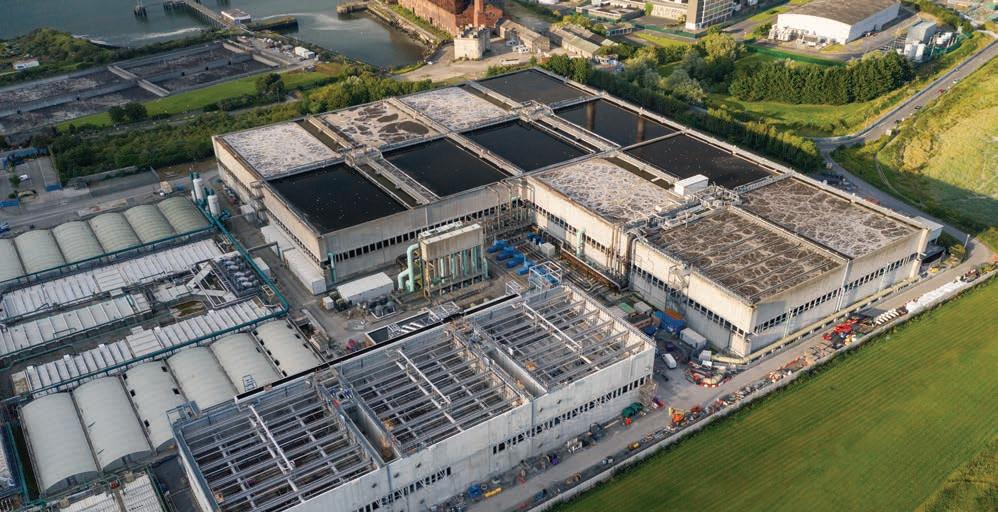
The asset base within water utilities is vast and ageing, with most of the infrastructure being underground, whilst also being challenged by external factors such as climate change and population growth. John Carty, Account Director (Utilities) with OutForm Consulting, writes.
Simultaneously, water utilities face funding challenges, increasing customer and stakeholder expectations, and the fundamental requirement of meeting regulatory compliance. The need to effectively manage their asset base in order to deliver value in achieving the organisation’s objectives has never been more keenly felt.
The scale of these challenges mean that water utilities have to ensure that their
assets are resilient, and they are planning to meet short-, medium- and long-term needs. Asset management means managing the infrastructure, reducing cost of ownership, whilst also delivering the levels of service that are being demanded by customers and stakeholders alike.
A key objective for water utilities like Uisce Éireann is ensuring service and environmental performance is enhanced, while also meeting the stresses placed on its infrastructure through extreme weather, demand for water, and population growth. It is vital that any


historic under-investment is addressed, but in doing so the cost of maintaining and improving assets is being fairly split between current and future generations, without undue risks being undertaken that could impact resilience and sustainability.
Asset management is about managing activities across a water utility to deliver value from the assets it owns. This means adopting a systematic approach to planning, operating, maintaining, and renewing infrastructure across key capability groups, such as asset inventory and analytical insights, strategy and planning, condition and performance assessment, risk management, investment planning, and objective decision-making across the end-to-end asset lifecycle.
As highlighted, the challenges faced by water utilities have evolved from centring
around cost reduction, which may traditionally have been seen as one of the key benefits of asset management. The reality is that although there are operating and capital efficiencies to be gained, there are also many other benefits which have grown in importance in the way that a modern water utility operates today, four key areas highlighted below.
1. Standardisation: Asset management is helping water utilities apply consistent standards and specifications, simplifying water and wastewater processes, equipment and materials, reducing reliance on spares and supplies, and standardising operations and maintenance practices.
2. Sustainability and net zero carbon: This is becoming increasingly important in the water sector and can be seen through building sustainability into asset management decisions. This drives increasingly sustainable outcomes in asset strategies, asset design, product standardisation, construction materials, and operational practices, reducing both operational and capital delivery carbon impacts.
3. Health and safety: Understanding asset health and risks, and prioritising what is essential will help remove process and employee safety risks, reducing the probability of H&S incidents.
4. Objectivity in decision-making: In all water utilities there is never enough capital or operating expenditure to do everything required. Effective asset management and quantitative investment planning and prioritisation based on a robust understanding of asset health and risk moves the investment decision away from ‘who shouts loudest’ to an increasingly objective and informed decision that provides overall best value for the organisation.
A fundamental element of asset management is ensuring it is not seen as being solely the domain of the asset management directorate, rather it is a philosophy about the ‘management of assets’ that must be pervasive in the organisation.
Considering the entire asset lifecycle from operating and maintaining the asset, monitoring the assets and understanding
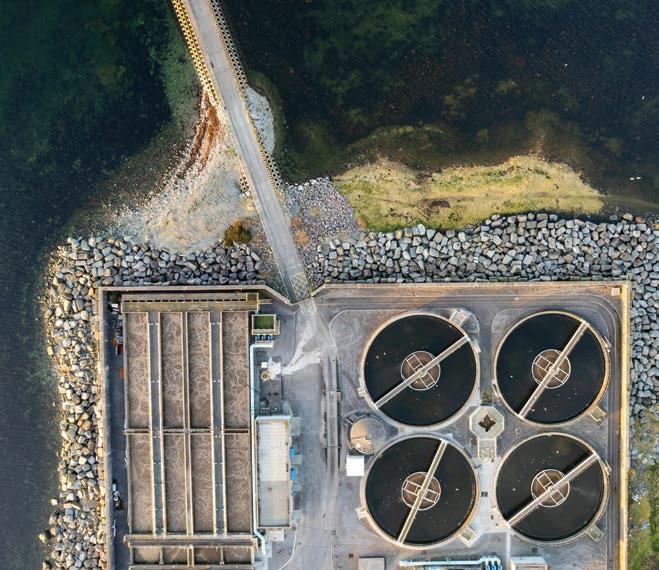
the whole life costs, identifying asset performance and risks to service, prioritising needs in the context of the asset strategy, planning solutions, design and construction of an asset intervention, and back into operations, is essential in optimising asset management strategies.
Making asset management more pervasive facilitates a better understanding and collection of data around asset risk, performance, and the value of interventions. This creates a risk and value framework that can be used to compare the relative benefits to provide choices when it comes to making decisions on investment priorities.
Driving this approach creates a consistent, fair, and transparent application and management of investment decision-making, helping improve communication across teams involved in the asset lifecycle in understanding which investments have been taken forward and why.
In summary there are three key outcomes that effective asset management brings to a water utility.
1. Organisational collaboration across operations, asset management and infrastructure delivery: Connecting the strategic intent and outcomes of the organisation with the day-to-day management, operation, and investment decisions.
2. Making risk-based decisions: To balance competing demands for maintaining and improving performance and compliance, increasing efficiency, and mitigating risk is aimed at managing the organisation’s risk profile for improved sustainability and resiliency.
3. Value from the asset base: Value can be derived from applying asset strategies to balance cost, risk, and performance to extend asset life and maintain service. Asset management provides a priority framework to target resources for activities like condition and risk assessment, preventative maintenance and whole life costing. This helps define criticality and risk to target or defer investment and produce the best outcomes from the resources available.
Given the significant current and future pressing challenges water utilities face then the application of effective asset management provides a risk-based organisation wide approach, shifting mindsets towards objectivity and organisational outcomes through the entire management of the asset lifecycle.
For more information:
T: +44 (0)78 8140 9424
E: john.carty@outformconsulting.com W: www.outformconsulting.com

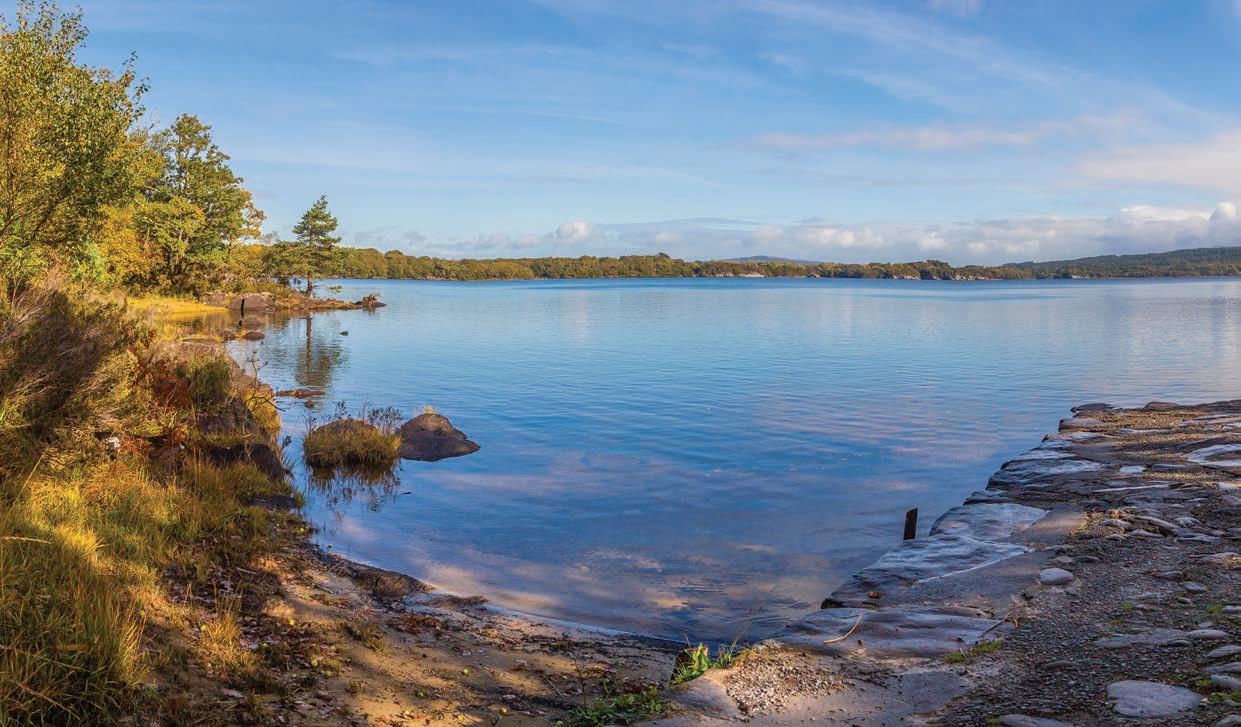
Amid legal challenges at EU level, as well as the publication of the third River Basin Management Plan (the Water Action Plan), significant changes are taking place in how Ireland implements the Water Framework Directive.
In place since 2000, the Water Framework Directive requires all EU water bodies to meet ‘good’ standard by 2027 via a process whereby EU member states establish river basin management plans.
Since passage, the European Commission has referred a number of EU member states, including Ireland, to EU courts, over alleged failures to meet these standards. For example, the Commission was referred to the Court of Justice of the European Union (CJEU) in January 2023 for allegedly failing to ensure that trihalomethanes (THMs) in drinking water did not exceed minimum failure levels outlined in the Directive.
In January 2024, the CJEU found that, by failing to ensure that the necessary remedial action was taken as soon as
possible to restore the quality of the water, Ireland had failed to give priority to its enforcement action.
EU member states were required to transpose the Water Framework Directive into national law by 22 December 2003. Ireland initially adopted legislation, but the European Commission found this legislation to be insufficient.
Progress had been made on implementation and legislation in the intervening years, but by June 2022, over 20 years after the entry into force of the Directive, the Government had still not fully addressed all of the shortfalls.
The Government has since announced the formation of a committee in Seanad Éireann which will examine the
implementation of EU directives, with the objective of avoiding future fines by the European Union for failure to implement, although there has been minimal engagement on European water legislation since this committee was established.
However, the Water Services Policy Statement 2024-2030, published in February 2024, underlines the Government’s commitment to ensure:
• compliance with water-related European Union legislation;
• delivery of UN Sustainable Development Goal 6 on clean water and sanitation; and
• implementation of the OECD Council Recommendation on Water.
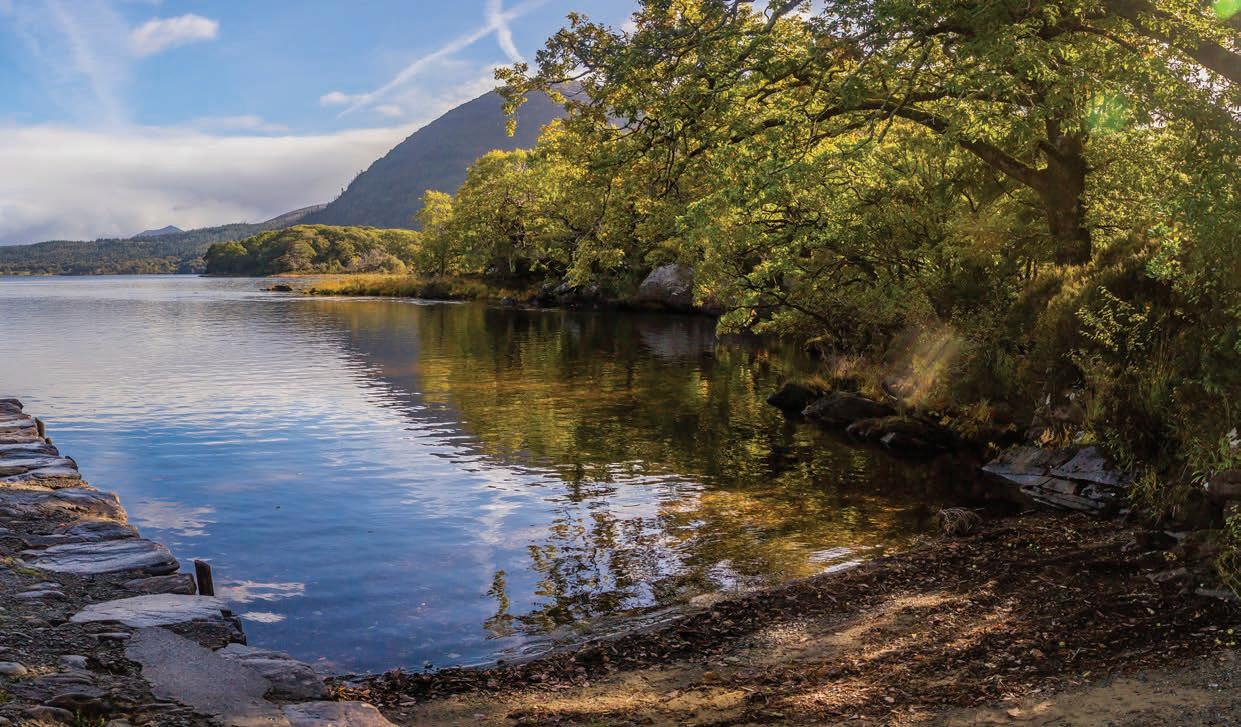
In October 2022, the European Commission adopted a proposal to revise the lists of pollutants in surface water and groundwater. The proposal recommends that member states be required to take measures to meet the quality standards for the additional pollutants, and to make their monitoring data available on a more frequent basis.
The new law revises the Water Framework Directive, the Groundwater Directive, and the Environmental Quality Standards Directive (Surface Water Directive). The Commission states that the aim of the revisions is “better protecting human health and natural ecosystems from pollutants”.
MEPs propose that the watch list, which contains substances or groups of substances where there is an indication that they pose a significant risk to human health and the environment, should not be limited to a maximum of substances as proposed by the Commission. This list must, they say, be updated regularly to keep up with new scientific evidence and the fastevolving pace of emerging new chemicals.
The Environment Committee wants a number of substances to be added to the watch list as soon as suitable monitoring methods are identified, including microplastics, antimicrobial resistant microorganisms and selected antimicrobial resistance genes, as well as possibly sulphates, xanthates and nonrelevant pesticide metabolites.
To better protect the EU’s groundwater, MEPs have demanded that the threshold values applicable to groundwater be 10-times lower than those for surface water.
The MEPs further propose creating a subset of specific PFAS (per- and polyfluoroalkyl substances) as well as the PFAS total (parameter which includes the totality of PFAS with a maximum concentration) to be added to the list of groundwater pollutants, as these substances have been detected in more than 70 per cent of the groundwater measuring points in the EU.
In line with this is a demand for stricter standards for glyphosate, bisphenol (bisphenol total), atrazine, pharmaceuticals, and non-relevant metabolites of pesticides.
Pressure to ensure that water quality in the State meets EU standards is high, as the results from the latest EPA Water Quality in Ireland 2023 report show. The report states that levels of nitrogen are too high in 42 per cent of river sites and 20 per cent of groundwaters, and that levels of phosphorus are too high in 27 per cent of river sites and 35 per cent of lakes.
Director of the EPA’s Office of Evidence and Assessment, Eimear Cotter, said in June 2024: “We do see some improvements in some areas, but these are being offset or eroded by declines elsewhere, so overall no net improvement and that is really disappointing…
“Having clean water is not an optional extra; it is not something… that is nice to have. It is absolutely a vital public good and we need to do everything we can to protect what we have and then drive on with further improvements in water quality.”

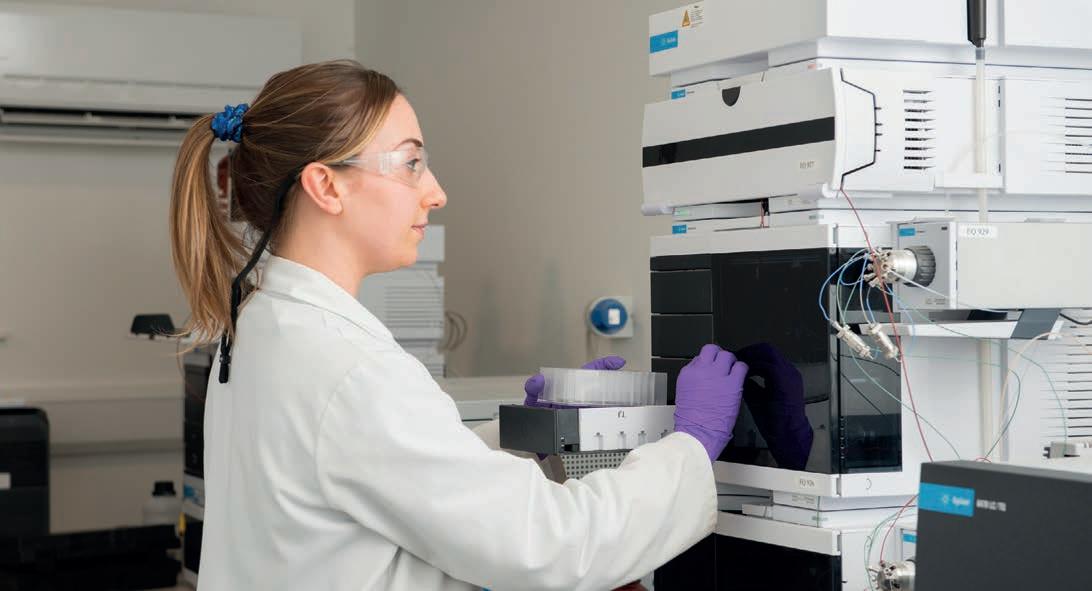
Amid the challenge of diminished water quality and the debate around the responsibility of farmers to help in its correction, Michael Murphy, Co-founder and Director of Southern Scientific Ireland asks: Does a solution to this problem lie in soil science?
A debate continues between agriculture and environment and their respective representatives on the quality of our waterways, rivers, lakes, estuarine and marine water. This debate gets hotter each time an Environmental Protection Agency (EPA) report is published on the status of Irish water.
At a conference in Galway in June 2024, the EPA presented data which essentially showed that, in the last 20 years, there was very little overall improvement in the quality of water since the introduction of the Water Framework Directive catchments monitoring.
By inference, the quality of water prior to that time was less than satisfactory. Whatever about the commentary that accompanies these yearly reports, the actual data that is collected by the scientists does not lie. The EPA has a statutory duty to do this work and to report it as it sees fit in order to achieve the objectives that have been set out in national policy and EU directives.
On the agriculture side, it goes without saying that the industry is vital and essential to the Irish economy and particularly to the rural economy. Worth over €17 billion per annum. It is the only industry that has a practitioner or practitioners in every single townland in the country. It is a part of the economic and social fabric of rural society and gives purpose and belonging to a large proportion of our population.
However, if a farmer buys a bag of 18-612 fertiliser this week and finds that, after spreading it on land, a proportion of it is flowing down the local river, that is not a good outcome for anyone.

Michael Murphy, Co-founder and Director, Southern Scientific Ireland
The debate centres around this point and the arguments are more often about the proportion that is absorbed by the crop versus the proportion entering the waterway. This argument is irrelevant because these proportions vary with every single field in the country and in any case the discussion should always have been about correcting this loss of nutrients. There are justifiable reasons for nutrient loss; rainfall and weather unpredictability, climate change, storage capacity, and the need to spread slurry almost throughout the entire year, as well as pressure from the demand for grass production for large milking herds and other crops.
The farming organisations cite the world’s demand for food as a pressure to produce more, but this is not a good argument because the world is full of farmers, and many countries can produce cattle, grain, and milk cheaper than we can. Farm representatives argue that sewage from towns, villages, industry, and septic tanks also contributes to the problem. However, this point is irrelevant, as farmers are often directly or indirectly connected to these sources. Meanwhile, Uisce Éireann, industry, and local authorities are already working on and investing in corrective actions to reduce nutrient loss.
So it is best to leave the EPA reports in the background and take care of nutrient loss from land. This is exactly what farmers, farmer representative organisations, co-ops, the food industry, Teagasc, local authorities, and the
“We must get to understand the biology, physics, and chemistry of our soil, even on a field-by-field basis.”
Department of Agriculture, Food and the Marine (DAFM) are all working on with increasing intensity.
Some of these measures include Teagasc’s Better Farming for Water campaign, the Agricultural Sustainability, Support and Advisory Programme (ASSAP), the Local Authority Water Programme (LAWPRO), the Danú Farming Group’s Curaíocht an Phobail European Innovation Programme (EIP) project, DAFM’s National Soil Sampling and Analysis Programme and grant for slurry storage, all of which should lead to a steady improvement in water quality over time.
One important DAFM programme is a €10 million to €20 million investment in a very comprehensive programme of soil sampling and analysis to involve over 10,000 farms. The soil analysis includes basic nutrients, NPK (nitrogen, phosphorus, and potassium), lime, major and minor trace elements, total carbon and nitrogen, and cation exchange capacity (CEC).
This large suite of tests gives a much better understanding of soil than we ever had in the past. The objective is that the results would be used in the assessment of the chemistry of soils and thereby determine the capacity of soils to assimilate and hold nutrients, including carbon, so that the nutrient and trace element inputs match plant uptake requirements in terms of quantity and uptake rate. The programme runs from 2023 to 2025 and will involve some 15,000 farmers.
Understanding soil biology, physics, and chemistry, even on a field-by-field basis, is crucial. Soil is a living entity with a structure that must be maintained. Major and minor elements reveal the soil’s chemical interactions; for instance, nitrogen, phosphorus, and potassium applications alone will not ensure crop health if trace elements like zinc, copper, molybdenum, iron, or manganese are deficient. Without the right trace elements, excess NPK nutrients may leach into groundwater or runoff into surface water. Soil pH also plays a key role. Cation exchange capacity (CEC) is vital in determining soil’s ability to hold nutrients. Clay soils, with high CEC, retain nutrients well, whereas sandy soils, with low CEC, struggle to do so.
The EPA’s water quality reports serve as the true benchmark of our progress—and, regrettably, often highlight our shortcomings. While debates around these reports are important, they should not overshadow the need for actionable solutions.
Reducing nutrient loss through the soilwater continuum requires optimising the inputs to the soil, which demands a comprehensive understanding of each field’s physical and biological characteristics, its basic and trace nutrient needs, and the soil’s nutrientholding capacity (CEC).
T: 087 261 8276
E: michael@southernscientificireland.com
W: www.southernscientificireland.com
•
•

•
•
•
•


















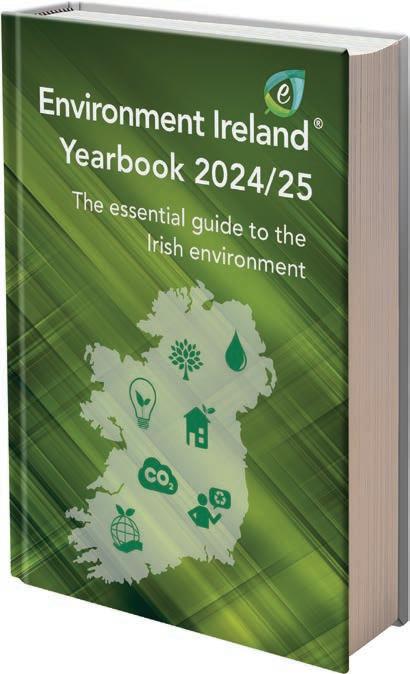

Sponsored by

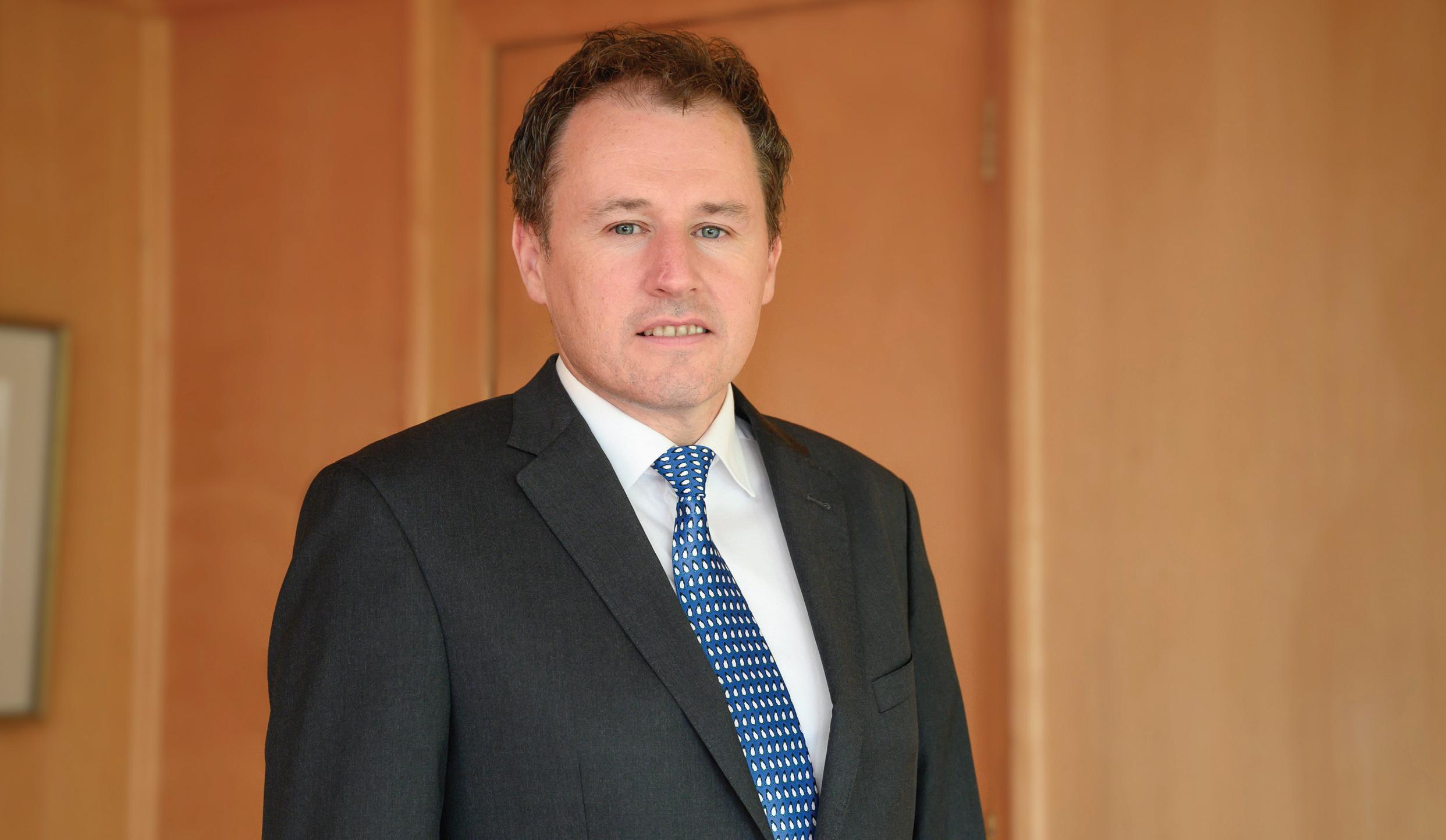
The Government has set ambitious targets for sectoral emissions reductions, and I have recognised that central to success is the role that the agriculture sector and its farmers can play in the decarbonisation of the energy system. Minister for Agriculture, Food and the Marine, Charlie McConalogue TD, writes.
This is for very good reason. Ireland is acknowledged by the European Commission as having one of the largest potentials for biomethane production in Europe on a per capita basis. This is due to our substantial agriculture sector and grass-based systems.
As Minister for Agriculture, Food and the Marine, it is my responsibility to both explore and support all opportunities that can galvanise the economic and sustainable future of the agriculture sector. Suffice it to say, I foresee several benefits being realised, aside from the delivery of renewable energy targets, with the development of an agri-led biomethane industry. There are opportunities for farmers, for example, through land diversification opportunities, biobased fertiliser replacing chemical fertiliser, and carbon sequestration on land.
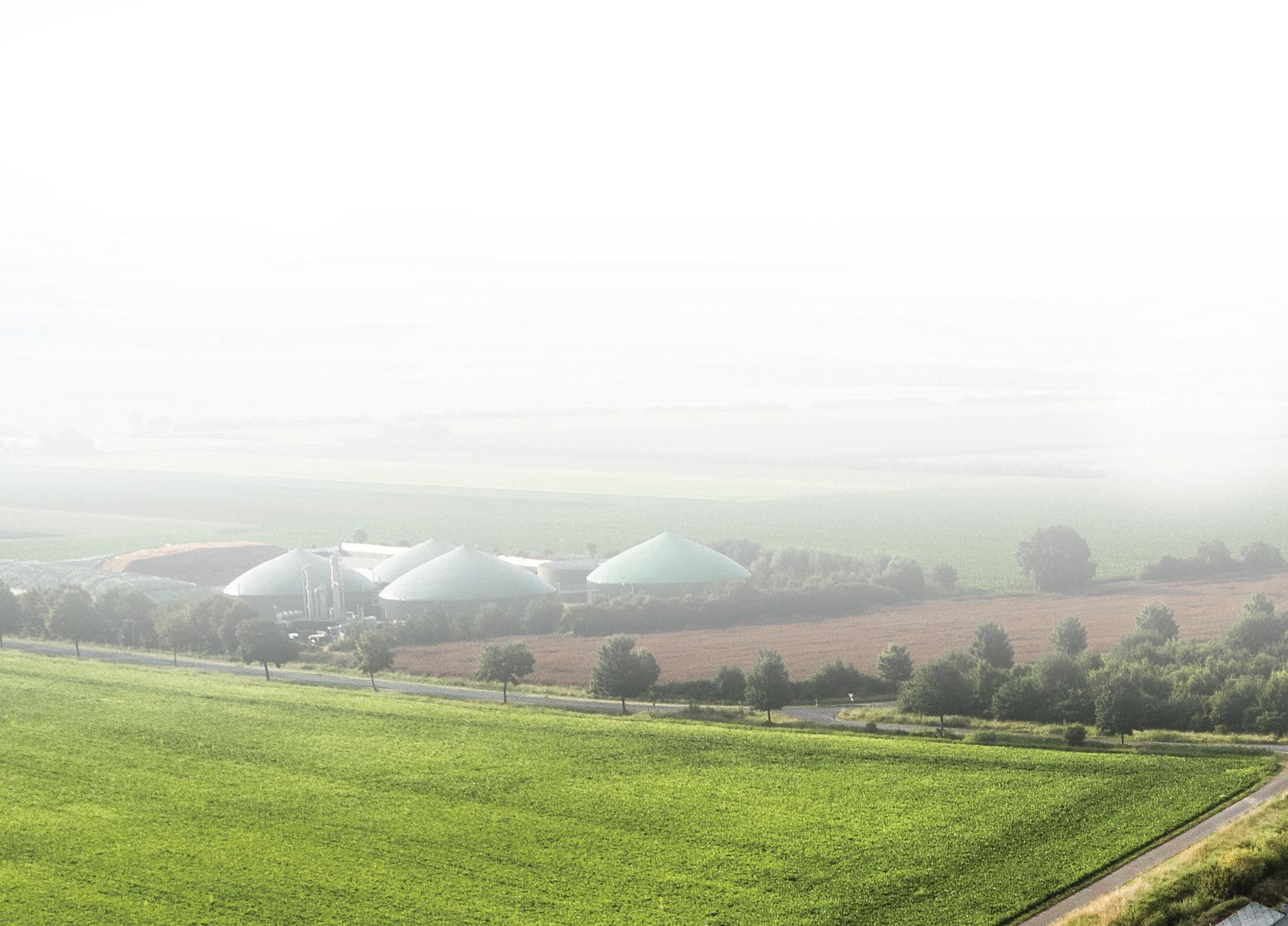
This government is investing in sustainably produced biomethane because it will make an important contribution to achieving Ireland’s 2030 climate targets. An all-ofindustry effort is required to meet the ambitious 2030, 5.7 TWh from biomethane target published by the Department for Environment, Climate and Communications (DECC) in 2022. I want to recognise that we are not alone in this endeavour, with major agri-food, drinks, and biopharma companies committed to developing an indigenous, renewable gas industry as a means of reducing their own carbon footprint.
“Developing a biomethane industry at scale, simply cannot happen without farmers supplying agricultural feedstock.”
Today, however, Ireland relies heavily on imported fossil gas, with circa 75 per cent of gas consumption being imported via the UK in 2023. Research from the MaREI institute has shown that Ireland spends over €1 million every hour importing fossil fuels into the State. Our target for biomethane is equivalent to 10 per cent of our current national gas demand and farmers will be key players in achieving this goal. This is because there is not sufficient accessible waste in Ireland to meet the requirements and therefore, developing a biomethane industry at scale, simply cannot happen without farmers supplying agricultural feedstock.
It is estimated that over 80 per cent of biomethane will be produced from grass silage and cattle slurry. Teagasc, our agricultural research body, estimates that approximately 20 per cent of all winter cattle slurry produced and approximately 120,000ha of silage, or just under 3 per cent of available agricultural land, will be required to feed these AD plants. Farmers are uniquely positioned and qualified to produce this feedstock and for this reason, it is envisaged that most developments will occur in rural Ireland. It is estimated that development of a biomethane industry in Ireland could lead to the creation of 3,000 to 5,000 jobs and provide rural communities with opportunities to diversify their income towards energy production.
I believe it is important to recognise the role of the farming community in their
contribution to the broader decarbonisation agenda and to raise awareness within that community of the longer-term benefits such as bio fertilisers and digestates. We also need to acknowledge and work with rural communities where anaerobic digestion (AD) plants are located. While a wellproven technology, biomethane, and anaerobic digestion are relatively new and unknown renewable energy technologies to many in Ireland. The success of the industry will rely on good local stakeholder engagement, as well as broader national information.
In this respect, I was delighted to publish the National Biomethane Strategy in May 2024 along with my colleague, Minister for the Environment, Climate, Communications, Eamon Ryan TD. This strategy is Ireland’s first major policy statement on biomethane and an important milestone in the development of an indigenous sector. It is, however, just the start of the process, implementing it along with industry will be key to developing a sustainable biomethane industry in Ireland.
A successful biomethane industry will be accomplished by delivering on the 25 key actions set out in the strategy. There are ambitious timelines associated to these actions and a Biomethane Implementation Group has been established to monitor impact and delivery of these initial measures and to identify further actions to support overall target delivery.
I recognised early on that the biomethane industry would need capital support to be kick-started and to this end, I secured €40 million in funding to help support the initial development of biomethane in Ireland. Upon publication of the National Biomethane Strategy, I immediately opened an expression of interest for the capital scheme and the sector have responded. While I will continue to advocate for further funding to be made available from the Climate and Nature Fund from 2026, I was delighted with the response to this initial funding that confirmed both a strong demand and a readiness to invest before applications closed on the 30 August 2024. Successful applicants that meet the scheme eligibility and selection criteria can receive grant aid of 20 per cent of investment up to a maximum of €5 million.
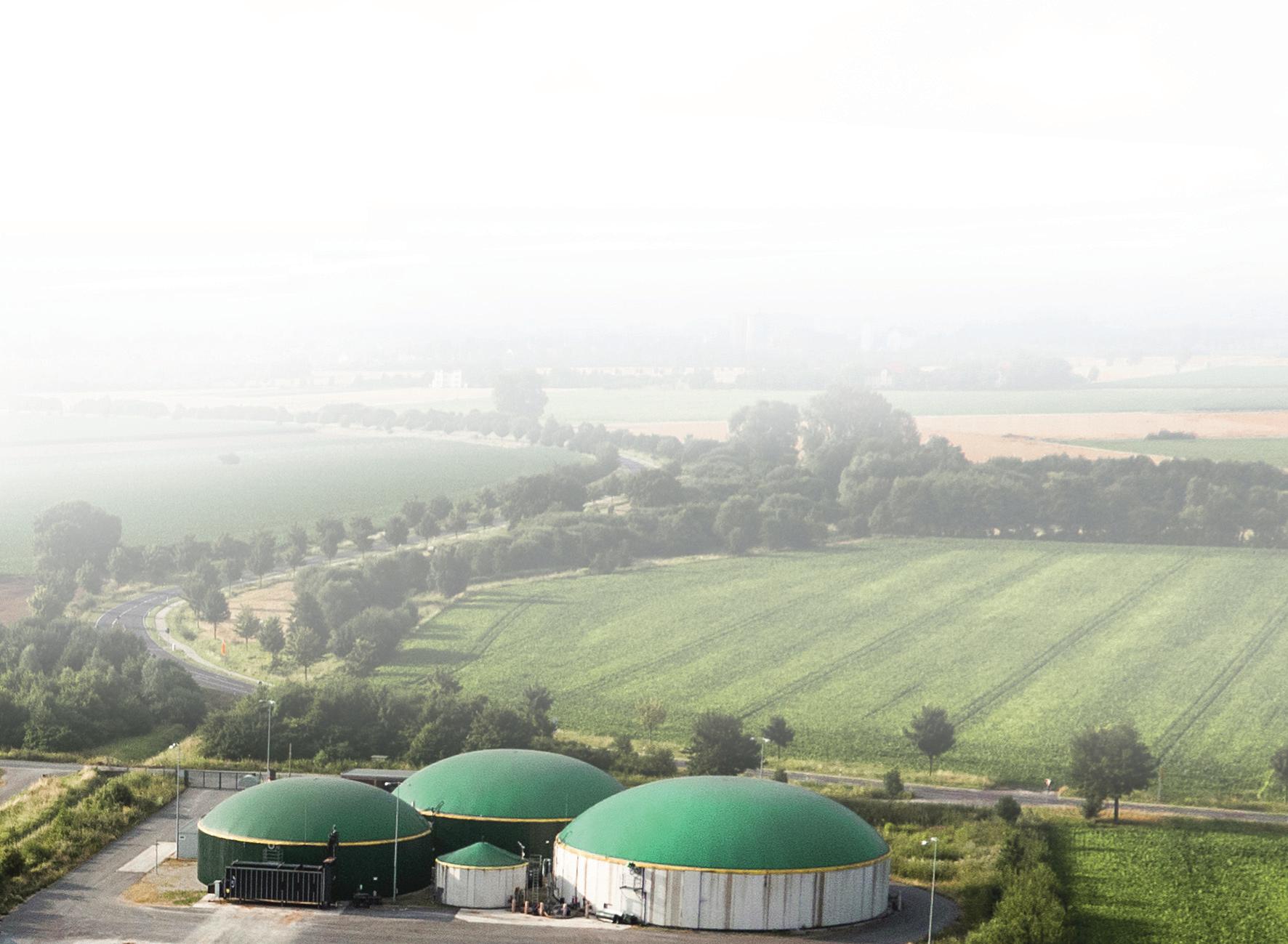
In conclusion, I am hugely optimistic about the direction and the potential of biomethane production over the next decade and beyond. I look forward to working with all stakeholders in the industry to ensure the National Biomethane Strategy is a success, and I hope to be able to reflect in 2030 on a thriving sustainable biomethane industry, delivering the full range of benefits that AD has to offer.

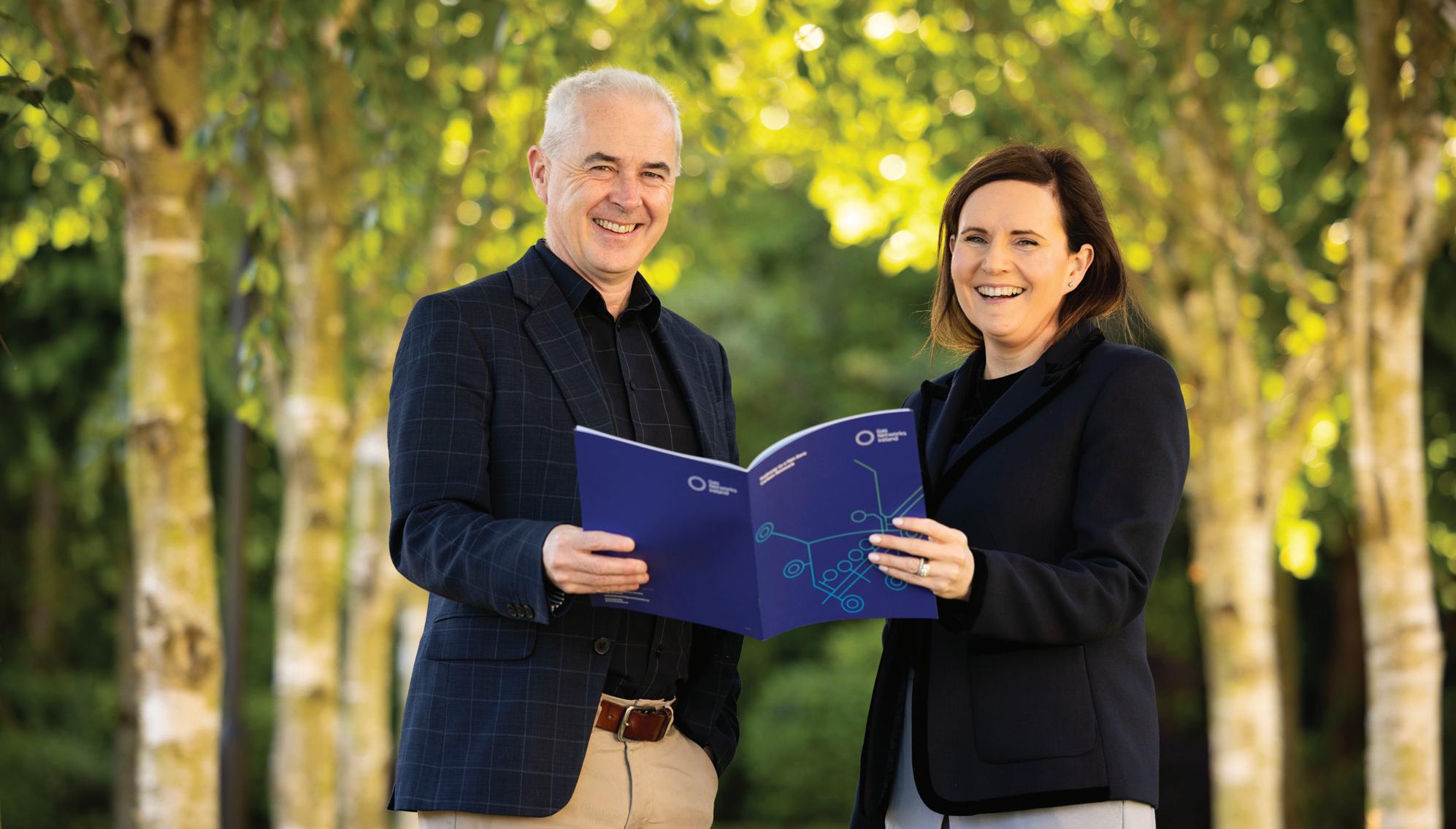
Gas Networks Ireland has embarked on an ambitious journey to fully decarbonise Ireland’s gas network by 2045. This transformation will involve repurposing and resizing existing gas infrastructure to transport 100 per cent renewable gases such as biomethane and green hydrogen.
Gas Networks Ireland’s plan is not only pivotal for Ireland’s energy transition but also critical for securing a sustainable and reliable energy future. It aims to reduce the volume of natural gas on the Irish network from over 99 per cent today to 60 per cent by 2036 and completely remove it by 2045. During this transition, renewable gas is expected to increase to 40 per cent (comprising 15 per cent hydrogen and 25 per cent biomethane) by 2036 and to 100 per cent (68 per cent hydrogen and 32 per cent biomethane) by 2045.
The pathway to a net zero carbon network is comprised of four key phases: foundation, development, repositioning, and conversion. These phases mark the progression from initial groundwork to the complete transformation of the gas network.
• Phase 1: Foundation phase (up to 2027): The foundation phase, already underway, focuses on preparing the gas network to handle renewable gases. Key projects include the construction of new anaerobic digestion plants and the Mitchelstown Central Grid Injection facility. This phase ensures the network’s enhanced security and resilience, demonstrating the safe injection and transportation of renewable gases.

This phase of development will be focused on readying the network for the emergence and initial scaling of renewable gases. The period will be one of planning, testing, trialling, safety case development, and initial injection sites establishment. By the end of this phase, the network will have enhanced its security and resilience capabilities and proven its ability to safely inject and transport renewable gases.
Gas Source estimates by end of 2027: Annual network demand/gas source by end of 2027 = 56.8 TWh:
• Natural gas = 56.1 TWh
• Biomethane = 0.7 TWh
• Hydrogen = 0 TWh
During this period, renewable gas volumes will scale-up. Our pathway anticipates that the national biomethane target of 5.7 TWh by 2030 is achieved and that the biomethane sector which is solidly established by this point continues to grow towards sustainable limits. It is expected that hydrogen blending will commence either locally and/or via the gas interconnectors and an initial hydrogen cluster will emerge likely involving some repurposing of the existing gas network to distribute indigenous green hydrogen to local large gas consumers. It is also likely other such projects, most likely at port locations, will be under development in this period.
Gas Source estimates by end of 2032:
Annual network demand/gas source by end of 2032 = 32 TWh:
• Natural gas = 38.4 TWh
• Biomethane = 6.3 TWh
• Hydrogen = 1.3 TWh
Repositioning phase (2033-2040)
Repositioning phase 1: 2033–2036 – As hydrogen volumes available to the gas network continue to grow, the focus will turn to more wholesale gas network repurposing. Hydrogen clustering opportunities will become exhausted (there are likely only c. 5 or 6 potential clusters nationally) and will require connection to each other for resilience, and volumes of hydrogen on the gas network will approach levels beyond which conversion to 100 per cent hydrogen would be necessary. Key network flexibility projects will now need to be undertaken to ready the network for full repurposing to transport renewable gases only.
Gas Source estimates by end of 2036:
Annual network demand/gas source by end of 2032 = 40.4 TWh:
• Natural gas = 24.4 TWh
• Biomethane = 10 TWh
• Hydrogen = 6 TWh


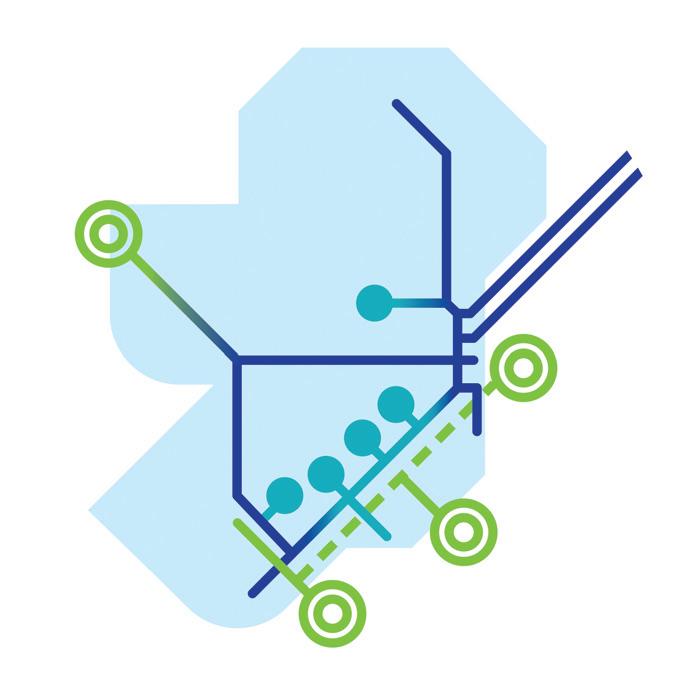


Repositioning phase 2: 2036-2040 – Some network compression and reinforcement work will be undertaken to adjust for the difference in transporting 100 per cent hydrogen, a less energy dense gas than natural gas. Some parallel network development (most likely twinning of the Cork-Dublin transmission pipeline) will be necessary to create the flexibility for introducing 100 per cent renewable gases on distinct networks and to connect hydrogen clusters. In the mid to late 2030s, subject to scaling of hydrogen production, 100 per cent UK hydrogen could become available through the Moffat Entry Point along with the emergence of a Dublin hydrogen power generation cluster.
Gas source estimates by end of 2040:
Annual network demand/gas source by end of 2032 = 37.2 TWh:
• Hydrogen = 17.1 TWh
• Biomethane = 14 TWh
• Natural gas = 6.1 TWh
Assuming sustainable biomethane production has scaled to levels that would support a dedicated network, the national gas network will be split into two distinct renewable gas networks. National biomethane potential suggests that it may be ultimately capable of meeting c.25 per cent to 30 per cent of national gas needs. As such, hydrogen will need to cater for the remaining c. 70 per cent to 75 per cent of enduring gas demand, resulting in a larger national zero carbon hydrogen network and a smaller regional net zero carbon biomethane network.
Gas source estimates by end of 2045:
Annual network demand/gas source by end of 2045 = 44.1 TWh:
• Hydrogen = 30.1 TWh
• Biomethane = 14 TWh
• Natural gas = 0TWh
• Phase 2: Development phase (20282032): During the development phase, Gas Networks Ireland will facilitate increased connections of renewable gas to the network, aiming to meet the national biomethane target of 5.7 TWh by 2030. This phase will also see the commencement of hydrogen blending and the development of initial hydrogen clusters. By the end of this phase, approximately 17 per cent of the gas on the network will come from renewable sources, with 14 per cent biomethane and 3 per cent hydrogen.

• Phase 3: Repositioning phase (2033-2040): In the repositioning phase, Gas Networks Ireland will focus on more extensive repurposing of the gas network and the establishment of hydrogen clusters. By 2040, it is anticipated that nearly half of the gas on the network will be hydrogen, with biomethane comprising 38 per cent and natural gas reduced to 16 per cent.
• Phase 4: Conversion phase (20412045): The final conversion phase will see the complete transformation of the gas network into two distinct renewable gas networks: a larger
national hydrogen network and a smaller regional biomethane network. By 2045, the network will exclusively transport renewable gases, with an estimated composition of 70 per cent hydrogen and 30 per cent biomethane.
Cathal Marley, Chief Executive Officer of Gas Networks Ireland, emphasises the dual benefits of this pathway, achieving Ireland’s climate objectives while ensuring energy security and economic stability.

• Ambitious pathway to deliver a repurposed, resized, and fully decarbonised gas network by 2045
• Ireland’s current gas network can be repurposed into two networks to transport 100 per cent renewable gas, one dedicated to biomethane and one to hydrogen
“Developing and repurposing the gas network to be net zero carbon over the next 20 years offers a least-cost and least-disruptive means of decarbonizing energy use for many, and a vital alternative decarbonisation path for those consumers for whom electrification is very challenging,” Marley states.
“While achieving this network transformation has several dependencies, including the availability of renewable gases and supportive energy policies, Gas Networks Ireland is fully committed to transitioning the network to exclusively transport renewable gases, ensuring a fully decarbonised energy system by 2045.”
Gas Networks Ireland’s pathway underscores the importance of innovation, expertise, and stakeholder collaboration. The plan is designed to be adaptable, allowing for adjustments as energy policies and technologies evolve, a point emphasised by Edwina Nyhan, Director of Strategy and Regulation at Gas Networks Ireland.
“The pathway that Gas Networks Ireland has laid out brings our vision to be at the heart of Ireland’s energy future to life and outlines a route by which the gas network can transition to net zero,” Nyhan explains.
“Inevitably, some aspects will evolve as we move forward. However, we will remain flexible and responsive to achieve our commitment to delivering for Ireland. This roadmap will enable us to transition sequentially and ensure a robust and adaptive approach to achieving a fully decarbonised network over time.”
Presently, Gas Networks Ireland in deep in the midst of the foundation phase of the pathway. The first half of 2024 alone has seen significant progress made in preparing the network for renewable gas and facilitating the growth of Ireland’s renewable gas industry.
• In April 2024, Gas Networks Ireland announced a landmark development of gas infrastructure to connect Bord na Móna’s Edenderry Renewable Energy Complex to the national gas network, enabling the integration of renewable gas into its fuel mix. On completion, the transmission connection project will facilitate a reduction of approximately 40 per cent in CO2 emissions.
• In the same month, Gas Networks Ireland announced an agreement with Irish Tar & Bitumen Suppliers Ltd. (Irish Tar) to substitute about 5 per cent of the fuel it uses annually with low carbon gasses, resulting in an overall carbon emissions reduction of approximately 30 per cent.
• In May 2024, Gas Networks Ireland signed a contract that will see biomethane from Bia Energy’s new €60 million anaerobic digestion (AD) plant in Huntstown injected directly into the gas network.
• In June 2024, Gas Networks Ireland supported Flogas in the opening of the Republic of Ireland’s first ever dedicated BioCNG refuelling self service station in North County Dublin. The station can refuel up to 50 HGVs per day, cutting over 9,000 tonnes of CO2 emissions compared to diesel fuelled HGVs.
The above-mentioned Mitchelstown facility will be entering construction by the end of 2024 and is poised to become a cornerstone of Ireland’s renewable energy infrastructure. In addition to this, Gas Networks Ireland is considering the purchase of up to 250GW of biomethane and has begun a market sounding exercise by publishing a Prior Information Notice (PIN) on the e-tenders system.
To read the full report visit: W: www.gasnetworks.ie/pathway

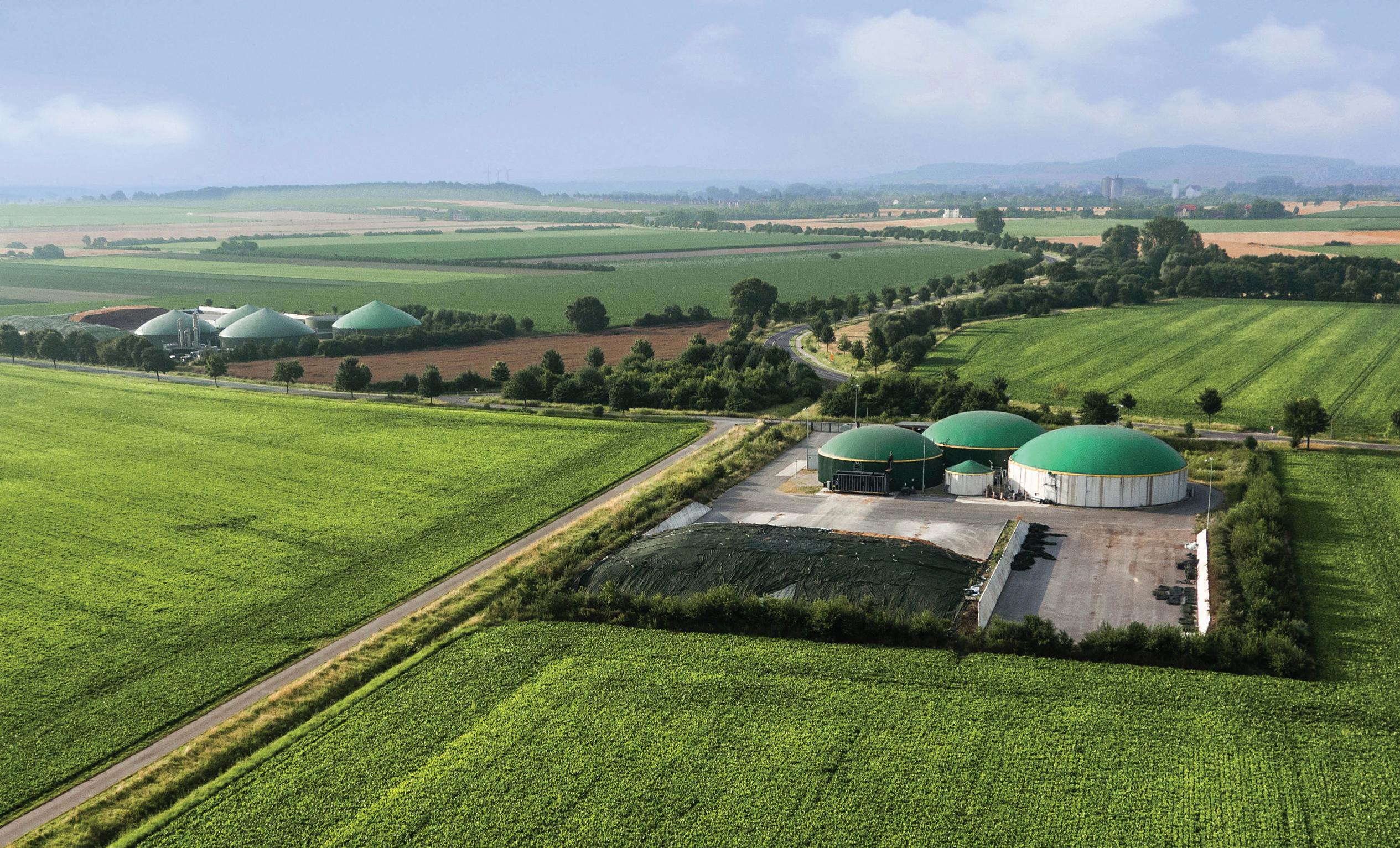
The
publication of Ireland’s
first major policy statement on biomethane marks an important milestone in an overarching ambition to develop a sustainable industry of scale by 2030.
In July 2023, the Environmental Protection Agency (EPA) highlighted the need for urgency to deliver decarbonisation options to meet the overarching target of 51 per cent reduction in emissions by 2030. The Government has subsequently acknowledged that without biomethane, Ireland is unlikely to meet its legally binding climate targets.
The National Biomethane Strategy is intended to be a starting point to catalyse the significant momentum required to produce 5.7 TWh of biomethane per annum by 2030, a target set by the Department of the Environment, Climate and Communications (DECC) in the context of the sectoral emissions ceilings.
The scale of the ambition is significant and challenging, and will require a shift from current production levels of less than 0.1 per cent of the State’s overall fossil gas demand to 10 per cent by 2030 – rising to over 50 per cent by the mid-2030s.
Recognition of the significant role biomethane will have in helping to decarbonise hard-to-abate sectors, including industrial heat and transport, can be seen by the shift of emphasis in increasing levels of production. The 5.7 TWh target for 2030 is more than three and a half times greater than the original target of 1.6 TWh outlined in Climate Action Plan 2019.
Co-developed by the Department of
Agriculture, Food and the Marine (DAFM) and DECC, the strategy outlines 25 measures under a framework of five key pillars:
1. sustainability;
2. demand for biomethane;
3. bioeconomy and circular economy;
4. economics of biomethane; and
5. enabling policy requirements.
The production of biomethane is firmly established in Europe, with an estimated 37 TWh produced in 2022. However, it is described as being at a “nascent stage of development” in Ireland, despite recognition of its potential given the size of the agriculture sector here.
With only two operational biomethane facilities injecting biomethane into the gas grid, current direct injection is estimated to be around just 75 GWh per annum. Most of this is used within the transport sector under the Renewable Transport Fuel Obligation.
Biogas, produced through anaerobic digestion (AD) is only classed as biomethane when upgraded to methane with greater than 97 per cent purity, making it compatible with the national gas network. Alongside Ireland’s two
biomethane plants, there are over 40 AD facilities which produce a total of 580 GWh of biogas.
While much of the emissions savings of biomethane will be counted in the energy sector, there is a recognition that increased production offers alternative land use options for the agriculture sector. The sectoral emission ceiling for agriculture sets a need for a 25 per cent emission reduction between 2018 and 2025.
As such, according to the strategy: “The development of a biomethane industry will also provide significant opportunities to reduce emissions in agriculture and improve the likelihood of reaching the sectoral targets.
“These opportunities with biomethane for agriculture include diversification opportunities for livestock farmers, reduced emissions from animal wastes, biobased fertiliser replacing chemical fertiliser and carbon sequestration on land.”
The Government has designed a bespoke AD model, focused on centralised, large-scale plants with grass silage and slurry as the main feedstocks. While the strategy suggests the need for a broad mix in the scale of plants developed, most of the focus will be on delivering plants that can produce 40 GWh of biogas, which come at an estimated cost of €15 million each.
Aiming for 1 TWh (1.7 per cent of current natural gas demand) of biomethane produced by the end of 2025, an estimated total of 25 40 GWh plants will need to be built .
The Government has secured €40 million from Europe’s REPowerEU scheme for a capital grant scheme for biomethane production plants and it is expected that AD plants currently operating to produce biogas will be eligible for capital support to upgrade their facilities to produce biomethane and other biobased products, along with new AD plants.
However, it is likely that only new plant builds with full planning and permitting permissions would be eligible for this round of capital support.
The strategy outlines that while a wide range of support mechanisms was assessed during the strategy’s development, the need to “swiftly stimulate” the industry led to the decision to utilise the Renewable Heat Obligation in conjunction with capital grants, which it says offers budget certainty for the support programme while delivering a sector of scale.
The Government has agreed to introduce a Renewable Heat Obligation by the end of 2024, which will obligate suppliers of fossil fuels used for heat to ensure a proportion of the energy they supply is renewable.
Given the evident challenge of access to finance, there is a recognition that smaller farmer-led/farmercontrolled projects will also need incentivised and supported. Although not confirmed, the Government is exploring the potential for an appropriate smallerscale (circa 10 GWh plants) finance scheme and is expected to realise details before the end of 2024.
The Renewable Energy Directives set strict sustainability criteria for biomethane from AD plants to be classified as a zero-carbon renewable fuel, yet this only applies to facilities beyond 200 Nm3 /h of installed capacity. The Government has committed to
35GW The average size of AD plants in Europe
64% of feedstocks are from agriculture, compared to 11% from organic waste and 11% from industrial wastes
75% of plants are grid connected, compared to 9% not connected and 14% unknown
developing a biomethane sustainability charter which will set similar guidelines for plants that fall outside the Directive’s threshold and will require compliance for eligibility for any potential financial support.
They include substantial GHG emissions savings calculated along the supply chain and the guarantee that biomass sourcing has a minimum impact on biodiversity and soil quality. Compliance with such criteria is necessary to qualify as renewable, to be eligible for any potential financial support, and to be zero-rated under the EU emissions trading system.
The charter will apply to all biomethane projects being developed in Ireland in receipt of any form of support or operating under the RHO and will, according to the strategy “support the delivery of environmentally sustainable biomethane in Ireland”.
Despite the recognised need for a rapid increase in AD plant development, there is no existing mechanism to fast-track applications. However, in response, the strategy commits to developing guidelines to support local authorities when
assessing AD and biorefinery planning applications by the end of 2024.
Given the evident potential of biomethane production in Ireland, the strategy has been welcomed by stakeholders as a good first step towards developing an indigenous industry and reducing dependence on imported fossil fuels.
The strategy offers a blueprint of future progress and is a signal to prospective producers of the Government’s commitment to supporting and developing the industry.
Success will be determined by the ability of all stakeholders to deliver on the relevant key actions, within a short timeframe, and to ensure that financial support is sustained, particularly as other sectors strive towards their renewable targets.
Arguably most critical will be the buy-in achieved from the agri-food sector, and in particular farmers, who will provide feedstock for increasing number of plants. Minister for Agriculture, Food and the Marine Charlie McConalogue TD described the strategy as “agri-centric” and progress will rest on the commitment to enable farmers to contribute to the decarbonisation of Ireland’s energy system.
• Most plants will be 40 GWh or similar scale, but there will be a role for smaller farm scale plants.
• Initially waste products will be utilised as a main feedstock, but this will be closely followed by agricultural feedstocks such as slurries and grass silage.
• Most AD plants in Ireland will be directly connected to the gas network.
• The Renewable Heat Obligation and capital grants will serve as the main support measures.
• Biomethane will be utilised in the heat (RHO), transport (RTFO) and electricity generation (Gas Purchase Agreements) sectors in Ireland.
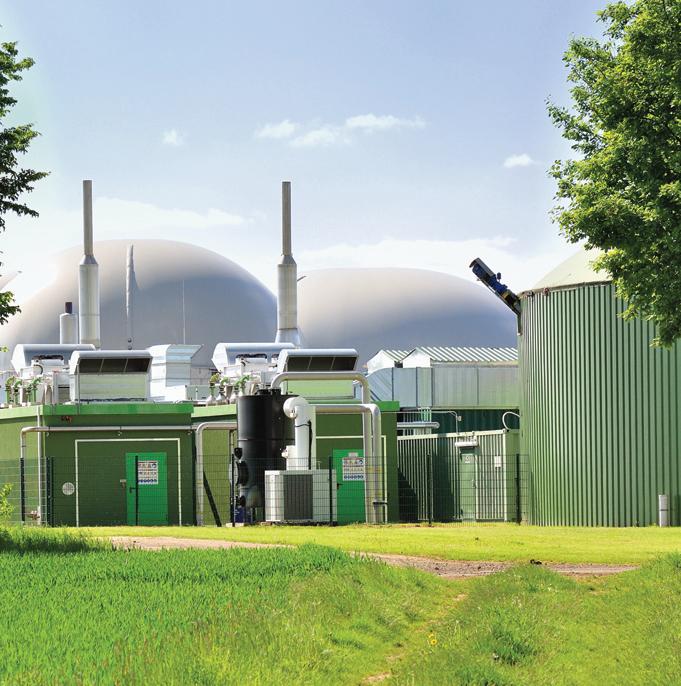
• Sustainability will be prioritized through a Biomethane Sustainability Charter.


To meet our climate targets, the global economy must reach net zero emissions by 2050. While it is anticipated that much of this will be facilitated by electrification, hydrogen may play a role in decarbonising the ‘toughest third’ of our energy supply, writes Niall Farrell, Senior Research Officer, Economic and Social Research Institute (ESRI).
Cost, rather than technological feasibility, is the primary factor determining the extent with which hydrogen may feature. There are many known processes to synthesise zero carbon ‘green’ hydrogen, and the transport of hydrogen once produced is relatively straightforward. Gas Networks Ireland, in its recent hydrogen feasibility study, has noted that the Irish gas network can readily facilitate hydrogen blends of up to 20 per cent, with 100 per cent hydrogen possible with some modifications.
When evaluating cost, one must first consider the projected production cost. Production costs are primarily influenced by the rate of electrolyser deployment and the cost of electricity generated using renewable sources, which is used to synthesise green hydrogen. Electrolyser costs will fall with greater international rollout.
Aurora Energy Research tracks electrolyser deployment in its rolling
database, which finds a strong and growing pipeline of electrolyser production. If the planned development materialises, production costs could fall sharply in the coming years. The cost of renewable electricity has fallen considerably in recent years, although inflation may be putting upward pressure on costs in the short term.
Capital and renewable electricity costs are not the sole factor determining cost competitiveness – the proportion of time with which the electrolyser is in use (the ‘capacity factor’) has a considerable influence on the cost per unit synthesised. This may have important implications for Irish industrial policy.
Ireland’s hydrogen strategy places a strong emphasis on locally-produced green hydrogen. However, there may be competition. The IEA’s global hydrogen review suggests that locations that can exploit both solar and wind resources can provide the strongest capacity factors and therefore cheapest hydrogen. In 2023, the IEA
“Hydrogen’s role in the future energy system will likely be determined by the cost of hydrogen synthesis and the cost competitiveness of hydrogen-based technologies.”
Niall Farrell, Senior Research Officer, ESRI
identified the west of Ireland among the best-placed to produce green hydrogen, but Irish producers may wish to investigate whether electrolysers can use both wind and solar-sourced electricity to maximise capacity factor. A backup source of electricity, such as a grid connection or storage, may provide electricity when the wind does not blow. This may also improve the capacity factor and therefore the competitiveness of Irish hydrogen. Of course, gridsourced electricity is not necessarily 100 per cent carbon-free, and the hydrogen produced may not receive ‘green’ hydrogen status.
While the cost of the hydrogen itself is important, adoption is ultimately determined by the extent with which applications, such as use for heat or transport, are cost competitive with non-hydrogen alternatives. These will now be discussed.
Much research suggests that electric vehicles are more likely to provide a cost-effective decarbonised transport solution, particularly for light vehicles such as private cars. There is a greater likelihood that hydrogen could fuel heavy goods vehicles, however, uncertainty remains.
Hydrogen-based space heating is at an early stage of development. Cost projections are therefore speculative; estimates suggest that costs must fall considerably to be competitive with electric heat pumps. It should be noted that cost is not the only factor determining technology adoption.
Inconvenience, disruption, and other non-financial costs are of notable magnitude for home insulation upgrades, for instance. This could impede timely decarbonisation through electrification, given that insulation investment is often required to accompany heat pump installation. Should hydrogen provide a less-invasive alternative, it may have a role to play, even if more expensive than electric alternatives. Further research is required to understand to what extent such preferences exist and influence technology choice.
Should widescale hydrogen heating systems be considered, policy should be mindful of the lead-in time required. In 2016, Dorrington et al discussed the transition in the UK from ‘town gas’ to natural gas in the 1970s, noting that the required conversion of appliances and infrastructure took around 10 years to complete. While the lead time is not necessarily the same for hydrogen conversion of the gas network, it is an important factor, and must be considered in the context of a 2050 deadline. Indeed, this is also an important factor for electrification.
Industrial processes require a very low cost of green hydrogen to be competitive with alternatives. This suggests that the cost competitiveness may be achieved at a late date in our decarbonisation transition. The use of hydrogen in the electricity sector could well transpire in the context of long-term storage. This is likely to become a pressing requirement as Ireland approaches and surpasses its 80 per cent 2030 renewable electricity penetration target.
Hydrogen’s role in the future energy system will likely be determined by the cost of hydrogen synthesis and the cost competitiveness of hydrogen-based technologies. The former is of particular interest for Irish industrial strategy.
Irish hydrogen production may have to compete with that produced elsewhere, particularly from locations that enjoy a combination of suitable wind and solar resources. Electric transport and heating applications are likely to be most cost effective, given current information. However, hydrogen may have a role if non-financial barriers are prohibiting decarbonisation through electrification.
Further research is required to understand the extent with which hydrogen may contribute. For industrial processes, the cost of hydrogen must fall considerably to be competitive. This may lead to adoption in the latter years as we approach 2050. Hydrogen may have a role in long-term electricity storage. In an Irish context, this is likely to be of increasing importance as renewable electricity penetration grows.
The Kestrel Project, collectively developed by ESB, dCarbonX and Bord Gáis Energy

It is essential to transform Ireland’s energy system to achieve its goal of a climate-neutral economy by 2050 whilst also ensuring that the energy system is secure and reliable.
Of particular importance is the need to ensure that there is sufficient indigenous long-term infrastructure that can support Ireland’s current energy supply requirements, whilst also ensuring that this infrastructure can evolve to cater for the increased penetration of renewables, in particular biogas and green hydrogen.
In addressing this topic, we firmly believe that a key consideration is to ensure security of supply, as compared to a complementary diversity of supply. Specifically, on the basis that Ireland does not wish to outsource its security of supply, we believe that the development of local large-scale underground energy storage capacity –via underground gas storage (UGS) – is
essential for Ireland’s energy security requirements given the current crises (Ukraine and the Middle East) together with the lack of indigenous gas production and/or storage in Ireland.
In addition, there is a need to start preparing essential large-scale underground molecular storage for the increased future planned roles of biogas and green hydrogen in Ireland’s energy mix, which also underpins the significant investment planned to be taken in renewable energy developments.
Critically, the use of large-scale underground energy storage is not a new technology, having been
established and utilised throughout most EU countries for the past 50 years as a security of supply and load balancing instrument. Importantly, it is also not new to Ireland as the SW Kinsale natural gas storage facility (2.3TWh) operated successfully from 2001 to 2016.
This storage facility provided natural gas storage, that amounted to circa 10 per cent of the then Irish electricity market, providing Ireland with a safe, reliable incountry storage facility, ensuring that peak shaving and network supportive gas resources were in place to avoid supply disruptions and importantly, provided risk mitigation from significant price fluctuations.
Underground gas storage is now designated as “critical infrastructure” across the EU. The main opportunity for the storage of energy in gaseous molecular form (including future biogas
and hydrogen developments) in UGS is linked to its distinctive attributes such as scale, duration and cost when compared to other forms of electron storage such as battery technology.
To cope with peak periods, UGS facilities can be appropriately scaled, to address seasonal/annual storage needs required by the energy systems to address demand swings between e.g. summer/winter or across different years. This has the added benefit of protecting consumers from significant variations in gas prices.
Future plans to increase renewable energy penetration (primarily from wind, solar, and biogas) will create the need for further baseload energy to support the electricity system. This is acknowledged by the Government as it looks to expand the fleet of gas fired power stations, thereby removing more carbon intensive power generation capacity.
Wind Energy Ireland points out in its report Seizing our Green Hydrogen Opportunity that green hydrogen can be central to creating a clean, decarbonised Irish economy by providing long-term energy storage for the decarbonising electricity market for when the wind is not blowing, and the sun is not shining.
Generally, energy storage should be located proximate to the end user to minimise costs. However, as discussed above, Ireland’s future energy system will require large-scale green hydrogen storage, and due to geological, societal and planning considerations, the most appropriate location for such large-scale storage is offshore and underground. This provides societal, safety and consenting benefits as the storage infrastructure that is “clean, green and unseen”.
Bord Gáis Energy is working together with dCarbonX (50 per cent owned by Snam SpA, Europe’s largest gas storage and distribution operator) and ESB on the Kestrel project offshore Cork. The group has spent the last number of years reworking 42 years of gas production data from the Kinsale Head gas fields. The study has initially involved assessing the potential to reinstate methane (natural gas and biogas) storage in the area but also the

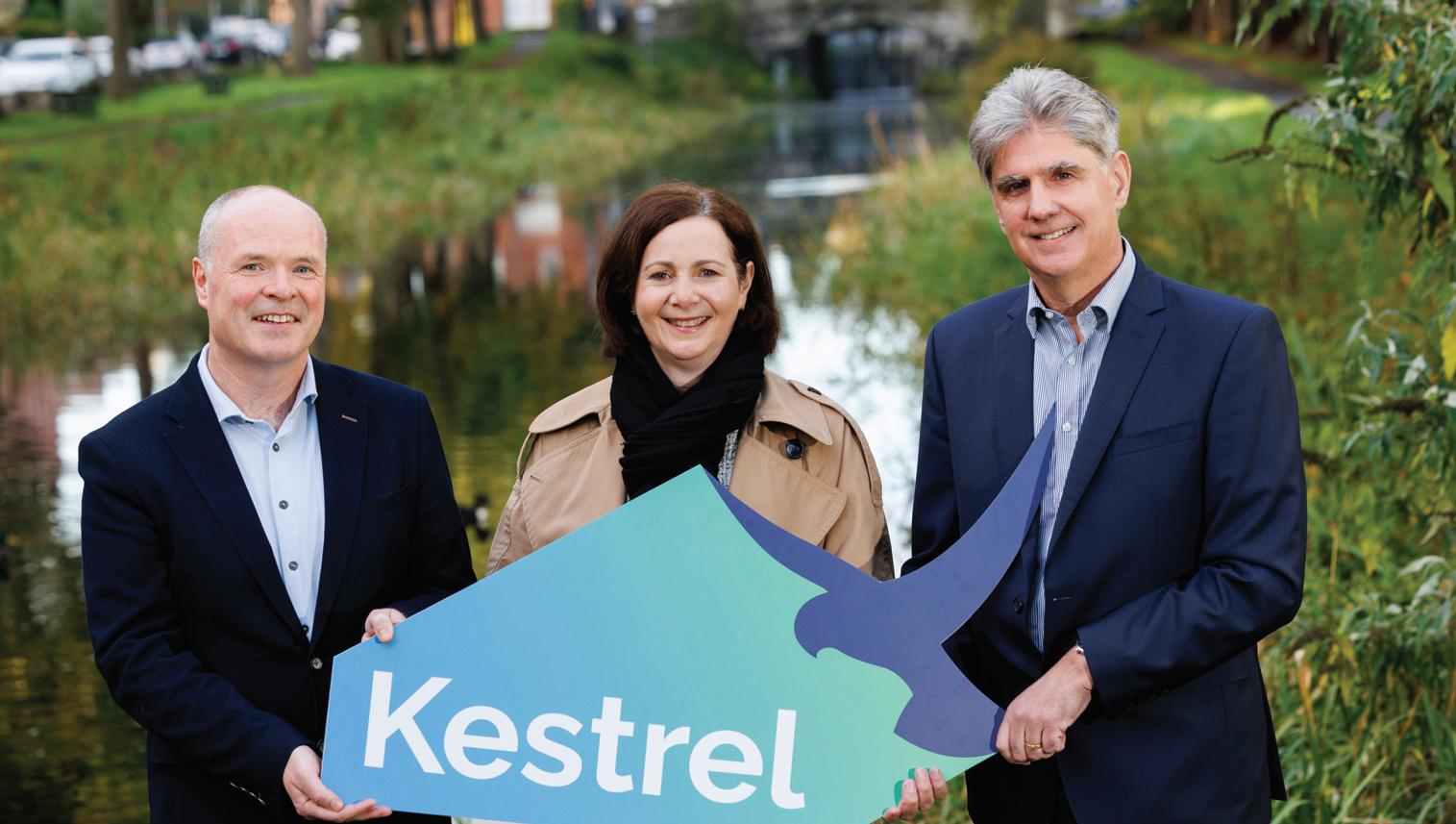
future storage of green hydrogen. The assessment has highlighted one reservoir which can deliver 11TWh of natural gas storage or circa 3TWh of hydrogen storage. As modelled, both storage scenarios including the phasing of gas to hydrogen can support Ireland’s current security of supply dilemma as well its future decarbonisation pathway.
As a relatively isolated island nation on the western fringe of Europe with limited indigenous natural gas resources and a growing energy appetite, Ireland’s people and economy are exposed to an energy supply shock. Large scale energy storage, as has existed here before can be the mitigation to this issue.
In addition, such large-scale energy storage is also required to catalyse other national energy initiatives such as offshore wind and biogas development if Ireland is to fulfil its zero carbon energy goals.
Dave Kirwan, Managing Director, Bord Gáis Energy agrees: “Decarbonising Ireland’s energy system while maintaining security of supply is critical in the context of our growing economy.
“As we help to deliver the green transition, there will be an everincreasing role for gas and ultimately green hydrogen and we are delighted to partner with ESB and dCarbonX and deliver the infrastructure for a greener future.
“Together with the support of Centrica, we have the skills, vision and financial backing to help Ireland achieve its ambitious Climate Action Plan targets.”
For further information visit: www.h2kestrel.ie


As an enabler of the publication of Energy Security in Ireland to 2030, in November 2023 the Government released a research paper examining the security of Ireland’s gas supply arguing that there is a need for both demand reduction and the introduction of “a strategic gas emergency reserve”.
Essentially a complication existing energy policies which can contribute to increased gas security of supply, Securing Ireland’s Gas Supplies, a research paper published by the Department for the Environment, Climate and Communications, emphasises the importance of reduction of demand, already a key pillar under the Climate Action Plan
Under the Climate Action Plan, the State is obliged to produce 2GW of new flexible renewable gas-fired power generation, with natural gas to be used as a backup in times of low renewable production.
Also, through the aegis of the Climate Action Plan, the Government is committed to phasing out and ending the use of coal and peat in electricity generation, meaning that natural gas will continue to have a significant role in power generation in this decade.
Further key to demand reduction is the acceleration of the delivery of renewables. The research paper reaffirms the State’s commitment to delivering energy via onshore wind, offshore wind, and solar through a competitive framework for said renewable sources to account for 80 per cent of electricity demand from renewable energy by 2030.
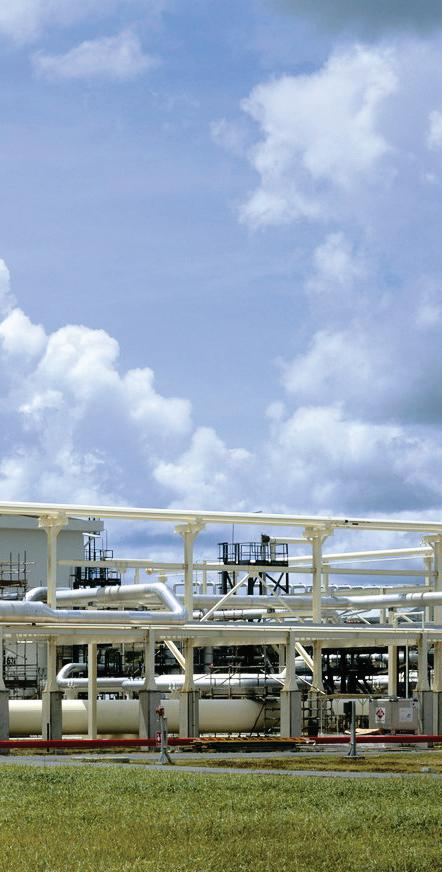
“The addition of further renewables will place downward pressure on net demand for gas, particularly as large volumes of offshore wind connects at the end of this decade,” the paper states.
Another key enabler of reduction of gas demand comes from the Government’s efforts to change the source of home heating in urban areas, namely through retrofitting of homes with heat pumps and through the proposed establishment of district heating.
Under the National Retrofit Programme, the Sustainable Energy Authority of Ireland (SEAI) is tasked with the delivery target of retrofitting 500,000 homes by 2030, the installation of 400,000 renewable energy heat pumps in existing premises by 2030, in addition to only renewable energy heating systems in new dwellings from 2023. The research paper asserts that the retrofitting programme has already delivered a reduction in residential
natural gas connections and that retrofitting measures will “continue to increase the energy efficiency of our housing stock, deliver the commitment to phase out gas boilers and thereby contribute to putting downward pressure on overall gas demand overtime as well as peak day gas demand”.
In tandem with retrofit objectives is the establishment of large-scale district heating, with existing targets of up to 0.8TWh by 2025 and 2.7TWh by 2030, across residential, commercial, and public sector buildings using waste heat or renewable energy sources.
“This [district heating] will have a positive impact on the efficiency of natural gas used and put downward pressure on net gas demand by providing alternative energy sources,” the research paper says.
On establishing how heat for commercial buildings can enable gas demand reduction, the research paper outlines the potential of alreadypublished targets via measures such as a ramp-up of zero emissions heat and district heating in commercial buildings, accelerating uptake of alternative fuels, blending in zero-emission gas and decreasing embodied carbon in construction materials.
“The National Heat Policy Statement… as well as the Renewable Heat Obligation… will accelerate transition to renewable heat, incentivising switch for industrial energy demand from gas to renewable electricity. These measures will contribute to limiting upward pressure on gas demand, while work is ongoing to develop further measures to effectively target harder to abate industry sectors,” the paper says.
There are a number of active policy and operational decisions that will impact average gas demand.
Looking beyond 2030, MaREI Centre of University College Cork (UCC) has examined the role of natural gas in the energy transition consistent with the
State’s carbon budgets up to the period to 2050 across a number of scenarios.
Uncertainties remain when forecasting trends, particularly beyond 2030 given the many variables that exist, however, MaREI has outlined demand projections in a ‘high demand scenario’, which refers to strong growth in electricity demand, as well as a ‘lower demand scenario’, which refers to high renewable electricity capacity and lower electricity demand growth.
While the MaREI research illustrates there may be varying level of natural gas demand in the early 2030s, a similar pattern is observed in terms of level of gas demand consumed in 2040 and 2050 period. Natural gas demand sees a significant reduction of between 68 per cent and 78 per cent from 2030 to 2040, depending on the scenario considered.
MaREI asserts that these projections demonstrate “the significant reduction of natural gas use anticipated, reducing the reliance on imports during this period and its limited role in our energy system as we reach 2040”.
While the rollout of renewable and new heating sources are key to demand reduction, the paper acknowledges that LNG will continue to be required in the immediate decade to come. This presents a challenge to the demand reduction objective as Ireland’s indigenous gas supplies are becoming depleted.
In 2022, 26 per cent of Ireland’s gas demand was supplied from indigenous sources – the Corrib gas field and small volumes of biomethane. The balance of supply, 74 per cent, was met from the UK via Moffat in Scotland. Ireland does not have any gas storage or liquefied natural gas (LNG) facilities. GNI is currently carrying out enhancements to the UK facilities to increase the system’s ability to meet peak day demand.
Under existing targets, the pipeline systems in the UK are expected to be
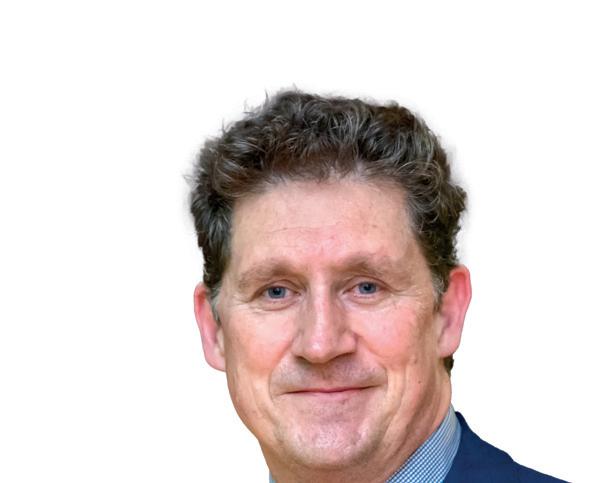
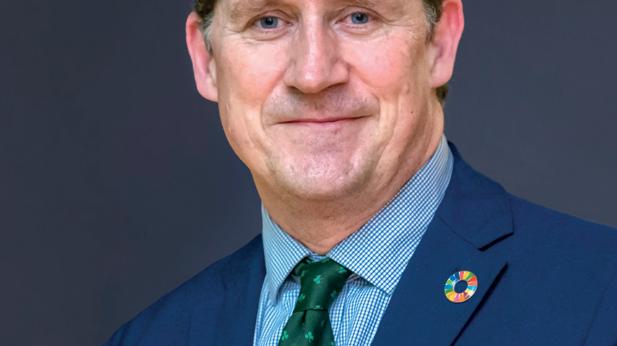
Minister for the Environment, Climate and Communications, Eamon Ryan TD
able to be operated independently of each other from 2024/25, although it will remain that there are points where they are physically adjacent to each other. The pipelines themselves are entirely separate, however, an existing constraint relates to a common pipeline header in the Brighouse Bay compressor station, which will be separated.
In addition to the establishment of new pipelines, Energy Security in Ireland to 2030, outlines that there is a need for storage. While the State maintains 90 days of oil reserves at all times, there is currently no mandatory LNG storage.
While research in Energy Security to 2030 has found that current supplies and infrastructure are adequate to meet demand projections, it nonetheless warns that any future disruption could “impact heavily on energy security” and that “there is a need to introduce a strategic gas emergency reserve”.
Stressing that reserves would be used only if a disruption to gas supplies occurs, Energy Security in Ireland to 2030 says that it is anticipated that floating gas reserve (FSRU) will best meet the needs of the criteria set by government. Gas Networks Ireland has been tasked with returning a detailed proposal to Government for final approval in 2024.
Minister for the Environment, Climate and Communications
Eamon Ryan TD has said: “A range of initiatives are in place and in development to improve energy efficiency and increase demand flexibility, as important enablers of a more secure energy system.
On the Energy Security to 2030 energy security strategy, Ryan says: “This package… is centred on continuing progress and action. It will strengthen Ireland’s approach to risk and resilience, taking an integrated, systemic, medium-term view of where we can do more and how.
“It is an important contribution to a more secure, sustainable, and affordable energy system for Ireland and I will drive its rapid and comprehensive implementation.”
“This package… will strengthen Ireland’s approach to risk and resilience, taking an integrated, systemic, medium-term view of where we can do more and how.”
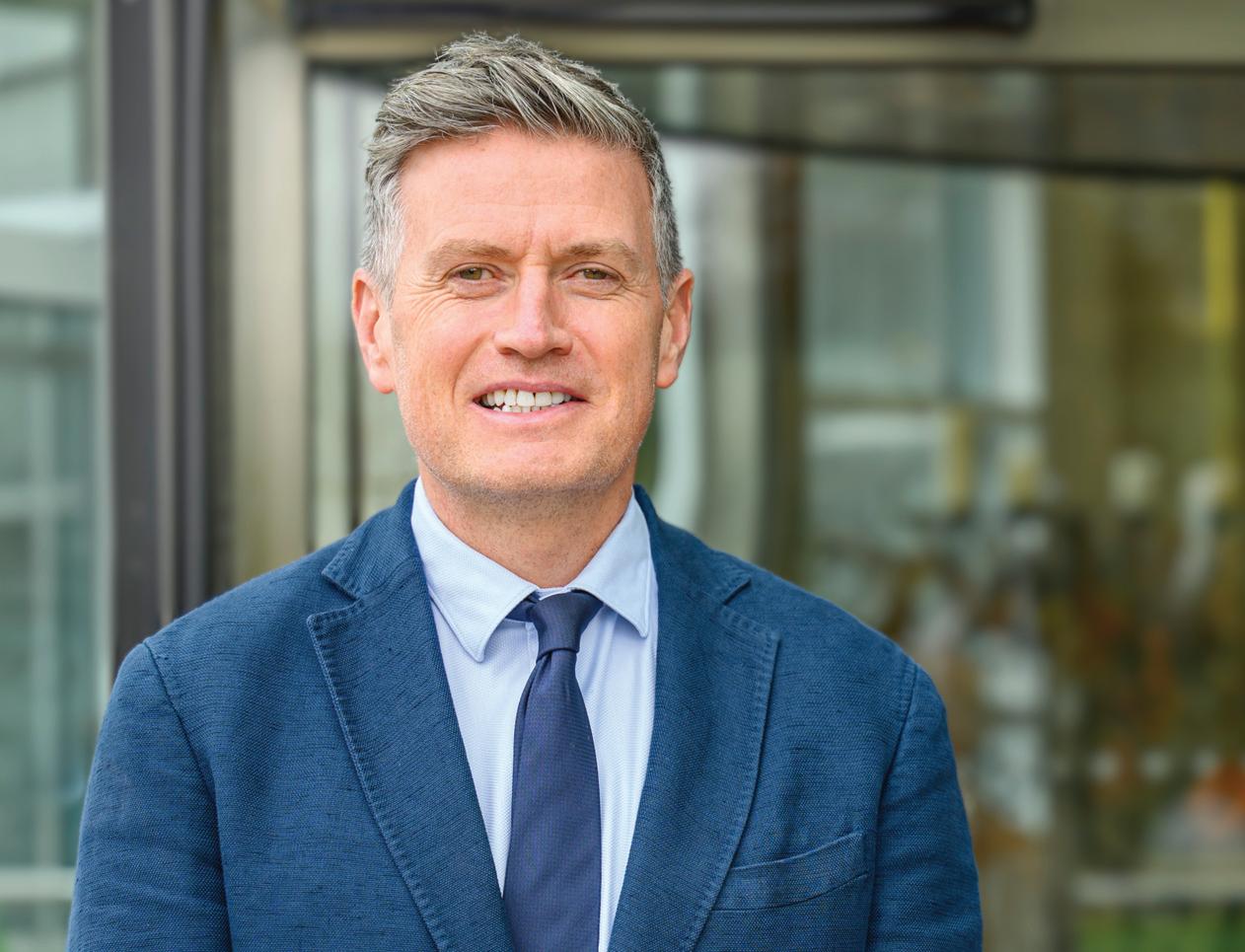
Following the publication of the National Biomethane Strategy, Barry Quinlan – whose remit as Assistant Secretary at the Department of the Environment, Climate and Communications (DECC) includes heat policy – outlines the ambition to develop a sustainable biomethane industry of scale by 2030.
In the National Biomethane Strategy, the Government has committed to supporting the delivery of up to 5.7TWh of indigenously produced biomethane by 2030, a significant increase on the 75 GWh per annum currently produced.
The scale of the transformation required is better illustrated by the need to move from an equivalent of 0.001 per cent of the current gas demand, to at least 10 per cent of national gas demand by 2030.
Quinlan was speaking in the context that increased biomethane production and use makes up one of three priority areas for DECC in efforts to decarbonise Ireland’s buildings and heat demand, alongside an extensive
retrofitting programme, and a desire to grow district heating.
Highlighting that the State currently has only a handful of operational biomethane facilities, with only two injecting into the gas grid, Quinlan says that a more than trebling of the previous biomethane target outlined in Climate Action Plan 2019 will require the construction of between 140 to 200 new anaerobic digestion facilities.
Prior to the National Biomethane Strategy, the National Heat Study examined bioenergy resources in Ireland, and identified biomethane as “a competitive, cost-efficient, path to decarbonising sectors with a high thermal heat demand”.
Quinlan explains that the State’s promotion of a biomethane production increase is multifaceted. While increased production will facilitate the displacement of fossil fuels, and reduce emissions in the heat sector, it will also strengthen energy security and, importantly, reduce emissions in the agriculture sector.
Historically, across Europe, AD was developed to produce biogas which in turn was used to generate electricity. However, this is now seen as an expensive way to generate renewable electricity, and the Assistant Secretary emphasises the consensus that biomethane resources be principally used in sectors where no alternative decarbonisation options exist; such as high temperature heat processes.
To this end, Quinlan highlights that the strategy has been co-delivered by the Department of Agriculture, Food and the Marine and DECC, to ensure it fully supports an “agri-centric, environmentally sustainable biomethane industry”, with lessons taken from a trend across Europe to utilise limited bio-resources to generate biomethane and decarbonise high temperature heat, gas grids in general, and the transport sector.
Focusing specifically on the UK and the Netherlands, where massive expansions in biomethane production were achieved in a relatively short 10-year time frame, he believes that all the evidence points to Ireland’s ability to achieve the 5.7 TWh by 2030 target.
“Given the need to swiftly stimulate the industry, the provision of capital grants and the Renewable Heat Obligation, alongside industry investment will put Ireland on a trajectory to meet its 5.7 TWh target by 2030,” he says.
Concluding, Quinlan explains that a Biomethane Sustainability Charter, scheduled to be published in Q3 2024, will help ensure the successful roll-out of an “agri-led biomethane industry”, and protect against unintended negative consequences.
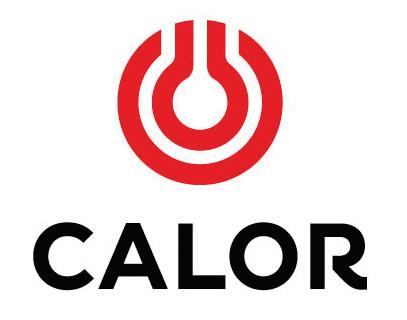
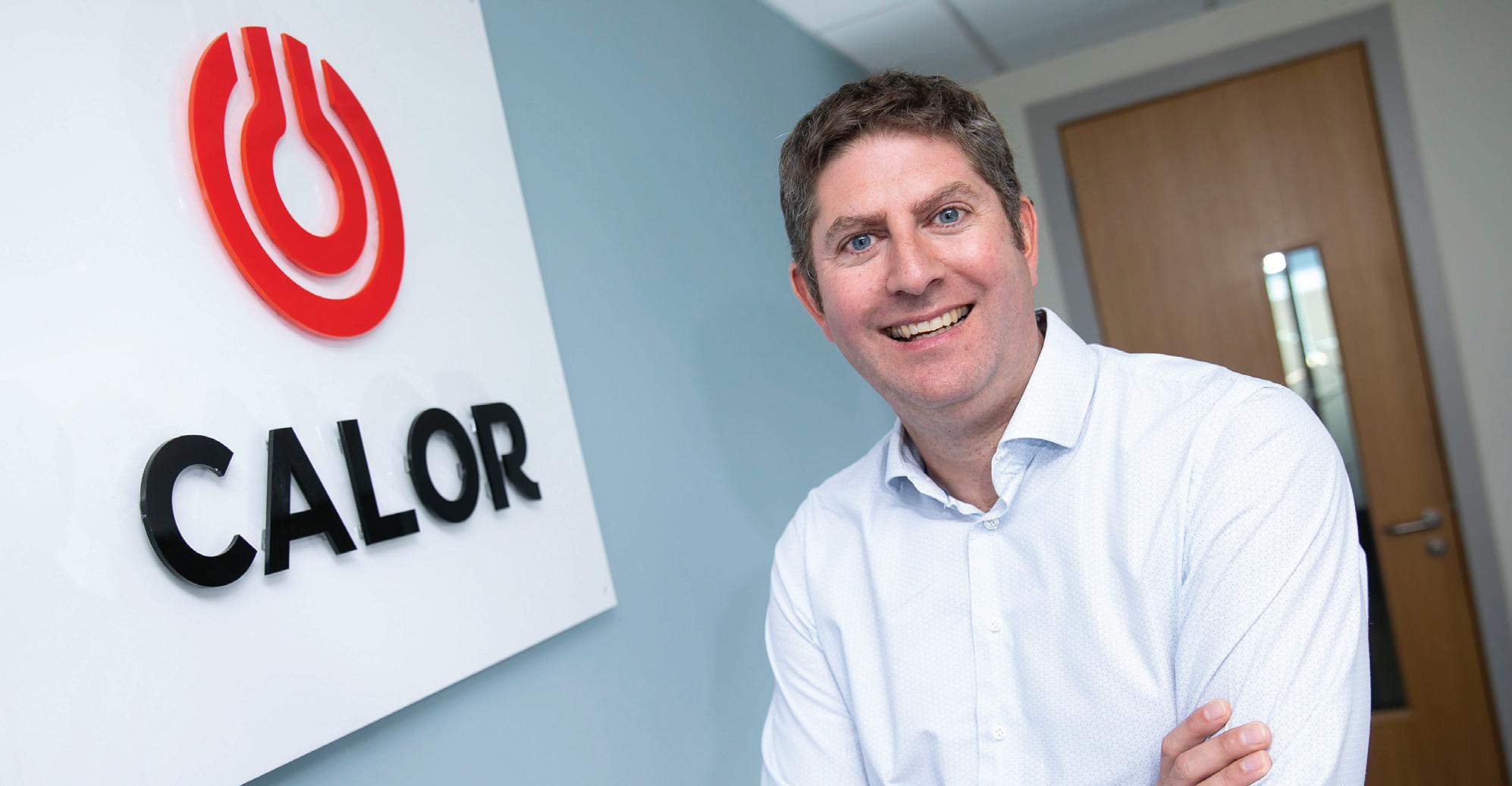
To make sure that everyone can play their part in Ireland’s energy transition, Duncan Osborne, CEO of Calor, explains the critical need for current and future government policy to integrate LPG, BioLPG, and future sustainable options such as rDME into planning in order to support households and businesses to access affordable, mixed technology renewable energy sources.
Ireland has made clear and ambitious commitments to reach net zero by 2050 in the Government’s Climate Action Plan. We stand at a key moment in the journey to meeting our climate targets. To do so, our policy solutions need to reflect the full range of alternative fuels such as LPG and renewable energy fuels such as certified BioLPG, which are actively contributing to heat decarbonisation and providing renewable energy options for
households and businesses across the country. Not doing so risks leaving a significant cohort behind on the path to meeting our climate objectives.
Recent data underscores the urgency for a range of solutions: lower than expected uptake of retrofitting, increased oil usage by households, and businesses under pressure to become more sustainable but prohibited by cost.
Research shows that many homes and businesses risk being left behind in the move to renewable heating. A recent report by Liquid Gas Ireland (LGI) analysing census data showed that 46 per cent of all Irish households still rely on high carbon fuels such as oil, peat and coal for heating. Between 2016 and 2022, the number of households using oil increased by 28,173 to 714,177.
We know that Ireland has a large percentage of older housing stock – 65 per cent of all households were built before 2001 – equating to 1.2 million homes in Ireland that are typically less energy efficient and more costly to heat. Transitioning to a renewable energy source is costly – with the average cost of a deep energy retrofit ranging from €25,000 to €70,000 – and simply not accessible to many people.
Many businesses are keen to play their part and transition to lower carbon and renewable energy sources. Research released by Calor earlier this year showed that almost half (46 per cent) of the manufacturing and production businesses surveyed said that they are experiencing ‘a lot of pressure’ to become more sustainable. However, cost and access remain a key barrier here also.
There are solutions. We can optimise our energy options and ensure the availability of a mixed technology approach – with a suite of alternative and renewable energy choices – so that no one is left behind on the journey to a sustainable future. Options such as lower carbon LPG, BioLPG and rDME (renewable dimethyl ether) are key parts of this solution. Calor BioLPG is a proven, renewable energy solution, produced from a blend of sustainably sourced waste materials and renewable vegetable oils which makes it an efficient and cleaner choice for businesses and households.
Continuing innovation has led to the development of future sustainable options such as rDME (renewable dimethyl ether), a low-carbon, sustainable, liquid gas, which is made from a wide range of renewable and recycled carbon feedstock (including waste streams) and has the potential to decarbonise heat. These fuels also offer a significant reduction on NOx, SOx and particulate matter (PMx) emissions compared to other off-grid fuel sources, having a positive impact on air quality. Ireland has committed to making sure that vulnerable households and communities are not disproportionately burdened by the changes required by climate action. In Calor, we are focused on how we can best play our part in helping to meet the critical challenges of combatting climate change and how we
“We need all our renewable energy options on an equal footing to best support consumers, with parity of government support for all renewable fuels.”
Duncan Osborne, CEO, Calor
can help make sure that it is a just transition for everyone: one that is equitable, fair and leaves no one behind.
Later this year, Ireland will see its first Renewable Heat Obligation (RHO) come on stream. This will play a crucial role in driving forward our energy sector to a high-renewable, low-carbon system, and improve energy security by diversifying energy streams. It will require fuel suppliers in the heat sector to ensure that a portion of the energy they supply comes from renewable sources. A core part of the new RHO is to help meet EU heat decarbonisation targets, and imported biofuels such as BioLPG – that meet the most stringent criteria as set out under the EU Renewable Energy Directive – will play an essential part in meeting these targets. Ireland has a key role to play in this. We have the potential to be a larger, significant source of indigenous feedstocks for European BioLPG production, building on the recent success of Irish-produced waste returning as BioLPG.
A multi-optioned approach to renewable energy is needed to help households and businesses to transition to renewable energy sources. In Calor, we stand ready to support communities across Ireland, particularly those that are in rural areas without access to the natural gas grid. BioLPG is integral to this transition as a well-established renewable energy source. For example, the National Oil Reserves Agency (NORA) RTFO Annual Report for 2023 shows that BioLPG had the lowest weighted average GHG emissions (4.7 gCO2e/MJ) of all the biofuels placed onto the Irish transport market in 2023.
We need to see a level playing field for all renewable fuels as potential energy transition solutions, including support for off-grid fuels. Calor welcomed the recent
publication of Ireland’s National Biomethane Strategy, and acknowledge the vital, complementary role that BioLPG has to play alongside biomethane and biomass in meeting new biomethane ambitions (5.7TWh by 2030) and helping mostly rural and off-grid businesses and homes to move to renewable energy use and heat decarbonisation. BioLPG has been successfully adopted and used by heating consumers, both domestic and business. Its key benefits are that it is a drop-in solution that requires no equipment changes and can be blended.
It is essential that new obligations such as the RHO does not put undue pressure on rural off-grid consumers that may be at risk of fuel poverty. We need all our renewable energy options on an equal footing to best support consumers, with parity of government support for all renewable fuels.
Energy needs are changing in Ireland and our strategic policy priorities must evolve to deliver the energy solutions that are required.
Calor welcomes the advancement of the work of the Just Transition Commission and its critical remit. It is only by integrating LPG, BioLPG and rDME into current and future government policy, ensuring a mixed technology approach is on offer, and supporting a wider choice of viable options for homes and businesses off the natural gas grid, that we can effectively ensure that delivery on a green transition does not leave anyone behind.
T: 01 450 5000
W: www.calorgas.ie


Amid energy security challenges, MaREI Director and Associate Vice-President of Sustainability at University College Cork (UCC), Brian Ó Gallachóir has recommended the establishment of an all-island gas storage plan.
Contextualising the development of all-island gas infrastructure – and indeed electricity infrastructure – in Ireland, Ó Gallachóir references the peace process and Good Friday Agreement as having had a catalytic effect in advancing the development of said infrastructure on an all-island basis.
“Five years after the Agreement was signed, the Allisland Energy Market Joint Steering Group (JSG) was established, and that was followed by a number of significant developments including a memorandum of understanding between the regulators, the system operator agreement between EirGrid and SONI as transmission operators, and the common arrangements for gas,” he observes.
However, this early progress subsequently stalled following the transition from the all-island Single Electricity Market to the Integrated Single Electricity Market (I-SEM) in 2018. Explaining the reversed fortunes now facing all-island energy infrastructure, Ó Gallachóir emphasises the role of Brexit, and the subsequent increase of electricity prices.
As a consequence, Ó Gallachóir says, the two jurisdictions in Ireland have become more insular in framing their respective energy security policies. For instance, the Government’s Energy Security in Ireland to 2030 policy document highlights the need for gas
storage to assist with balancing the electricity system while overlooking an existing license for gas storage in salt caverns at Islandmagee, County Antrim.
“From my perspective, we have seen a period where the eye has been taken off the ball – due in part to Brexit and periods of absence of a Northern Ireland Executive – to progress all-island energy security,” he observes.
Given that the most recent projections from EirGrid and SONI illustrate capacity deficits in electricity generation in coming years – particularly in medium- and highdemand scenarios – there is an imperative to avoid reliance on emergency generation capacity in the context of ambitious climate targets.
To date, gas has served as a backbone to electricity generation – acting as a stepping stone in the transition away from oil and coal – while increasing renewable energy generation, such as offshore wind and solar PV, comes onstream.
In this context, Ó Gallachóir advocates for “refreshing the All-island Grid Study” as a useful mechanism to ensuring an all-island focus on the shared ambition of a net zero power system by 2035. “That focus should also be turned to exploring the gas storage potential on an all-island basis,” he concludes.


, the European Commission states that €18 billion has been spent in helping the EU meet its biomethane targets.
Under REPowerEU, The EU’s biomethane production, either as biogas or its upgraded version, needs to reach 35 billion cubic metres (bcm) per year by 2030 and the estimated investment need for the period amounts to €37 billion. Industry reports €18 billion investment mobilisation by February 2024.
The Biomethane Industrial Partnership (BIP) was launched on 28 September 2022 and aims to support the achievement of the EU’s 2030 target of 35 bcm annual production and use of sustainable biomethane and to create the conditions for a further ramp-up of its potential by 2050.
Biomethane and biogas production is increasing at significant pace, however, based on projections in EU member states’ latest draft updated national energy and climate plans, biogas and biomethane production is currently set to reach a cumulative range of between just 30bcm and 32bcm by 2030.
To reach the 2030 target, the Commission presented in May 2022, a Staff Working Document, accompanying REPowerEU, outlining a number of actions which could be taken to unlock the potential of biogas and biomethane across the EU.
The proposed actions aim at “expanding the production of biogas to a sustainable volume which can be upgraded into biomethane” and promoting biomethane production from waste and residues, rather than from food and feedstocks, which can lead to land use change-related issues.
By the end of 2024, under the Waste Framework Directive (2008/98/EC), all EU member states are mandated to collect organic waste separately.
The revised Renewable Energy Directive broadens the scope of the fuel supply obligation to cover all uses of biomethane and the Commission’s recommendation on permitting for renewable energy projects should also accelerate new biogas and biomethane investments.
Ireland has taken its first steps towards contributing to the EU’s biomethane targets with the establishment of emissions reductions targets under the aegis of the Climate Action Plan, as well targets outlined in the newlyannounced National Biomethane Strategy. Under the strategy, the Government is committed to supporting delivery of up to 5.7TWh of indigenously produced biomethane by 2030.

Ireland must seize the opportunity to create a sustainable biomethane industry in order to meet its climate targets, writes Kevin Fitzduff, Managing Director of Stream BioEnergy.
In the evolving landscape of renewable energy, biomethane is rapidly gaining traction as a sustainable and versatile energy source. Among the frontrunners in this burgeoning sector is Stream BioEnergy, a company with ambitious plans to build large-scale waste biomethane plants across the island of Ireland.
These facilities will convert organic waste into renewable gas, offering sustainable energy generation while addressing waste management challenges. These projects represent not only a significant investment in Ireland’s renewable energy infrastructure but also a crucial step towards the nation’s energy independence and carbon neutrality goals.

Dublin-based Stream BioEnergy operates biogas projects in Northern Ireland and Britain that utilise anaerobic digestion technology to convert organic wastes into renewable energy and nutrient rich biofertiliser. Stream’s first project in the Republic of Ireland will start construction in autumn 2024. Located in Little Island, County Cork, it will convert 90,000 tonnes of domestic and commercial food waste into biomethane to be injected into the gas grid.
Here, I outline Stream BioEnergy’s vision, the broader benefits of the biomethane sector, and the crucial role the Renewable Heat Obligation (RHO) must play in driving the industry to meet the Irish governments target of producing 5.7 TWh of indigenously produced biomethane by 2030.
benefits of biomethane: a closer look
While recent years have seen strong progress on the decarbonisation of the electricity sector other areas have lagged behind. The versatility of biomethane makes it an attractive option for hard-todecarbonise sectors, such as heavy industry, long-haul transport and older housing stock which are harder to electrify. Biomethane plays a critical role in reducing emissions from these sectors because it can directly replace natural gas in heating applications.
One of the most compelling benefits of biomethane is its contribution to environmental sustainability. Biomethane production utilises organic waste—such as agricultural residues, animal manure, and food waste—that would otherwise decompose and emit methane, a potent greenhouse gas. By capturing this methane for energy production, biomethane plants significantly reduce greenhouse gas emissions.
In fact, biomethane is considered a carbon-neutral fuel because the carbon dioxide released during its combustion is offset by the carbon dioxide absorbed during the growth of the organic material used to produce it.
Moreover, the other products of the anaerobic digestion process are nutrientrich bio-fertilisers, closing the loop in a truly circular economy. This process not only reduces reliance on chemical fertilisers, which are energy-intensive to produce and contribute to environmental degradation, but also enhances soil health, promoting sustainable agriculture.
Energy security and independence
Ireland has historically been dependent
on imported fossil fuels to meet its energy needs, making the country vulnerable to volatile global energy markets. Biomethane presents a viable solution to this challenge by providing a domestically produced, renewable energy source. As Stream BioEnergy’s plants come online, they will inject biomethane into the national gas grid, reducing Ireland's reliance on imported natural gas.
The development of a robust biomethane sector offers significant economic benefits for Ireland. The construction and operation of biomethane plants will create jobs, supporting local economies and contributing to regional development. A significant portion of the capital investment will be spent on local services. Jobs will span a range of roles, from plant operations and maintenance to logistics and feedstock supply, offering opportunities in both skilled and semiskilled positions.
Heating is one of the most challenging sectors to decarbonise, particularly in industrial and commercial applications. Biomethane, with its ability to replace natural gas in existing infrastructure, offers a practical solution to this challenge. There has been little growth in Irelands biomethane sector to date due to the lack of government supports but the Renewable Heat Obligation (RHO) is poised to change that.
The RHO, which is due to be published in autumn 2024, is a policy mechanism that mandates heat suppliers to source a percentage of their energy from renewable sources. It will significantly
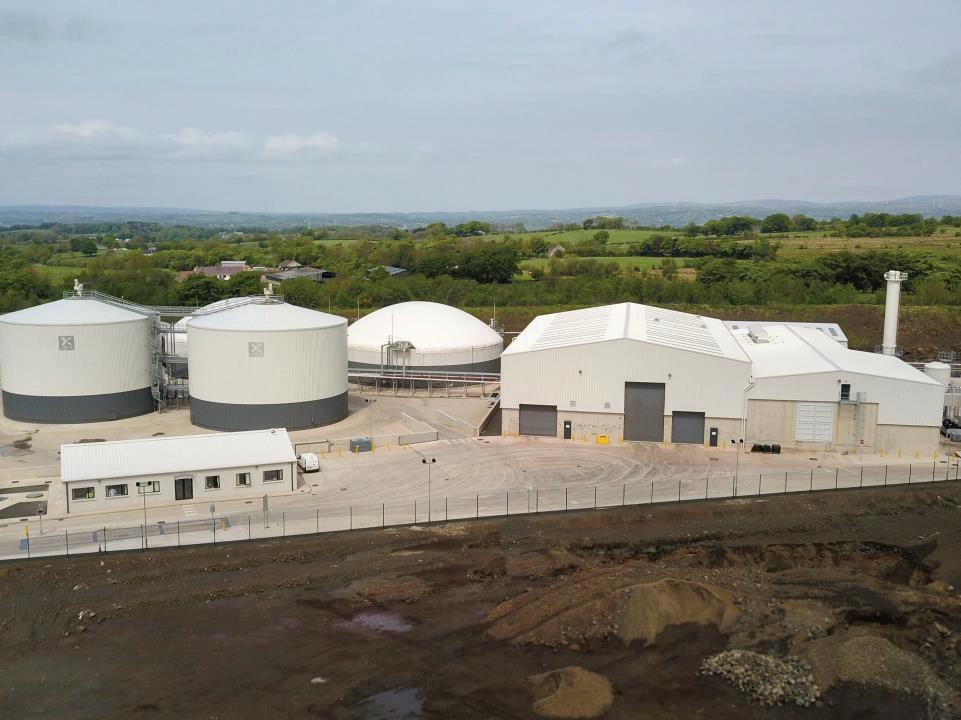
increase the demand for biomethane as heat suppliers seek to meet their renewable energy targets. This will provide a stable market for biomethane, encouraging Stream BioEnergy and other producers to invest in new plants and infrastructure.
It is expected that the RHO will significantly increase the demand for biomethane as heat suppliers seek to meet their renewable energy targets. In order to attract both the domestic and international investors required for the expansion of the biomethane sector and to bring new projects to fruition, the RHO must create a stable market for biomethane sales at a viable price level.
For companies like Stream BioEnergy, the RHO represents both an opportunity and a catalyst for growth, enabling them to scale up their operations and contribute significantly to Ireland's transition to a sustainable energy future.
“Biomethane could become a cornerstone of Ireland’s renewable energy portfolio...”
Kevin
Fitzduff,
Managing Director, Stream BioEnergy
Stream BioEnergy’s initiative to develop biomethane plants across Ireland is not just a business venture; it is a significant contribution to Ireland’s energy transition. Stream BioEnergy is implementing an extensive plan to establish multiple largescale biomethane plants across Ireland. By focusing on biomethane, Stream BioEnergy is helping to build a sustainable energy system that aligns with Ireland’s environmental and economic goals.
The company’s projects will provide a scalable, renewable energy source that reduces greenhouse gas emissions, enhances energy security, and supports local development.
As these plants come online, they will represent a significant milestone in Ireland’s journey towards a low-carbon future. With the right policy support and continued investment, biomethane could become a cornerstone of Ireland’s renewable energy portfolio, driving the country towards a more sustainable, secure, and prosperous energy future.

For more information: W: www.streambioenergy.ie/
Thursday 14 November • Croke Park Dublin
The Renewable Energy Summit 2024 will provide a valuable opportunity to bring together the key stakeholders from across the energy sector, and those who interact with the energy sector to discuss how the contribution from renewable energy can be accelerated. The objective is to create a genuine in-depth understanding of the alternative paths open to Ireland in increasing the contribution from renewable energy sources. It will look at the challenges and opportunities including the planning system, the need for long term energy storage and the skills gaps impacting on the sector. It is the one event that brings together the renewable energy sector as a whole.
Sponsored by


Paul Lennon Head of Offshore Wind, Hydrogen & Long Term Storage ESB
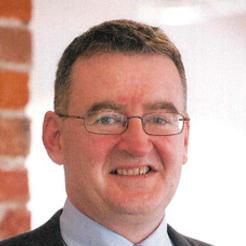
Conor O’Dowd CEO
The Port of Galway
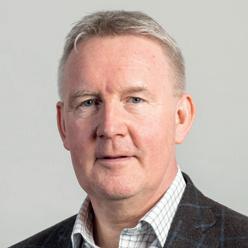
John Reilly Head of Renewable Energy Bord na Móna

Therese Murphy Business Development Manager Cornwall Insight Ireland

Andrew EdwardsJones Social Scientist Plymouth Marine Laboratory

J Owen Lewis Chair
IIEA Working Group on Climate and Energy

Catherine Banet Professor Scandinavian Institute of Maritime Law & Head of the Energy and Resources Law Department University of Oslo
Sponsorship & exhibition opportunities available! Full programme announced soon!
There are a limited number of opportunities to become involved with this conference as a sponsor or exhibitor. This is an excellent way for organisations to showcase their expertise and raise their profile with a key audience of senior decision makers from across Ireland’s renewable energy sector. For further information on how your organisation can benefit, contact Gail Kinkead on +353 (0)1 661 3755 or email gail.kinkead@energyireland.ie
To register:
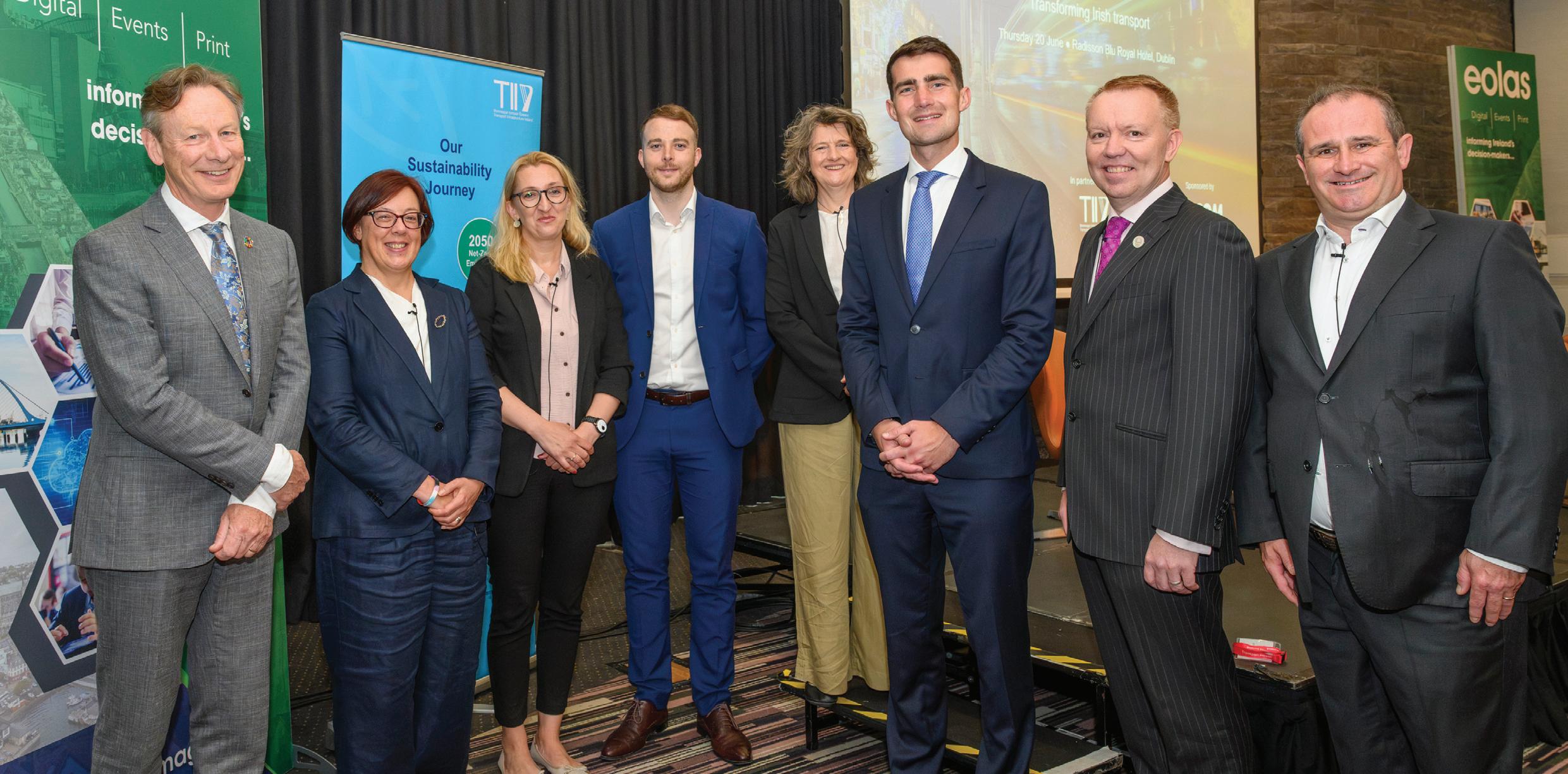
The 2024 Transport Ireland Conference recently took place in the Radisson Blu Royal Hotel, Dublin and brought together key stakeholders to explore the latest ambitions, challenges, and tangible opportunities for decision-makers to transform Ireland’s transport sector.
The top line up of expert speakers, both local and visiting included Jack Chambers TD, Minister of State, Department of Transport; Peter Walsh, Chief Executive Officer, Transport Infrastructure Ireland; Anne Graham, Chief Executive, National Transport Authority; Olev Parts, Senior Specialist of Public Transport, Tallinn Transport Department; Imogen Cotter, road safety advocate and former professional cyclist; and Brendan Murphy, Senior Statistician, Census Outputs, CSO.
We would like to take this opportunity to thank the 2024 Transport Ireland conference partner, Transport Infrastructure Ireland and sponsor, AECOM, all speakers, exhibitors, and delegates who joined us and made the conference a huge success.
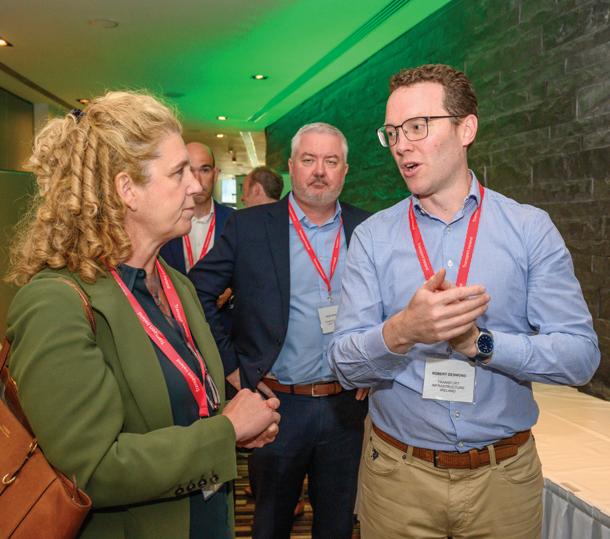
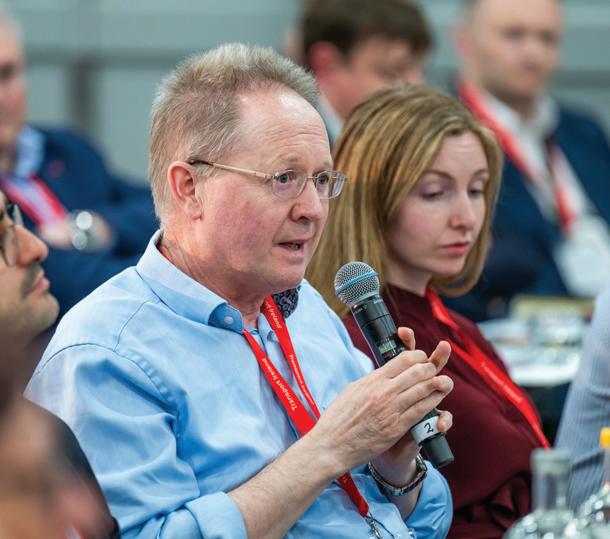

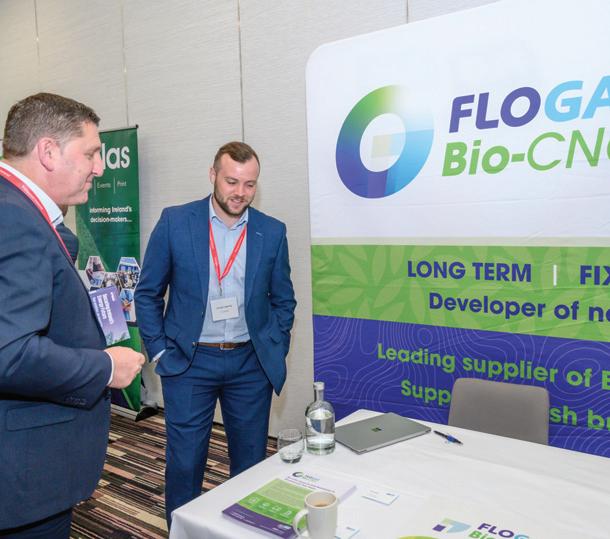
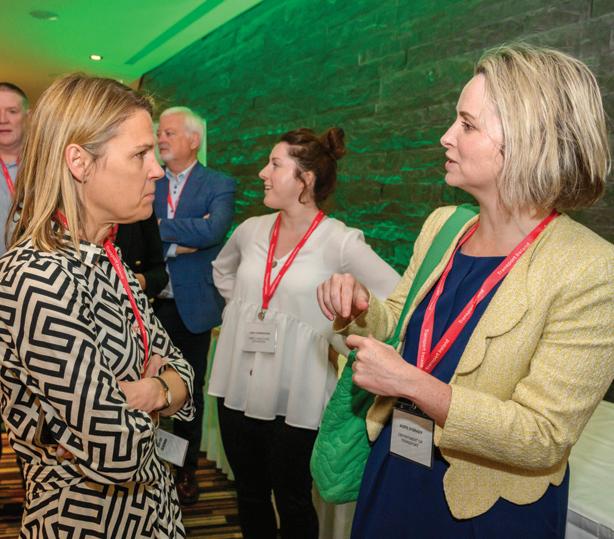
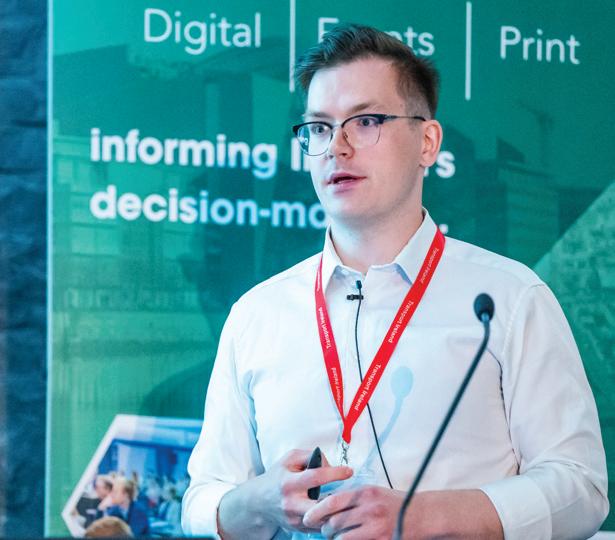

Located within the European Commission’s Directorate-General for Digital Services (DIGIT), the Big Data Test Infrastructure (BDTI) team explains how the BDTI can help European public administration to overcome socioeconomic challenges through the analysis of open data.
The European public sector faces increasingly complex socioeconomic problems that require innovative solutions. Big data and data-informed decisionmaking offer a pathway to better solutions, greater transparency, and enhanced trust in public administration. However, implementing these technologies requires skills, experience, and appropriate digital tools, which are often lacking.
To tackle these challenges, the European Commission launched the Big Data Test Infrastructure under the Digital Europe Programme in 2019. The BDTI aims to promote the reuse of public sector data and facilitate a data-informed public sector across EU member states. It provides public administrations with a comprehensive set of mainstream opensource tools for data storage, processing, and analytics, all hosted in the cloud and free of charge.
This service empowers civil servants at all government levels to conduct pilot projects independently, demonstrating the value of data in policymaking and administration. Public administrations can utilise the BDTI to prototype solutions before implementing them in live environments. The platform comprises open-source tools and necessary cloud infrastructure like virtual machines, analytics clusters, storage facilities, and networking capabilities. After completing a pilot project, users can transfer the source code and data to continue their work on their preferred cloud or other resources.
The BDTI offers a variety of tools to facilitate data-driven projects, including data storage and processing tools for handling large datasets, analytics tools for analysis and visualisation, and cloud infrastructure for running data-intensive tasks. Its open-source nature ensures flexibility, allowing public administrations to explore different solutions costeffectively.
Several public administrations have utilised and continue to use the BDTI to enhance decision-making processes. For example, the health service in the city of Valencia, Spain health service previously employed BDTI to apply text mining techniques for extracting valuable insights from health data. Similarly, the Norwegian Digitalisation Agency (Digdir) used BDTI to optimise public procurement processes through data analytics, while the city of Florence, Italy utilised BDTI to understand the impact of Covid-19 on the city through data analytics.
Currently, numerous public administrations are leveraging BDTI. For instance, the University of Macedonia in Thessaloniki, Greece transformed data gathered through the Greek National Registry of Administrative Public Service (MITOS API) into linked data aligned with the EU standard model to support more public services. The city of Bochum, Germany is using BDTI to analyse the

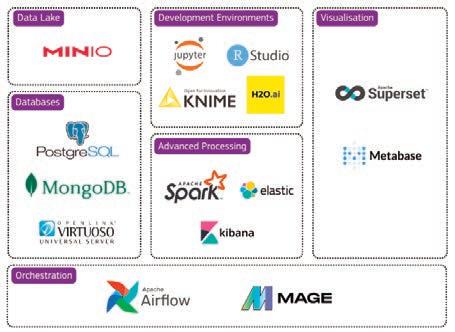
health of trees, providing valuable insights for urban planning and environmental management. Additionally, the city of Naples is employing BDTI to collect data related to public spaces and mobility, streamlining citizen participation, and creating a transportation dataset tailored for public administration in compliance with the open data directive.
Additionally, the BDTI website highlights various use cases, such as the search analytics project based on the CORDIS open dataset, which shows how data can be used to enhance search functionalities. Another example is the low code analytics project that utilises the EMHIRES dataset, focusing on solar power generation, to illustrate the application of low code solutions in data analytics.
To further support public administrations, the BDTI team has developed a BDTI Essentials course, available for free. This course consists of five one-hour webinars, targeting public administration officials to help them better understand how to use the BDTI with concrete examples. This educational resource aims to build the necessary skills and knowledge to effectively leverage the BDTI for data-driven projects.
Additionally, the BDTI team has recently launched a new online course in collaboration with the interoperability academy, to help public sector actors advance their data literacy journey and understand how BDTI can help shortcut their data maturity efforts.
In line with their commitment to inclusivity, the BDTI team has also taken the initiative to translate key BDTI materials into the 24 European official languages. This effort allows individuals
“The BDTI represents a significant step towards a datainformed public sector in the EU.”
from diverse linguistic backgrounds to fully understand and engage with the content.
Public administrations interested in using the BDTI can subscribe to the join up page or to The BDTI Kitchen: Baking Data Stories newsletter for updates on future events and initiatives.
The BDTI represents a significant step towards a data-informed public sector in the EU, offering public administrations the tools and infrastructure needed to harness the power of big data.
Through pilot projects and real-life use cases, the BDTI demonstrates the transformative potential of data analytics in improving public services and policymaking. By enabling experimentation and innovation in a cost-effective manner, the BDTI helps public administrations overcome data challenges, fostering a more transparent, efficient, and trustworthy public sector.
Are you a civil servant interested in developing your own use case on the BDTI or a student and researcher eager to support a public administration?
Apply for a BDTI pilot project here or reach out to the team. E: EC-BDTI-PILOTS@ec.europa.eu
Fourteen MEPs have been elected to represent Ireland in the European Parliament, including five first-time MEPs. Broadly, the election was characterised by resurgent performances for Fine Gael and Fianna Fáil, with Fianna Fáil securing its best European election results since 2004.
Barry Andrews MEP
Fianna Fáil –Renew Europe

Elected for a second term to the European Parliament, Andrews, a former TD for the Dún Laoghaire constituency, is also the new chair of the European Parliament’s Development Committee and has taken a special interest in foreign and diplomatic affairs, advocating for Palestine, observing the 2023 Nigerian elections, and establishing the Brussels-Belfast Forum with members of the Northern Ireland Assembly. In 2023, he was awarded The Parliament Magazine’s Defence, Security and Space Award.
Regina Doherty MEP
Fine Gael –European People’s Party

Regina Doherty’s election is her first as an MEP, in a career which has taken her through Meath County Council, the Dáil, and the Seanad. Doherty was a TD in Meath East from 2011 to 2020 when she lost her seat. Immediately appointed by Taoiseach Micheál Martin to the Seanad following her seat loss, Doherty led Fine Gael in the upper house and was the leader of the Seanad between 2020 and 2022. She replaces Frances Fitzgerald as Fine Gael’s Dublin MEP following Fitzgerald’s retirement from politics.

Sinn Féin – The Left
Returning to the European Parliament after a fiveyear absence is Sinn Féin’s Lynn Boylan. Boylan, a Tallaght native, was previously a Dublin MEP between 2014 and 2019. After losing her seat in 2019, she was subsequently elected to the Seanad, before deciding to run for the European Parliament again in 2024. Her election was a highlight for Sinn Féin in what was a broadly underwhelming performance.
Labour Party –Socialists and Democrats
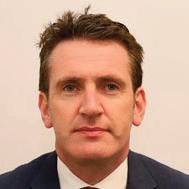
Aodhán Ó Ríordáin was elected to the European Parliament for the first time in the recent election, winning Labour’s first European seat since it was wiped out in 2014. Ó Ríordáin has been in politics since 2002, when he sat on Dublin City Council. A former teacher with 11 years of experience, Ó Ríordáin has served two Dáil terms and one term in the Seanad. In 2020, Ó Ríordáin was narrowly defeated in a Labour leadership contest, losing out to Alan Kelly TD.

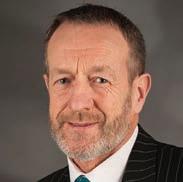
Fine Gael –European People’s Party
Elected for a fourth term in the European Parliament, Séan
Kelly is Fine Gael’s European Parliament leader and Ireland’s longest-serving MEP, having been an MEP since 2009. A latecomer to politics, Kelly, 72, was president of the GAA between 2003 and 2006, becoming the first Kerry native to assume the role. This followed a long career as a teacher along with volunteering within Kerry GAA. He is a member of the European Parliament’s Committee on Industry, Research and Energy.
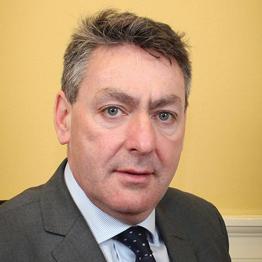
Fianna Fáil –Renew Europe
Billy Kelleher was elected to a second term as an MEP in the recent election.
The Cork native is a former farmer and a political veteran, having been a TD in Cork NorthCentral from 1997 to 2019 and a Senator between 1993 and 1997, during which time he served two brief stints as a Minister of State. Since being re-elected as an MEP, Kelleher has become the First Vice President of the Renew Europe Group in the Parliament, a centrist, liberal group.
Independent –Renew Europe

Michael McNamara has been elected to the European Parliament for the first time. McNamara was elected as an independent, having previously served as a Labour TD between 2011 and 2016. During his spell on the coalition government’s backbenches, he was suspended from the parliamentary Labour Party over his protests against the full privatisation of Aer Lingus. After leaving Labour in 2017, the Limerick native returned to the Dáil in 2020, being elected in County Clare as an independent.
Fianna Fáil –Renew Europe

A newcomer to elected politics, Cynthia Ní Mhurchú is a barrister and former TV and radio presenter who came to prominence in the 1990s, presenting the Eurovision Song Contest in 1994 and radio shows on RTÉ. A former schoolteacher, Ní Mhurchú’s election in the South constituency marks the first time Fianna Fáil has elected two MEPs in this constituency. She has assumed membership of two committees: Committee on the Internal Market and Consumer Protection, and the Committee on Petitions.
Sinn Féin –The Left

Kathleen Function gained a seat for Sinn Féin in the South constituency in the recent election, having served as a TD for the Carlow-Kilkenny constituency between 2016 and 2024. Having previously worked as a trade union official, Function served two committee chairships during her time in Leinster House, as chair of the Committee on the Implementation of the Good Friday Agreement between 2016 and 2020, and later as chair of the Committee on Children, Disability, Equality and Integration between 2020 and 2024.
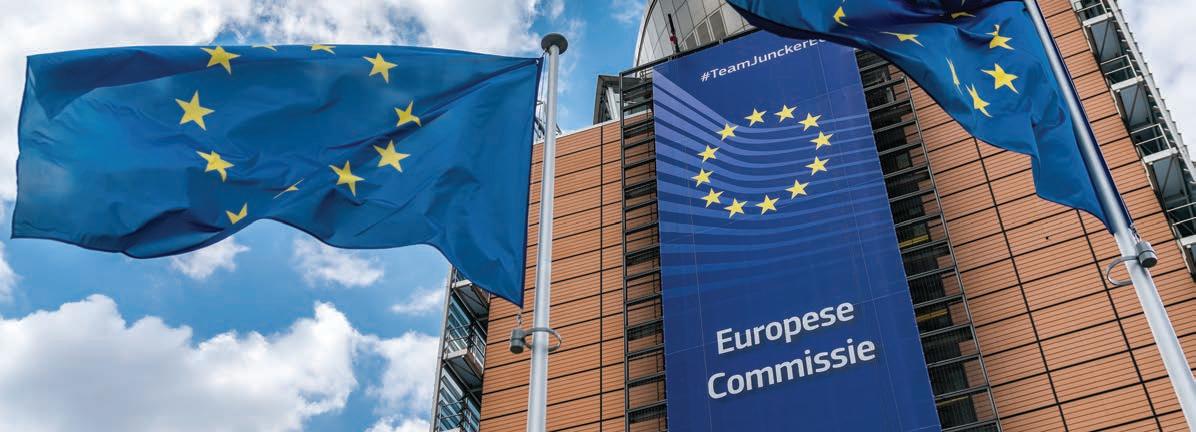

Luke ‘Ming’ Flanagan MEP
Independent –

The Left Luke ‘Ming’ Flanagan was re-elected to the European Parliament for a third time, having previously been a Roscommon TD between 2011 and 2014, and a councillor on Roscommon County Council between 2004 and 2011, where he served as mayor. Flanagan’s activism has mostly been focused on the legalisation of cannabis, agricultural policies – serving on the Parliament’s Agriculture Committee – as well as foreign policy advocacy for Palestine.

Fianna Fáil –Renew Europe
Elected to the European Parliament for the first time, Barry Cowen is the third member of the Cowen dynasty to enter elected politics for Fianna Fáil, along with his brother – the former Taoiseach Brian – and his late father Bernard. Cowen was a councillor on Offaly County Council between 1991 and 2011 and became a TD for County Offaly after his brother retired from politics. Cowen was briefly in cabinet, serving as Minister for Agriculture, Food and the Marine for 18 days in 2022.
Fine Gael –European People’s Party

A political novice, Nina Carberry’s election was her first foray into politics after a distinguished career as a horse jockey with having won seven Cheltenham Festival races. The County Meath native has assumed membership of the European Parliament’s Committee on Transport and Tourism.

Maria Walsh was reelected to a second term as an MEP, where she states her objectives are the establishment of an EU-wide mental health strategy and protecting Ireland’s corporation tax regime. Walsh, who was crowned the Rose of Tralee in 2014, is a former Defence Forces reservist and is a member of the European Parliament’s Committee on Agriculture and Rural Development.
Independent Ireland –Renew Europe
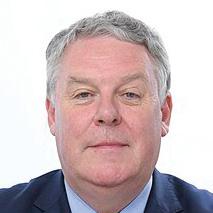
Ciaran Mullooly was elected on behalf of the newly-established Independent Ireland party, which is broadly described as ‘populist’. Mullooly is a familiar figure to many having served as RTÉ’s midlands correspondent for 26 years. In spite of the anti-immigration and Eurosceptic views espoused by some of the party’s TDs, Mullooly decided to join the liberal centrist Renew Europe Group, alongside Fianna Fáil MEPs
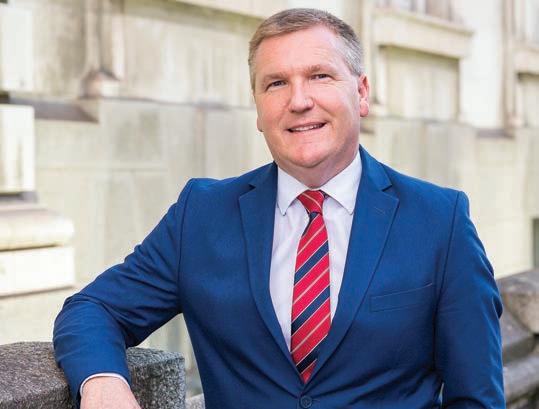
After four years serving senior cabinet roles at the Department of Finance and the Department of Public Expenditure, NDP Delivery and Reform, Michael McGrath TD’s leadership ambitions of Fianna Fáil appear to be on the backburner amid his appointment as the new commissioner.
The European Commission is the de facto executive of the European Union, with each member state appointing a commissioner who is given a specific role akin to a ministerial or cabinet position at national level.
Although McGrath has been confirmed as the new appointee as a new Commission prepares to take office, his specific role within the new Commission is not yet clear, as appointments are expected to be made in the second week of September.
The Irish Times has reported that the Government is keen for McGrath to secure a financial or economic portfolio, given his experience as Minister for Finance and Minister for Public Expenditure, NDP Delivery and Reform. However, this is unlikely as the Government nominated McGrath unilaterally without consultation with President of the European Commission Ursula von der Leyen.
Michael McGrath TD has been nominated by the Government to be Ireland’s next European Commissioner, and is expected to take office in October 2024, subject to ratification by the European Parliament.
Von der Leyen had requested member state governments nominate two candidates – one male and one female –who would then be subject to her selection as the preferred candidate.
The nomination processes of member states’ commissioners vary. In Ireland, there is no formal process outlined for determining a commissioner. Nomination of the State’s commissioner is generally agreed by the Cabinet and is treated in a manner akin to a diplomatic appointment. In some EU member states, the nomination of its commissioner is subject to a parliamentary vote.
To ratify a member state’s nominee for commissioner, European Parliament committees draw up evaluations of the candidate’s expertise and performance, which are sent to the Conference of Committee Chairs. The Conference of Committee Chairs then sends the evaluation letters to the President of the Parliament, and the Conference of Presidents is tasked with undertaking the subsequent hearings.
The full Commission, including the Commission President and the High Representative for Foreign Affairs and Security Policy, must then be approved in a single vote of consent by Parliament. After the President and commissioners
have been approved by Parliament, they are formally appointed by the European Council, acting by a qualified majority.
Fianna Fáil leader Micheál Martin TD had confirmed in early 2024 that the Irish Commissioner to follow Mairead McGuinness would be a Fianna Fáil nominee. Martin moved swiftly following the European elections to promote Jack Chambers TD into McGrath’s position as Minister for Finance, further appointing him as deputy leader of Fianna Fáil in an apparent effort to line up Chambers as his successor as party leader.
McGrath had previously been one of the favourites to succeed Martin as leader of Fianna Fáil, but his move out of national politics means that this is now highly unlikely, especially ahead of an imminent general election in Ireland with the Dáil being dissolved by February 2025.
If the general election leads to a new government, it will have the right to dismiss McGrath and appoint its own commissioner, underlining the extent to which his political future has arguably been gambled with.

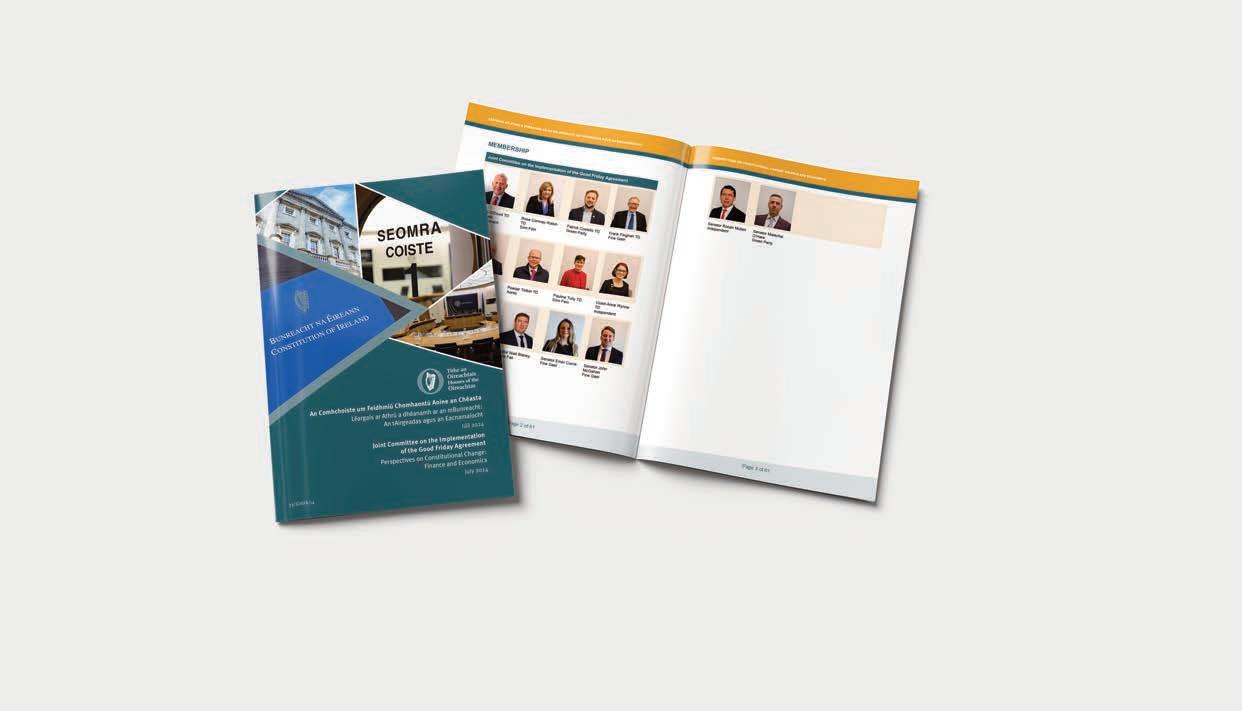
An all-party Oireachtas committee has found that there is “no insurmountable economic or financial barriers to unification” in a report which gathered expert perspectives on the financial and economic implications of constitutional change.
The first of a series of planned reports contextualising evidence to ilustrate what a ‘new and agreed Ireland’ would mean in practice, Perspectives on Constitutional Change: Finance and Economics outlines views on a number of economic areas ranging from social welfare payments to public sector salaries, as well as how the healthcare and education sectors could be managed.
A significant milestone, the agreed allparty report makes a final recommendation that preparations for referenda on Irish unification must “begin immediately”.
A further significant recommendation within the committee’s report, which will be debated in autumn 2024 when the Dáil resumes, is for the Government to publish a green paper, setting out a vision for a united Ireland.
Importantly, while the Oireachtas
committee achieved consensus on the report’s 15 recommendations – and no minority report was published – expert opinion within the report does diverge on several economic and financial challenges.
Perhaps the most widely discussed debate centres around the cost of a united Ireland, particularly in relation to determining the size of the UK Government’s subvention and the finance required to fill the gap between tax revenue raised in Northern Ireland and the levels of public expenditure.
While it is estimated that the current subvention to Northern Ireland is approximately £10 billion, the equivalent cost to the Government in the event of unification is unclear. John FitzGerald and Edgar Morgenroth argue that the financial pressure of a united Ireland would result in “an immediate major reduction” in the living standards in the Republic. They estimate the subvention
to Northern Ireland would amount to around €10.9 billion, or 5 per cent of Ireland’s gross national income* (GNI*), while raising welfare rates and public sector pay rates in Northern Ireland to those prevailing in the Republic, would require a further 5 per cent of national income.
In contrast, John Doyle, Vice President of Research at Dublin City University (DCU), disputes this analysis, instead arguing that taxation of pensions and wages, economic convergence, and other items, put the subvention at £1.5 billion – assuming the Republic did not accept responsibility for pension liabilities in Northern Ireland and Northern Ireland’s share of UK debt.
Likewise, the Economic and Social Research Institute’s (ESRI) Seamus McGuinness points to research undertaken with Adele Bergin and published in the Cambridge Journal of Economics which establishes a range of





between €4 billion to €7.2 billion. McGuinness further highlights that the lower estimate equated to what Irish Government spending would typically increase by on an annual basis, and outlines his belief that this would not result in a reduction in living standards for the population. In fact, the Republic’s GNI* grew by 5 per cent last year according to the Annual National Accounts 2023 published by the Central Statistics Office (CSO) in July 2024.
However, the Oireachtas committee recognises that the subvention is only one factor in assessing the costs and benefits of a united Ireland. Alongside potential increases in Ireland’s EU budget contribution, and convergence on social welfare payments and public sector salaries, there will also be financial implications for major policy decisions on public services such as healthcare and education.


The identified “prosperity gap” between north and south has been attributed to multiple factors, most notably much poorer levels of productivity in the North’s economy when compared to the Republic. Underpinning poor productivity in the North is an education system with low levels of attainment for those from poorer socioeconomic backgrounds and which still uses academic selection – which ironically is often used to disguise wider systemic educational failings in the whole.
Noting a lack of sufficient data to compare the two healthcare systems on the island, the committee set out that a strong attachment to the NHS in Northern Ireland exists despite poorer outcomes in comparison to the rest of the UK. Suggesting that a united Ireland could present opportunities for economies of scale regarding healthcare, it recognises that “the scale and complexity” of integrating the healthcare systems may mean that it is necessary to have a transition period after unification. The Committee intends to examine healthcare in a united Ireland in further detail in a subsequent report.
Indeed, Seamus McGuinness suggests that the use of academic selection explains why “the educational system in the North is not a good vehicle for intergenerational progression in terms of education or earnings”.


The committee heard that in the event of a united Ireland, major decisions in relation to education would be required in areas such as the curriculum, examination age, the promotion of social inclusion, and the treatment of the Irish language. To this end, it says that “the complexity of designing an education system post-unification means that a transition period will likely be necessary”.

Social welfare payments are significantly lower in the North than in the Republic. The committee heard calls for a united Ireland to be taken as an opportunity to design a new welfare state, and advise against attempting to emulate the UK’s approach. In its related recommendation, the committee says: “Discussions around a united Ireland include a first principles consideration on the role of social welfare, as an opportunity to build a new welfare state from the ground up, adapted to the 21st century and built on respect for socioeconomic rights.”







Interestingly, despite recognition that healthcare will be a central theme for which people will require detail – as articulated by John Doyle who argues that answers to questions on the process; the economy; and the health system would probably answer between 70 and 80 per cent of people’s desire for more information – none of the committee’s 15 recommendations relate to, or specifically mention, healthcare.
Instead, the committee recommends that “planning and preparation begin for the possibility of change to the constitutional arrangements for the country”, suggesting a whole-of-government approach is needed, including comprehensive examination of the implications of constitutional change across all departments and state agencies, to be led by the Department of the Taoiseach.

One theme that runs through many of the reports recommendations is that regardless of the constitutional future of the island, “there is scope for much stronger cooperation north/south, and better policy making to address major challenges such as climate change”. The committee notes insufficient data to meaningfully compare many policy issues, adding “there is also scope for greater people to people contact including through an increase in students studying across the border, all-island training opportunities, and professional exchanges.”

Concluding that if the range of policy options for a united Ireland were narrowed down, researchers could better provide information on the costs and benefits of policy choices, the committee says: “Preparation for referenda on Irish unification will be a historic task. The Committee calls for preparation to begin immediately.”





No less than seven north-south and east-west political institutions are currently in operation, with all but one established under the Good Friday Agreement. eolas Magazine examines the remit of these bodies.
When referring to the North and to UKIreland relations, one often hears reference to the phrases ‘strand two’ and ‘strand three’. The Good Friday Agreement is focused on enhancing community relations and advancing reconciliation, including between communities in the North, communities on an all-island basis, and relations between the British people and the Irish people.

Credit: Paul the Archivist.

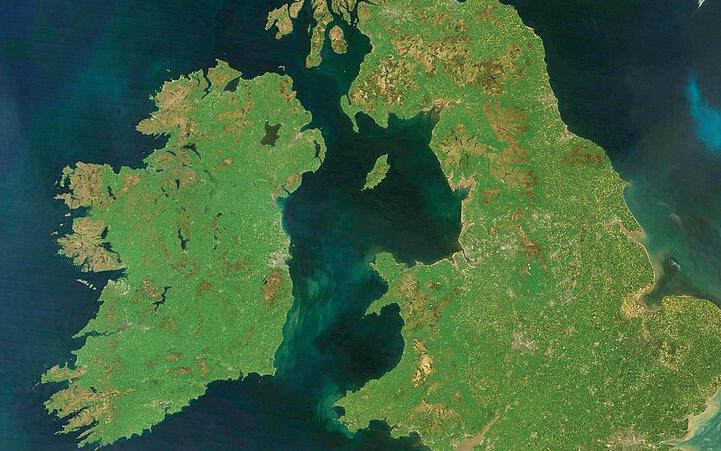
These three strands are the strands of reconciliation, with strand one referring to intra-Northern relations, strand two focused on all-island (i.e. north-south) relations, and strand three referring to UK-Ireland (i.e. east-west) relations.
The newest of these institutions, the East-West Council sits in Dover, England. Its establishment marked a step away from the Good Friday Agreement in that it only incorporates the Northern Ireland Executive and the British Government. Its remit is to “strengthen cooperation” between the North and Great Britain.
Established under the Safeguarding the Union deal negotiated in 2024 by former DUP leader Jeffrey Donaldson, ostensibly aimed at quelling northern loyalist fears over the UK’s Brexit terms and the ‘Irish Sea border’, the body’s objectives are vague with the exception of a new UK trade body known as Intertrade UK, leading former Secretary of State Chris HeatonHarris to insist that the body is “not a talking shop”.



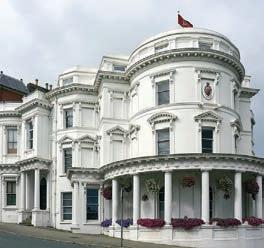

The North-South Ministerial Council is the body which incorporates north-south relations, without input from the British Government. Headquarterd in Armagh city, it is mandated to meet twice per annum, however, the most recent meeting in April 2024 was the first meeting of the council since 2021, and the first in-person meeting since 2016.
The strand two body ensures the development of “consultation, co-operation, and action within the island of Ireland” and is responsible for 12 areas of cooperation. Six of these are in areas where cooperation must be agreed at council, but where implementation happens separately in each jurisdiction.
The British-Irish Council is another Good Friday Agreement Body designed to enhance eastwest relations. It incorporates the British and Irish governments, as well as the northern Executive, the devolved governments of Scotland and Wales, and the crown dependency governments of the Isle of Man, Jersey, and Guernsey. Since 2023, Cornwall has been an advisor on the Cornish language and is de facto represented by the Cornish Council, a local council.
Headquartered in Edinburgh, the meeting place of the council rotates, and in 2023 it met in both Dublin and in Jersey. It meets in semi-annual summits and more frequent ministerial meetings. The council's stated aim is to “promote the harmonious and mutually beneficial development of the totality of relationships among the peoples of these islands”.
The British-Irish intergovernmental conference brings together the Irish Government and the British Government, with MLAs in the Assembly having a right under the Good Friday Agreement to be involved in the intergovernmental conference, albeit without the power to block decisions taken by the two governments.
Areas under the remit of discussion for the two governments in this forum are: asylum and immigration, including Common Travel Area matters; European Union and international affairs; social security, including methods of fraud detection; education; policy on misuse of drugs: organised crime and associated money laundering; and fiscal issues.
The conference replaced the Anglo-Irish Conference, previously established under Article 2 of the Anglo-Irish Agreement in 1985. The conference is supported by officials of the British and Irish governments, including a standing joint secretariat of officials dealing with non-devolved northern matters.
Body
North/South Consultative Forum
North/South InterParliamentary Association
British-Irish Parliamentary Assembly
North-south forum made up of appointees from the Government and the northern Executive “comprising the social partners and other members with expertise in social, cultural, economic and other issues”.
Forum for regular formal discussions between members of the Northern Ireland Assembly and members of the Houses of the Oireachtas on “issues of mutual interest and concern”.
To foster “common understanding between elected representatives” from the UK (including devolved nations), Ireland, Jersey, Guernsey, and the Isle of Man.
Notes
Establishment of the forum was agreed in 2006 under the St Andrews Agreement. NSMC meetings in 2012 and 2013 delayed establishment of the forum, while a 2015 meeting “noted” support for establishment. The forum has not been mentioned in these meetings since but its creation remains a formal objective.
Meets twice yearly on a rotational basis between the Houses of the Oireachtas and the Northern Ireland Assembly. Membership is drawn in equal numbers from the Northern Ireland Assembly and the Houses of the Oireachtas. It comprises 48 members plus two Joint Chairs.
Initially founded in 1990, the purpose of the Assembly was usurped by the British-Irish Council. It now fosters co-operation on matters of policy and civic interest. Recent work includes publication of a report on energy security.

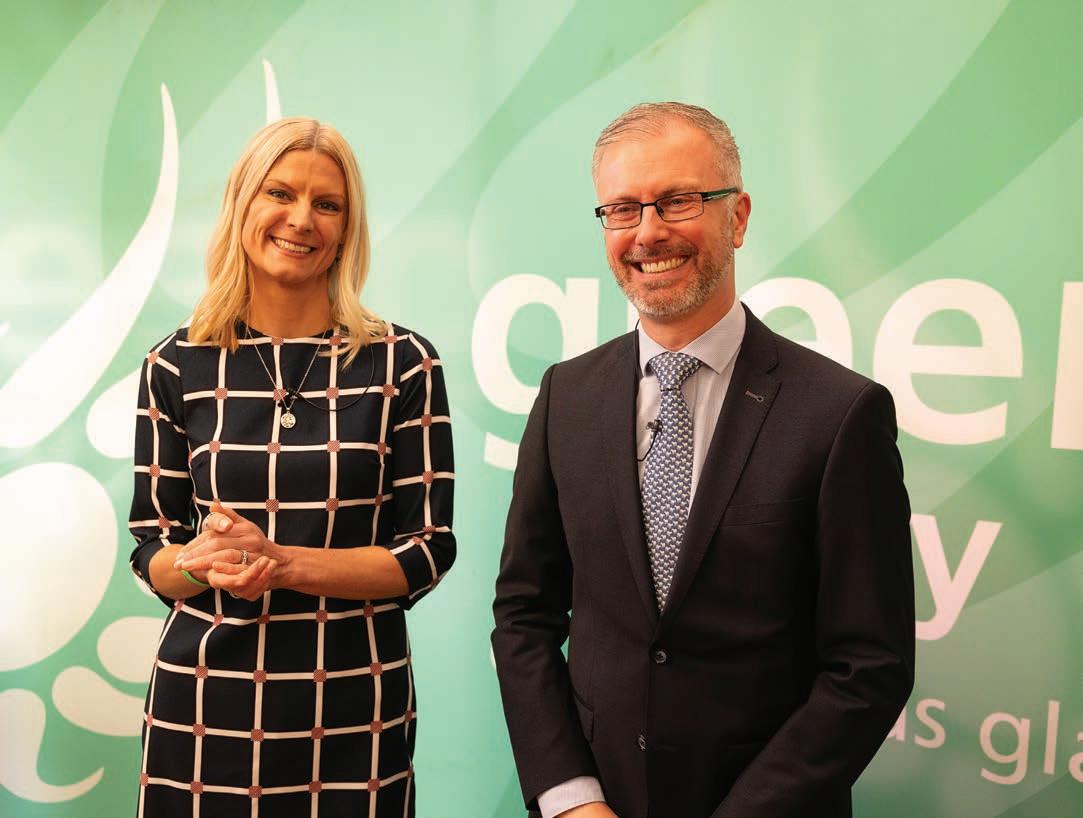
Credit: Green Party.

For the first time since 2011, the Green Party has a new leader following Roderic O’Gorman TD’s leadership election victory over Senator Pippa Hackett.
O’Gorman has pledged to unite the Green Party “focus on delivering the final parts of the Programme for Government and entering into the general election campaign”.
O’Gorman – the Minister for Children, Equality, Disability, Integration and Youth – narrowly defeated Minister of State and Senator Pippa Hackett, winning 51.9 per cent of the vote to Hackett’s 48.1 per cent.
While the Green Party’s powers are at an all-time high – holding four cabinet portfolios and 12 TDs – it has recently experienced poor results in the local and European elections, as well as consistent poor standing in opinion polls, which may
explain why only 1,896 of the party’s registered 3,425 members (around 55 per cent) voted in this election, a drop from the 67 per cent turnout recorded in the 2020 leadership election.
In an interview with eolas Magazine, Eamon Ryan TD, who served as Green Party leader for 13 years, acknowledged that while the election results were “not terrible”, that he had “been hoping to do better”.
“We ran a good campaign, but the tide –like a lot of places in Europe – is slightly waning on environmental justice in this last year or so. That will turn and come back in, but it was difficult,” Ryan said.
A Green Party member for 24 years,

O’Gorman’s election in 2020 followed unsuccessful general election attempts in 2007, 2011, and 2016. He was, however, successful in winning a seat in Fingal County Council in 2014 and 2019.
First elected to the Dáil in 2020 in the Dublin West constituency aged 39, O’Gorman went straight into cabinet as Minister for Children, Equality, Disability, Integration and Youth.
As Minister – a job he retains following his assumption of leadership – O’Gorman has overseen the rollout of the Magdalen Restorative Justice Ex-Gratia Scheme, published A White Paper to End Direct Provision and to Establish a New International Protection Support Service


– aiming to phase out the State’s direct provision model by 2024 – and introduced community integration services.
Speaking to eolas Magazine, O’Gorman’s predecessor, Eamon Ryan TD praised his successor’s contribution as Minister: “What Roderic has done in terms of improving childcare in the country is a historical change.”
The effectiveness of some of these measures, however, is doubtful, with direct provision still in place and with community integration measures having been unsuccessful as hate crimes and hate-related incidents have increased by 22.8 per cent since he became minister, as the Green Party has borne the brunt of public criticism for record levels of immigration under its triparty coalition with Fine Gael and Fianna Fáil.
During his leadership campaign, O’Gorman said that he was willing to explore the formation of a “progressive alliance” between the Green Party and other parties on the soft left such as the Labour Party and Social Democrats, although notably not including Sinn Féin or any parties on the far-left. Combined, the Green Party, Labour, and the Social Democrats hold 25 seats in the Dáil.
The new Green Party leader confirmed that there will be no reshuffle of the party’s ministers, meaning that the outgoing leadership team of Eamon Ryan TD and Catherine Martin TD are likely to remain in their ministerial positions until the 33rd Dáil is dissolved.
Succeeding Martin as deputy leader – in an election held on the same day in the immediate aftermath of the leadership election – is Senator Róisín Garvey, who defeated Neasa Hourigan To who won 333 votes to Hourigan’s 320 votes, giving her a winning margin of 13 votes. Minister of State Ossian Smyth TD had announced his intention to run, but withdrew upon O’Gorman’s election, saying the deputy leader “should be a woman”.
A former employee of An Taisce, Garvey was a councillor in Clare County Council from 2019 to 2020, before her appointment to the Seanad after the 2020 election, when she was an unsuccessful candidate in the Clare constituency, albeit with a respectable first-preference vote share of 9.5 per cent.
Leadership election result
1,896


Deputy leadership election result
Turnout: 653





In a year which saw the Houses of the Oireachtas host a conference of parliamentary presidents, the President of the United States, and mark 25 years since the Good Friday Agreement, there was a marginal decline (compared with 2022) in the numbers of days sat by the Dáil in 2023, although there was a 40 per cent increase in the number of Dáil divisions.
Dáil sat for 100 days (945 hours)
213 Dáil divisions
60,051 parliamentary questions and replies processed
36 meetings of the Dáil Business Committee
359 topics of debate selected
Committees
973 committee meetings
• total of 1,581 hours
3,001 witnesses appeared before committees
91 reports presented by committees
Seanad sat for 89 days (550 hours)
105 Seanad divisions
371 commencements matters tabled
Debate
3,076 hours of parliamentary debates
37,494 pages reported and published of the proceedings in the Dáil, Seanad ,and parliamentary committee
4 Dáil bound volumes

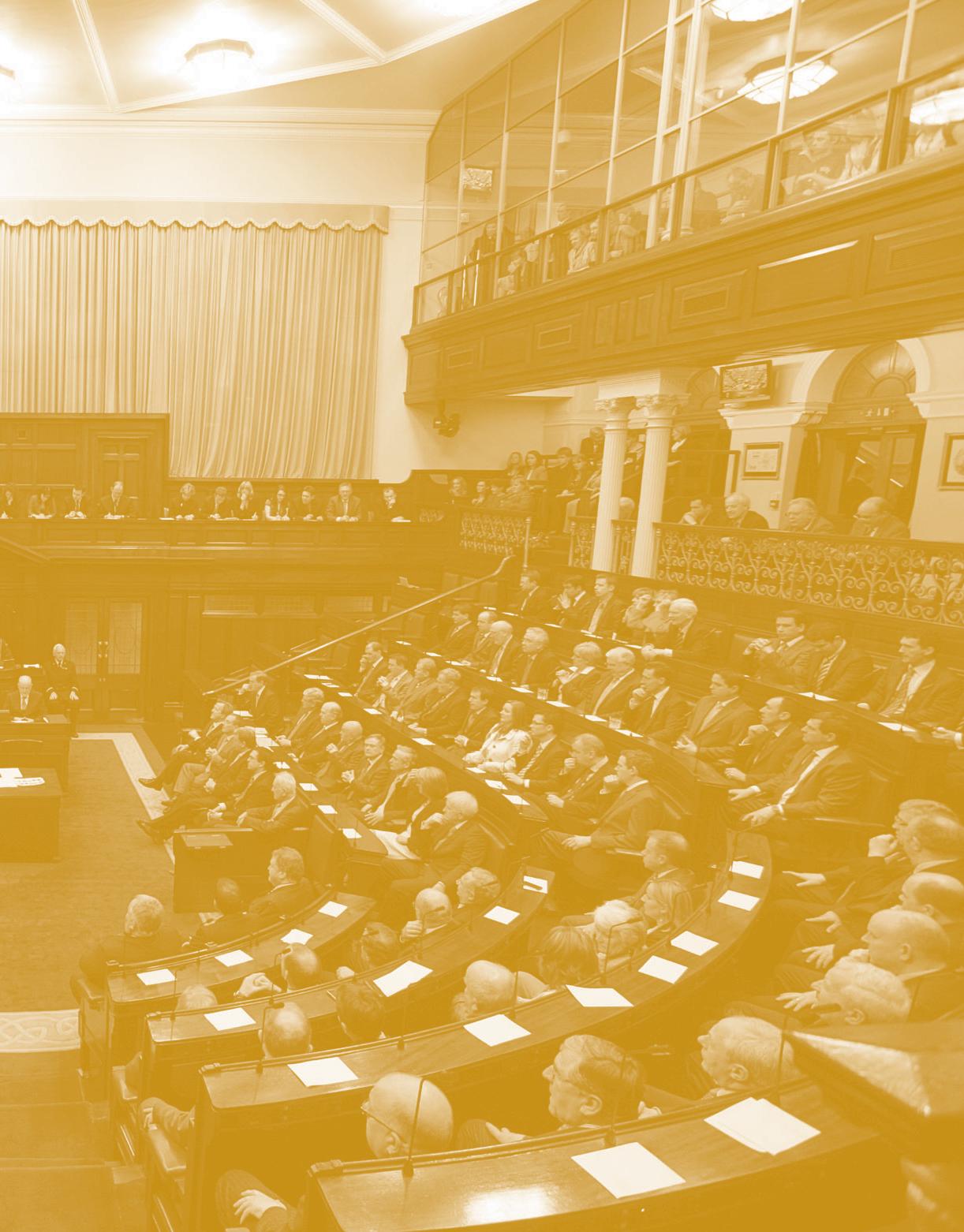
93 bills initiated in both Houses
75 initiated in the Dáil
• 35 of which were government bills
• 40 were private members bills
18 bills were initiated in the Seanad
• 1 government bill
• 17 private member bills
4,528 Amendments proposed to bills
36 bills passed by both houses
• all government Bills
156 EU legislative proposals received and consideration concluded on 150 of these
554 press releases issued
2,179,246 visitors to Oireachtas.ie website
5,608,400 website page views
Houses of the Oireachtas Twitter/X account: 47,332 followers
54,529 visitors to Leinster House
Leinster House had 28 protocol unit visits. This included:
• 2 heads of state;
• 9 government ministers;
• 2 European commissioners; and
• 6 ambassadors on official business.



The UK general election of 4 July 2024 has brought a new British government. In Northern Ireland, this election heralded the first steps of the much-mooted realignment of unionism while Sinn Féin consolidated its dominance of nationalist politics, writes Joshua Murray.
Across the Irish Sea, the general election campaign had been accompanied with a vast array of opinion polling leaving little doubt that the Conservative Party was on course for a colossal defeat and a return to power for the Labour Party for the first time since 2010.
In the north, however, MPs are elected from completely different parties to the same parliament, and the scale of the change to take place among our cohort of MPs was unknowable before polling. Standout results include the collapse of the Paisley dynasty in North Antrim after 54 years, the unseating of Alliance Party deputy leader Stephen Farry in North Down, and Sinn Féin emerging as the largest northern party – and fifth largest overall – in the House of Commons. Sinn Féin is the clear winner of this election and has
now completed a hat trick: it now holds the most seats in the Northern Ireland Assembly, in Westminster, and at local government level, success which party leader Mary Lou McDonald TD has argued is a mandate for the holding of an Irish reunification referendum.
For the DUP, it was a disappointing election result, but not for unionism as a whole. While the DUP now stands reduced from eight to five seats, two of those losses were to other unionists. In North Down, independent unionist and former DUP MLA Alex Easton MP secured a place in the House of Commons at the expense of Alliance deputy leader Stephen Farry, while the UUP’s decision to parachute in then-Health Minister Robin Swann MP to successfully contest the South Antrim seat – at the expense of the DUP’s Paul Girvan – now appears well judged.

The decision by Alliance Party leader Naomi Long MLA to run, despite being the Executive’s sitting Justice Minister, meant that newly appointed DUP leader Gavin Robinson MP faced a tight contest in east Belfast. In the end though, his margin of victory over Alliance increased.
However, far from comfortable was the DUP’s North Antrim race. TUV leader Jim Allister’s initial confidence was widely dismissed, but as the votes were tallied, reality dawned that Allister, aged 71, was set to become the oldest person to be first elected to the House of Commons since 1929, making him the first MP not called ‘Ian Paisley’ to represent North Antrim since 1970.
Allister has claimed that his election victory was the result of unionist backlash against the DUP’s support for the ‘sea border’ created by the nowousted Tory government’s Windsor Framework. However, the fact that the DUP also lost to the nonaligned Alliance Party in Lagan Valley, and to a relative moderate in Robin Swann in South Antrim shows that there is more to this DUP decline than meets the eye.
With three different parties unseating the DUP, it is impossible to fathom that the Jeffrey Donaldson court case played a role in the decline of the DUP. Donaldson, who stated in a letter to his party that he strenuously contests historical allegations of rape and sexual assault against him, had been Northern Ireland’s longest serving MP, most recently securing a majority of 6,499 in Lagan Valley in 2019.
However, as Donaldson exited politics to face his trial, Jonathan Buckley MLA, who had been drafted in from Upper Bann to contest for the DUP, was unable to retain the seat for the party, with DUP leader Gavin Robinson MP acknowledging the “very difficult and challenging circumstances” which Buckley faced. For the first time since the constituency was created in 1983, Lagan Valley elected a non-unionist MP with Alliance’s Sorcha Eastwood MP entering the House of Commons.
While this election was a bruising one for the DUP, it was very nearly an absolute catastrophe, with party veterans Gregory Campbell MP and Sammy Wilson MP both holding their seats by the narrowest of margins amid ferocious competition from Sinn Féin in East Derry and Alliance in East Antrim respectively.
In a vote that required a recount, Sinn Féin very nearly pipped the DUP to attain the East Derry seat. While Campbell had previously held a majority of close to 10,000 in 2019, the republican party ultimately lost by 179 votes. A surprising feat for a party which had been perceived as lacking momentum following belowpar performances in the Republic’s local and European elections one month prior.
Superficially, Sinn Féin gained no seats in this election. Beneath the surface, however, the party increased its vote share in almost every constituency in which it stood. Alongside the successful blooding of three new MPs, its proximity to victory in what was considered a safe unionist seat in East Derry, while reducing the SDLP’s then-leader Colum Eastwood MP’s majority in Foyle from around 17,000 to just over 4,000, all add up to what will be considered an objectively successful campaign and, from the party’s perspective, an emphatic mandate for abstentionism.
Heading into the election, the party was in recovery mode after bruising local and European election results in the State, and was the only large party facing elections in both states in Ireland.
Arguably the most significant development in this election for Sinn Féin was when former General Secretary of the Royal College of Nursing (RCN), Pat Cullen MP, was unveiled by the party as the candidate in the traditionally ultramarginal Fermanagh and South Tyrone.
Cullen secured an 8.9 per cent margin over the Ulster Unionist Party’s Diana Armstrong, amounting to a majority of 4,571, which is on a par with Michelle Gildernew’s 2005 majority when the unionist parties did not commit to an electoral pact.
Although Mary Lou McDonald TD has ostensibly taken the results as a mandate for the holding of a referendum on Irish reunification, the new Labour government in Britain and Taoiseach Simon Harris TD have ruled out a referendum in the immediate term. However, recently departed Taoiseach and Fine Gael leader Leo Varadkar TD has called on the next Irish government to prioritise taking the
* Includes speaker
steps towards Irish unity in the next Dáil, for which an election is due by March 2025.
The SDLP has maintained its role in ensuring that nationalist MPs sit in the House of Commons. While this is a point of contention for some republicans, the fact that Sinn Féin maintains its absence from the House of Commons while the SDLP takes the Westminster plunge could, from a nationalist perspective, play complementary roles in securing nationalism’s broad objectives. However, as 2017 showed, Sinn Féin does have the capability of wiping out the SDLP.
While Labour’s victory, in seat terms (411 of the 650 House of Commons seats), is essentially on a par with Tony Blair’s 1997 and 2001 landslides, the party underperformed in the polls in popular vote terms, only garnering a 33.7 per cent share (as the UK uses a first-pastthe-post electoral system) of the popular vote despite polls consistently projecting that Labour would win at least 40 per cent. Labour’s victory is the smallest vote share to secure a majority government in British history.
While it made hundreds of seat gains from the Tories, Labour also recorded
some losses. Most prominently, it lost Islington North to former party leader Jeremy Corbyn MP, who ran as an independent after being refused the party whip by Starmer, and elsewhere to four independents who campaigned for a ceasefire in Gaza.
The Labour Party was the beneficiary of a complete vote collapse for the Conservative Party, which won only 121 seats, its worst election result since the early 19th century both in seat terms and popular vote terms, as the party secured only 24 per cent of the popular vote. The Tories lost votes in all directions, with five seats lost to Nigel Farage MP’s Reform UK, two seats to the Green Party, losing a seat to the SNP (despite the SNP being virtually wiped out in Scotland and finishing just two seats ahead of Sinn Féin), to Labour in overwhelming numbers, and to the Liberal Democrats in overwhelming numbers.
The scale of the Tory defeat can be summarised by the fact that four of the five seats held by the Tory prime ministers since 2010 were lost. In addition, 12 cabinet secretaries lost their seats, joined in their defenestration by arch-Brexiteers Jacon Rees-Mogg and Steve Baker.


This election was a disappointment for the DUP, but far from disastrous for unionism more broadly. What Gavin Robinson MP described as the “very difficult and challenging circumstances” around the charging of Jeffrey Donaldson seems to have played a role in the DUP losing Lagan Valley. However, more fundamental introspection is needed for the DUP as it lost to its right in North Antrim and to its left in South Antrim.
For Alliance, this election was very much a subpar performance, with Stephen Farry’s heavy defeat in North Down and Naomi Long’s failure to gain east Belfast being somewhat offset by the gain of Lagan Valley. Furthermore, strong second place performances in East Antrim and Strangford mean that the party has something to build on.
For nationalism, Sinn Féin can be satisfied with its performances and a clear pathway to potential future gains in East Derry and Foyle, as well as successfully carrying out successions in Fermanagh and South Tyrone, Newry and Armagh, and Mid Ulster, where the party had popular incumbents pre-election.
With a new Labour government taking power in Britain, there has already been a much vaunted “reset” promised by the new Prime Minister Keir Starmer MP in British-Irish relations, and the most profound implications of this election for Northern Ireland from the other side of the Irish Sea may be a renegotiation to come on Britain’s Brexit deal with the EU, a new approach to legacy, the potential uplift of public finances, and reforming Stormont, something which has been supported by new Secretary of State Hilary Benn MP.
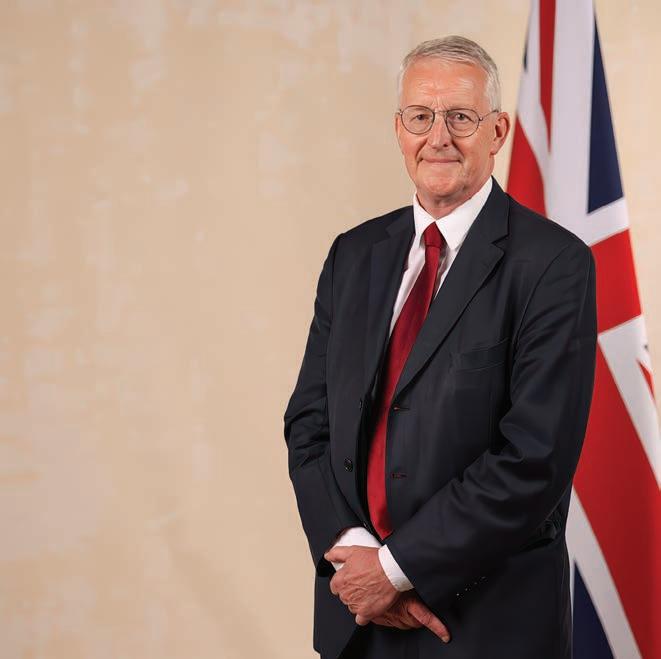
Hilary Benn MP is arguably the most high-profile appointee as Northern Ireland Secretary since Peter Mandelson in 1999. Benn is a political veteran and has mirrored comments by the new Prime Minister on the need for a “reset” of BritishIrish relations.
A Leeds MP since a 1999 byelection, Benn was appointed as Shadow Northern Ireland Secretary in September 2023, marking a return to the frontline of politics seven years after he had been sacked by former party leader Jeremy Corbyn MP from the frontbench in 2016.
An arch ‘remainer’, Benn was a key player in the ultimately unsuccessful People’s Vote campaign for the UK to remain in the EU after the 2016 referendum vote to leave. Although unsuccessful, his interest in EU affairs promoted him to publish a report titled How to Fix the Northern Ireland Protocol alongside the Centre for European Reform – amid northern loyalist fears over the ‘Irish Sea border’ – where he emphasised the importance of avoiding border infrastructure on the island of Ireland while adhering to Brexit requirements.
With a new administration now in place in Downing Street, there is no doubt that competent actors are overseeing Northern Ireland from London, and Labour will be keen to be interpreted by observers as successful on Northern Ireland, with the legacy of the Good Friday Agreement in 1998 and St Andrews Agreement in 2007 claimed by the party as core achievements of the Tony Blair government.
Whether challenges such as legacy, local finance mechanisms, a potential new Brexit deal, and the debate on Irish reunification can be met by the new British Government, however, remains to be seen.

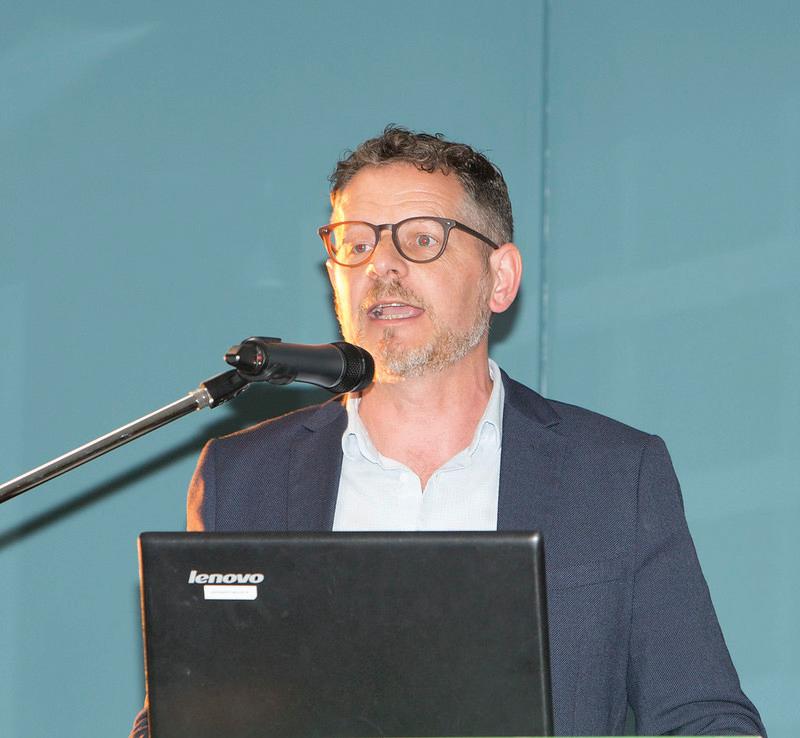
The effectiveness of Moran’s administration will likely determine whether executive-style mayorships are the best way to govern Ireland’s cities.
Potentially positive signs can be taken from the turnout in the mayoral election, which stood at 51.8 per cent. Although this is low compared to a general election or even local election turnout, this level of engagement is significantly higher than the average mayoral election turnout in Britain or the United States.
For comparison, in the 2024 London Mayor election, Sadiq Khan won in an election where the turnout was 40.1 per cent, and mayoral elections in New York City average a turnout of 26.5 per cent.
Moran, 58, has pursued a diverse and interesting career which has taken him from Ireland to France, Australia, and the United States.
Having worked in law on New York’s Wall Street in the late 1980s and early 1990s following his graduation from the prestigious American Ivy League Wharton School in Pennsylvania (the alumni of which includes X CEO Elon Musk and
John Moran, a former Wall Street lawyer, investment banker, and former Secretary General of the Department of Finance, made history in June 2024 by becoming the first directly elected mayor in Ireland, assuming office in Limerick as an independent.
former US President Donald Trump), Moran first returned to Ireland in 1990 and became associate of the Institute of Taxation of Ireland while continuing to work and travel globally.
After three years leading a New York law firm, Moran then spent 10 years working for Zurich Financial Services, where he established and led Zurich Bank in Dublin before being promoted to oversee the company’s Asian operations from Sydney and later the multi-billion dollar global ZCM operations in New York.
In 2012, Moran entered the public sector, after he was appointed by former Minister for Finance Michael Noonan as Secretary General of the Department of Finance, a time period which was characterised by government negotiations with the ‘Troika’ over bailouts, as well as the sales of the Bank of Ireland and Irish Life in the aftermath of the banking crisis.
Moran has never been a member of a political party, although, significantly, he campaigned with Leo Varadkar TD during
the referendum to establish a mayor of Limerick.
Entering a crowded field of candidates as an independent in the June 2024 election, Moran topped the poll on 23 per cent of first preference votes, and 35.7 per cent on the final count in an election where the three main parties evidently (as they cumulatively polled 38 per cent of first-preference votes) failed to capture the imagination of the electorate.
Elected on a vague campaign of doing “more for Limerick”, Moran pledged that he was “passionate about Limerick and making it much better than it is”, and to be a mayor who has “an ambitious but realistic vision for Limerick”.
This is a theme he has maintained in his recently-published draft mayoral programme where he has pledged a “more healthy”, “more prosperous”, and “more liveable Limerick”.
Moran was inaugurated on 21 June 2024 and will serve a five-year term and will have no limit on the number of times he can seek re-election.

27 September
Key issues to be examined: Register now!
Now in its third year, Digital Marketing Dublin will feature expert speakers from across the spectrum of digital marketing including a focus on targeting specific audiences through tools such as SEO, paid search and email marketing. #DMDublin will get to the heart of digital planning and strategy. Leading digital marketing experts will examine best practice and achieving results, giving examples of successful campaigns.

• Digital marketing strategy and planning
• Data and analytics
• AI and technologies for digital marketing
• SEO
• Email marketing
• Content marketing
• Paid search advertising
• Influencer marketing
• Social media
• Video
• UX
Speakers confirmed




Darragh Doyle Head of Communications, Marketing and Audience Development
Dublin City Council Culture Company
Aoife McIlraith Owner, Consultant Luminosity Digital
Sascha O’Toole Deputy Head of Communications Department of Children, Equality, Disability, Integration and Youth
Dónal Mulligan Chair of Faculty Research Ethics Committee, Faculty of Humanities and Social Sciences DCU




Hannah Bryans


Gus
Shauna Hanna Head of Digital Content Texthelp
Orlaith McIvor
Senior Media Manager Lidl Ireland and Northern Ireland


An independent from a republican background, Thomas Pringle has been a Donegal TD since 2011. He tells eolas Magazine about his passion for representing Donegal, his role in pursuing climate change legislation, and how independent TDs can maximise their influence in Irish politics.
My parents were always politically involved, and I would have inherited the interest from them. I was involved in union work in my job and always had an interest in politics, although I would never have seen myself as a politician.
In the local elections in 1999, the town of Killybegs was without a councillor and it was said that if someone ran as an independent, they would get elected and so I said: “Right, I’ll do it.” Low and behold, I got elected.
Getting elected to Donegal County Council in 1999 and then the Dáil in 2011 were proud achievements. I think the passage of the Fossil Fuel Divestment Act 2018 [introduced by Deputy Pringle] would have been my proudest achievement and showed that you did not have to be in government to get things done. It was a joint venture between politicians and NGOs that led to the passing of the legislation, and I was proud to be at the political end of it.
I think that the person I admired most in political life was Nelson Mandela. He struggled for so many years to achieve freedom for his people and yet realised where they had been mistaken as well, which is important for anyone coming on to realise that freedom is not only political, but economic. Economics can be used to control populations and hold back a nation in the interests of the few.
I also admire the Leas Ceann Comhairle, Catherine Connolly TD, she always is committed to doing the right thing by the people.

“Economics can be used to control populations and hold back a nation in the interests of the few.”
Thomas Pringle TD
What do you believe independent TDs can achieve in the Dáil?
I think independent TDs can achieve a lot in the Dáil and in political life in Ireland. As I mentioned earlier with the Fossil Fuel Divestment Act, I do not think that would have been achieved by a party TD as opposition to it would have broken down over party lines.
As an independent you are answerable to the people directly and do not have the buffer of party to protect you from the people. I think that is very important; too often we see politicians say: “Oh, it was party policy and there was nothing I could do…”
I believe that is wrong and whether it is popular or not, you should be accountable for your decisions.
One of my big bug bears is when people vote for party candidates at a local level but do not hold them accountable for the party decisions that would be harmful to citizens or the area where they live. Political parties are made up of the individuals that are elected for them.
are your key priorities for Donegal?
I think a key priority for Donegal is to make sure that Donegal is at the heart of government thinking and decision-making.
We have been impacted most by the border in Ireland and we would be one of the most impacted border/midland/western region counties that have suffered from lack of investment as identified by the EU as an underdeveloped region.
There is something wrong with government when it is not a priority for them to deliver the lifting of an entire region out of underdevelopment, plus it affects all other parts of the country by this neglect as it puts them under even more development pressure with the movement of people into those areas.
To achieve balanced region development for Donegal and within Donegal as well is vitally important.
Watching and supporting the GAA, reading, and going to the cinema. I like being at home in Donegal and enjoying the scenery around me when I am at home.



Despite Ireland’s ambitious climate commitments and its unique potential to be a global leader in climate justice, a significant shift in Ireland's climate policy is urgently needed, write Jennie C Stephens, professor of climate justice, ICARUS Climate Research Centre, Maynooth University, and Orla Kelly, assistant professor in social policy, University College Dublin.
Ireland remains a laggard within the EU in terms of climate policy implementation.
To date, we have been ineffective in achieving our climate targets because of both policy misalignment and prioritisation of corporate interests over the public good. From energy to agriculture, from expanding data centres to intensifying meat and dairy production, we are not on track to meet our emissions targets because policies continue to incentivise carbon-intensive growth and private sector profits rather than investing in the needs of communities.
The transformation of the Irish economy from stagnancy and isolation in the 1980s to now being one of the ‘best-performing’ in the EU has required successive governments to deftly leverage our national assets, political relationships, and social capital in creative and sometimes conflicting ways.
To balance the interests of multiple and sometimes conflicting stakeholders, the State has often engaged in decisions, actions, and policies that are systematically in conflict – a documented phenomenon known in social science as ‘organised hypocrisy’.
For example, it successfully straddled the process of political integration into the EU while retaining the controversial tax loopholes to remain a hub for US foreign direct investment (FDI). Our cultural acceptance of ambiguity has enabled this paradoxical policy paradigm to persist.
While some of us have benefited from these policies, and our nation has been transformed in the last five decades, the way the Irish economy has expanded has come at considerable social and ecological costs. The negative impact of Ireland’s current policies on marginalised communities cannot be ignored. From a social perspective, our preference for economic expansion and market-based policies has led to myriad challenges, including an acute housing crisis and an overburdened healthcare system, which has led to widespread frustration and political polarisation, especially within marginalised communities that have suffered from decades of underinvestment.
Ecologically, we hold the dubious distinction of being the country in the world with the worst wetlands depletion of any nation in the world and the worst level of destruction of our native forests. Further, the country is not on track to meet its commitments under the Paris Agreement and is facing fines totalling millions of euros as a result.
But Ireland has what it takes to change course – and leverage its unique combination of accumulated wealth, social solidarity, and commitment to fairness to demonstrate global leadership on climate justice.
We have the potential to inspire the world with our actions. There is widespread acceptance and understanding among the population about the gravity of the
challenges that are beginning to unfold as our world is warming.
Rather than worsening social divisions through continued policy misalignment and prioritising private sector incentives over public investments in communities, there is now an opportunity for bold leadership by adopting a justice-oriented approach to climate action.
Given our relatively privileged global position in terms of wealth and temperate climate and building on our deep-rooted historical memory of injustice, we have the responsibility and the privilege to demonstrate bold leadership by reprioritising wellbeing for all over profits for the few.
A reorientation of our economic and social systems toward public investments to support more local, regenerative, and community-focused production of food, energy, and other necessities is essential. A focus on regenerative (rather than extractive) investments in people and communities will not only improve human wellbeing and restore social cohesion but also bring back ecological health of our land and water.
While the business-as-usual, organised hypocrisy approach has achieved gains for some Irish people in the past, for a healthy and stable future there is an urgent need and a current window of opportunity for Ireland to demonstrate climate justice leadership by focusing on policy alignment and public community investments.



























